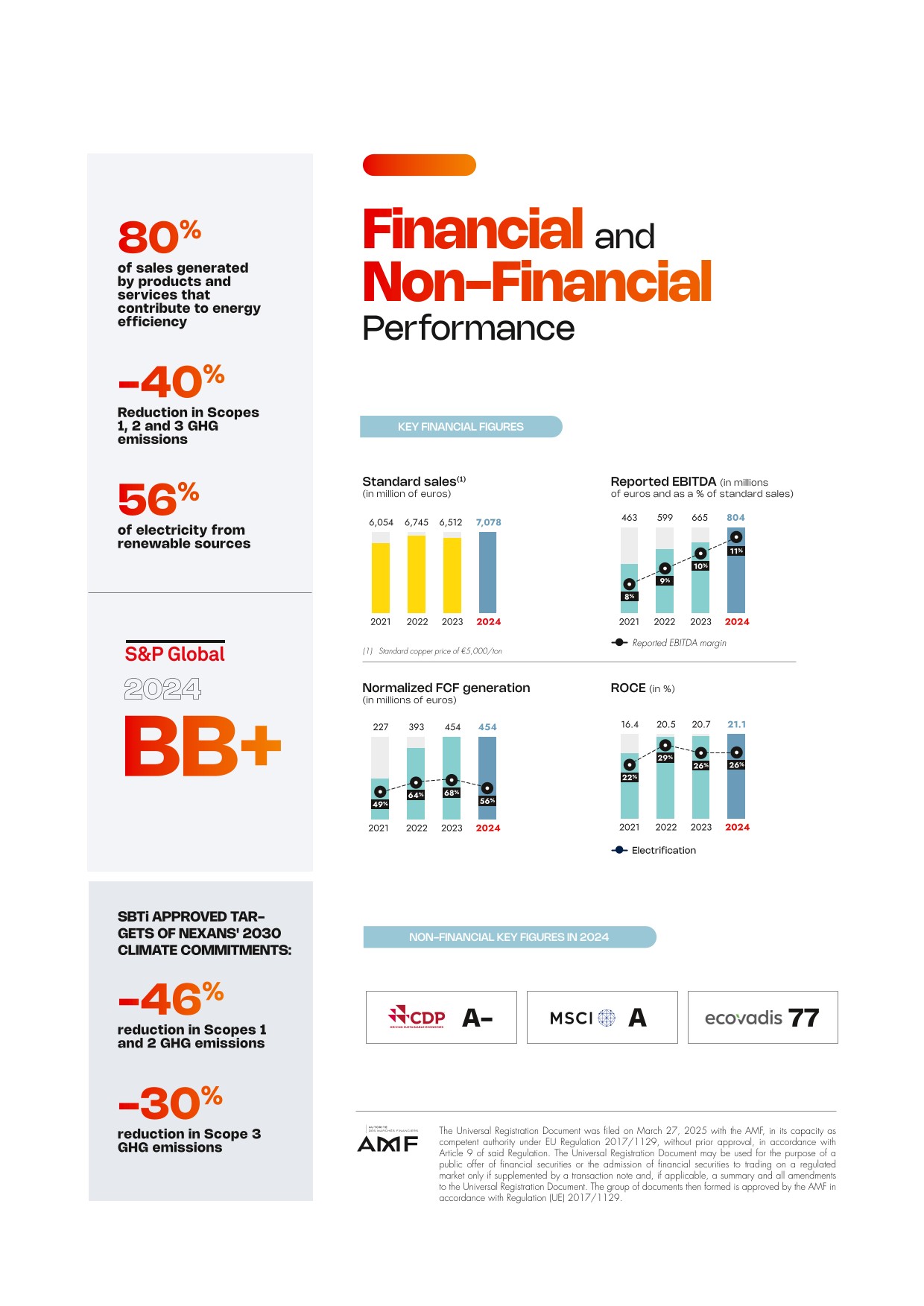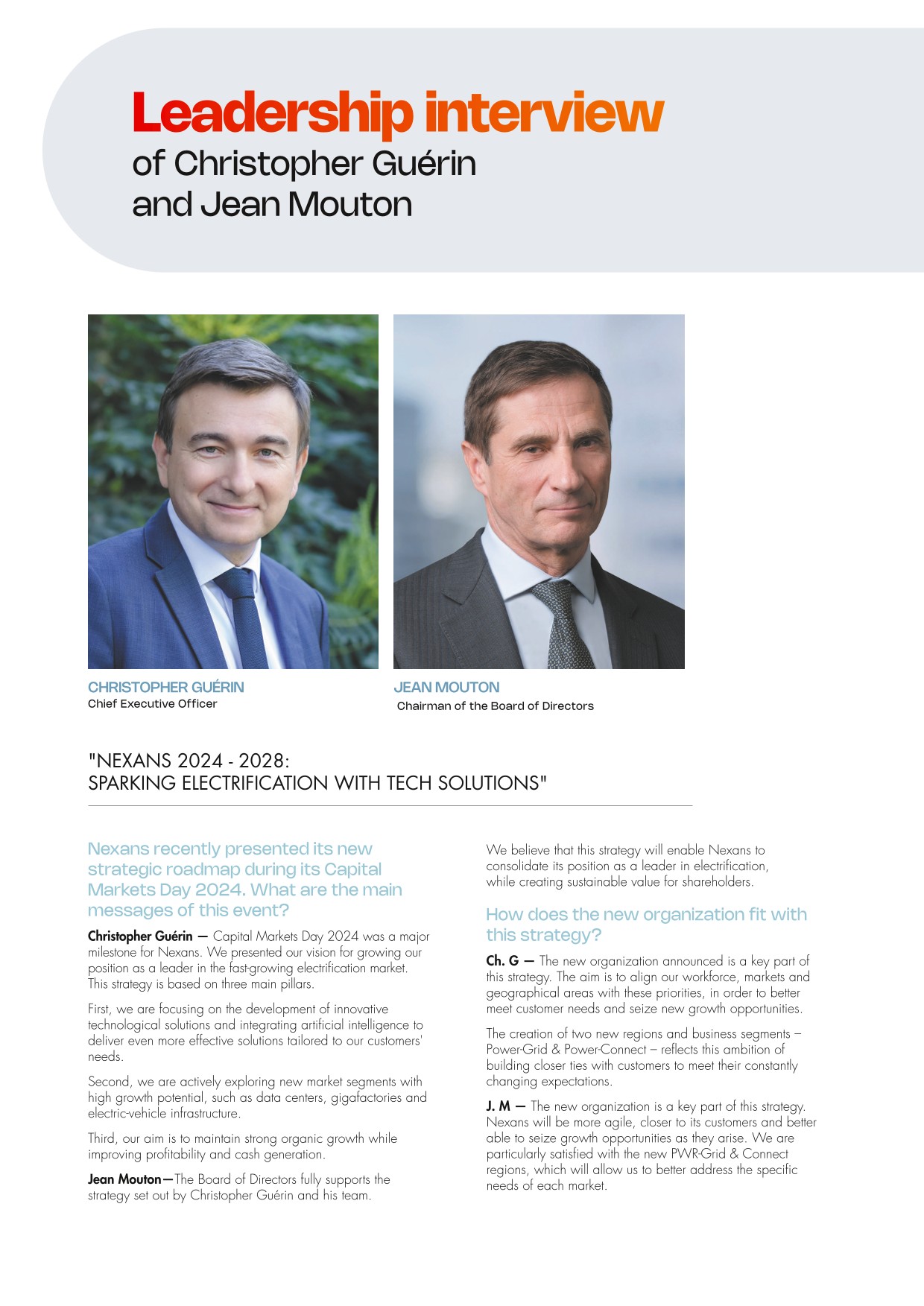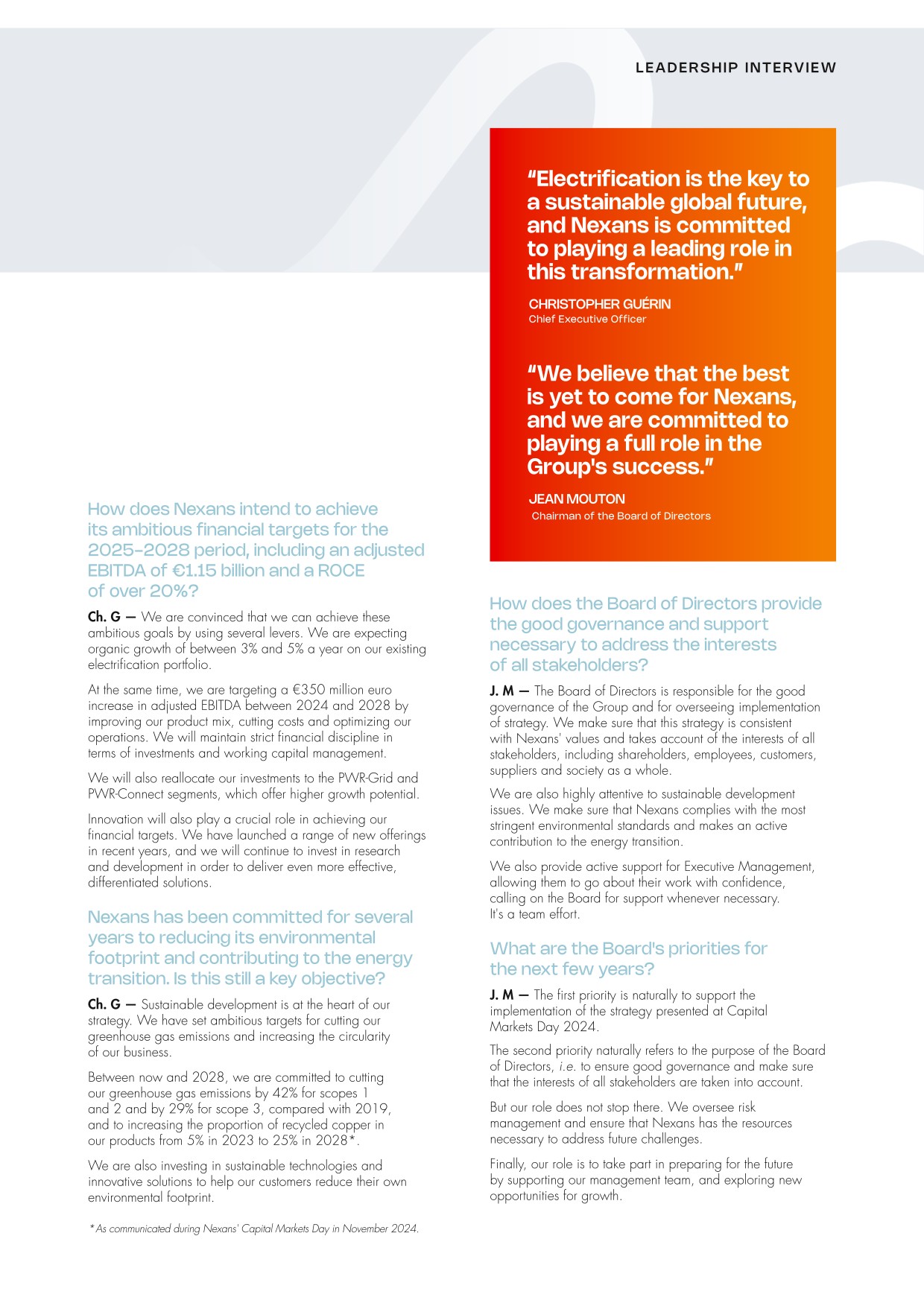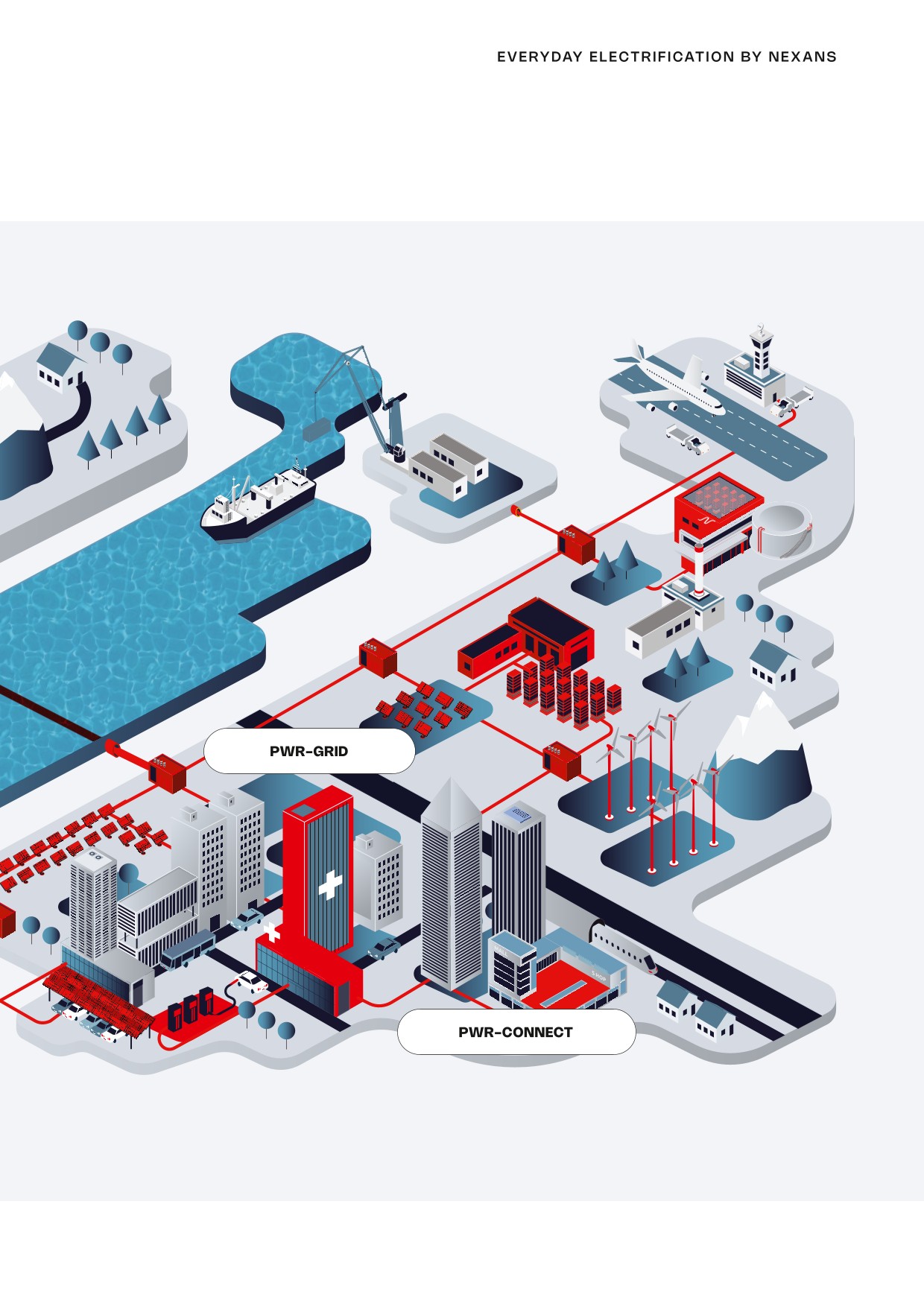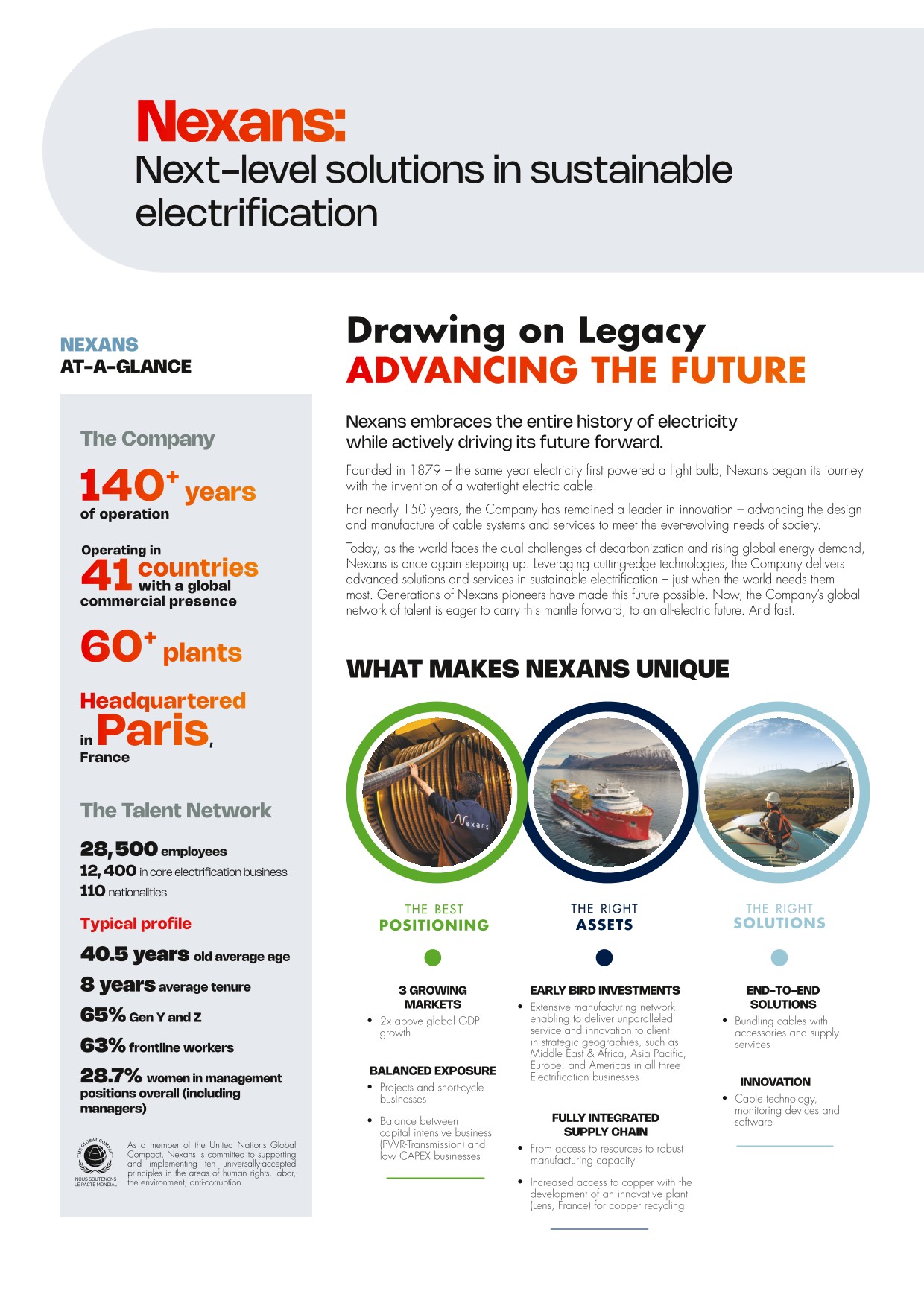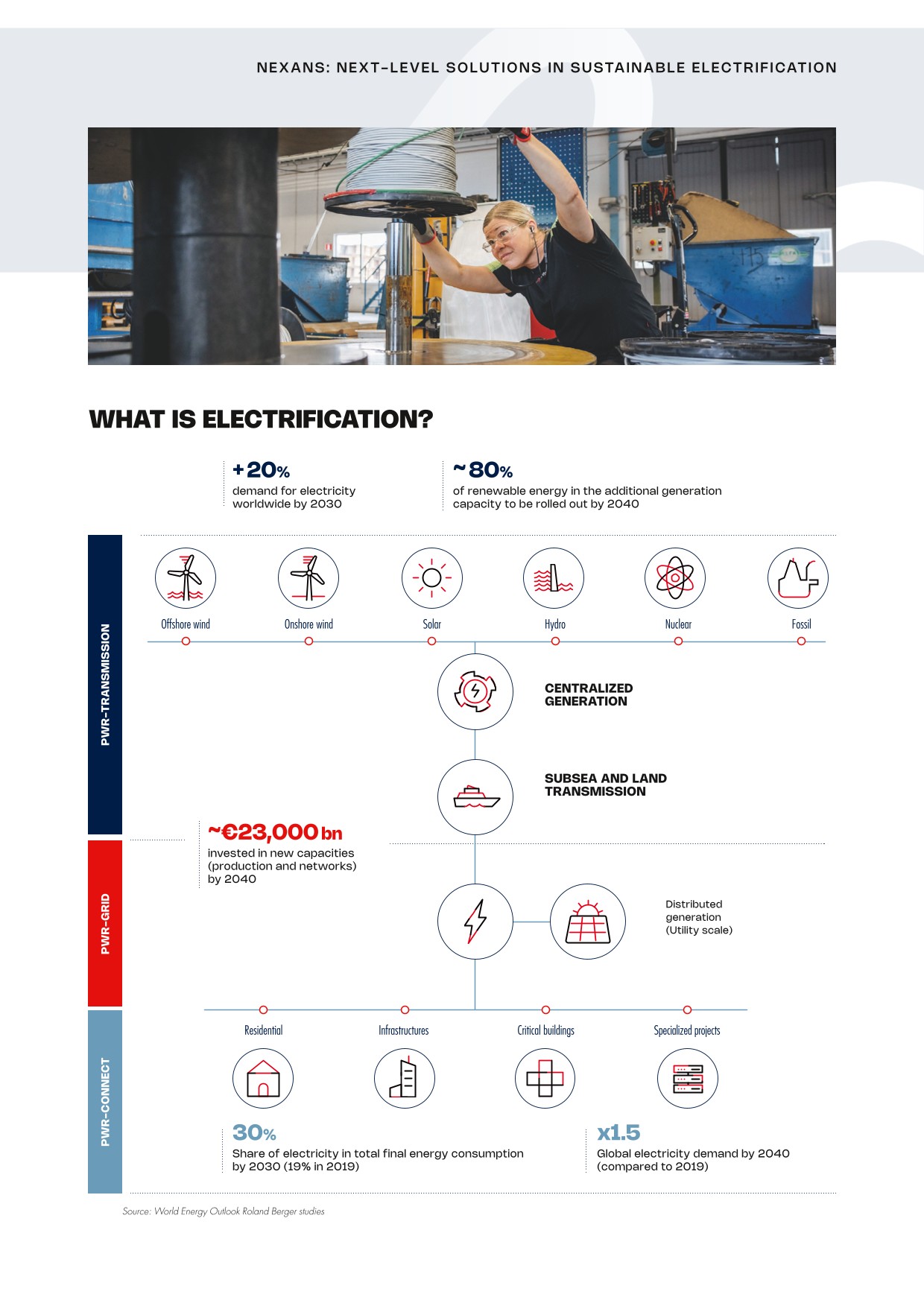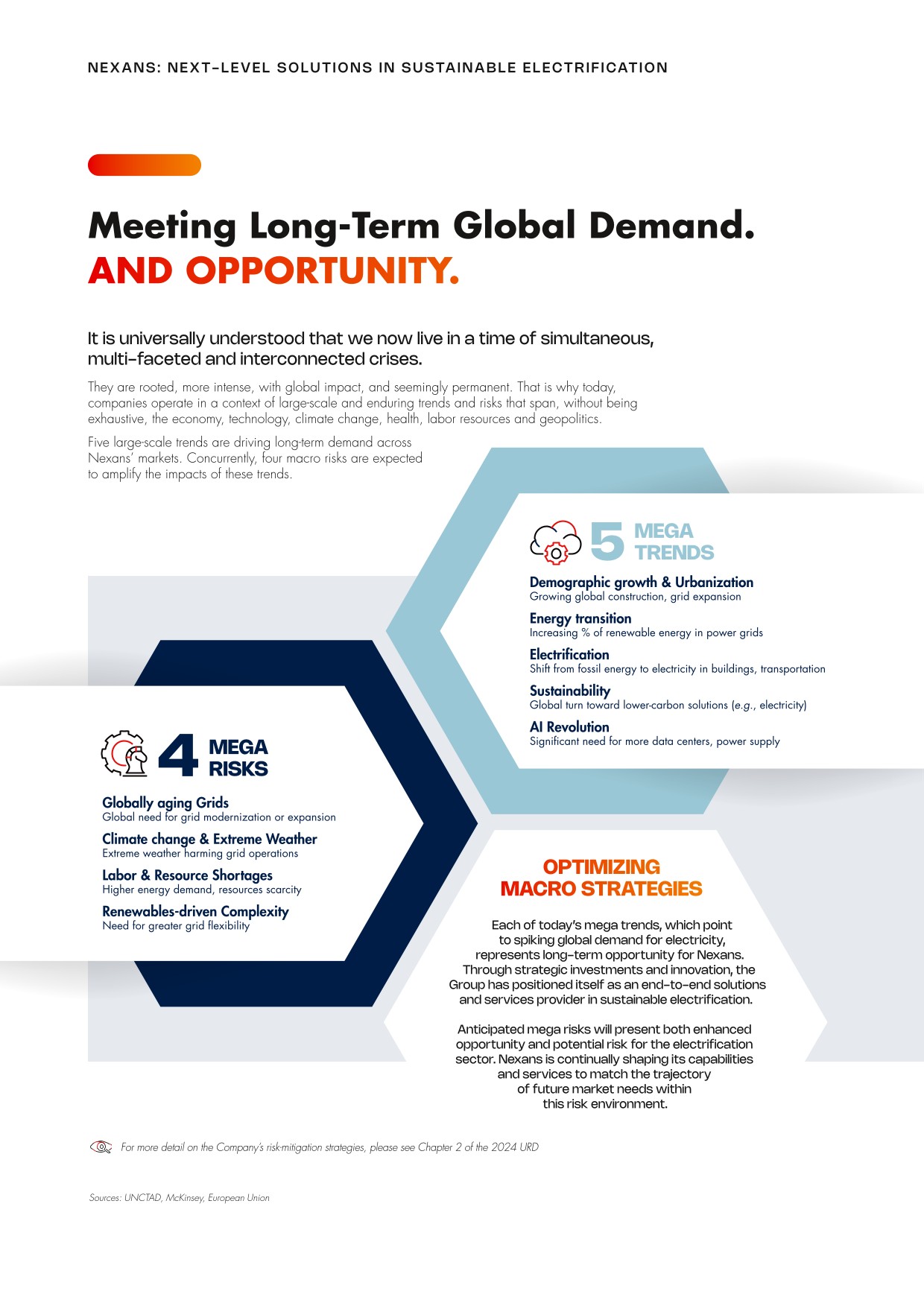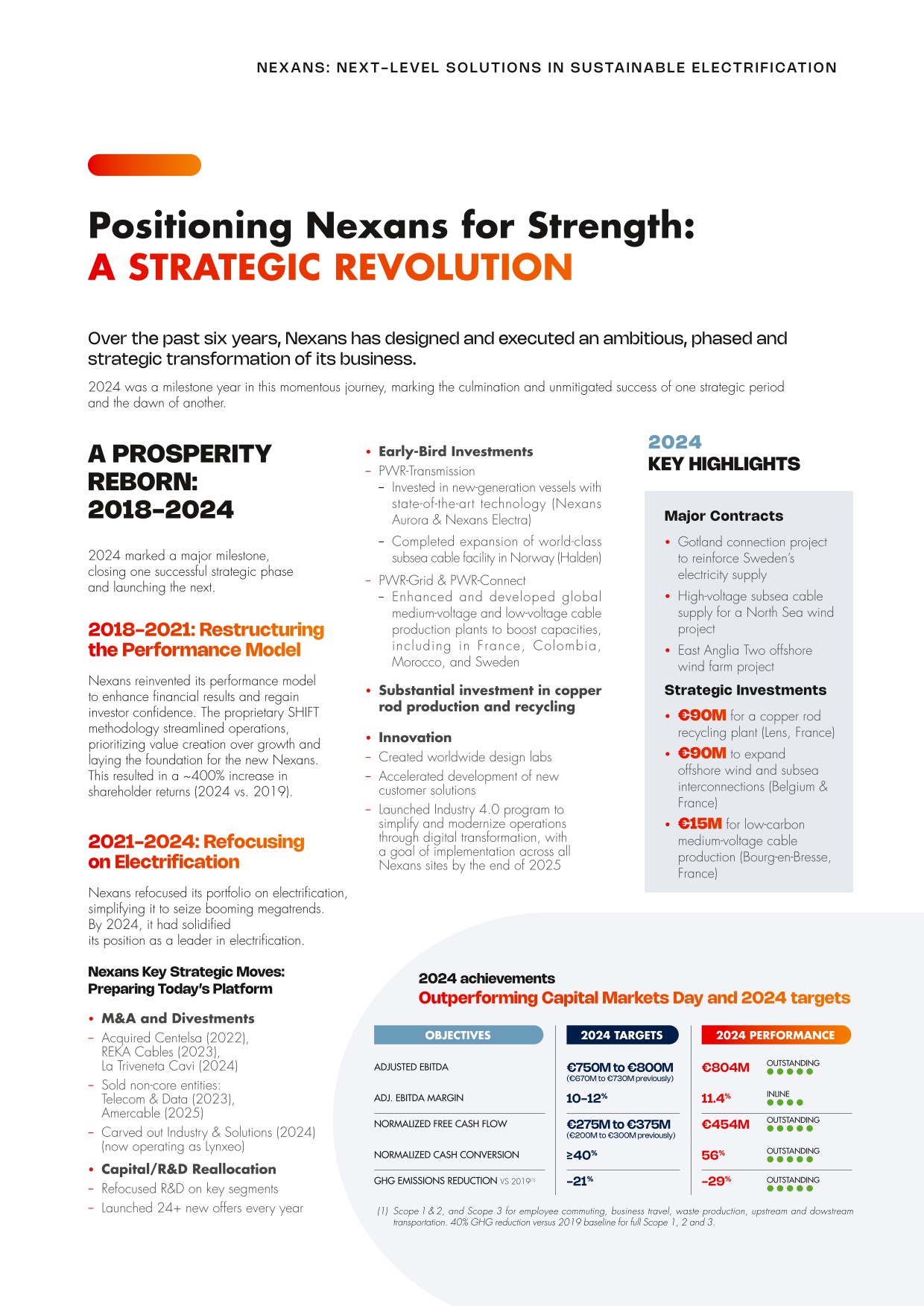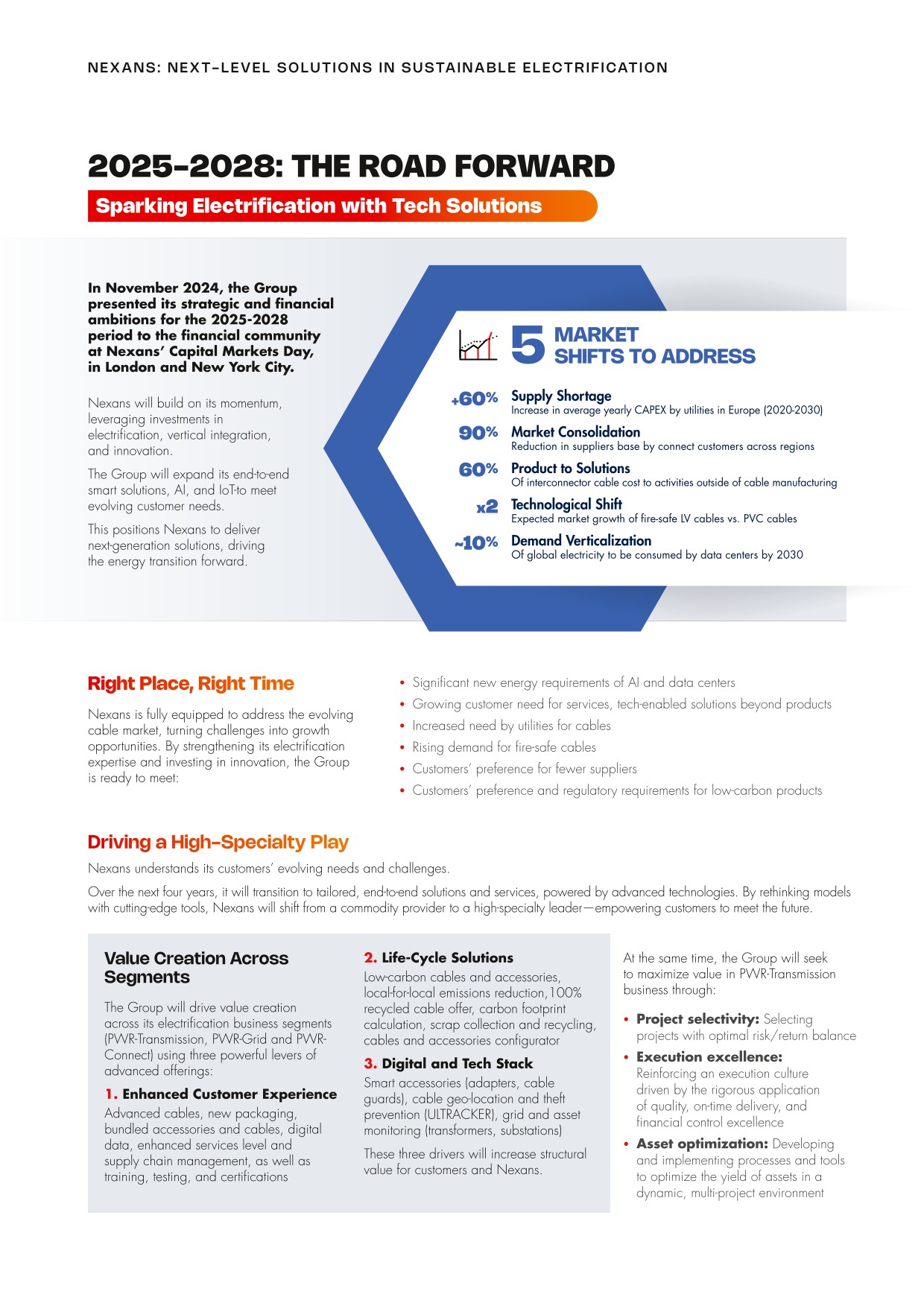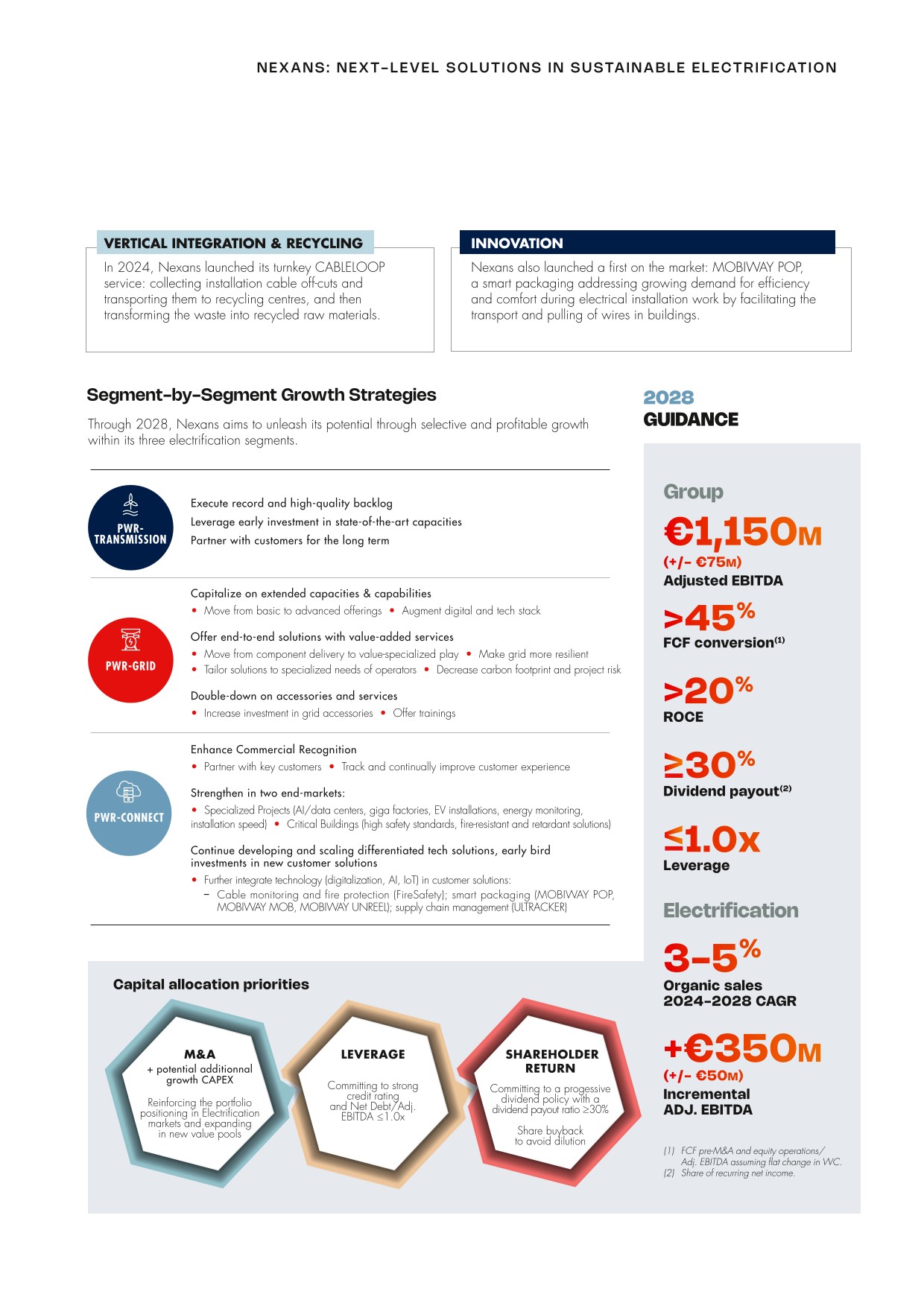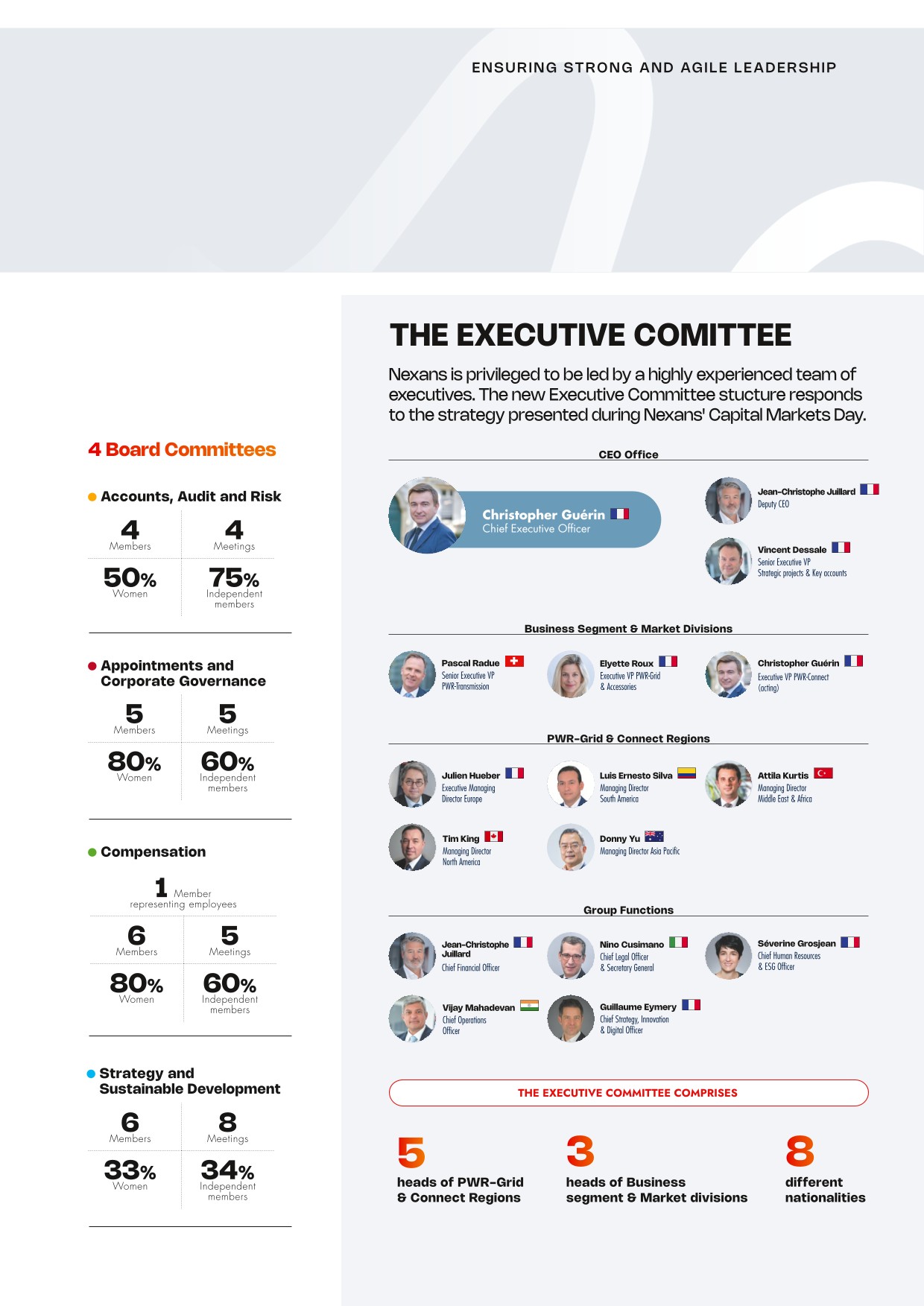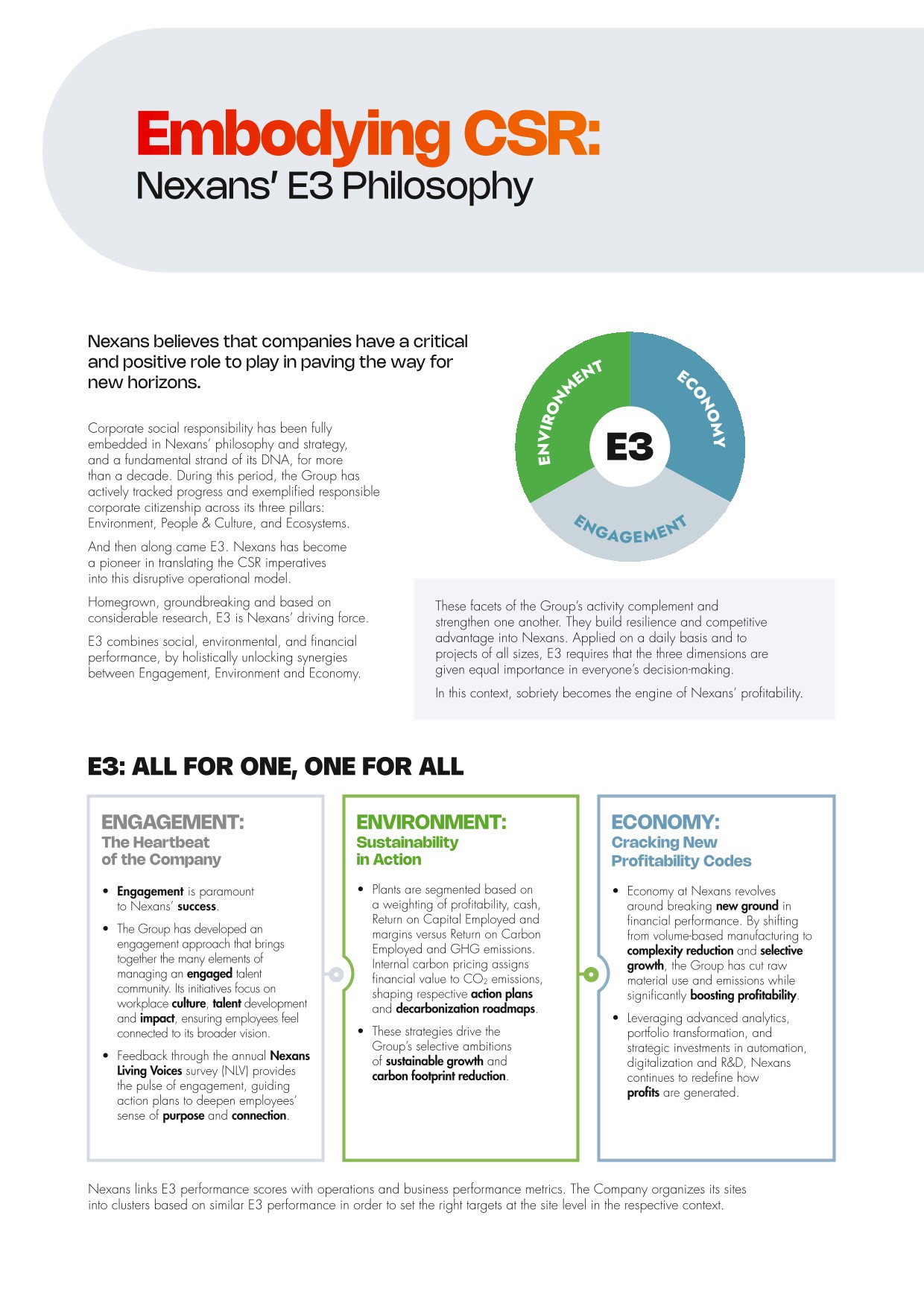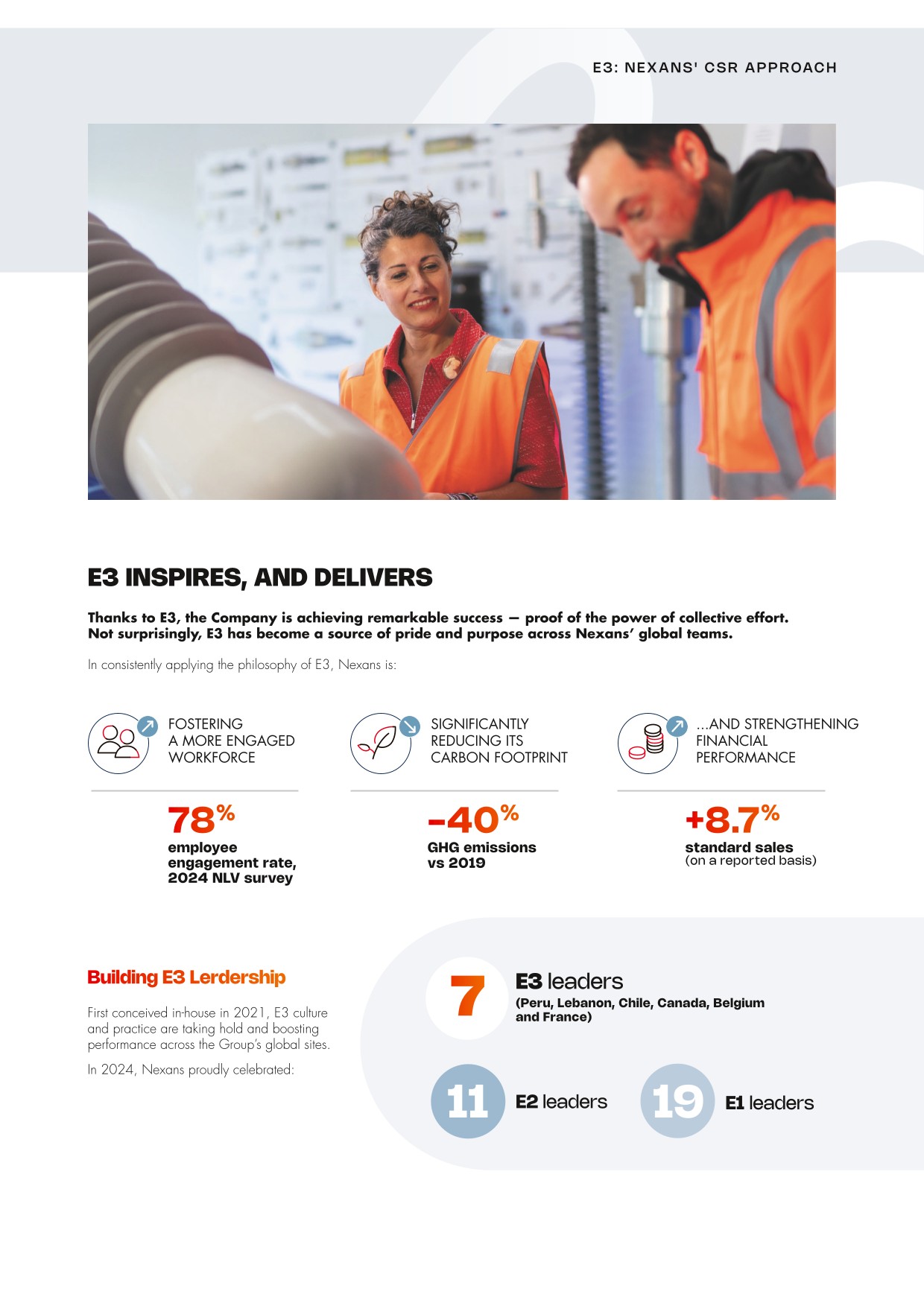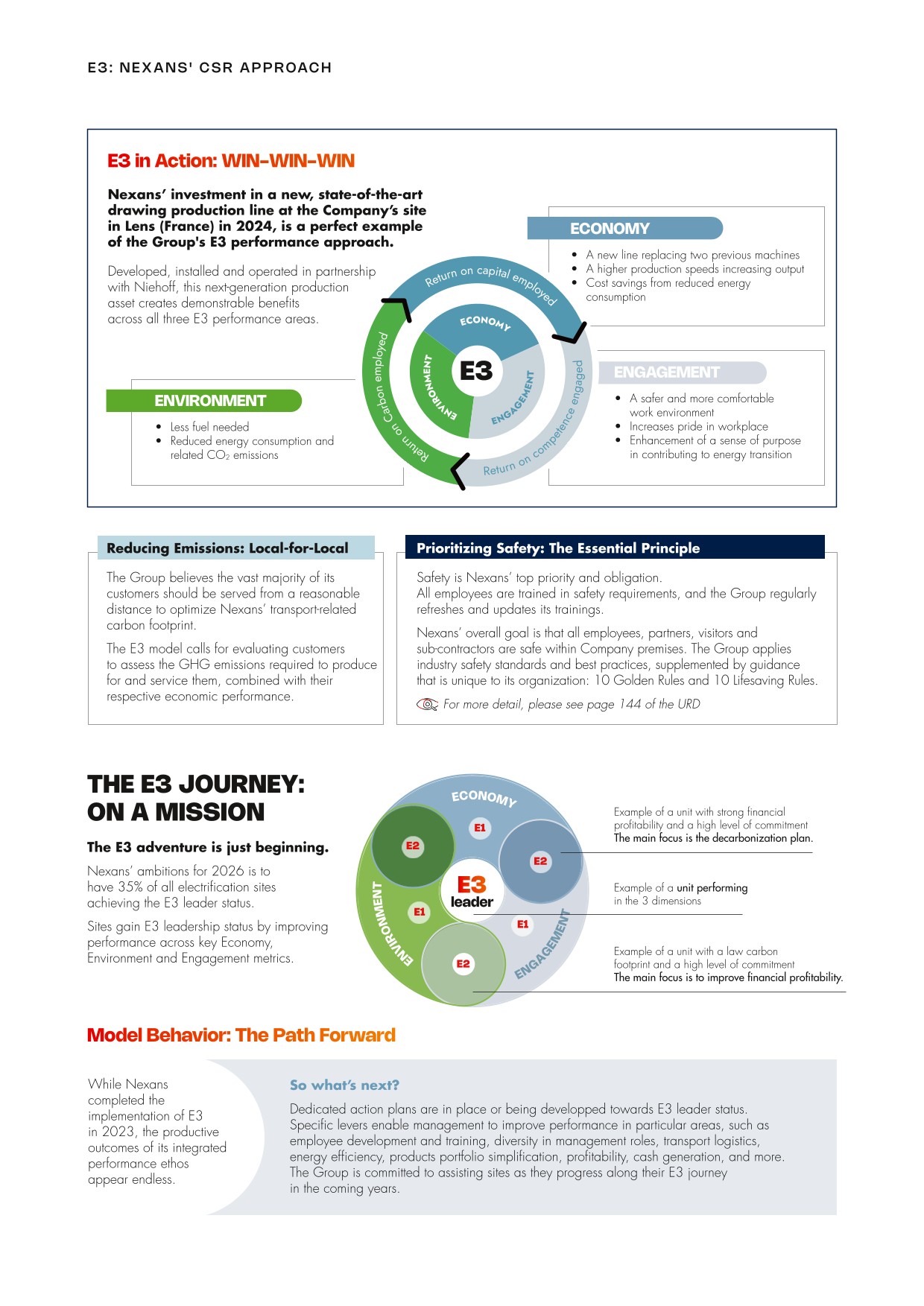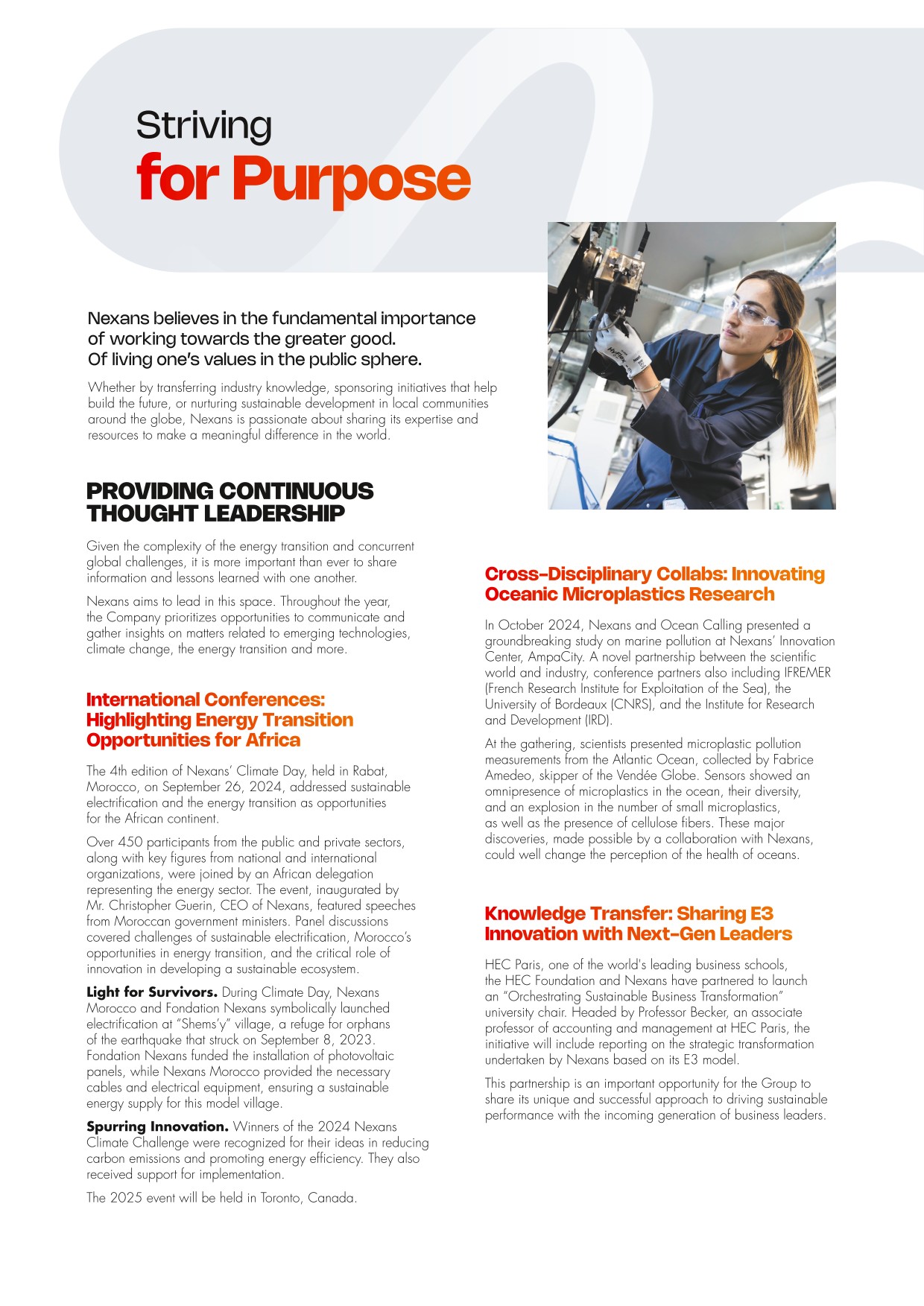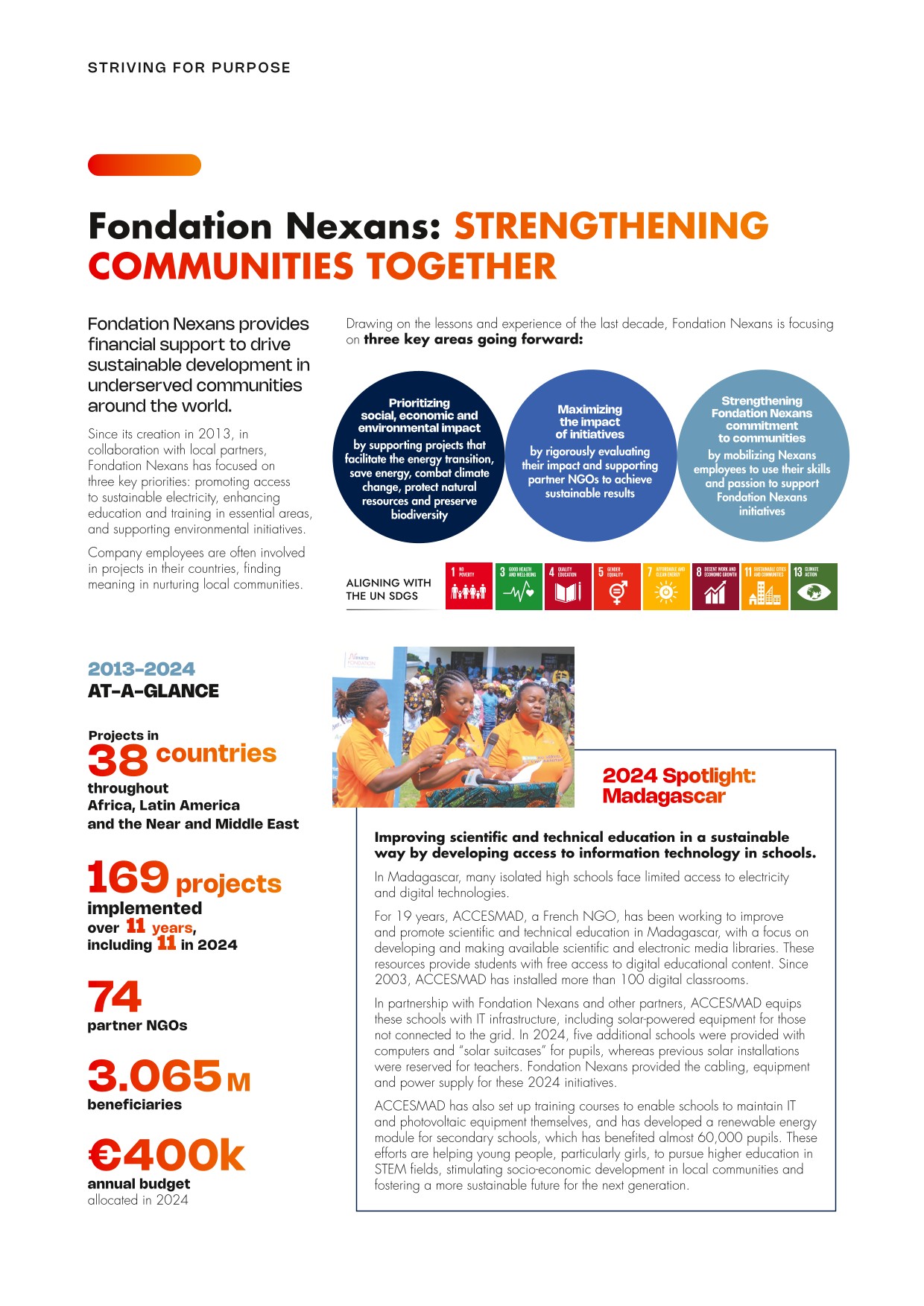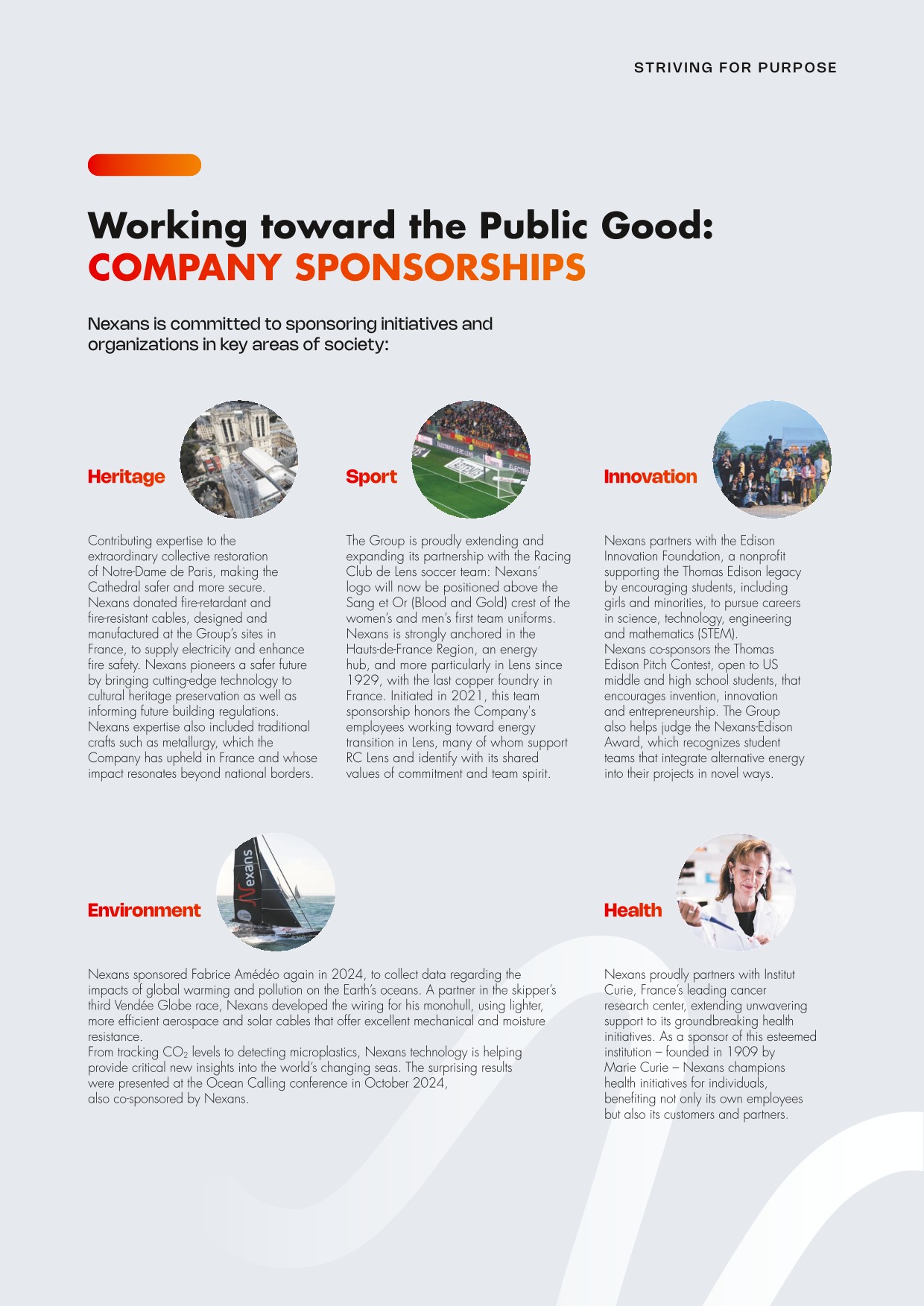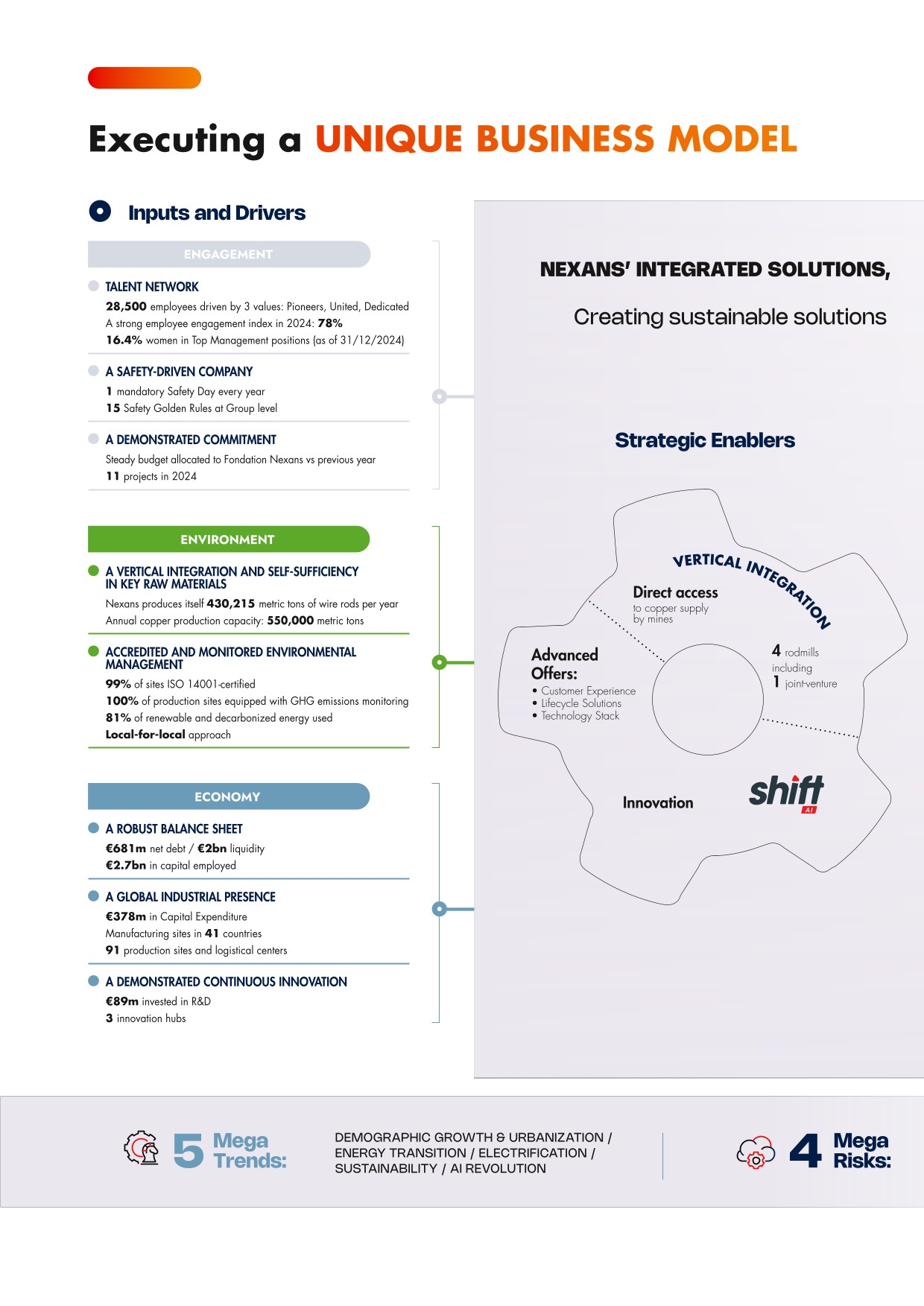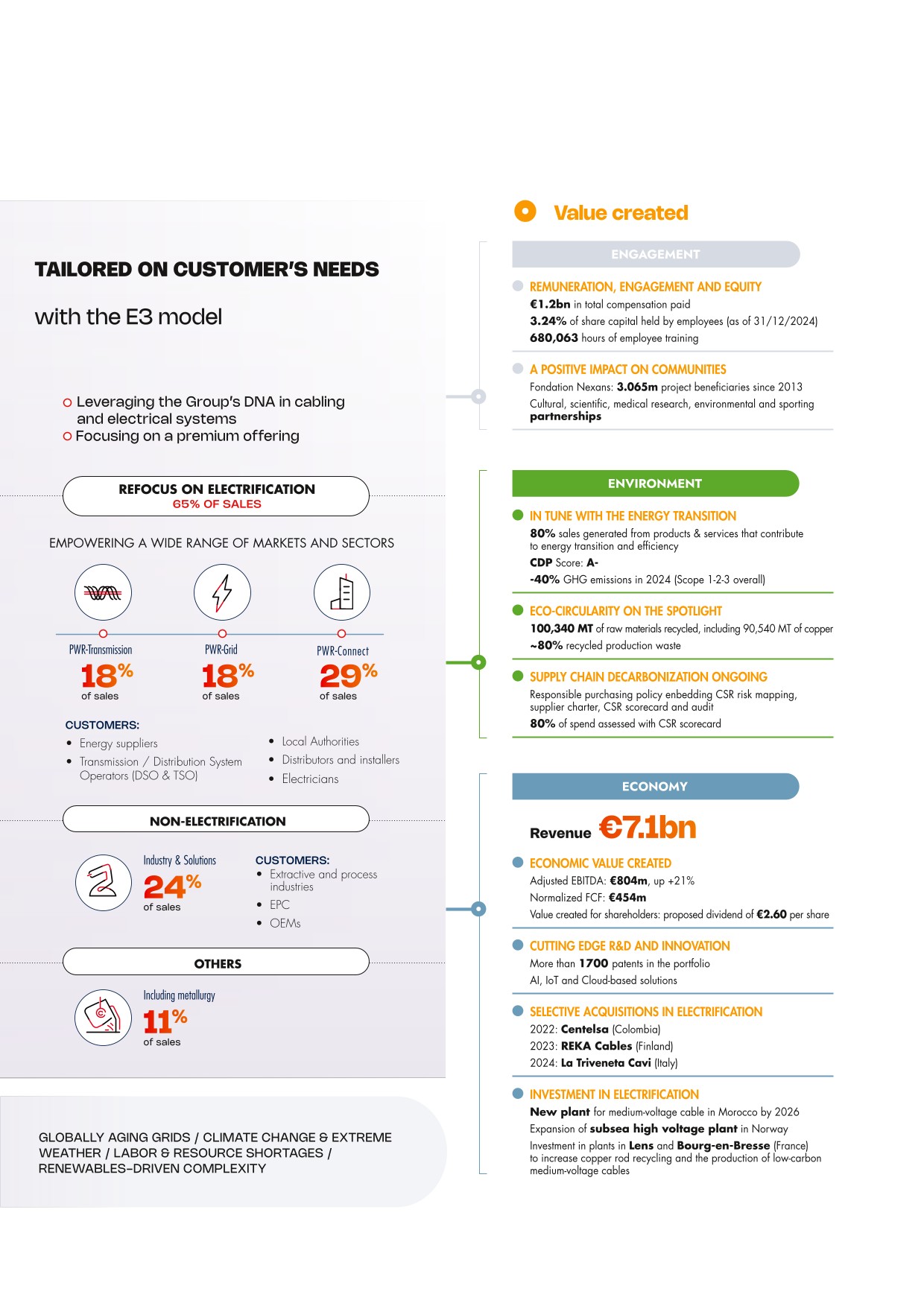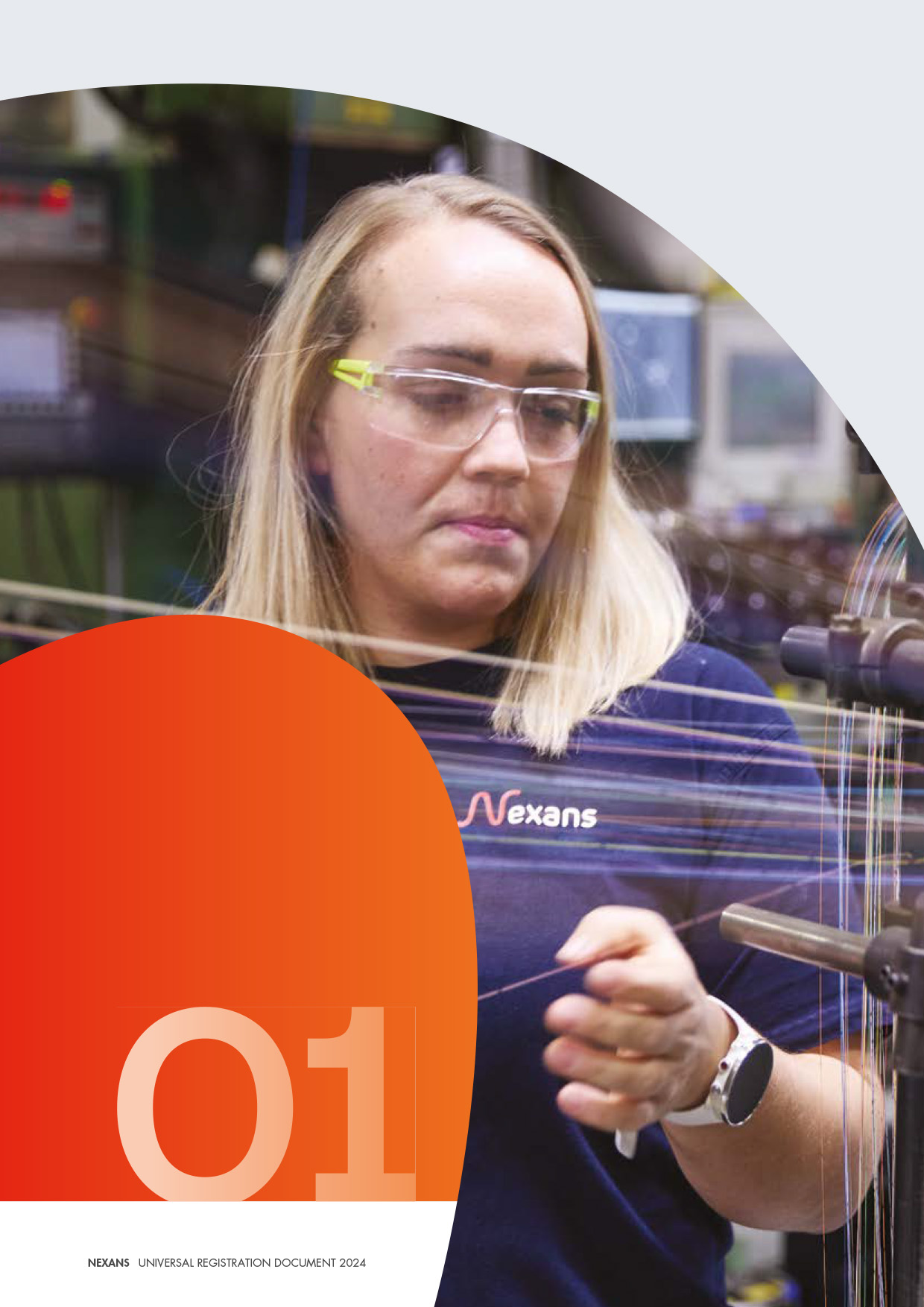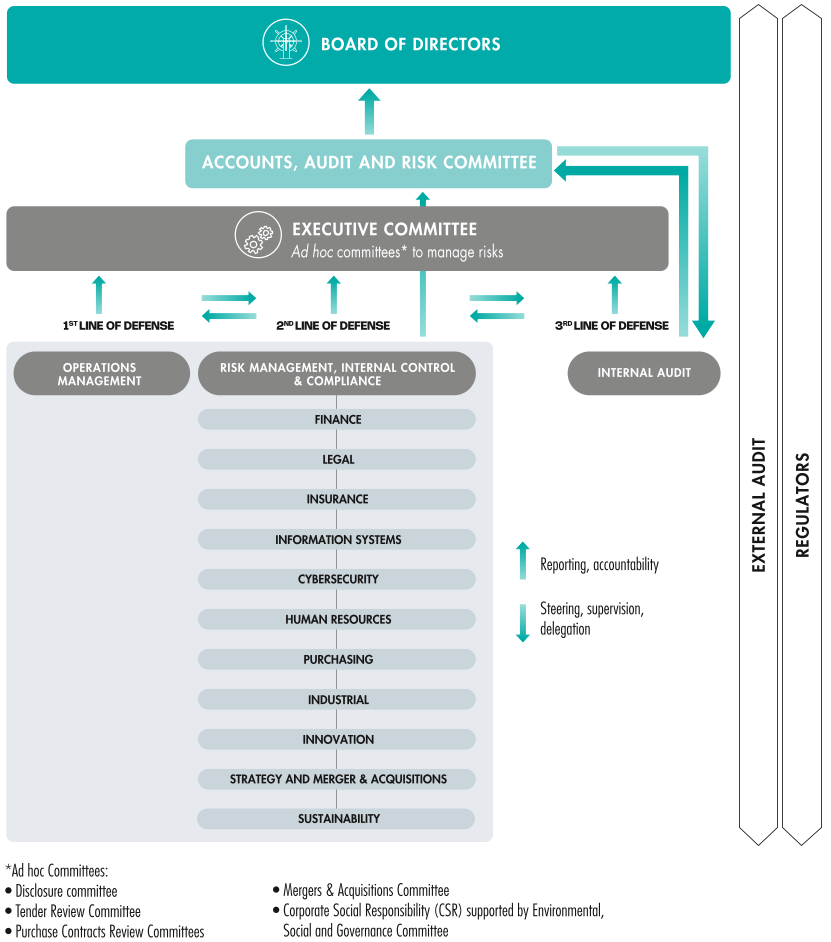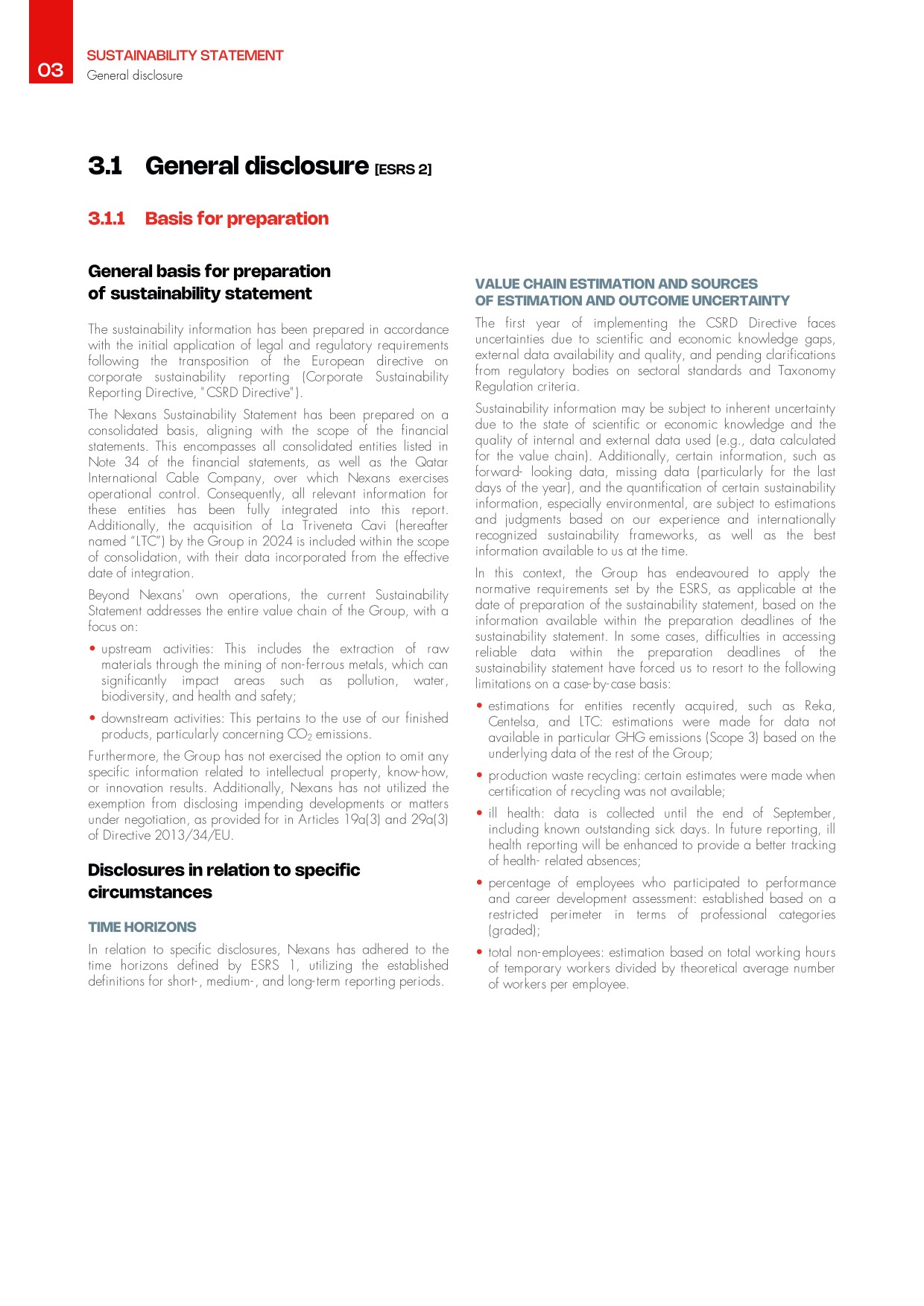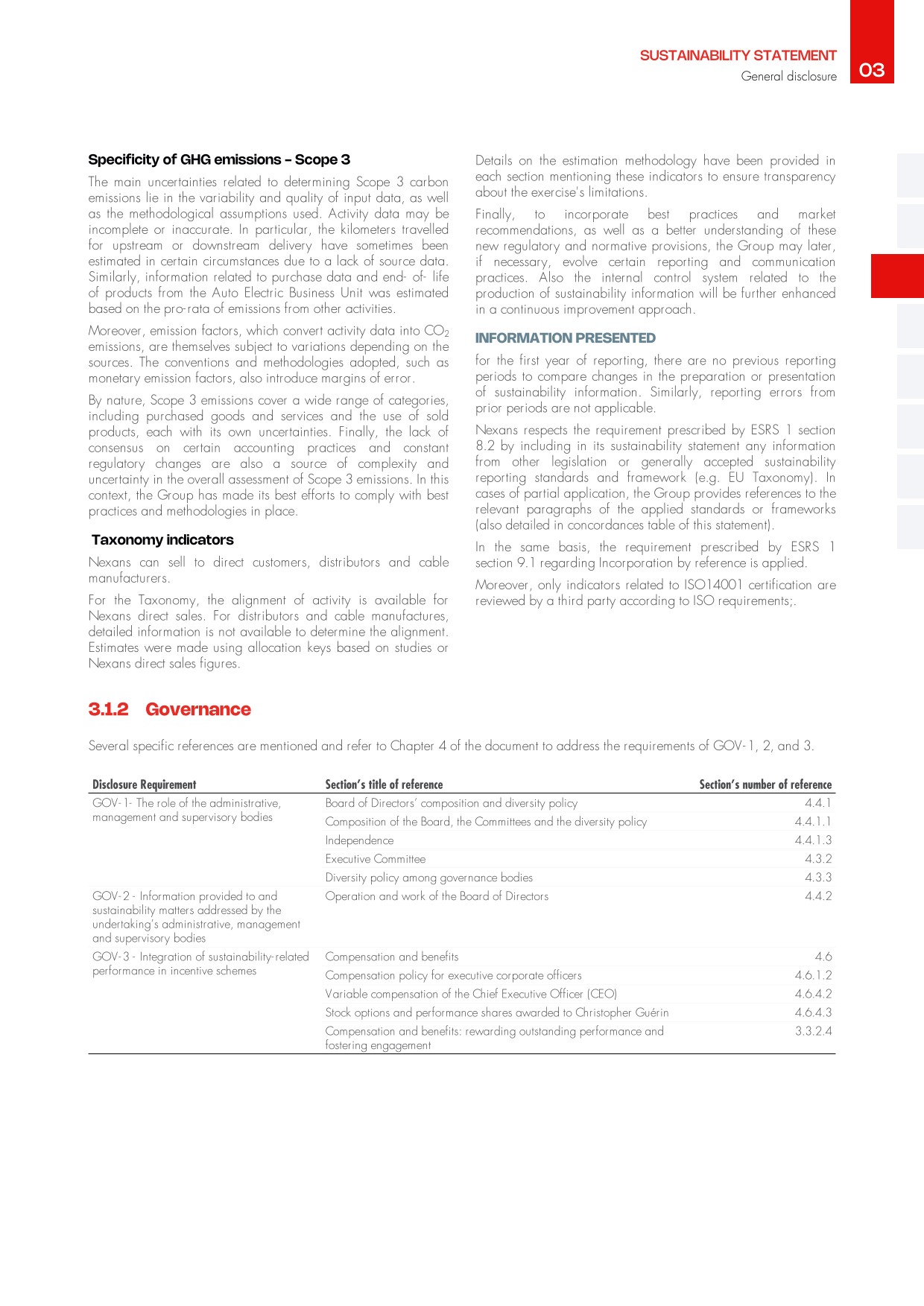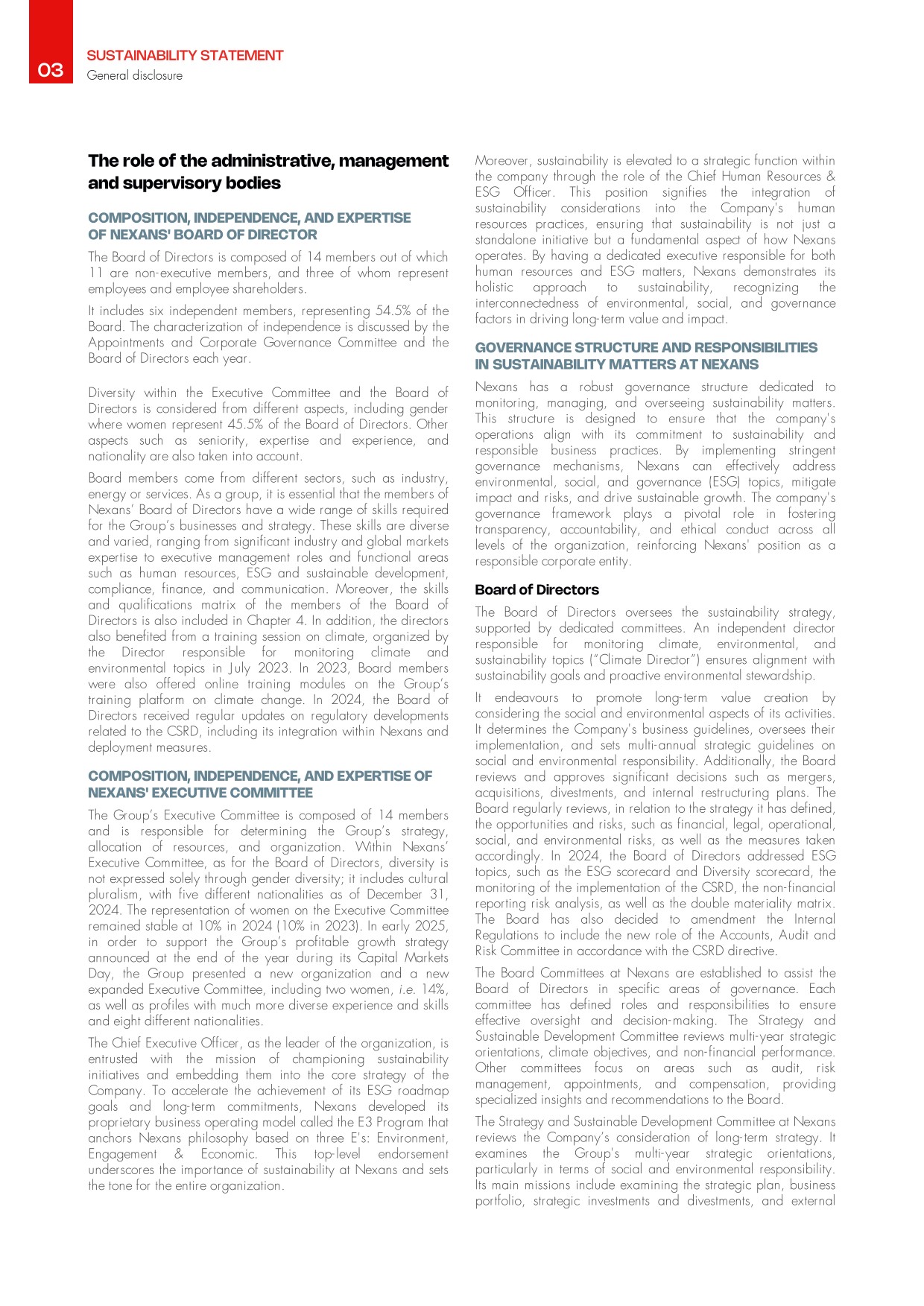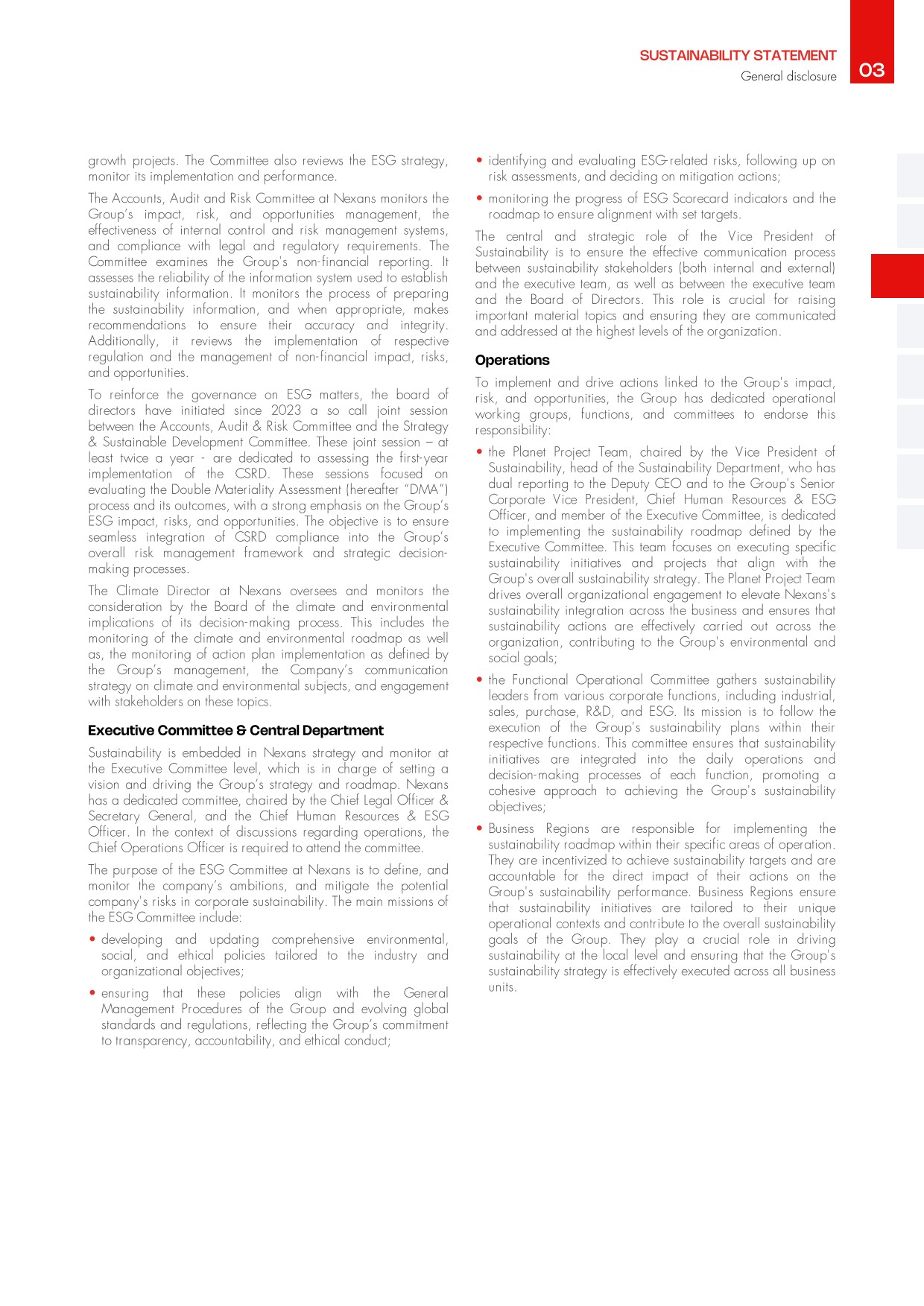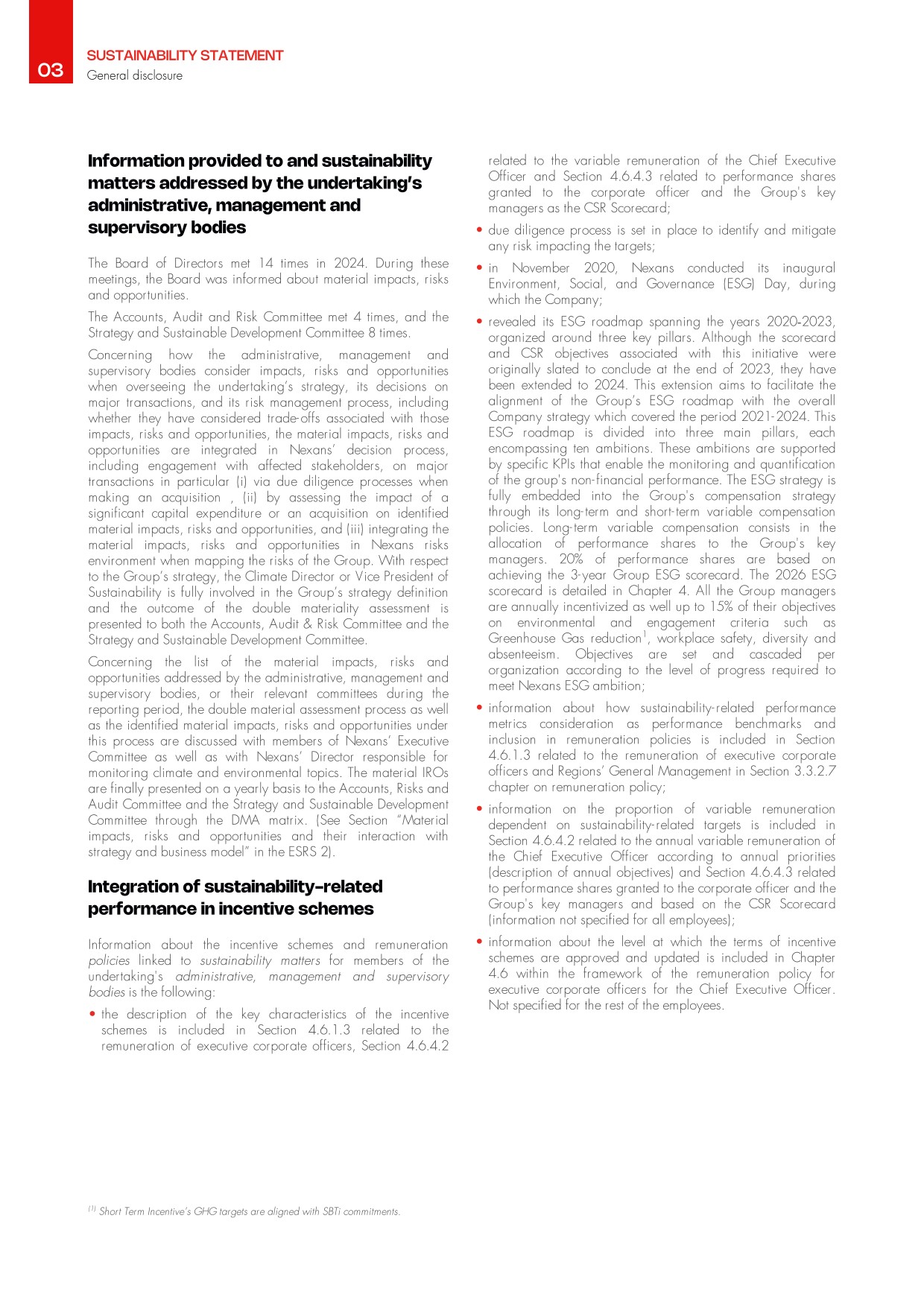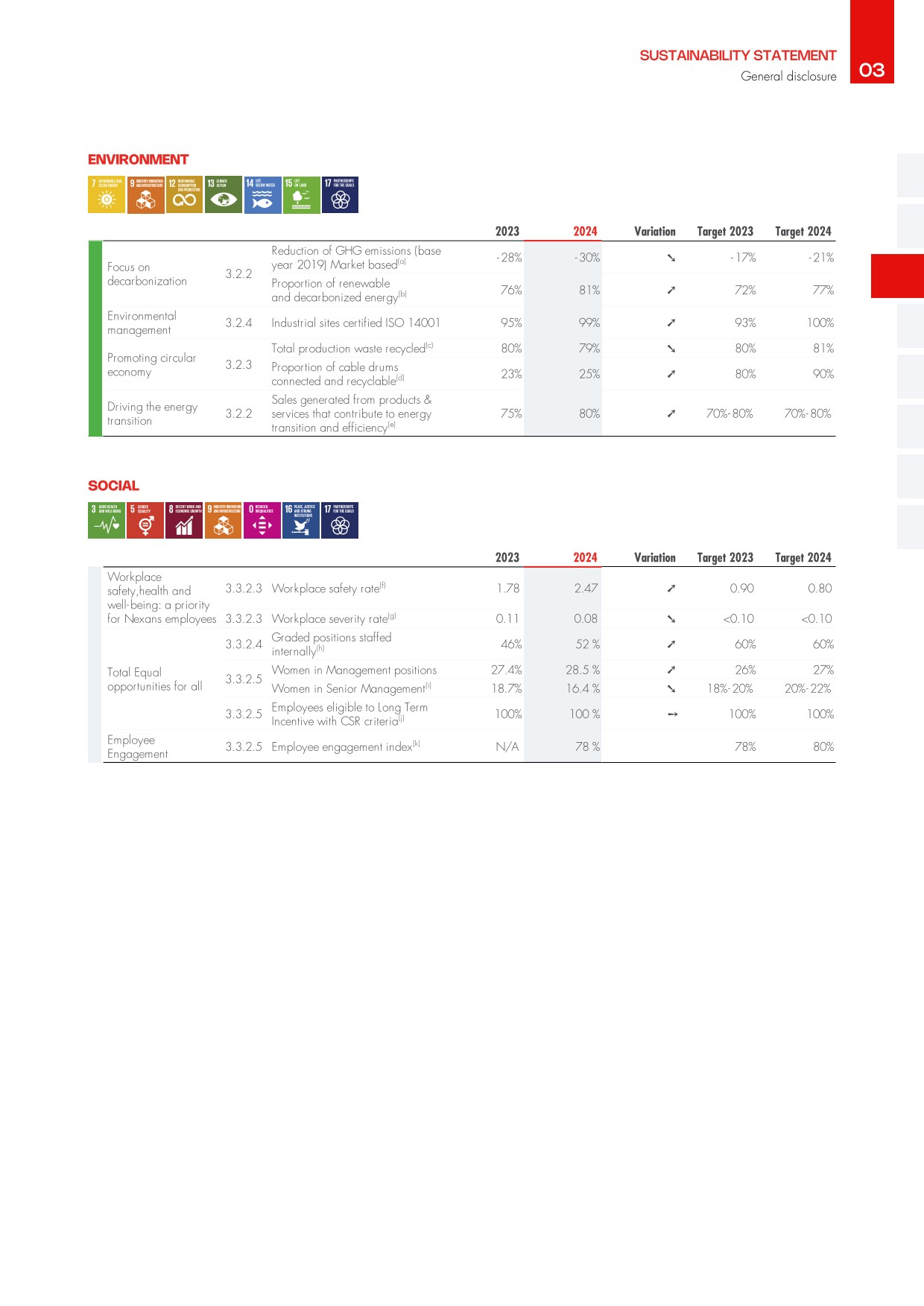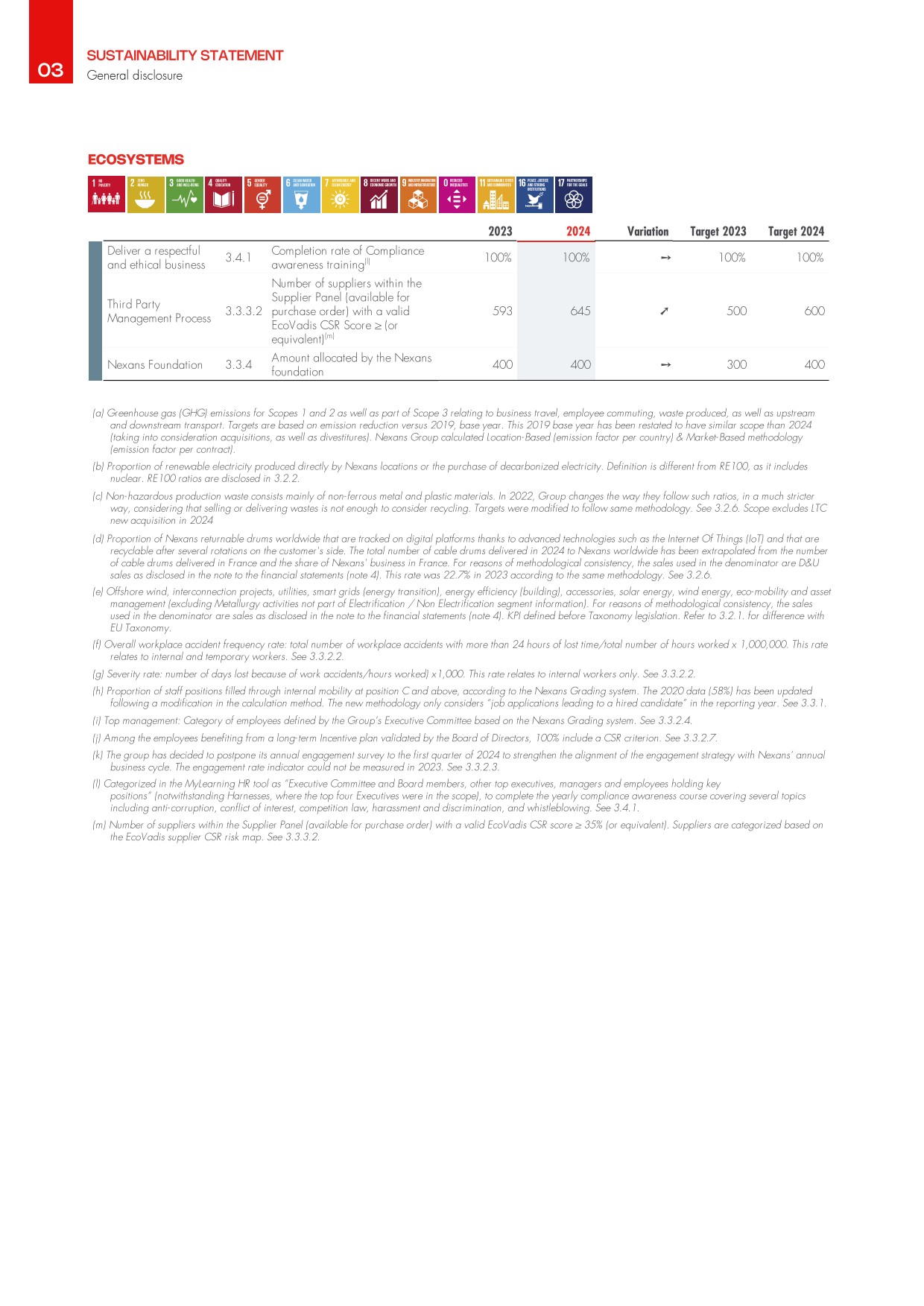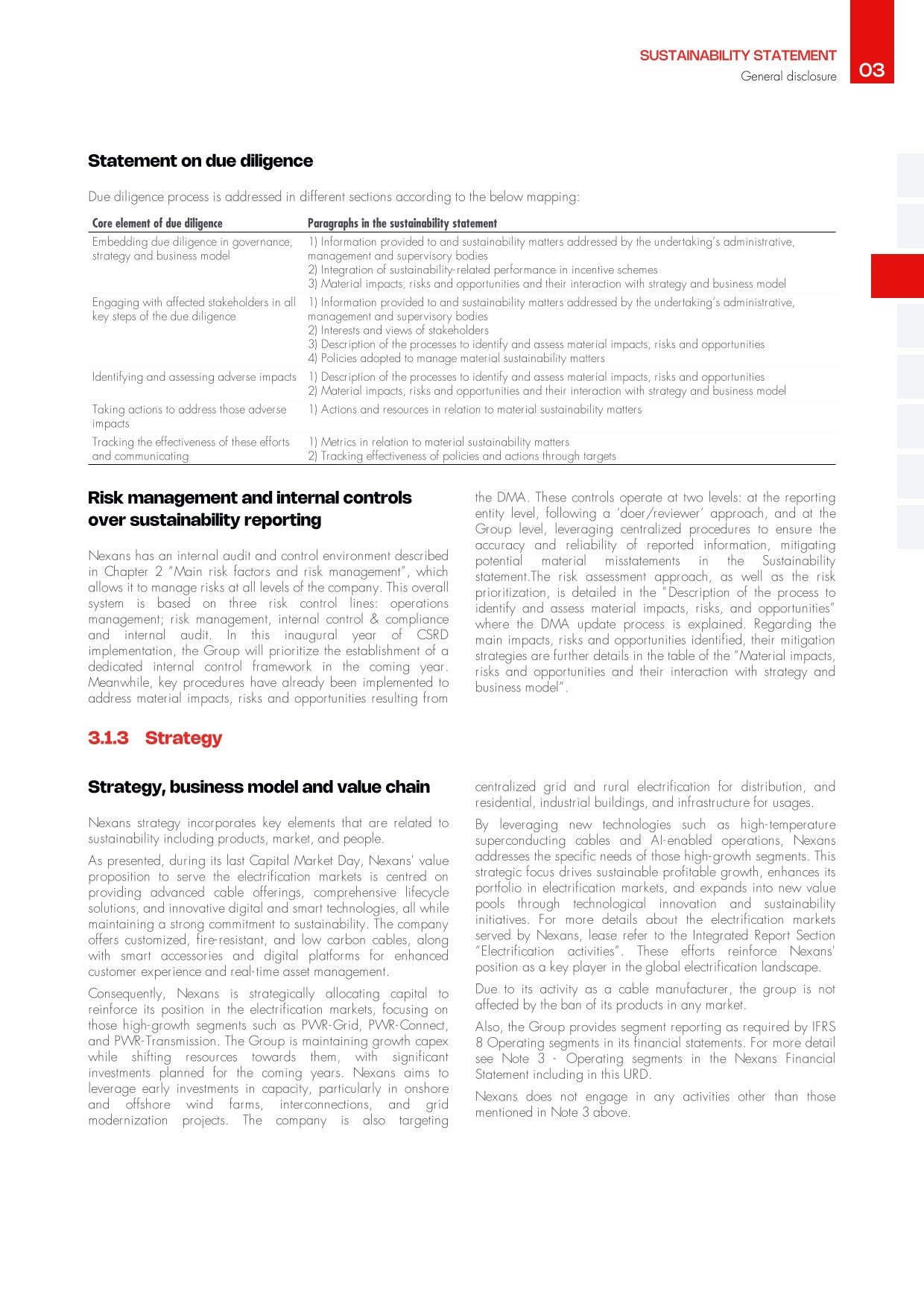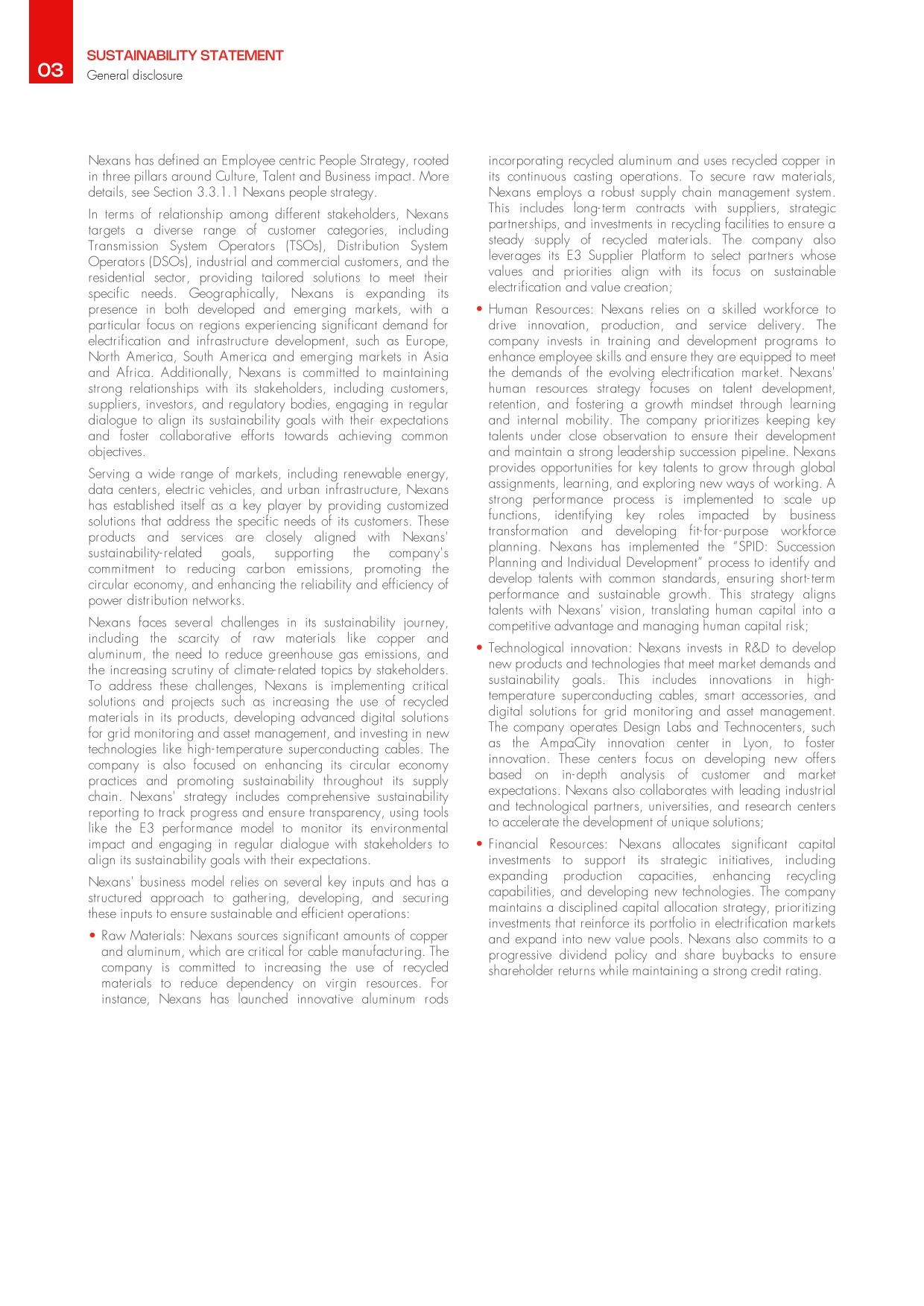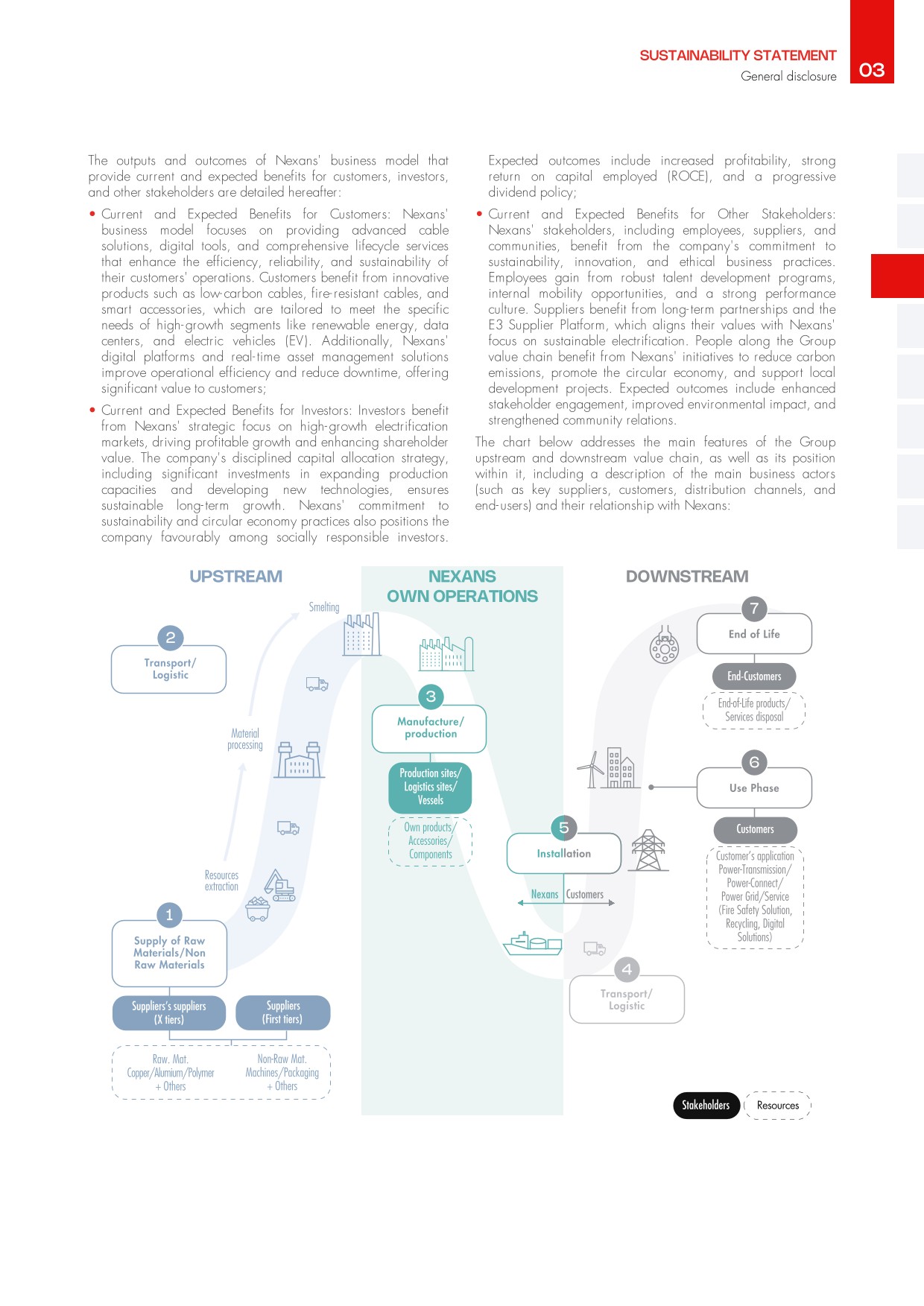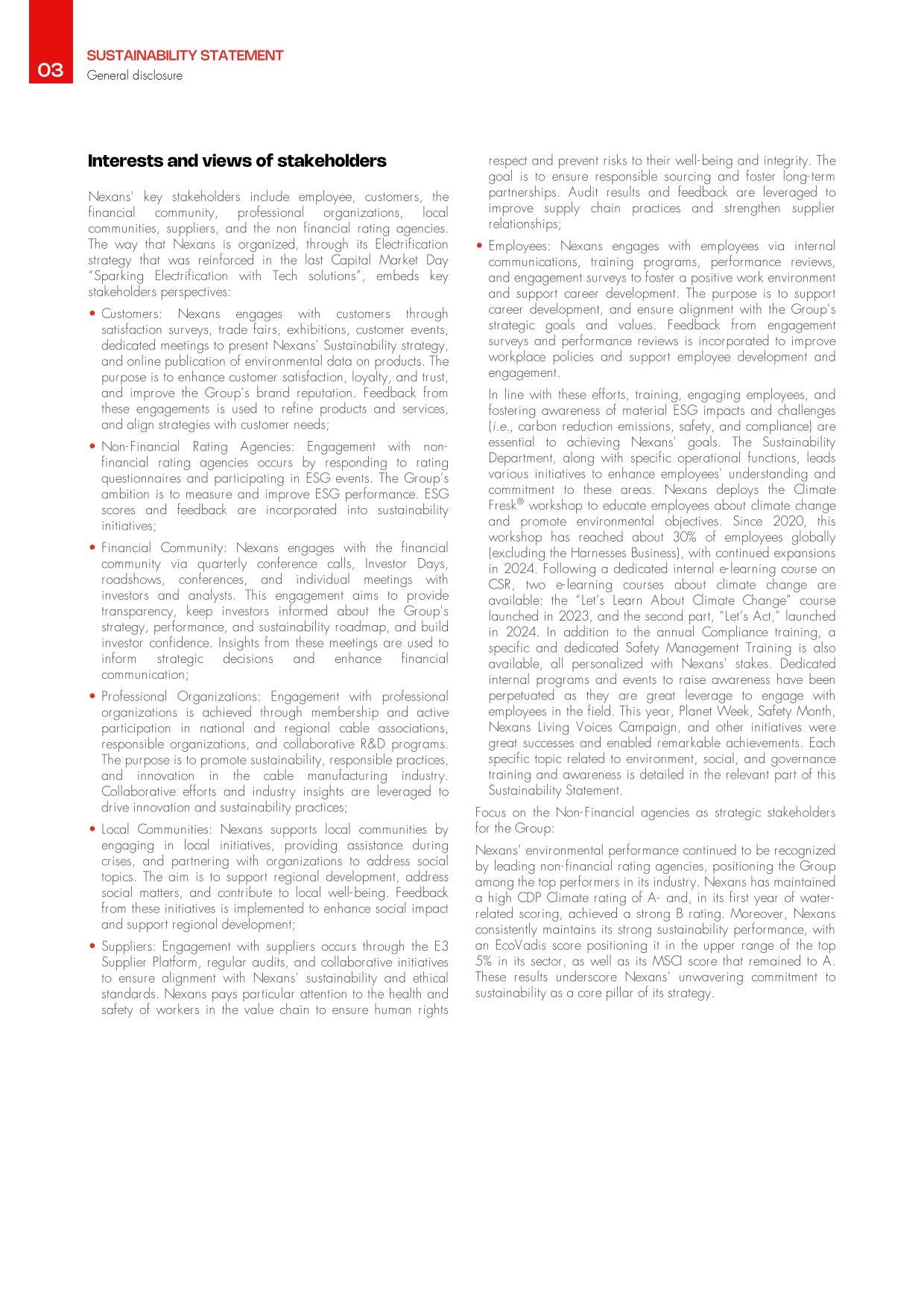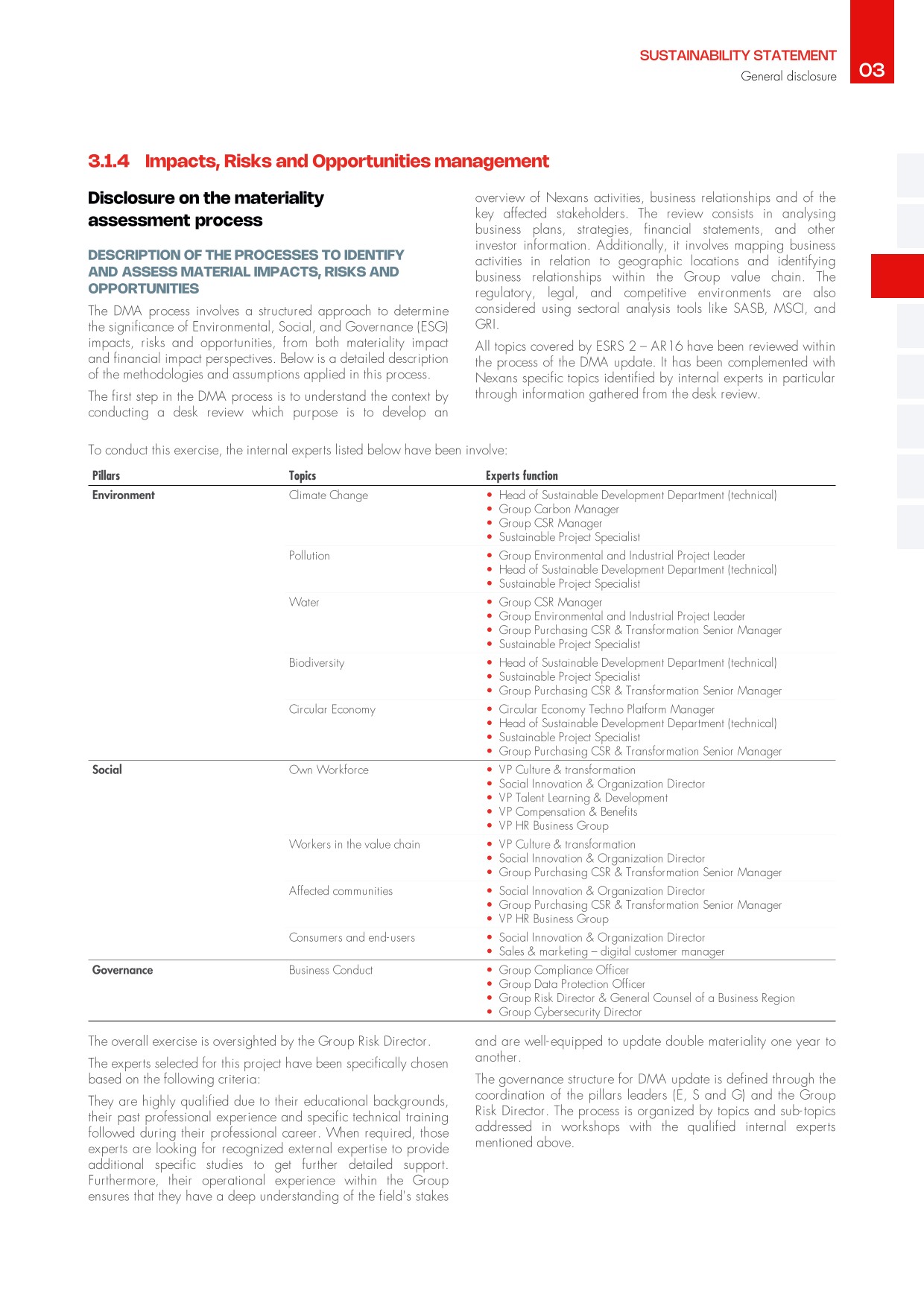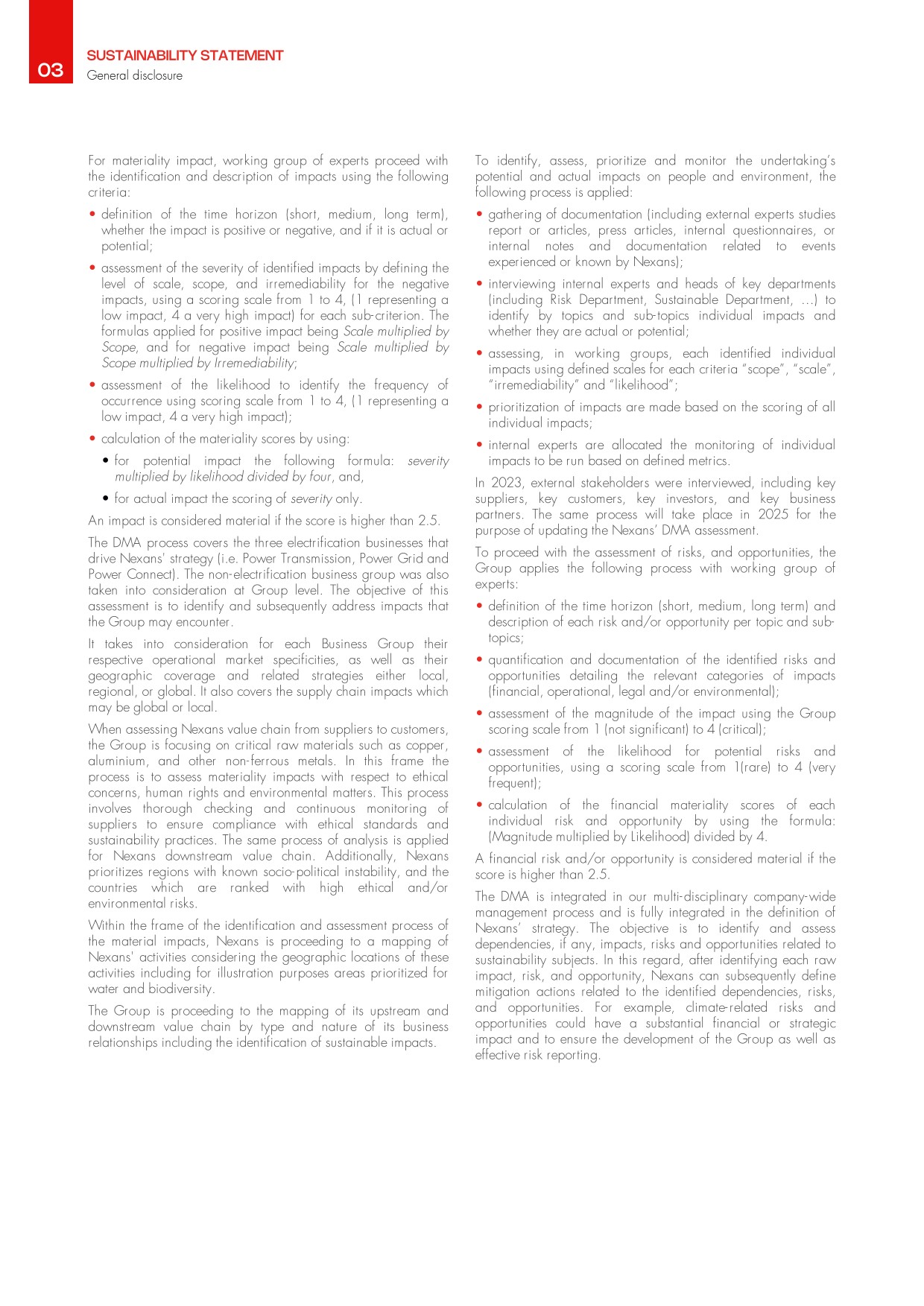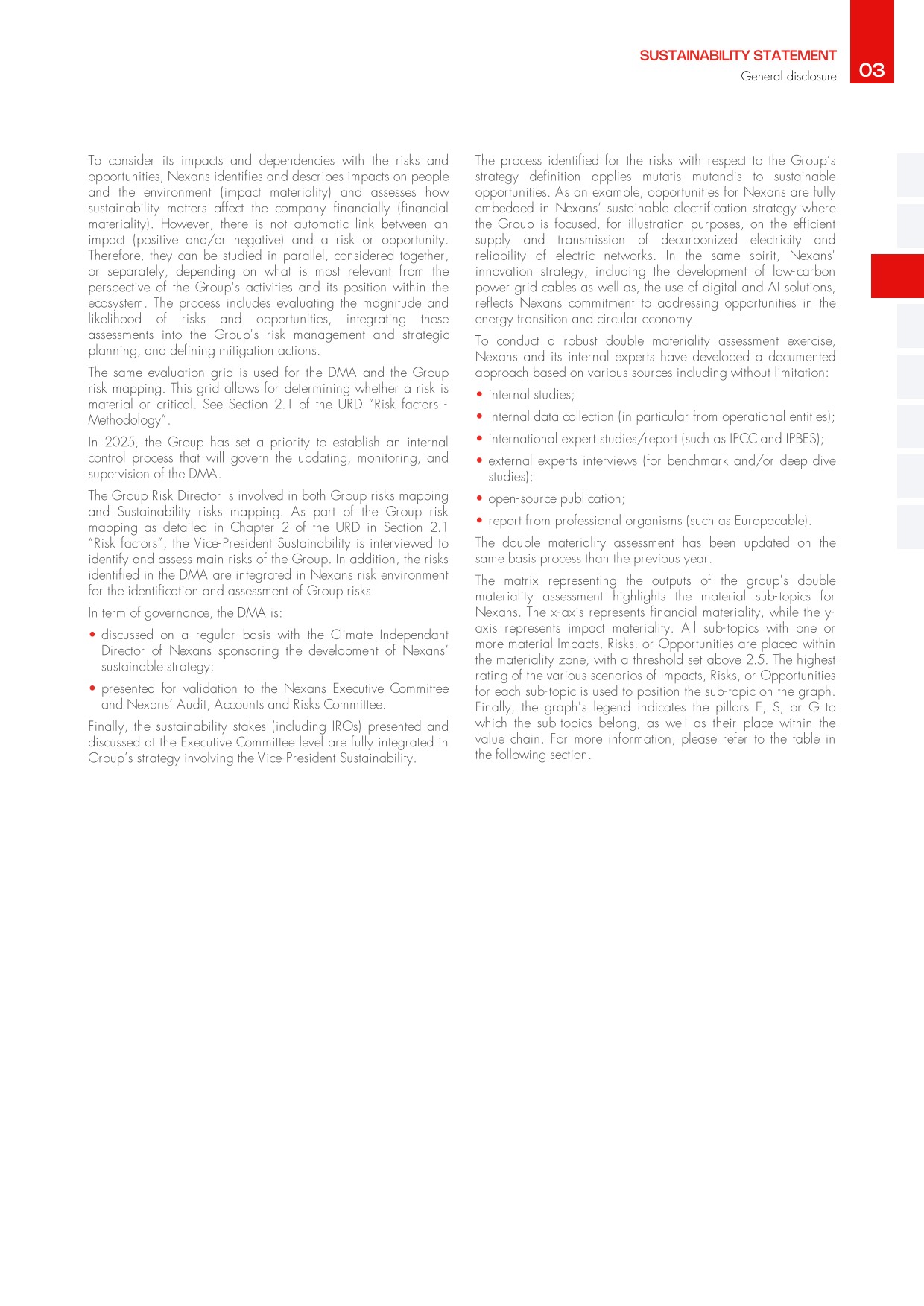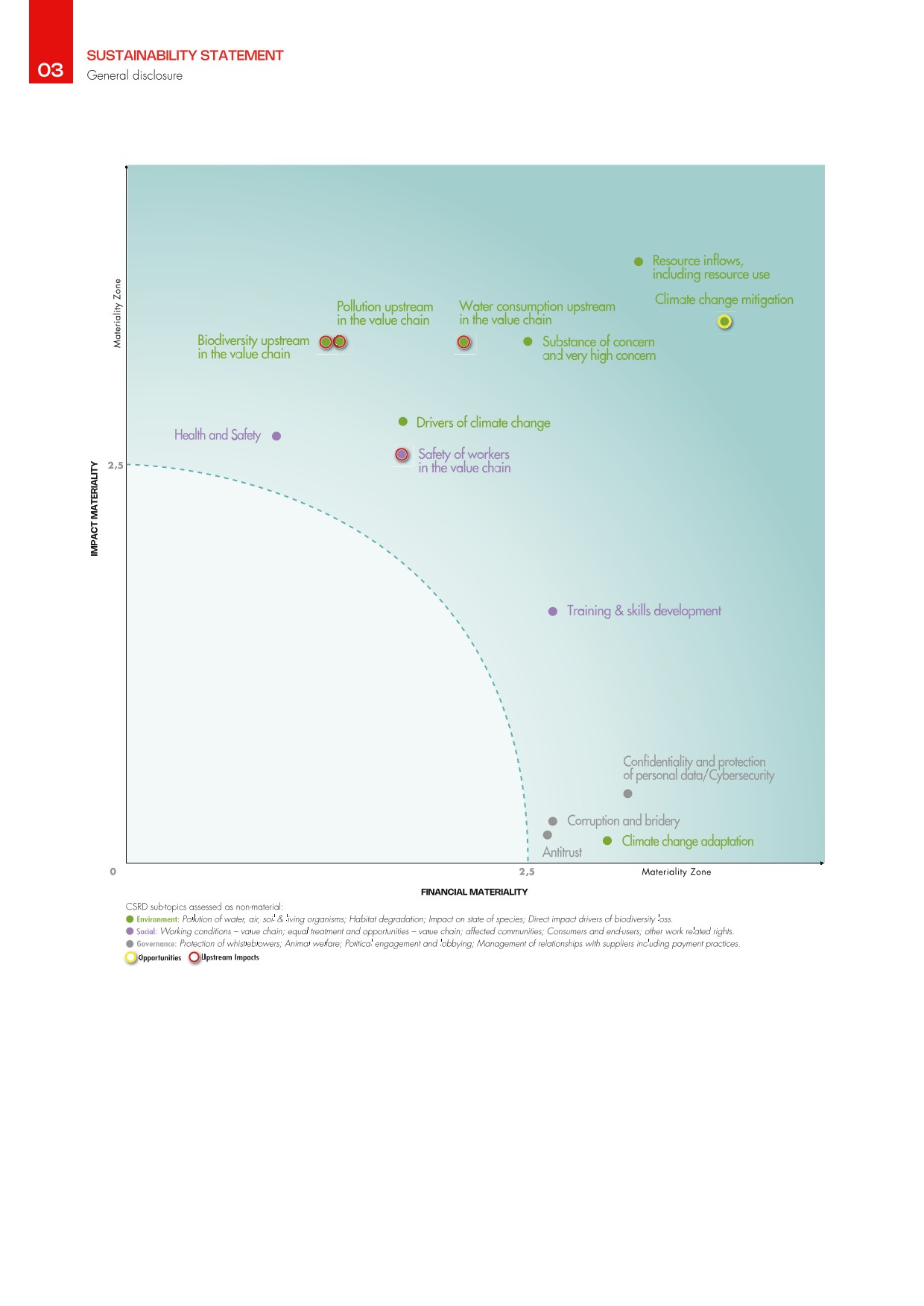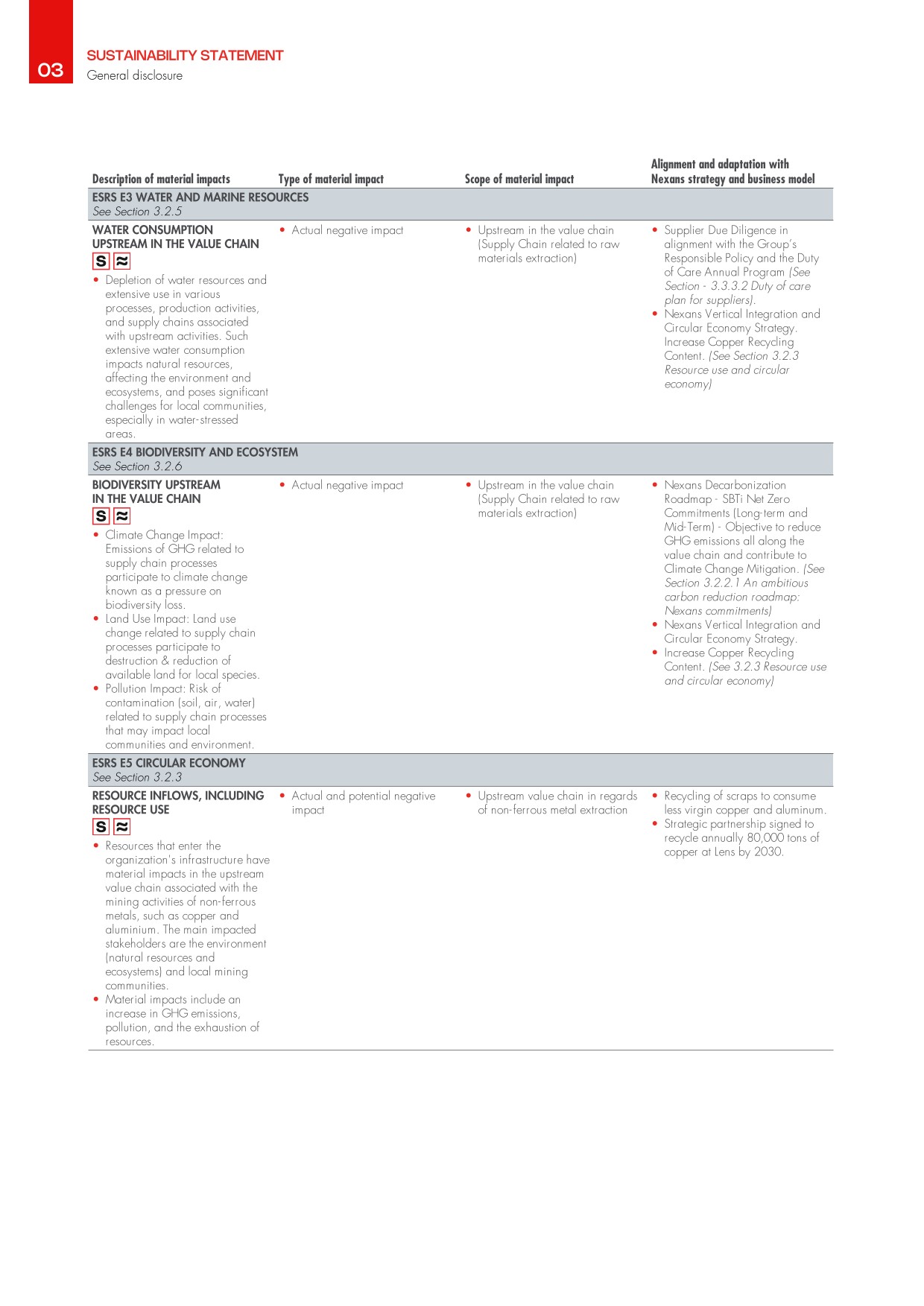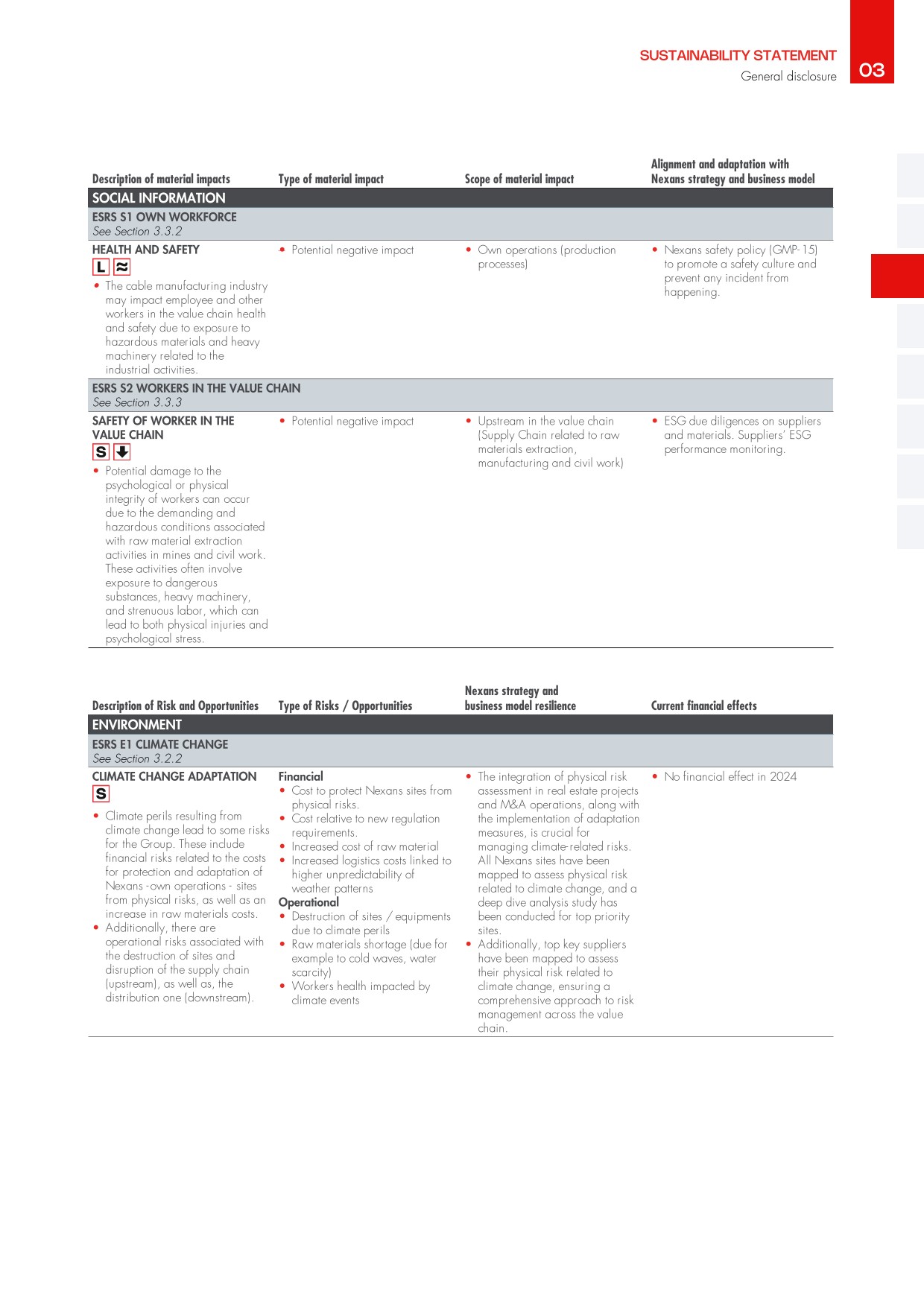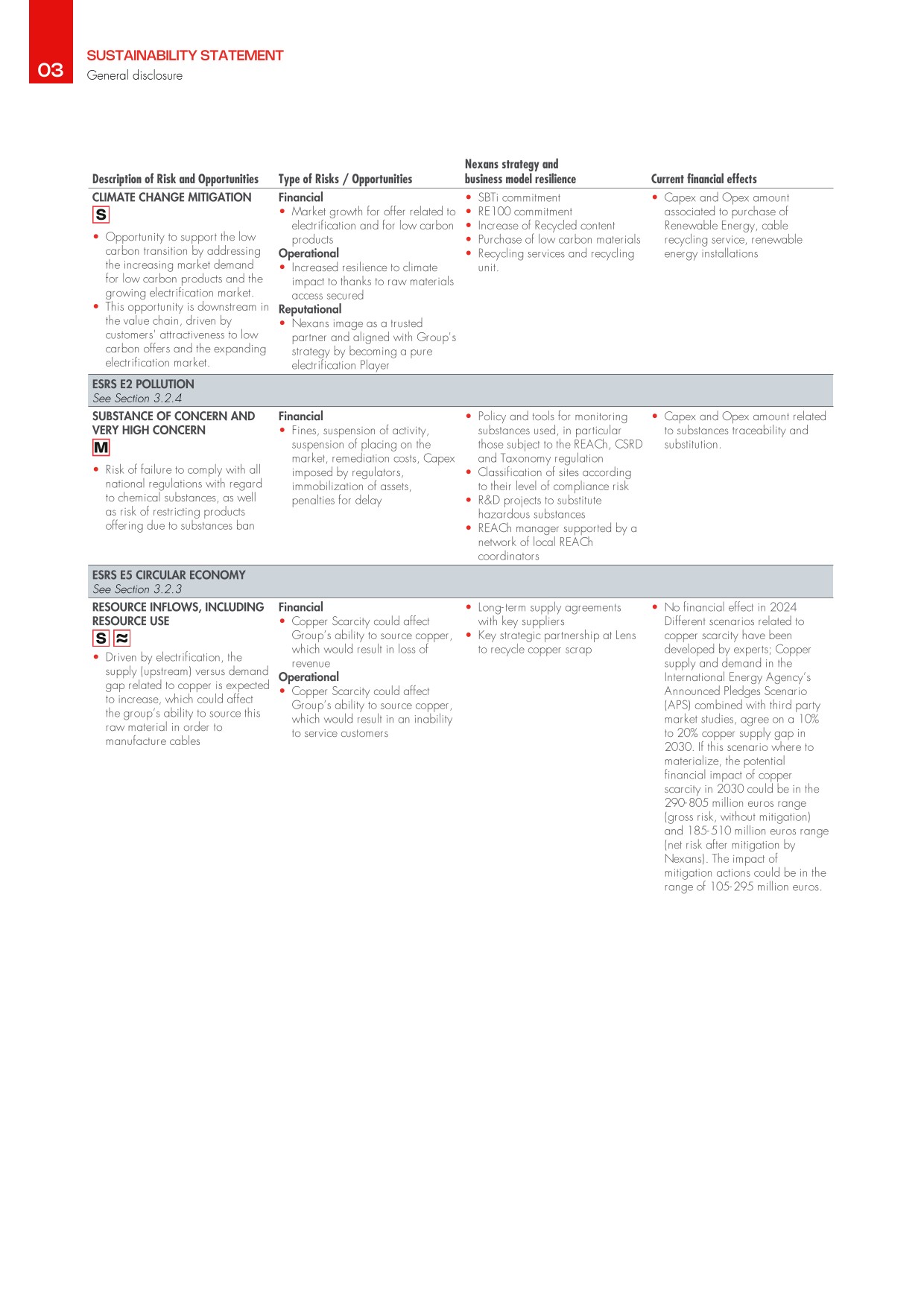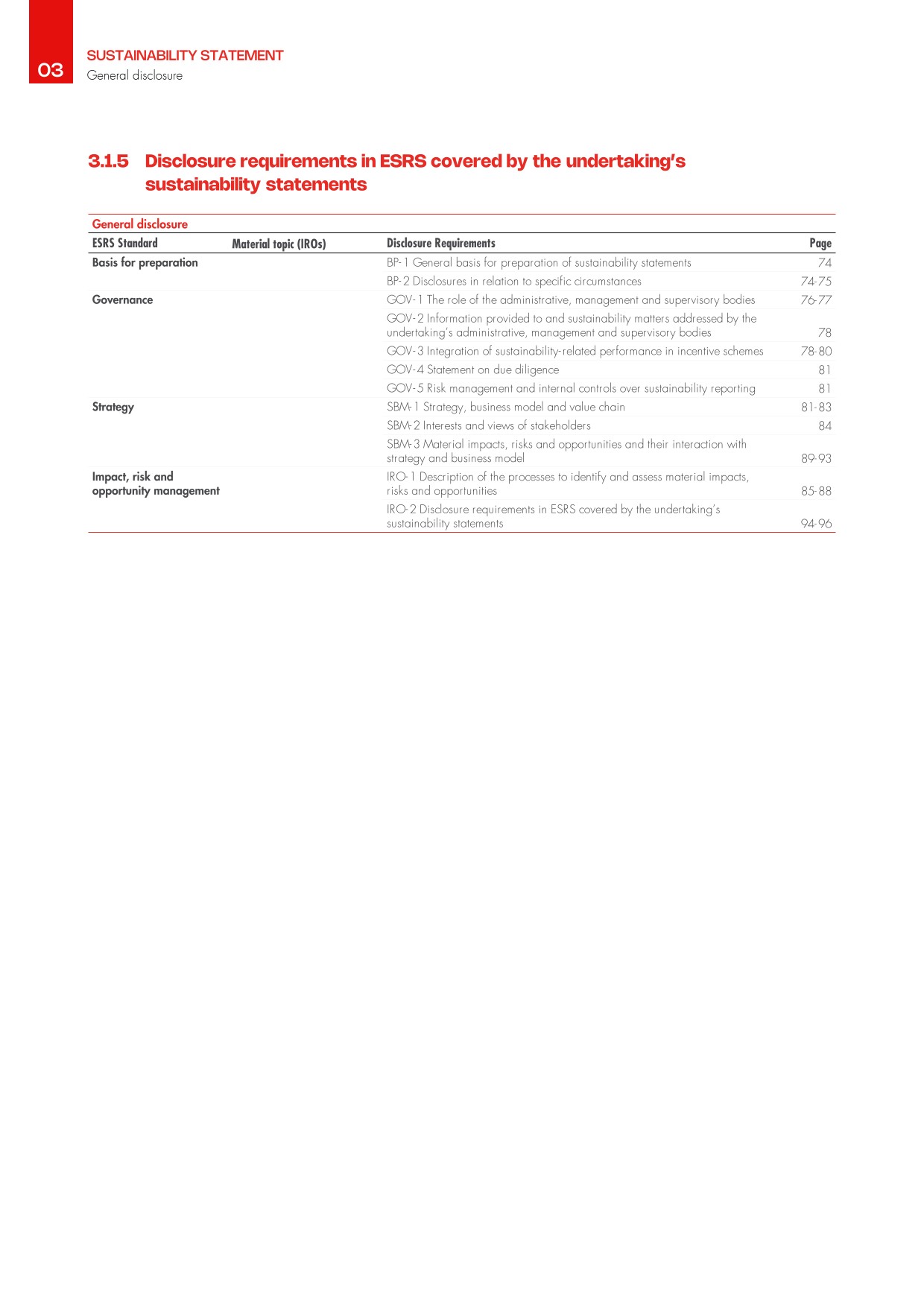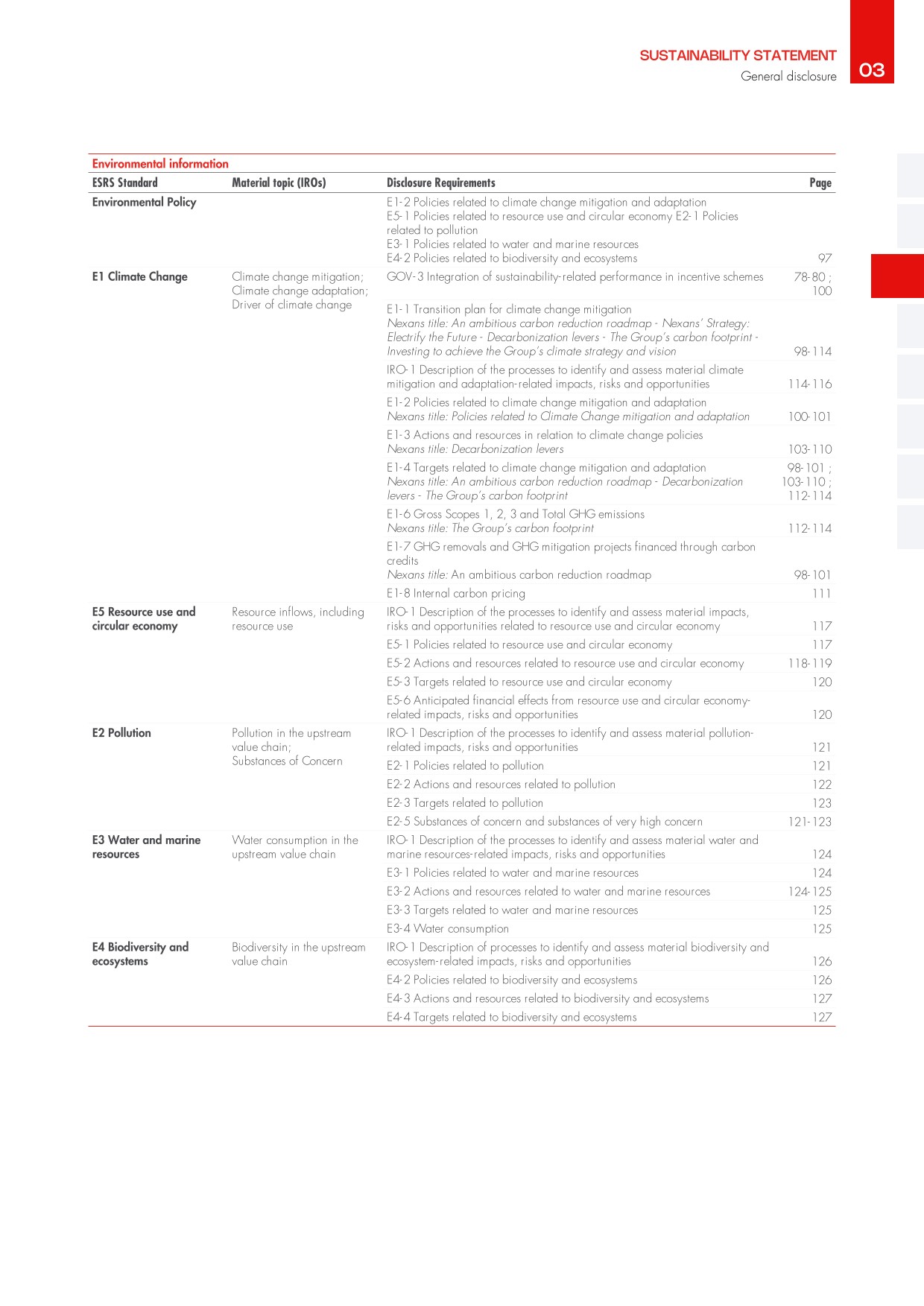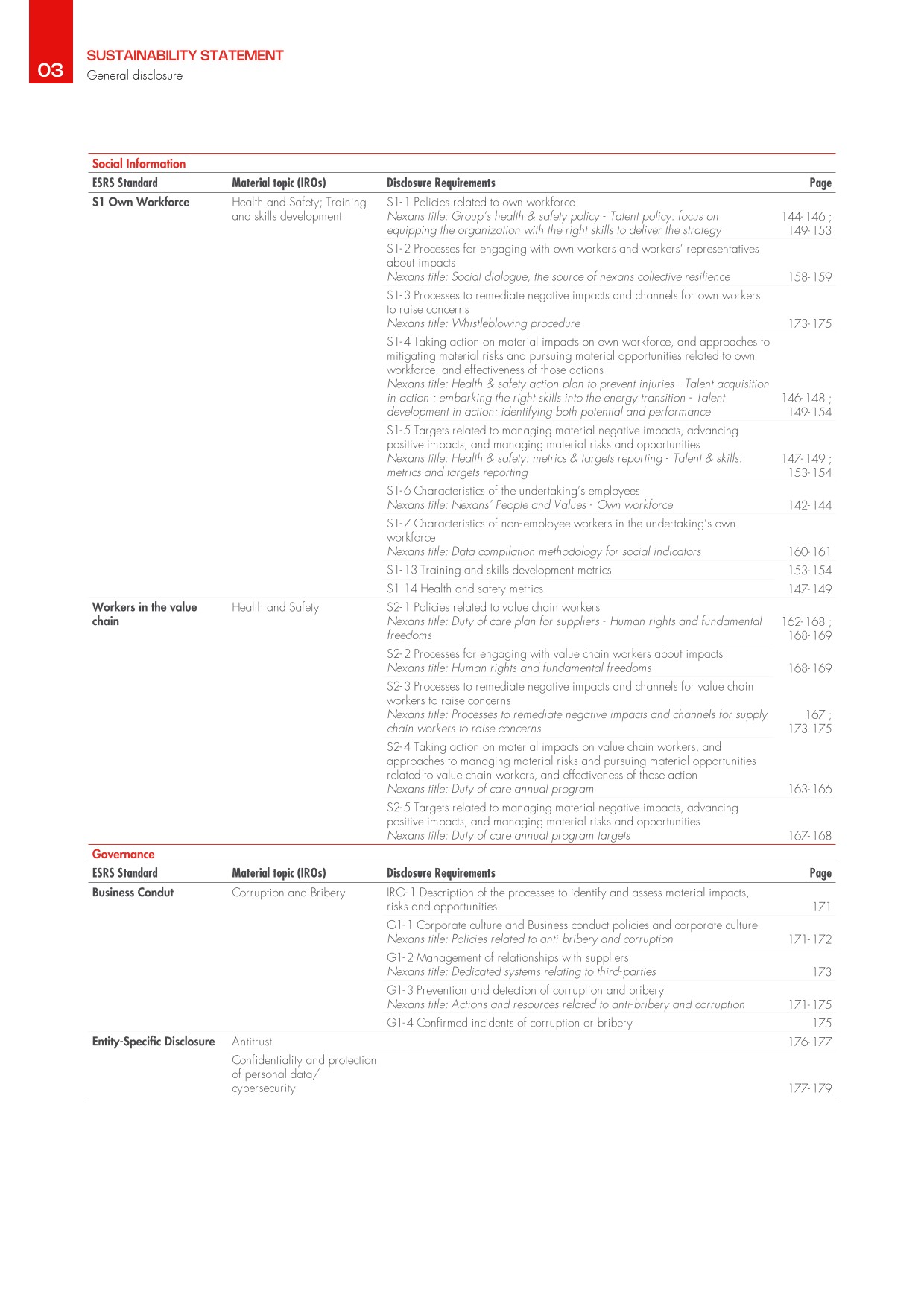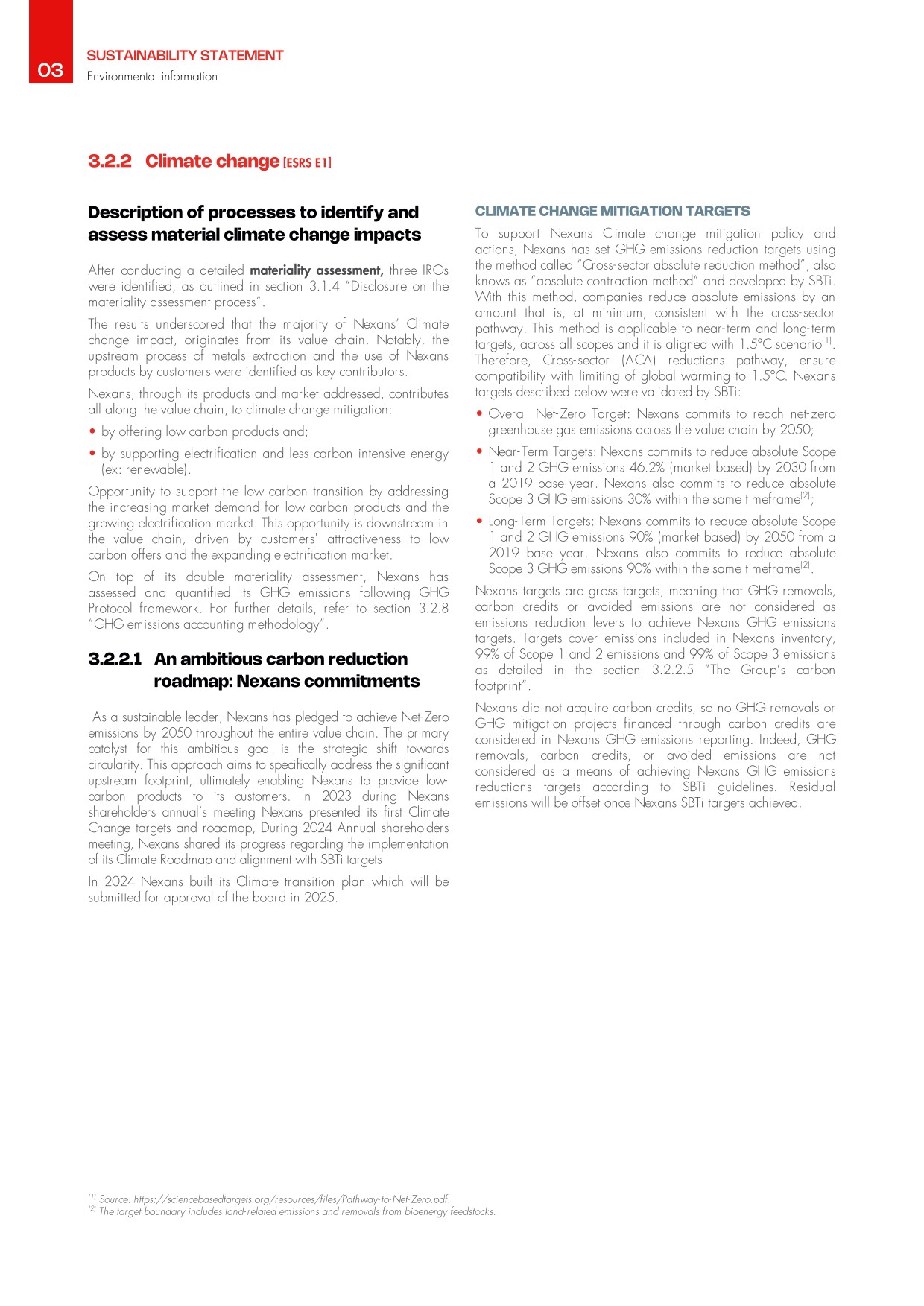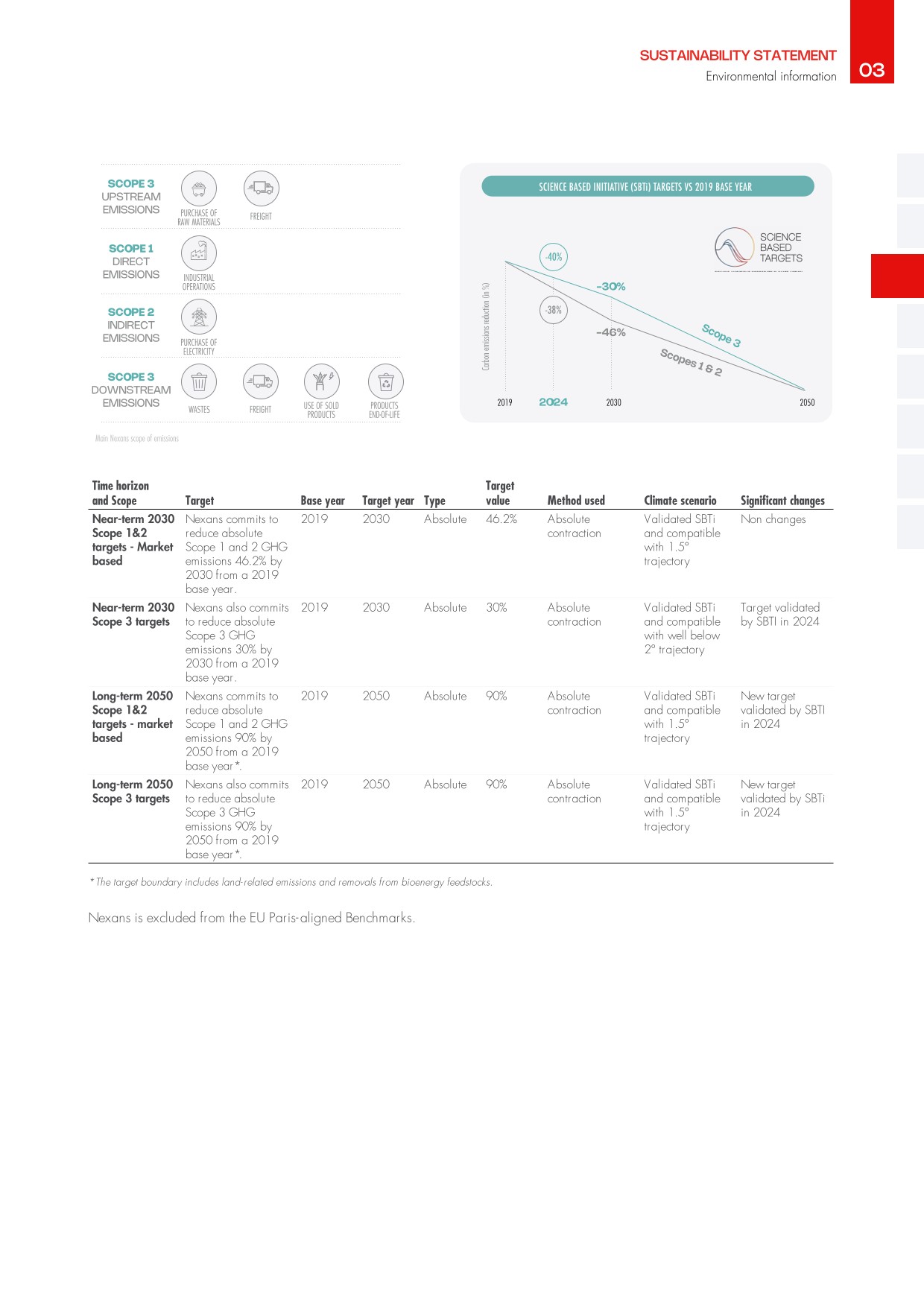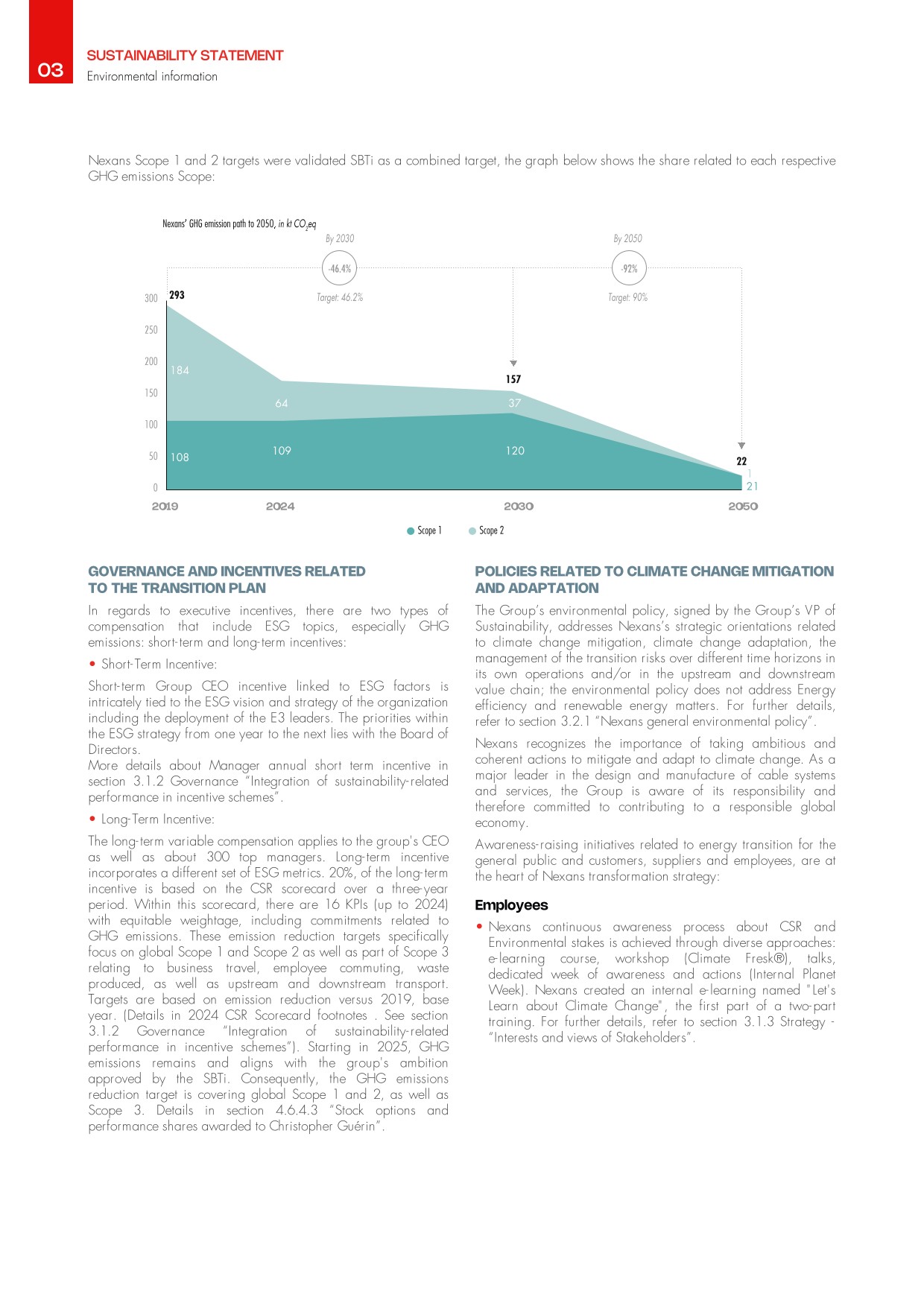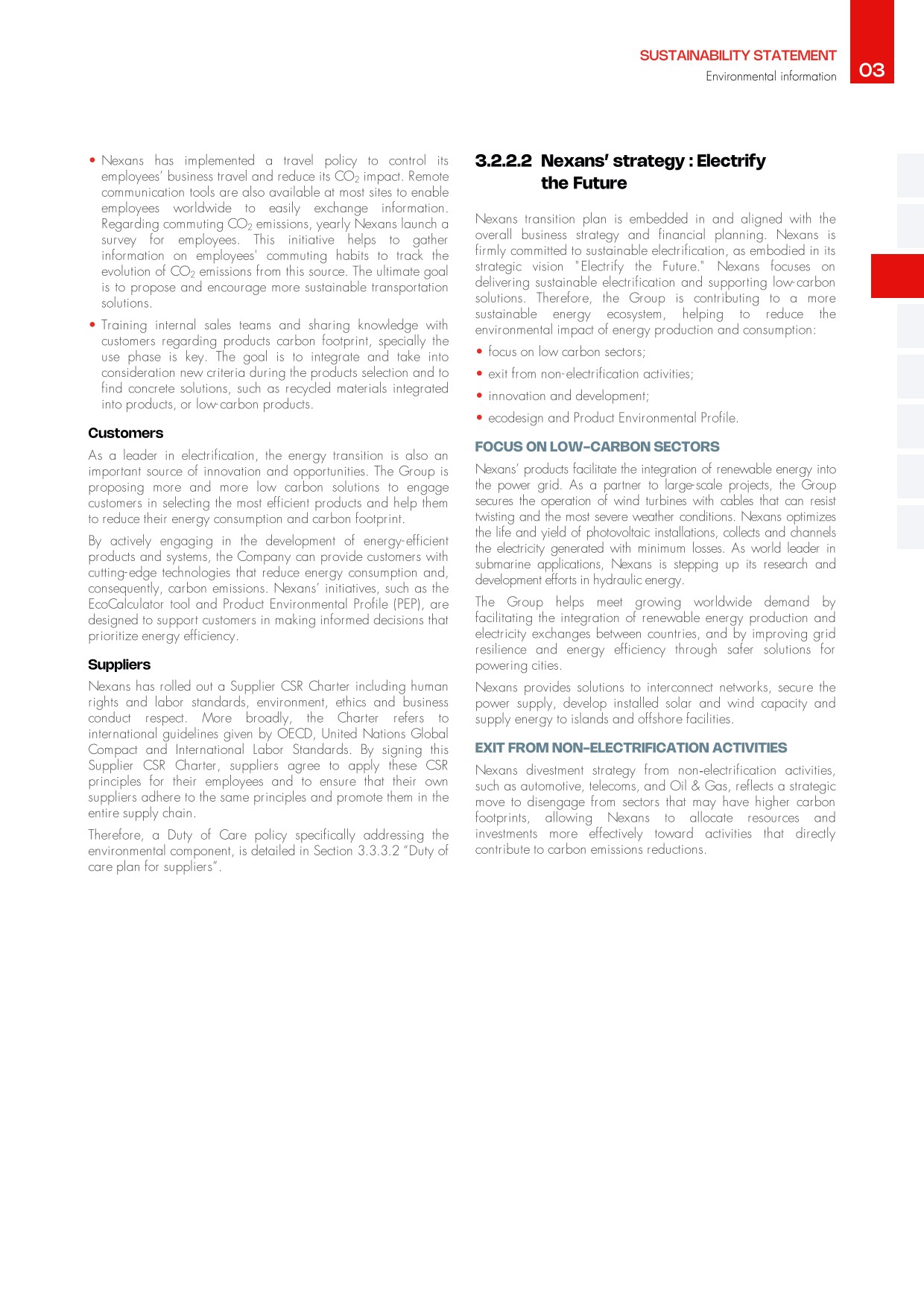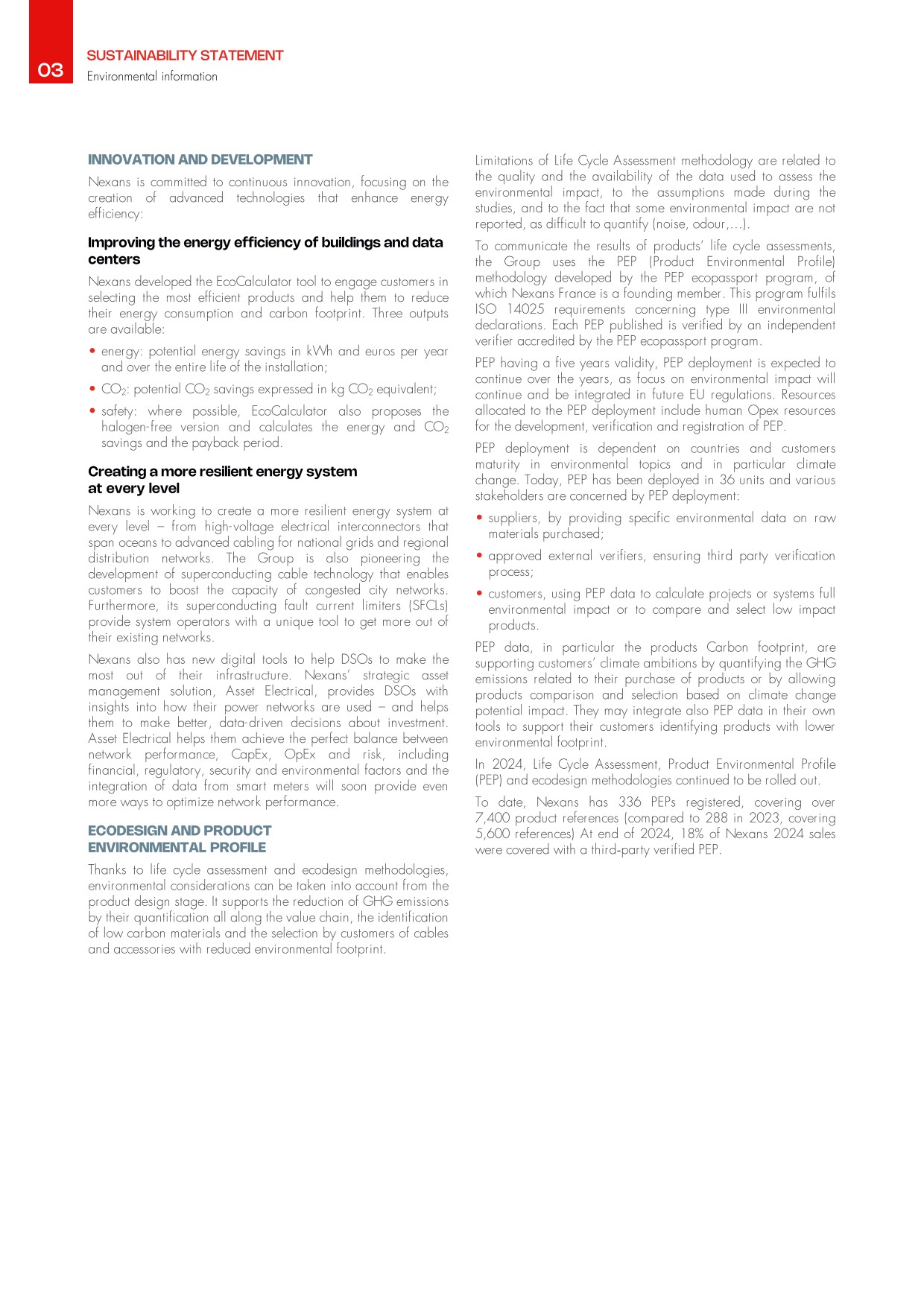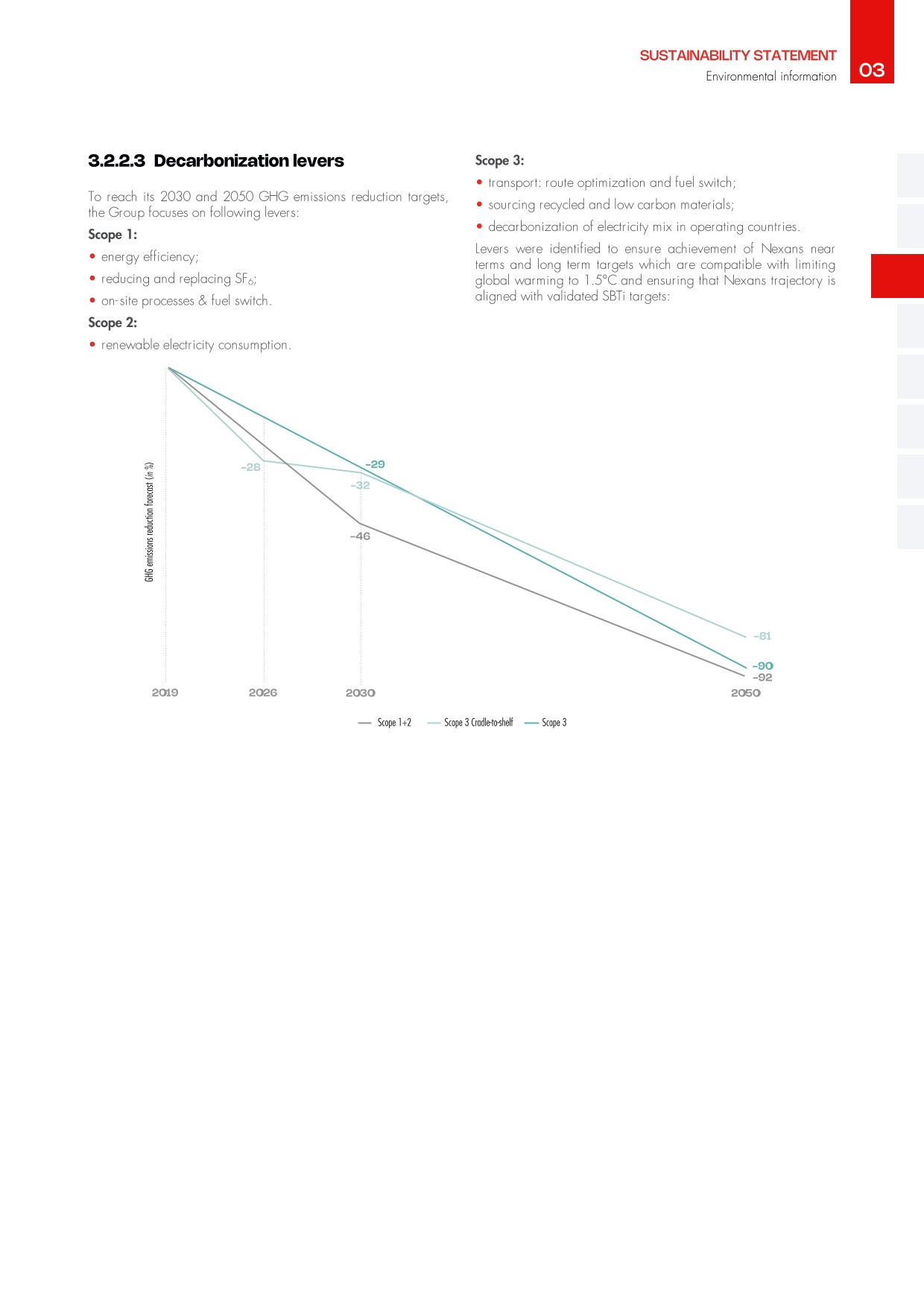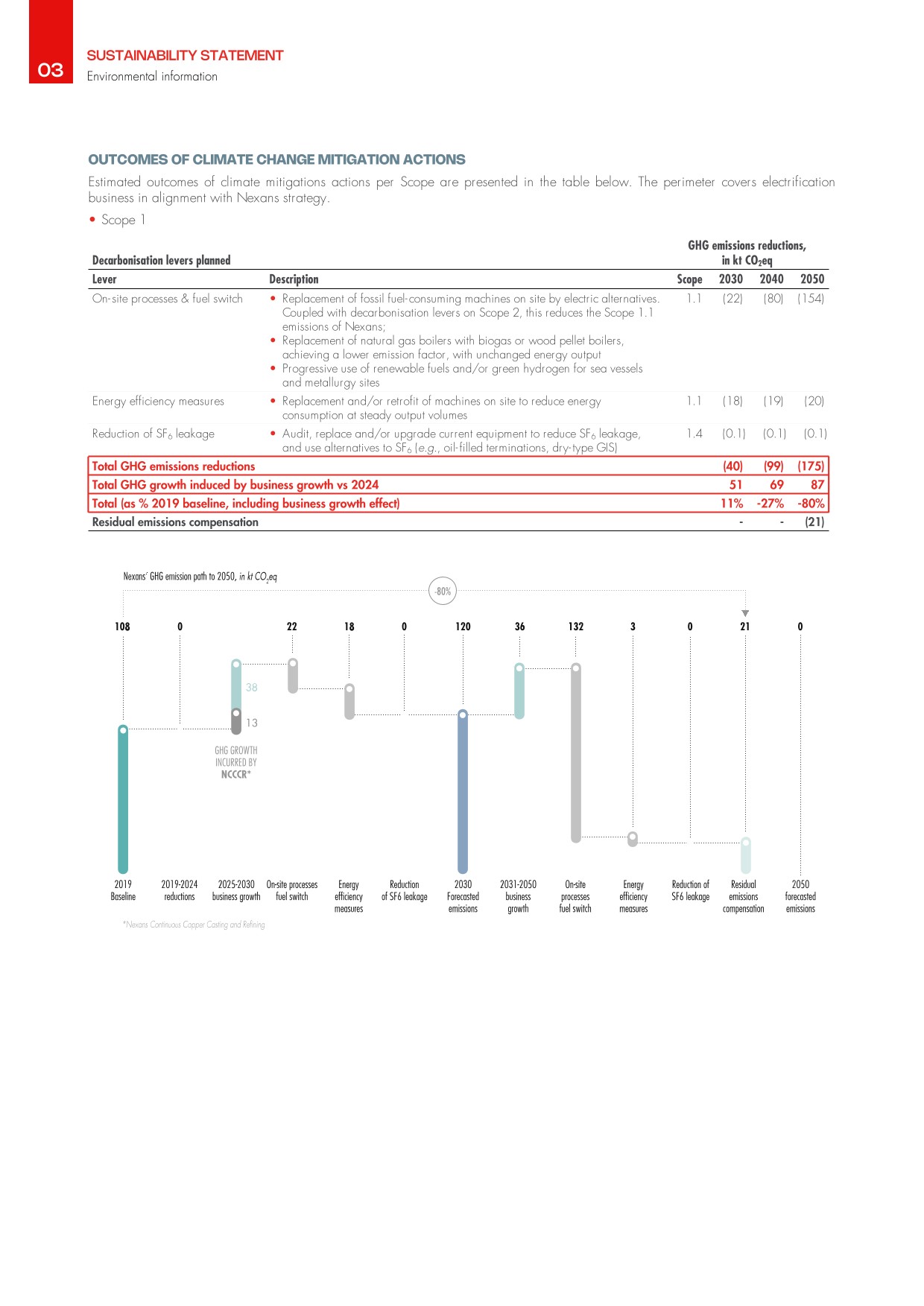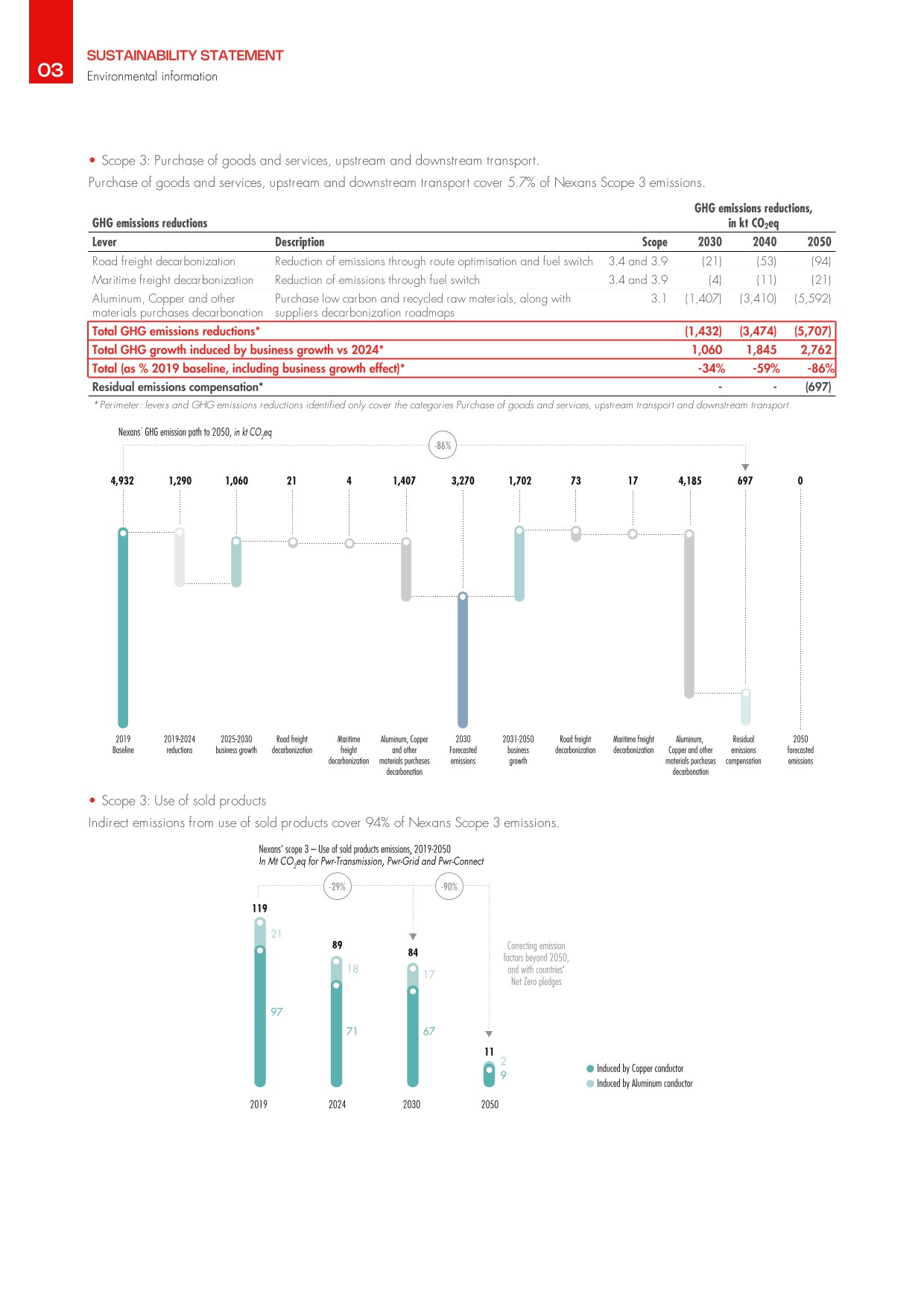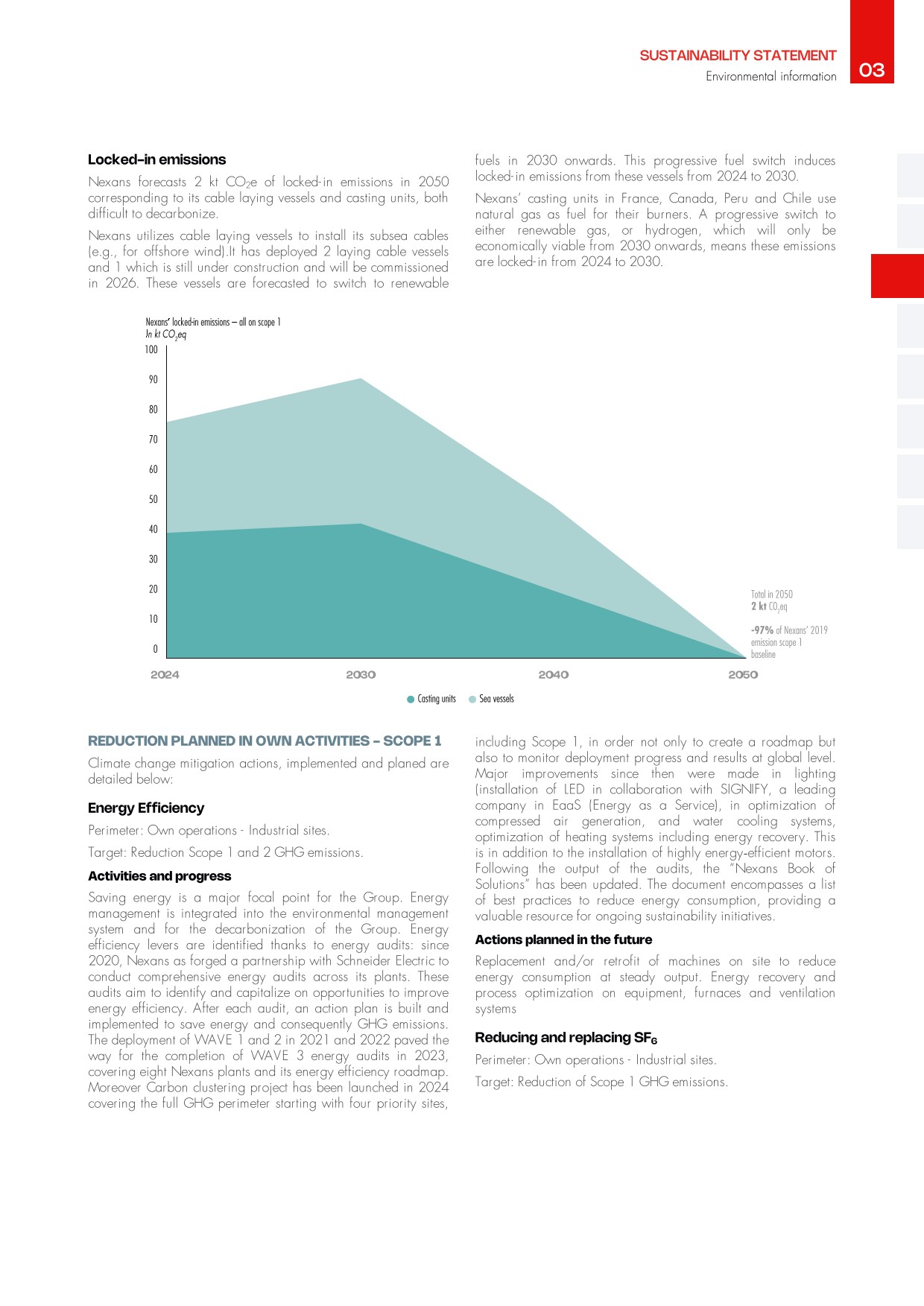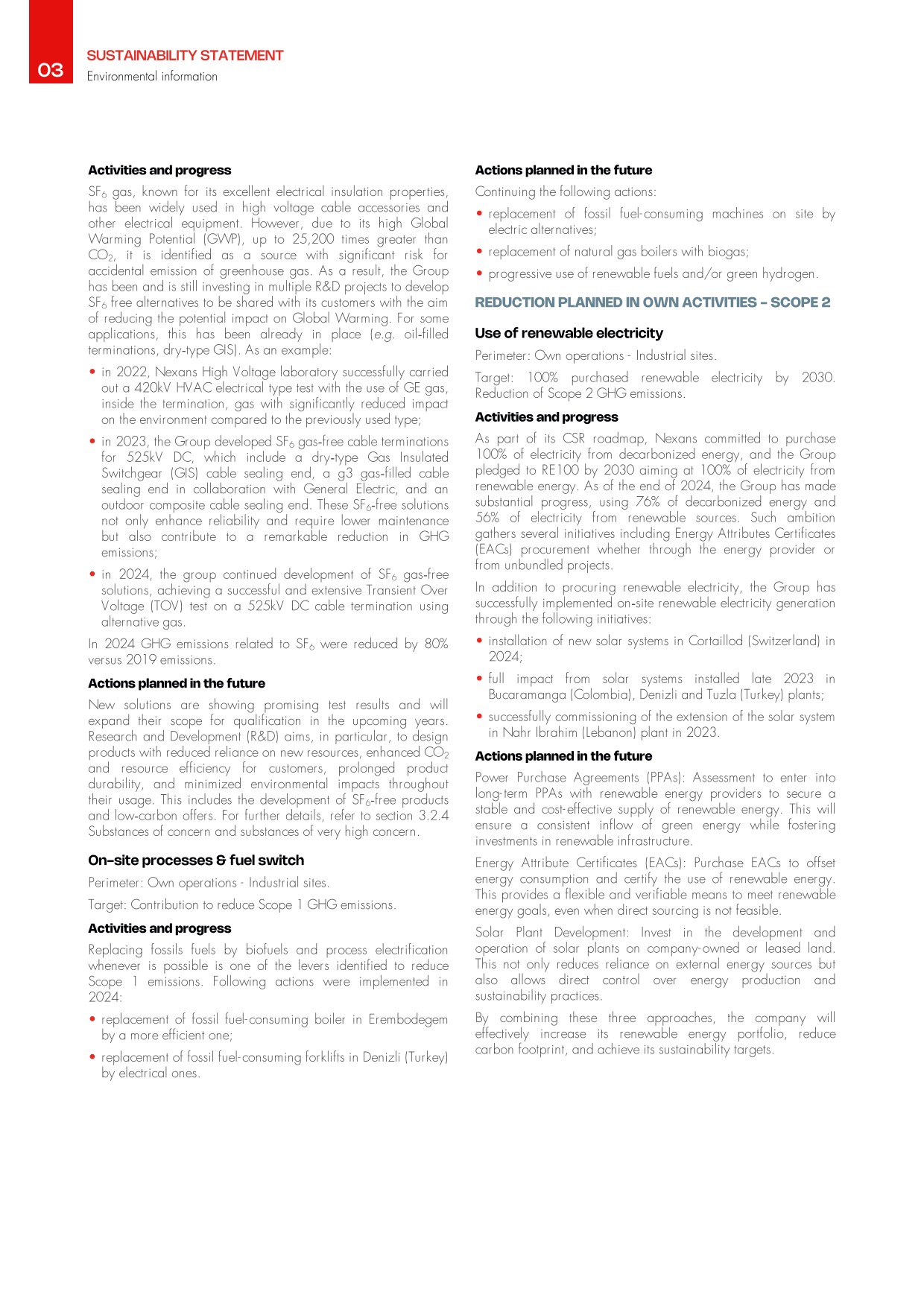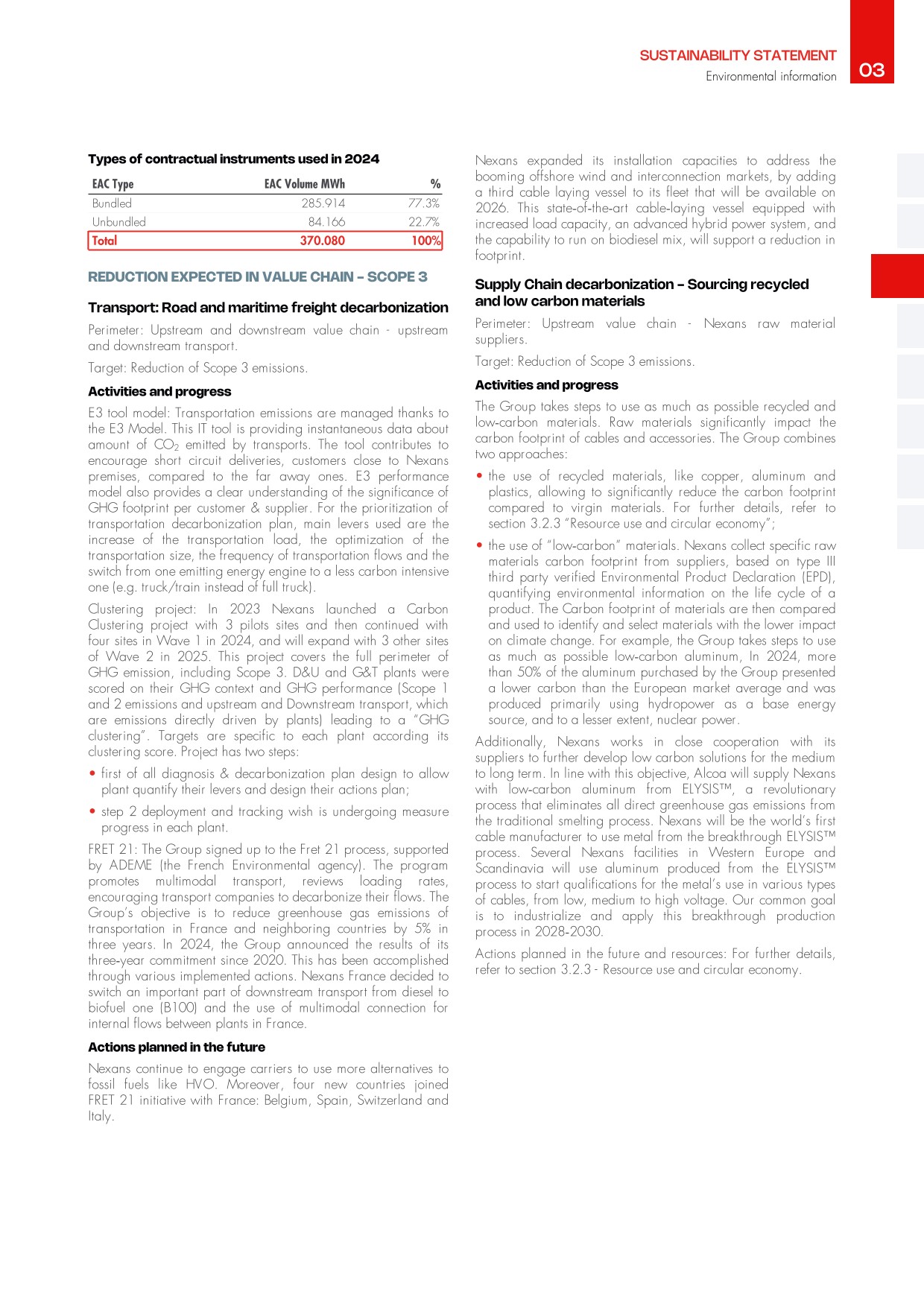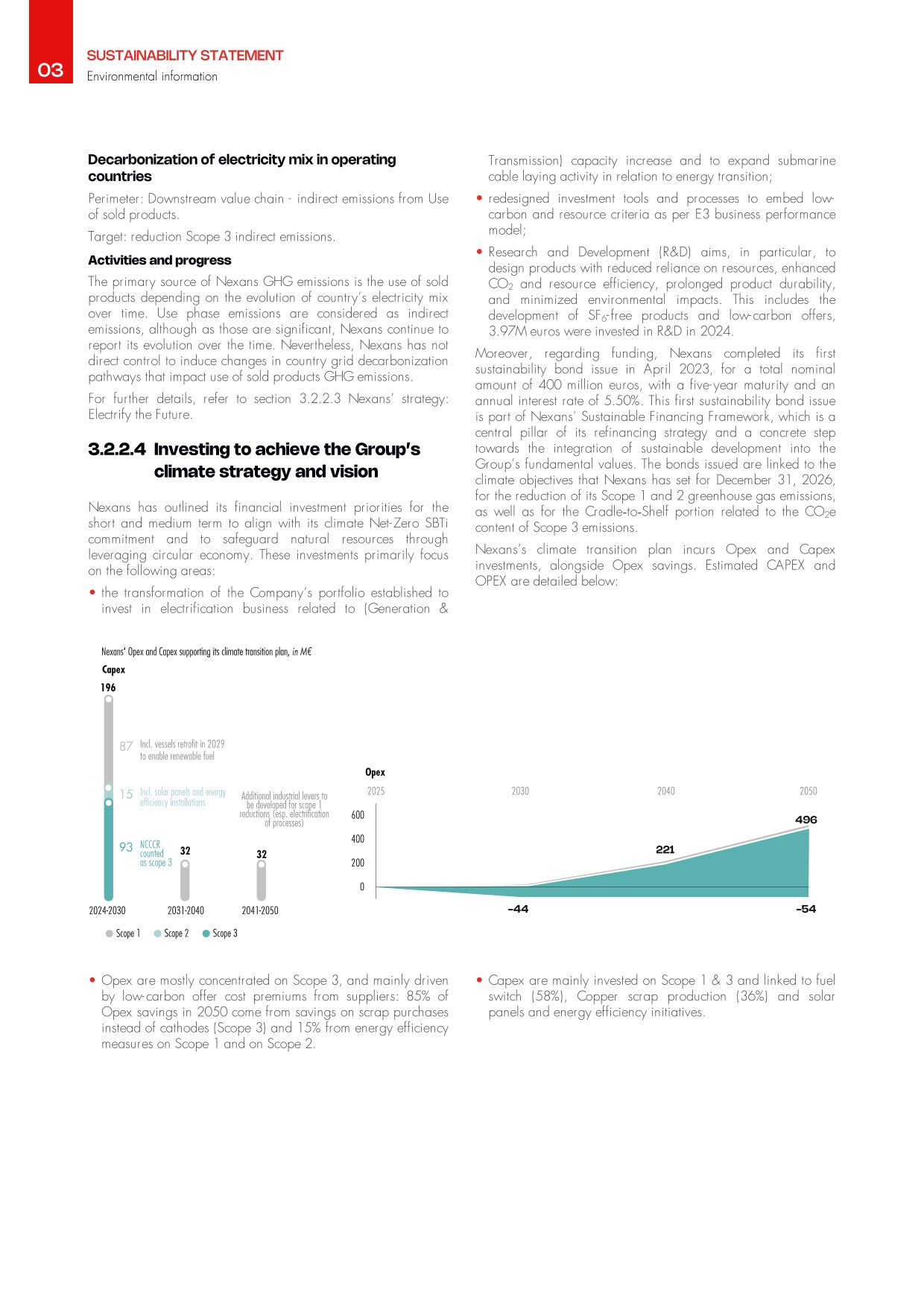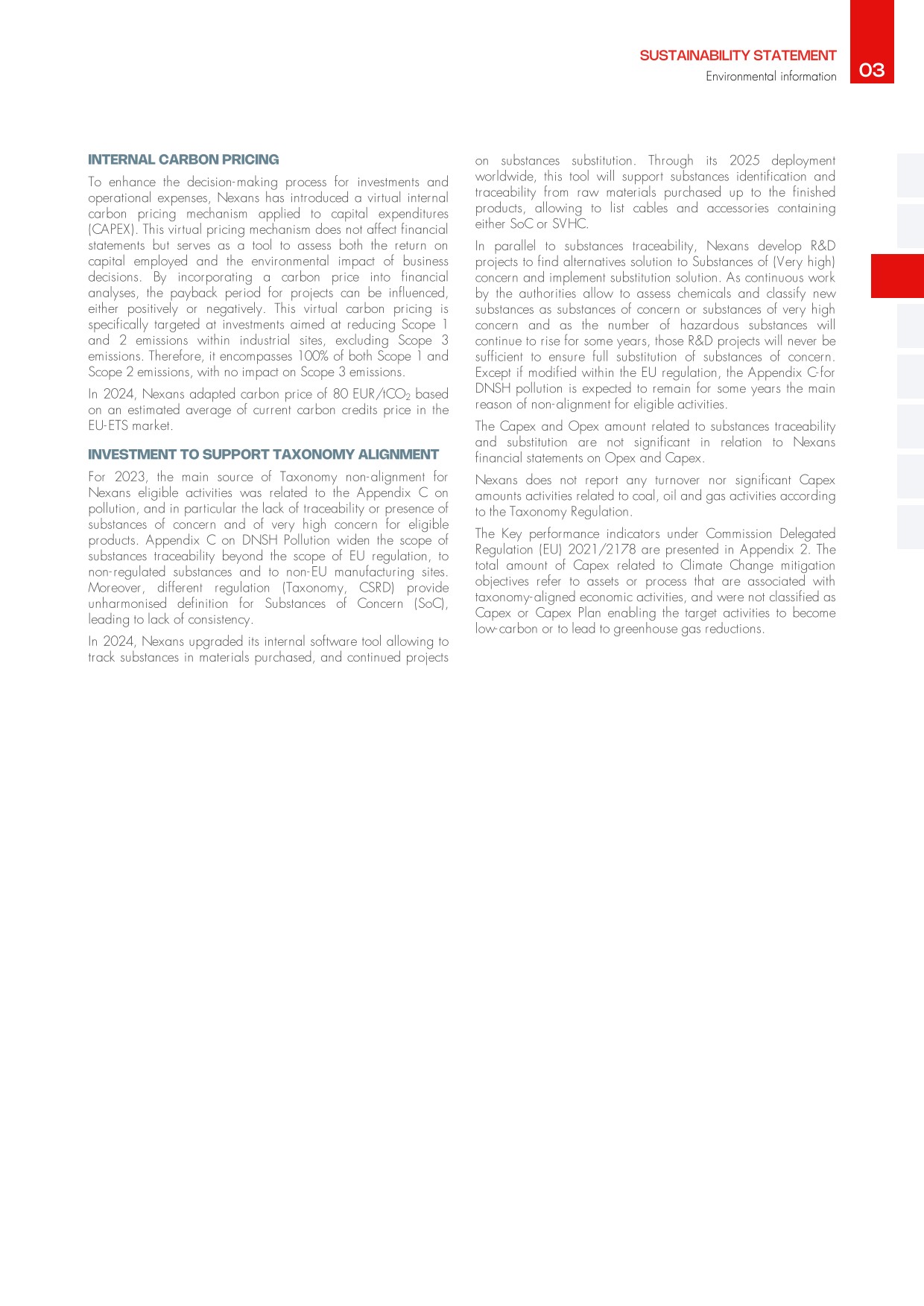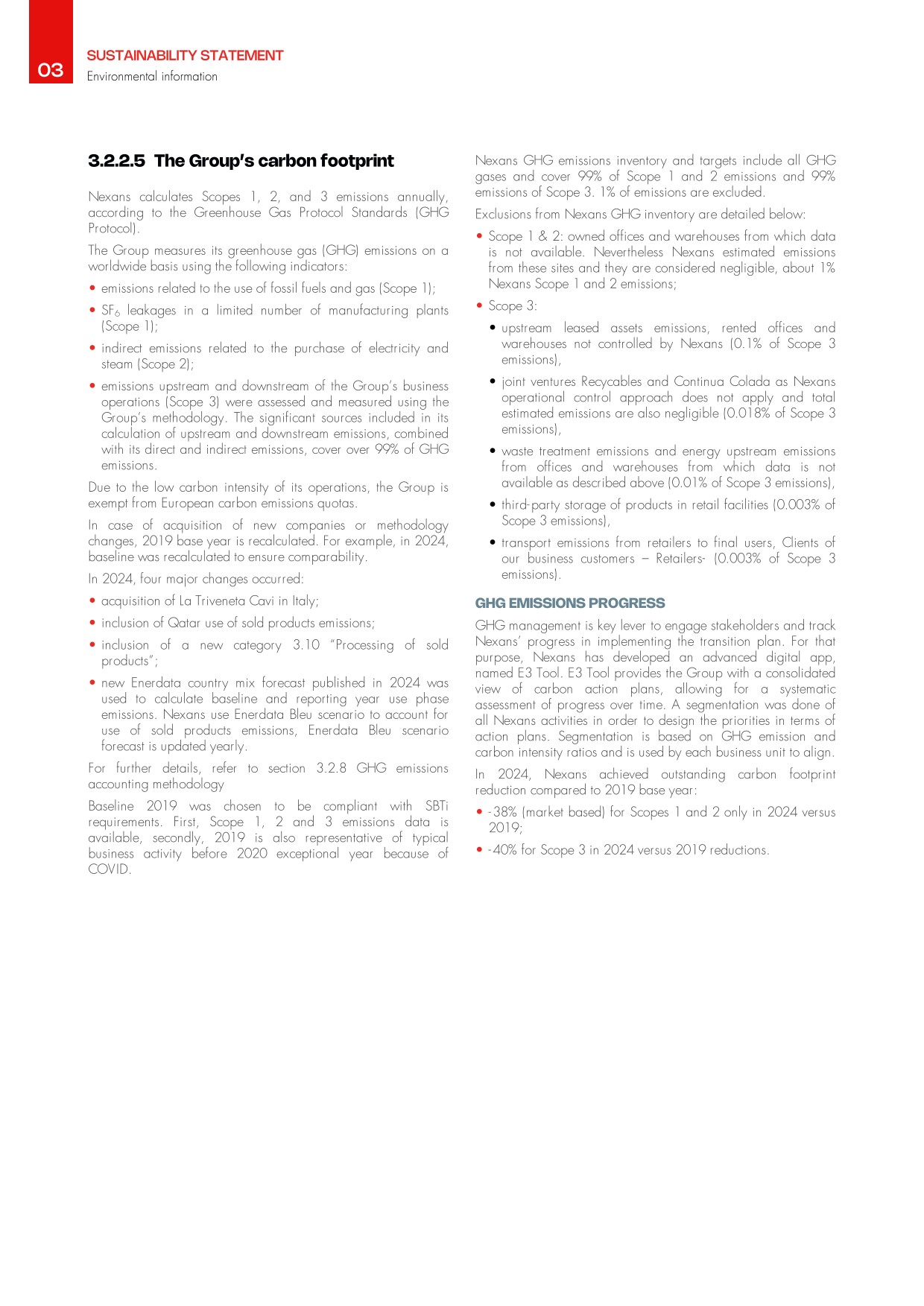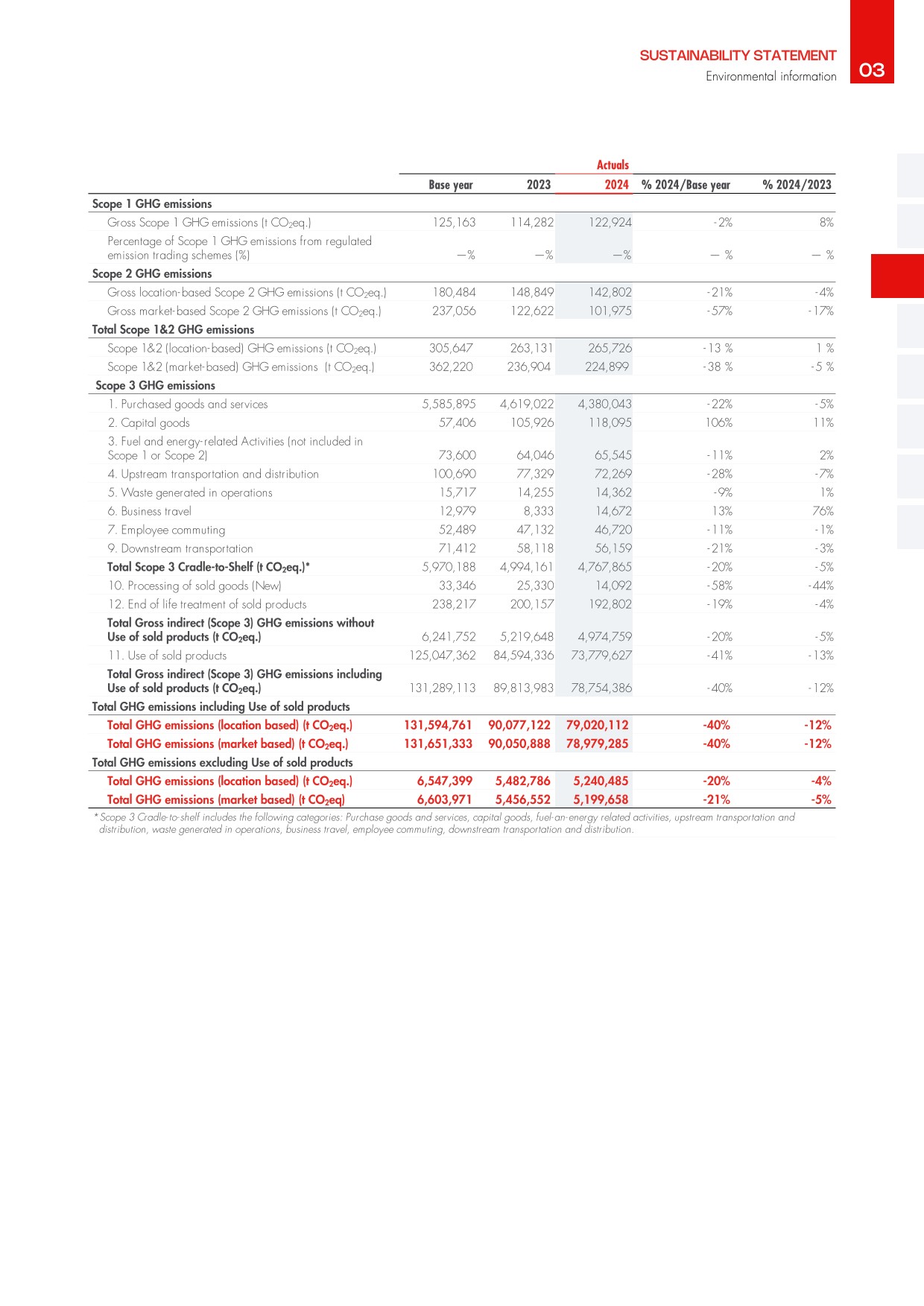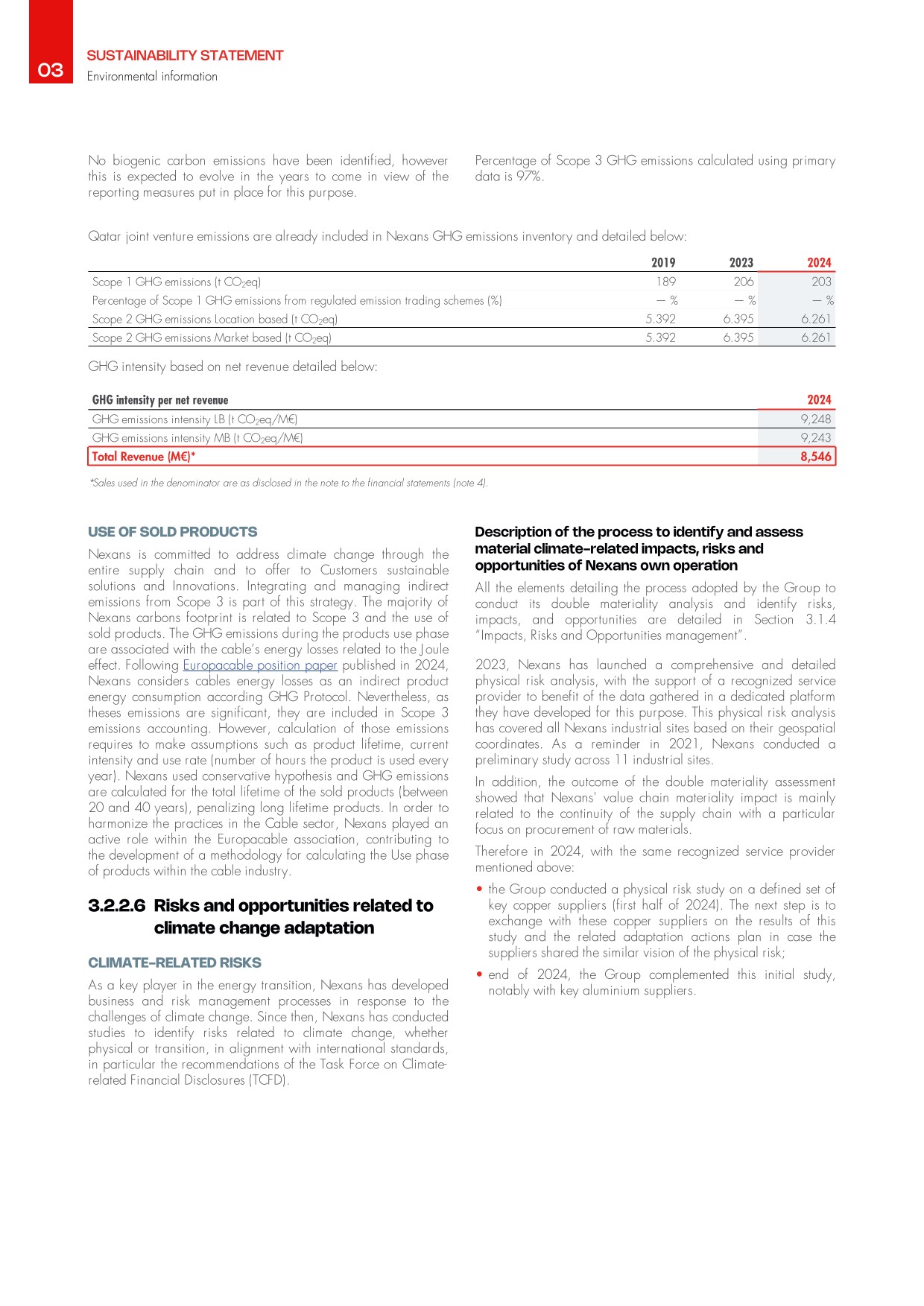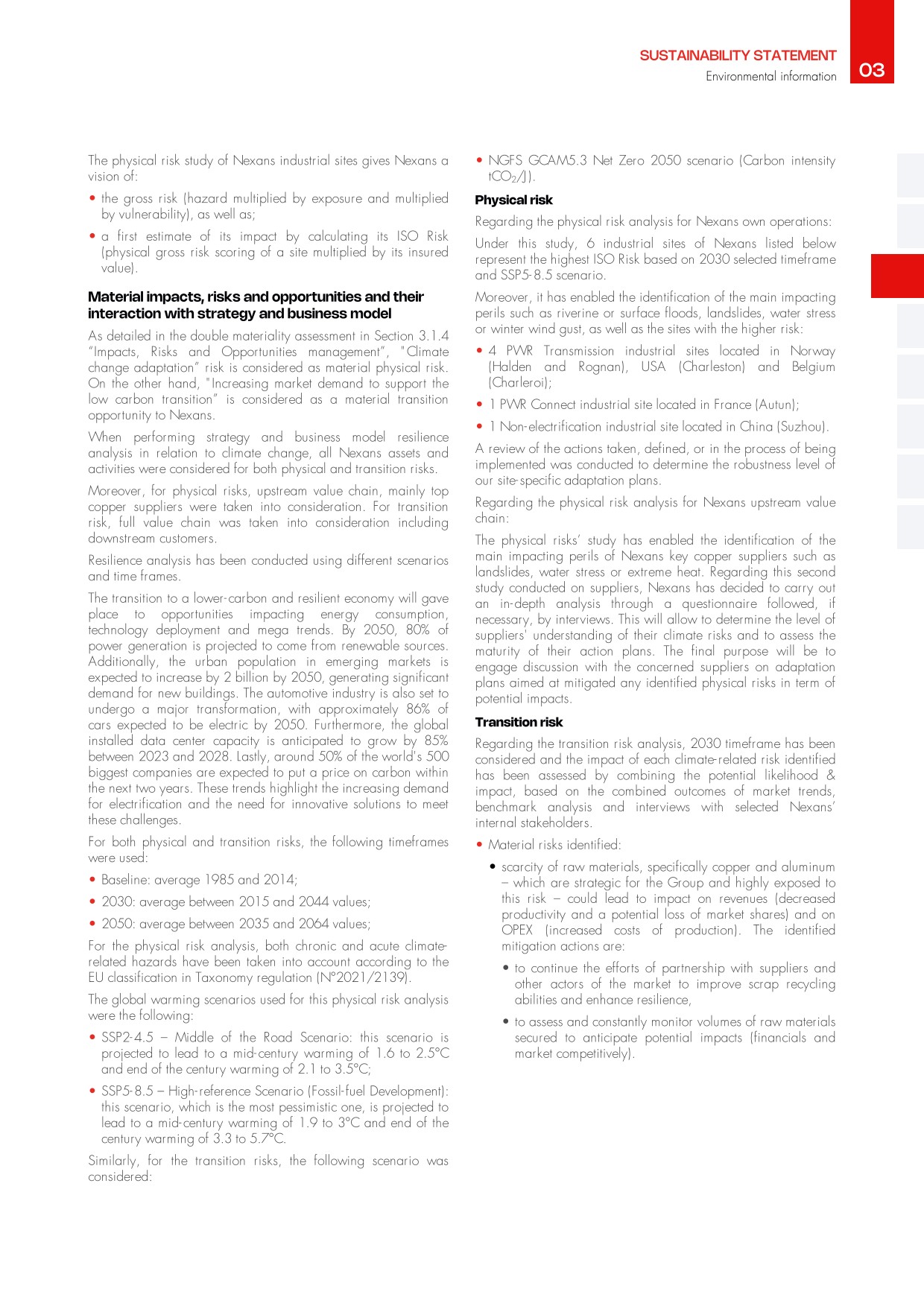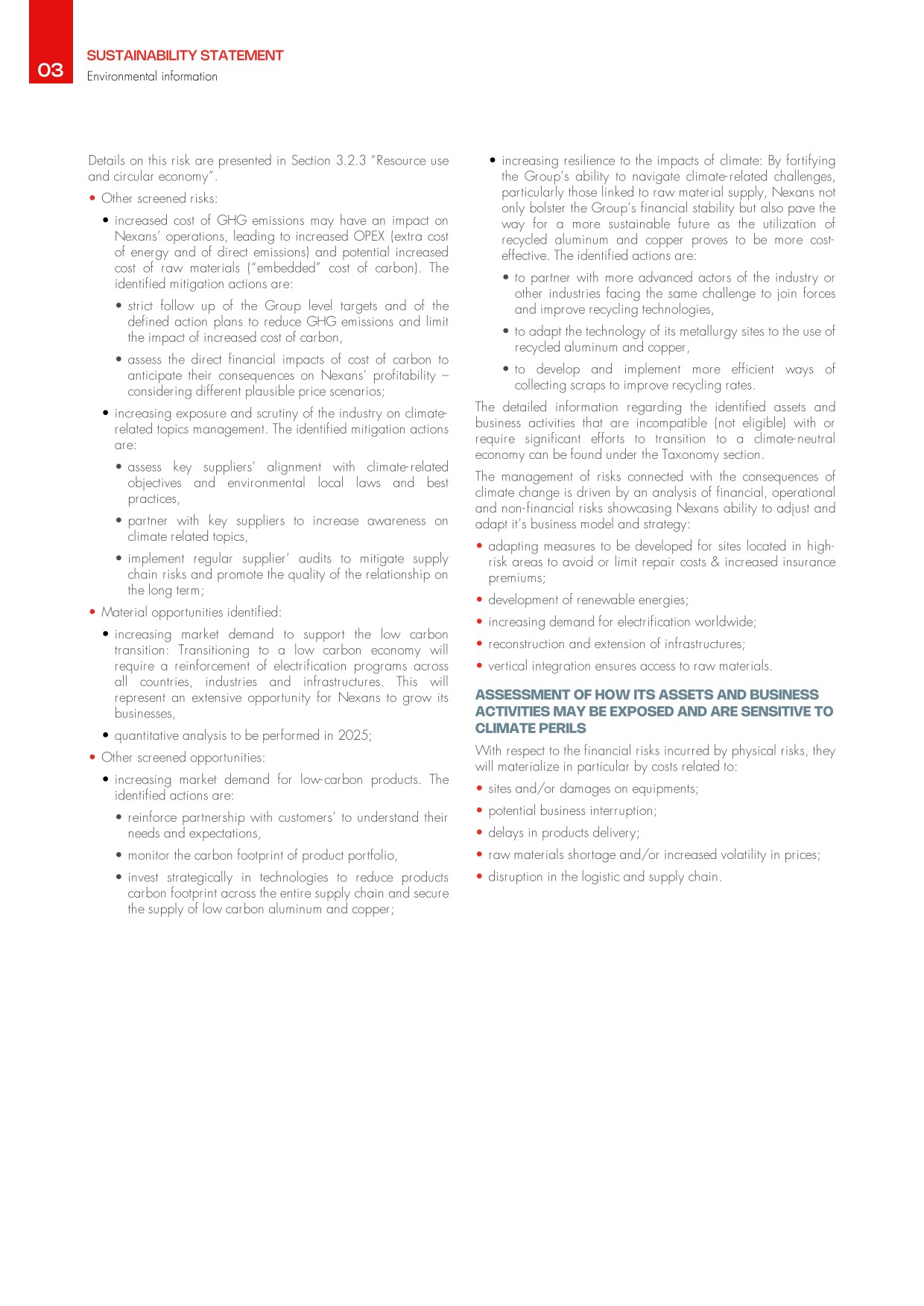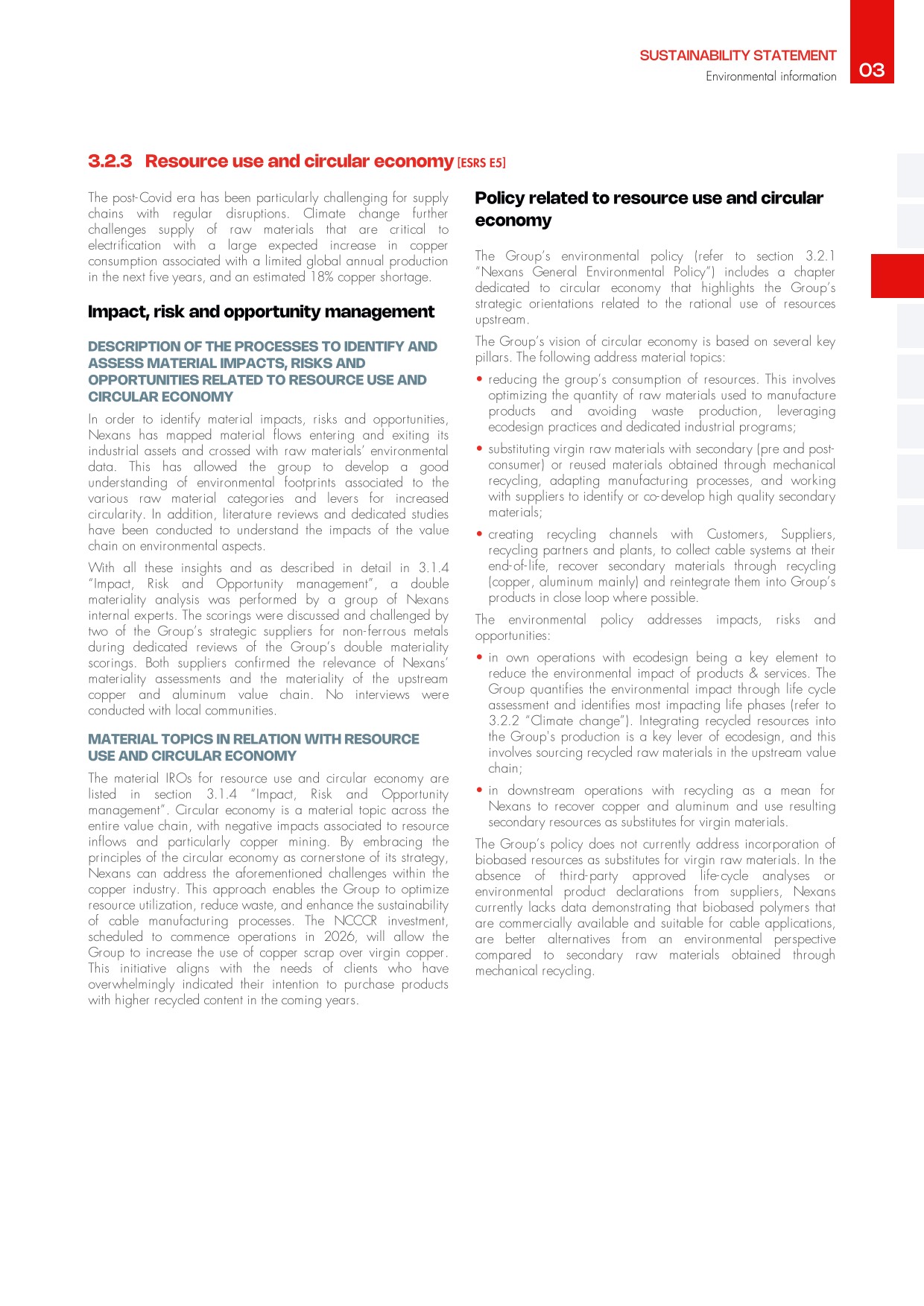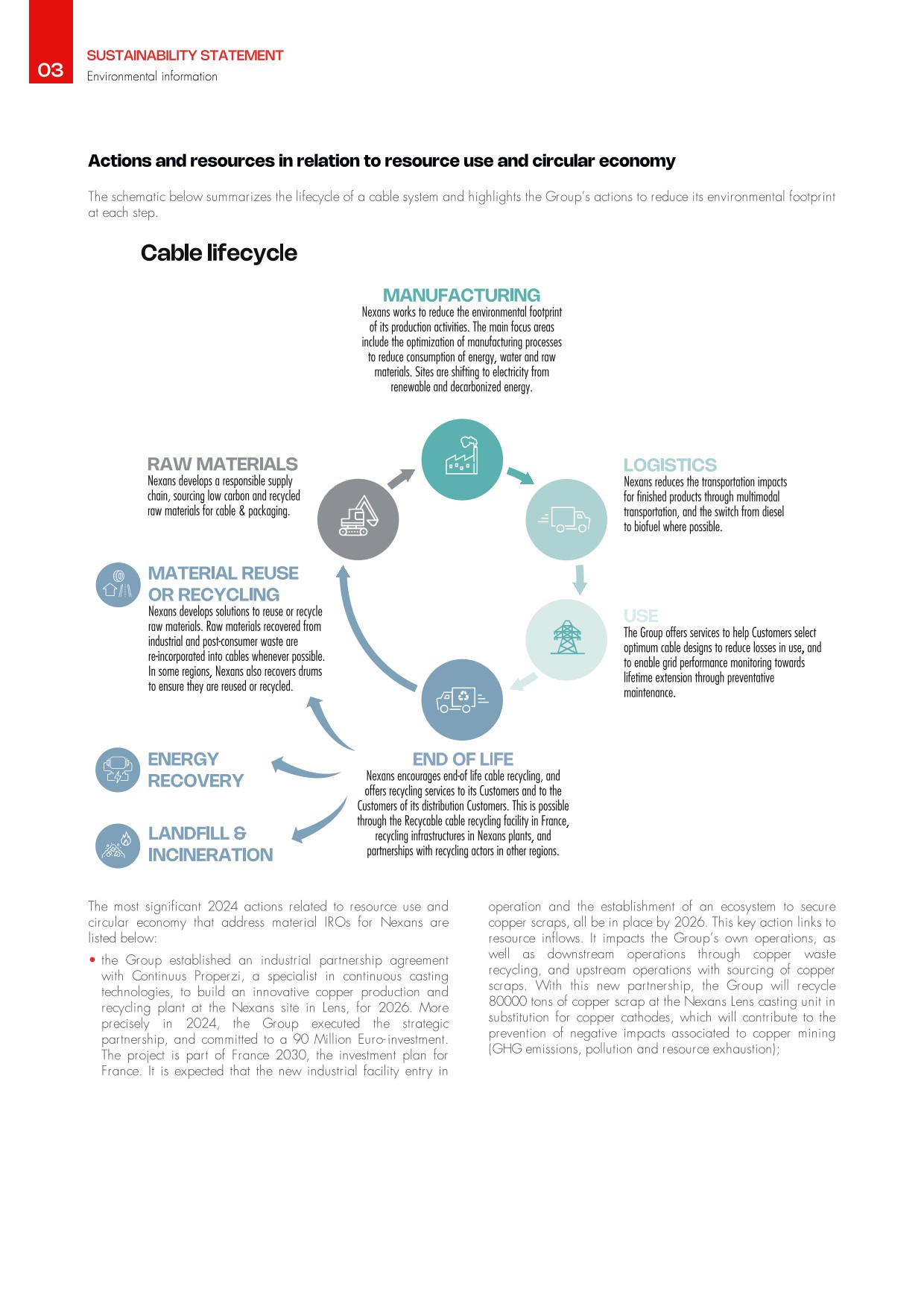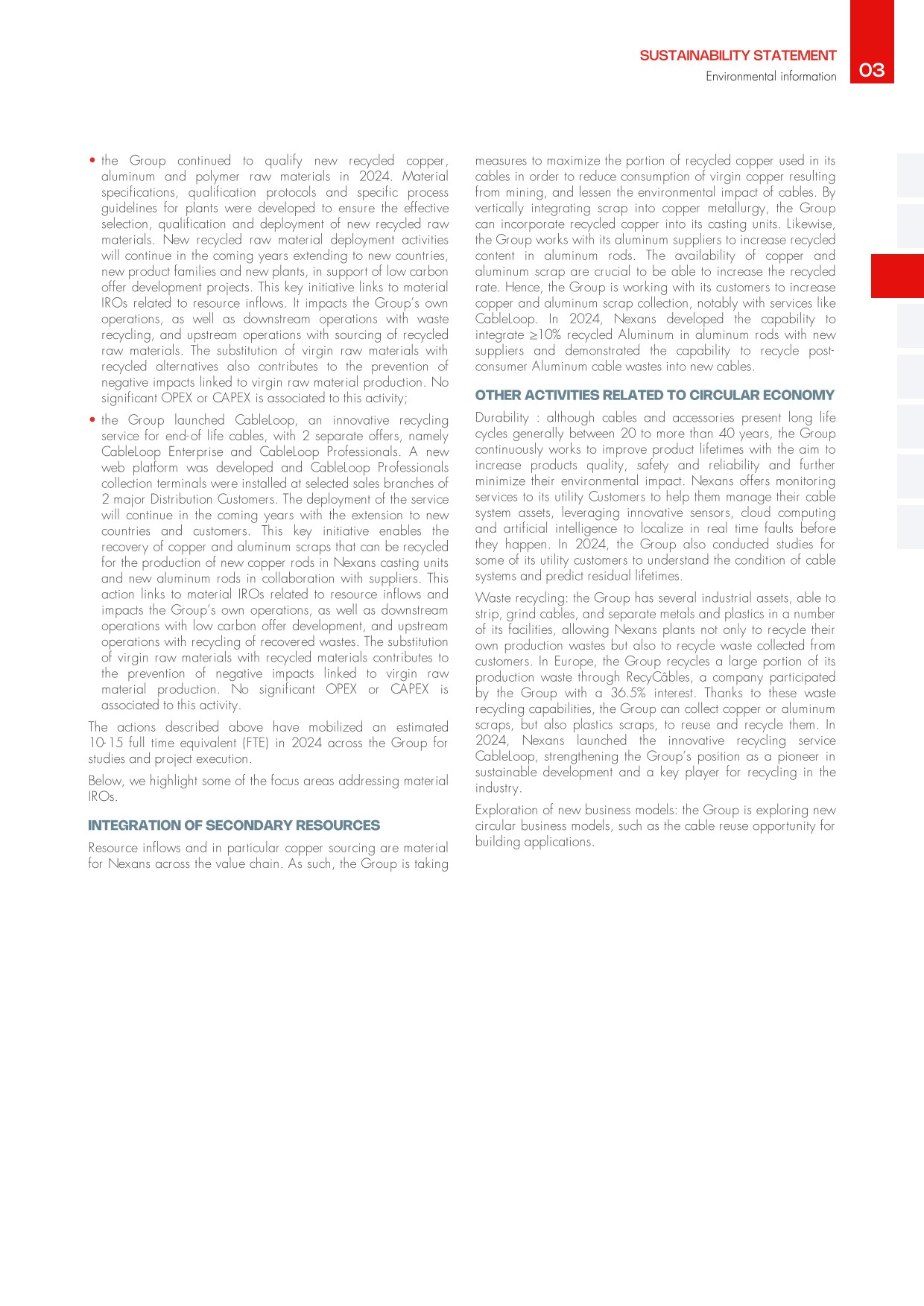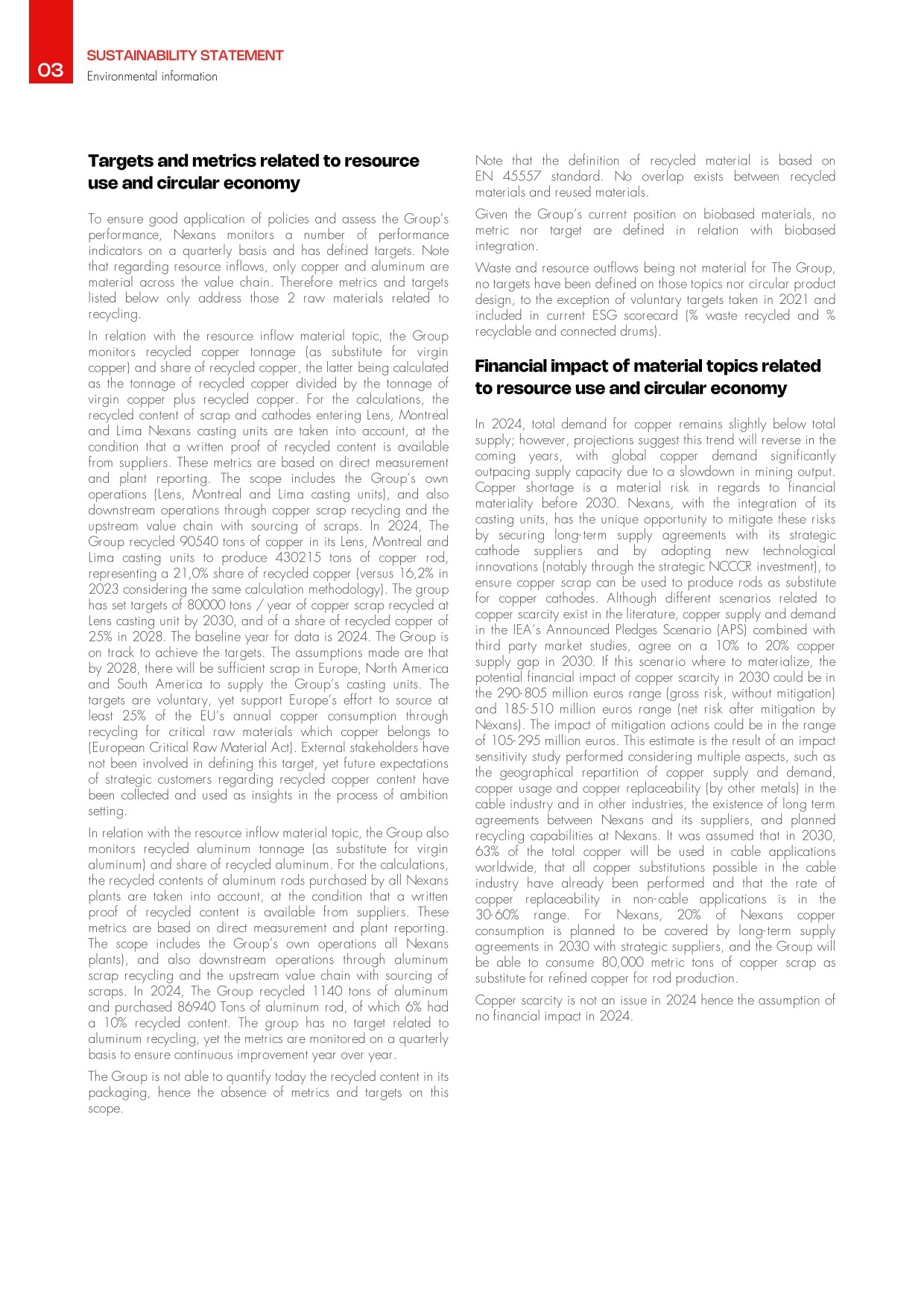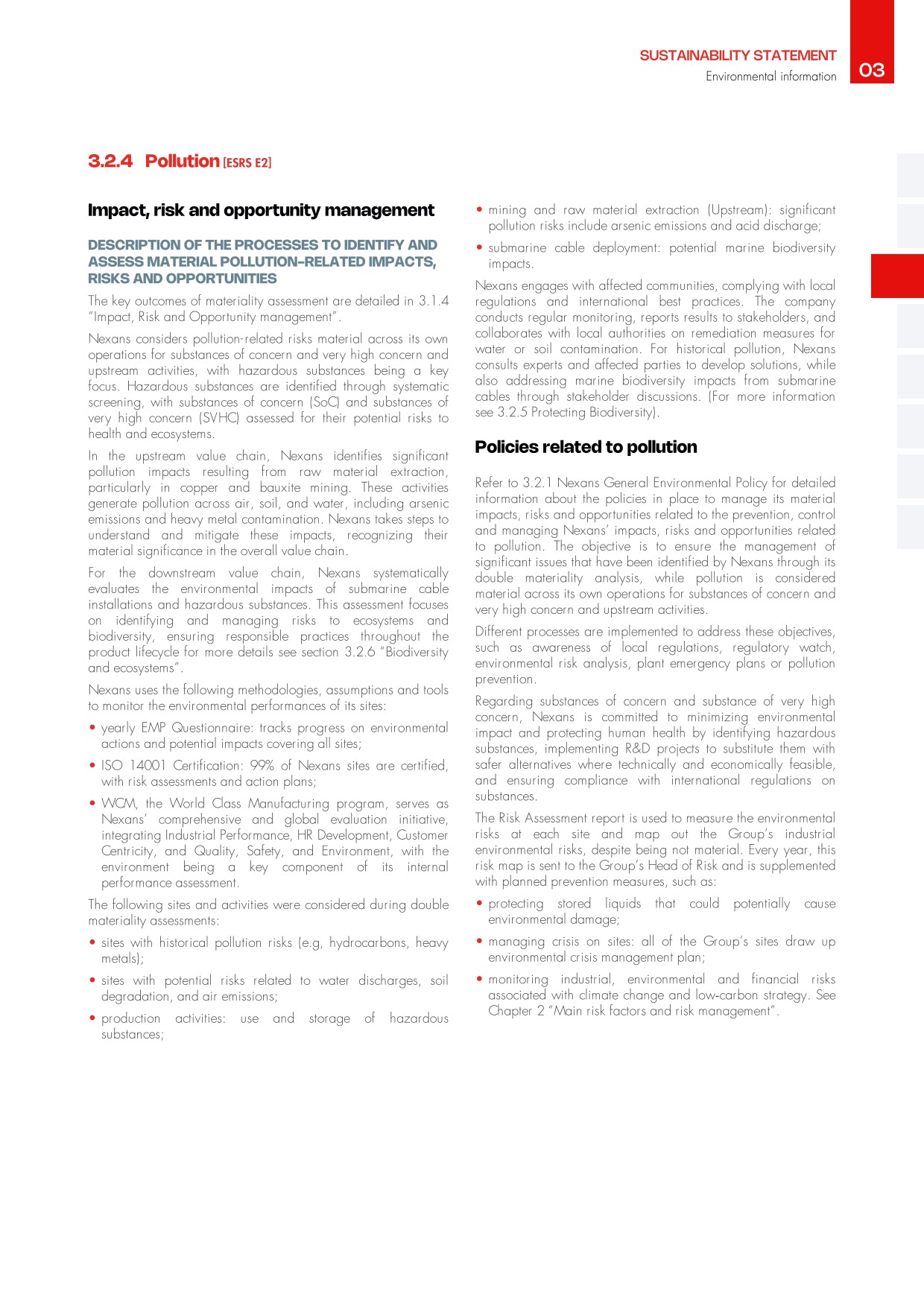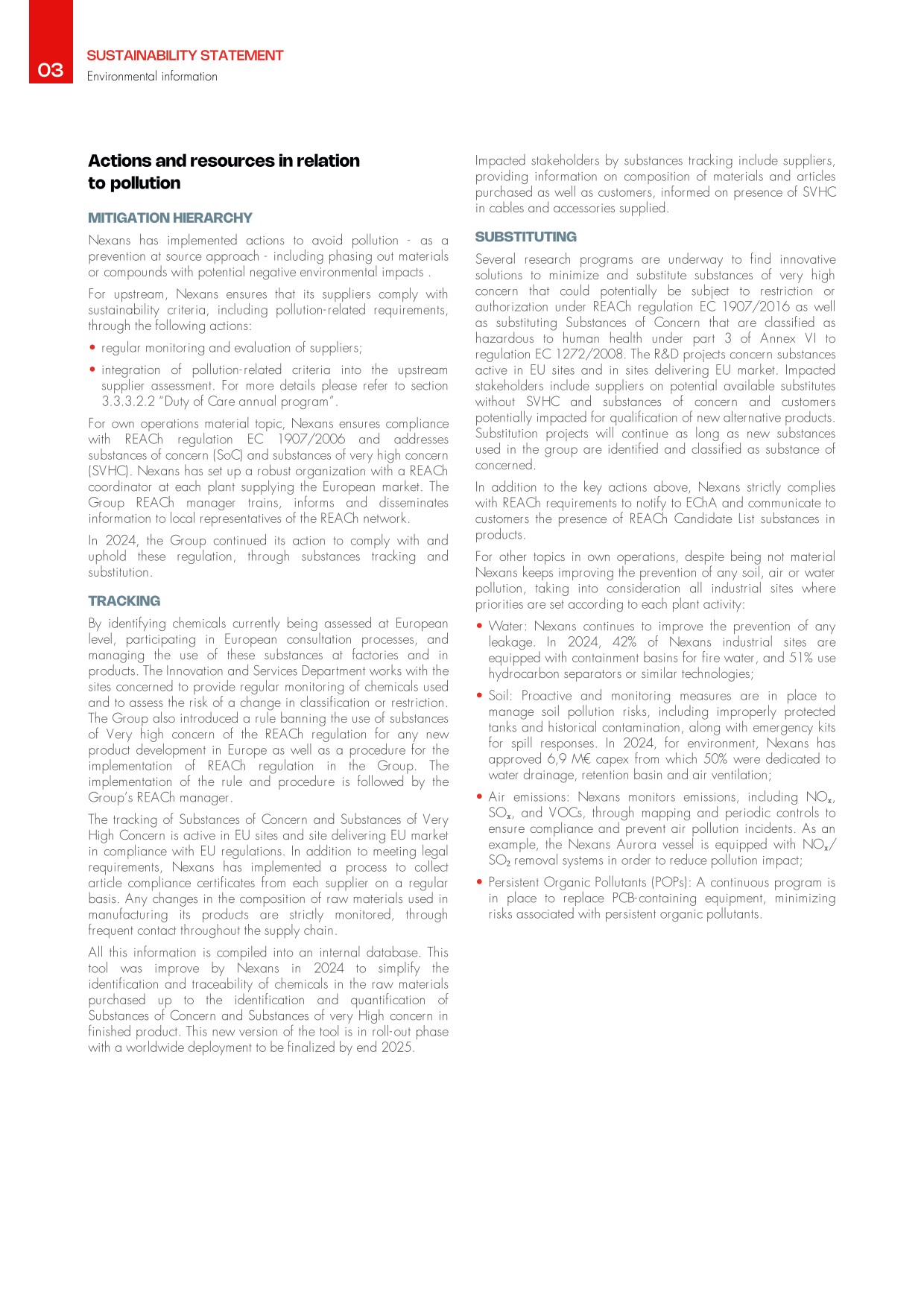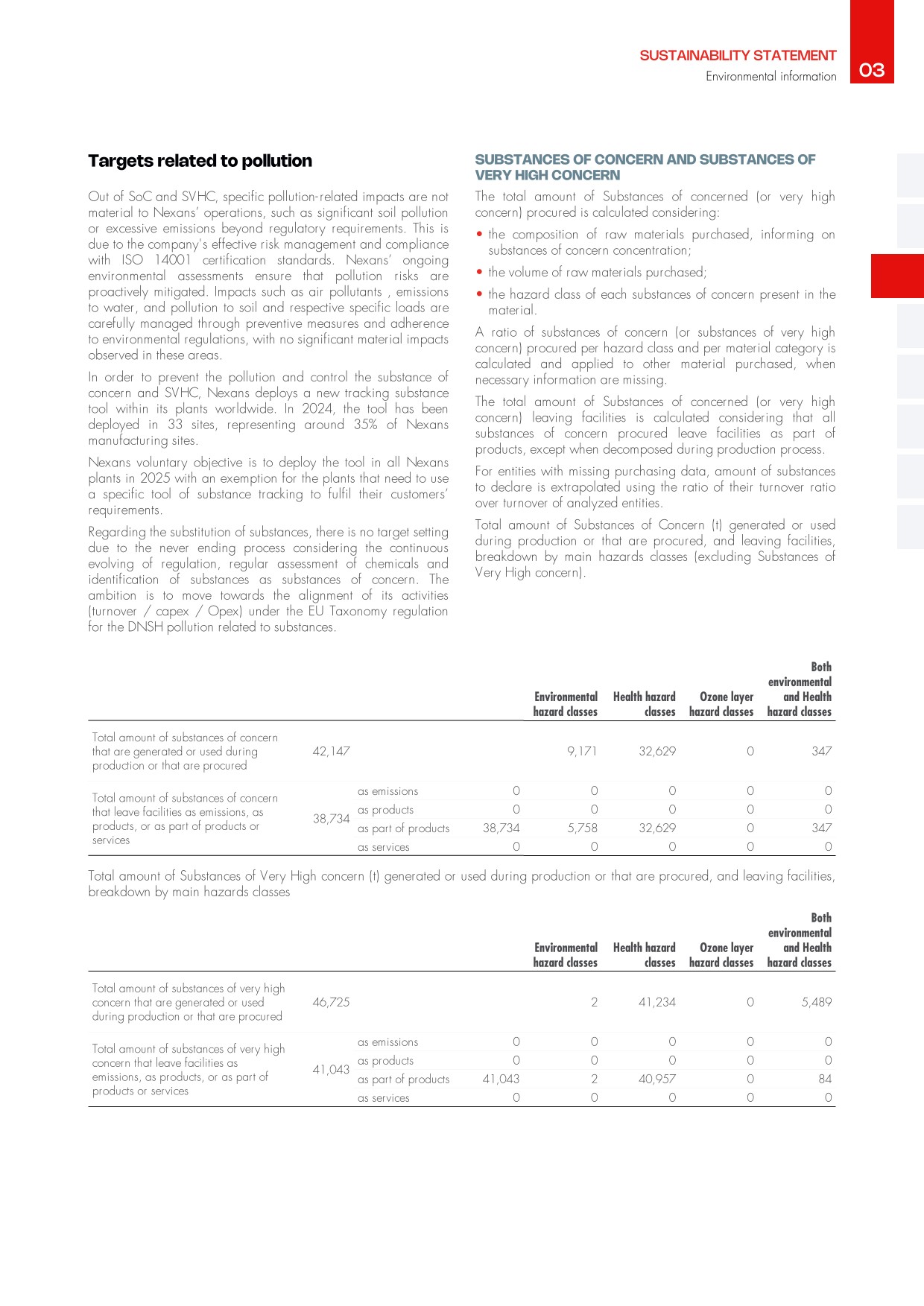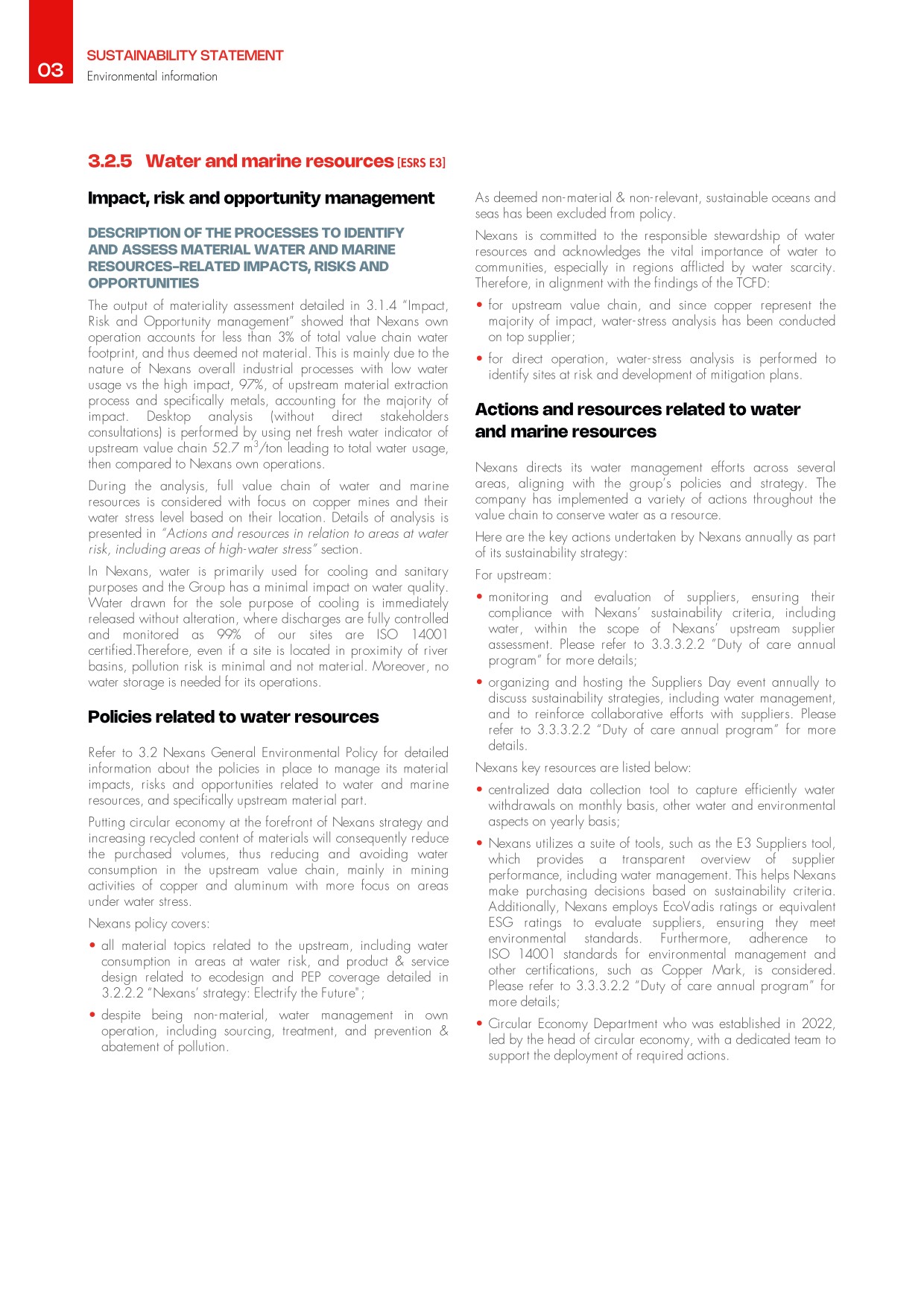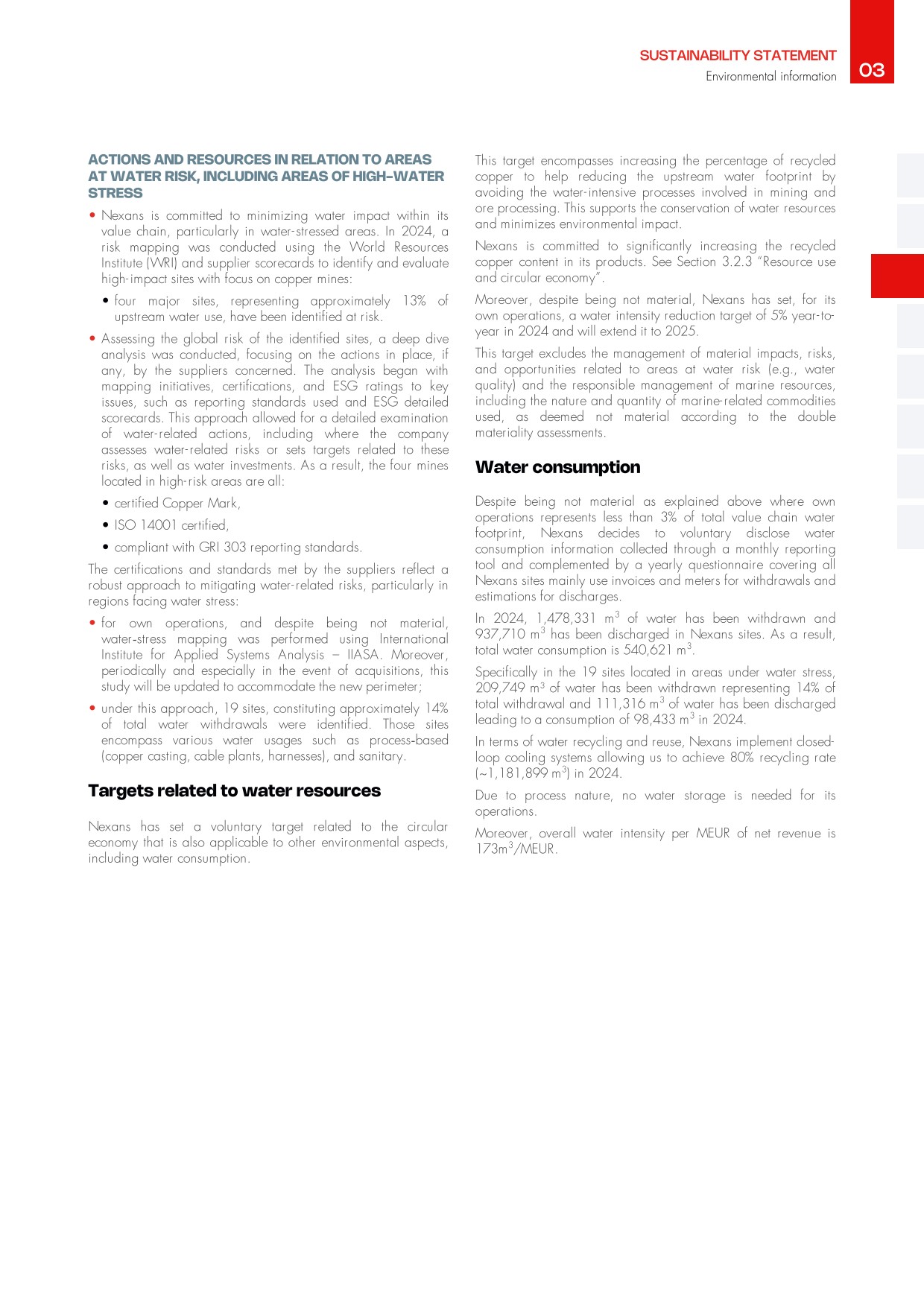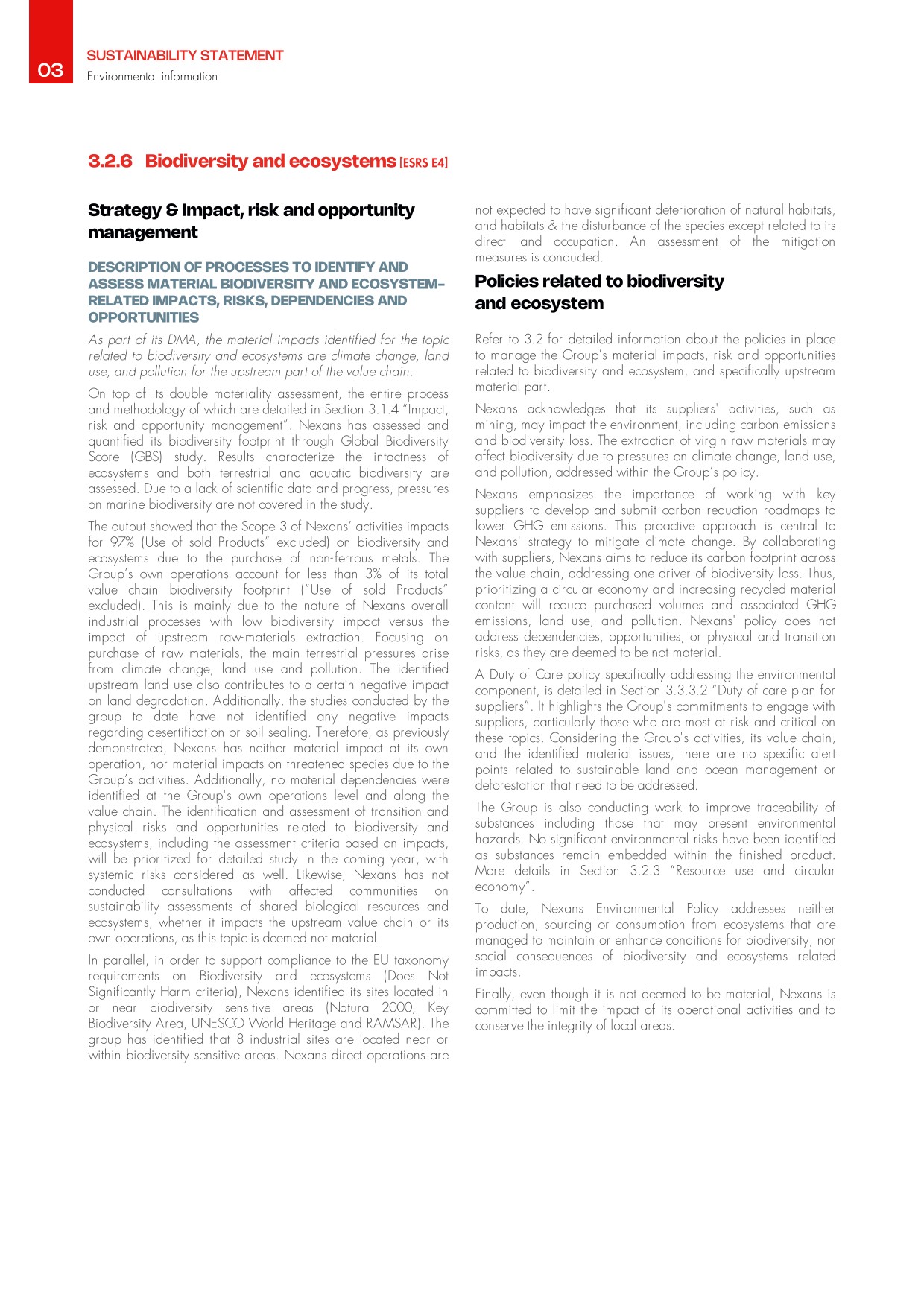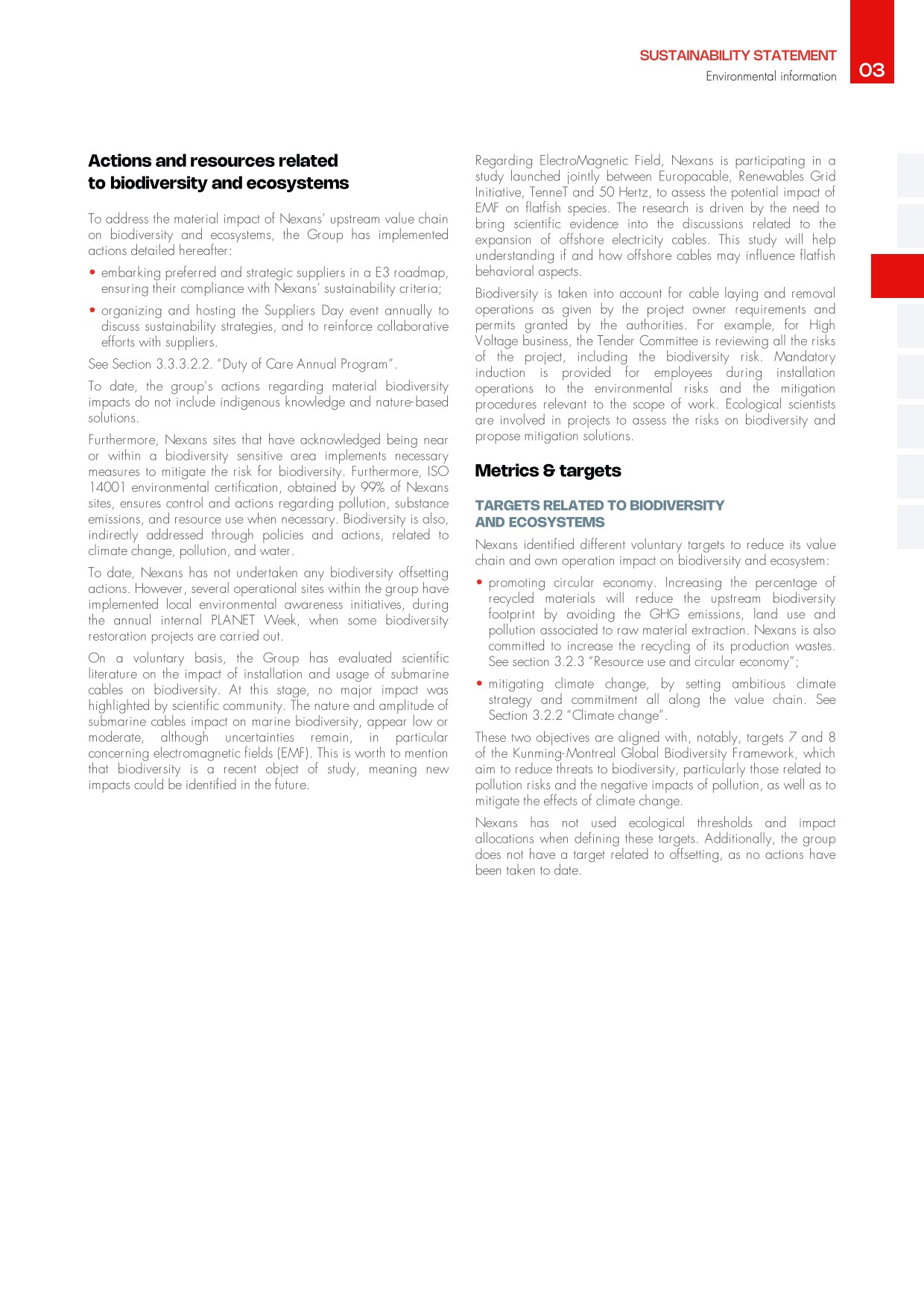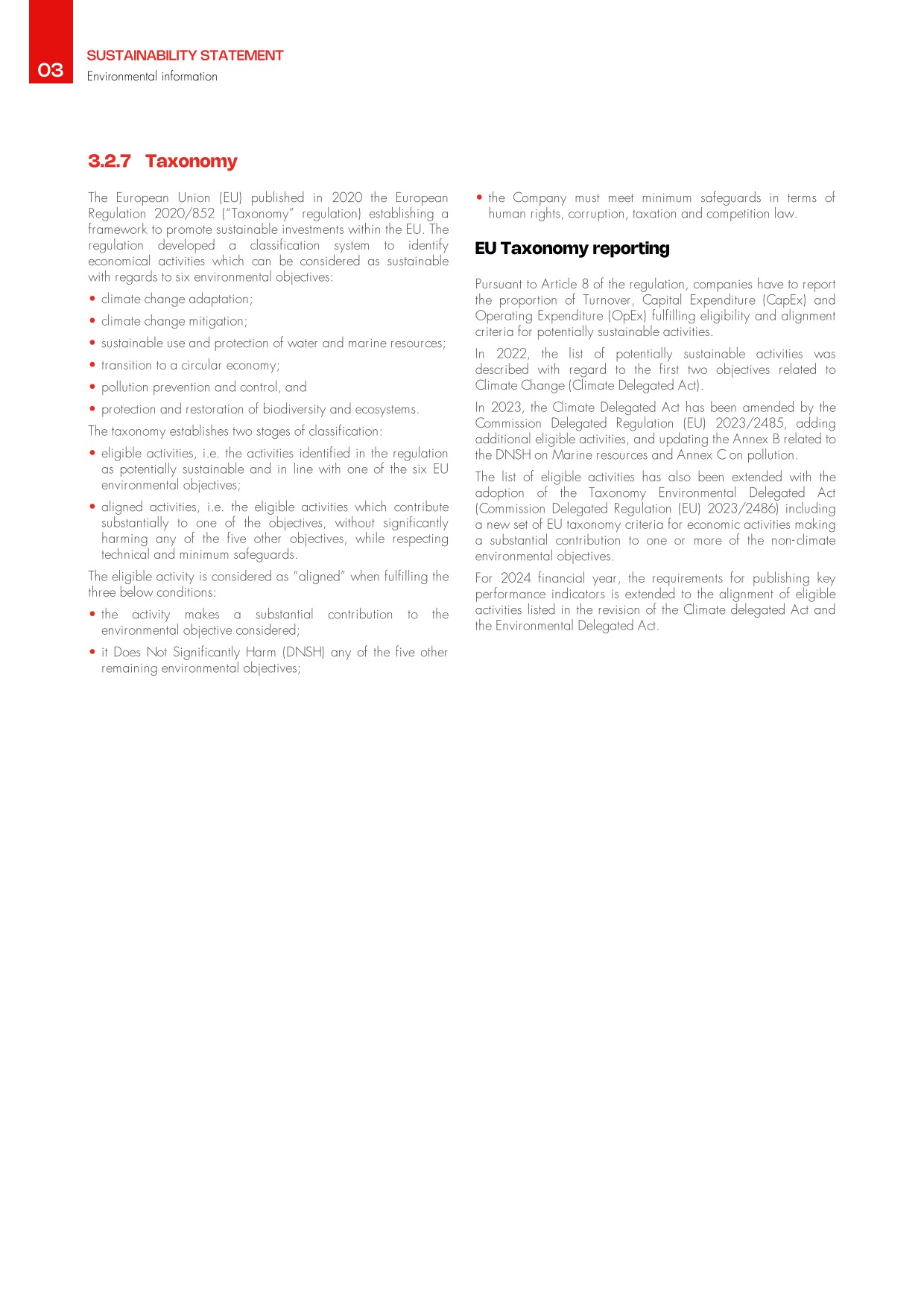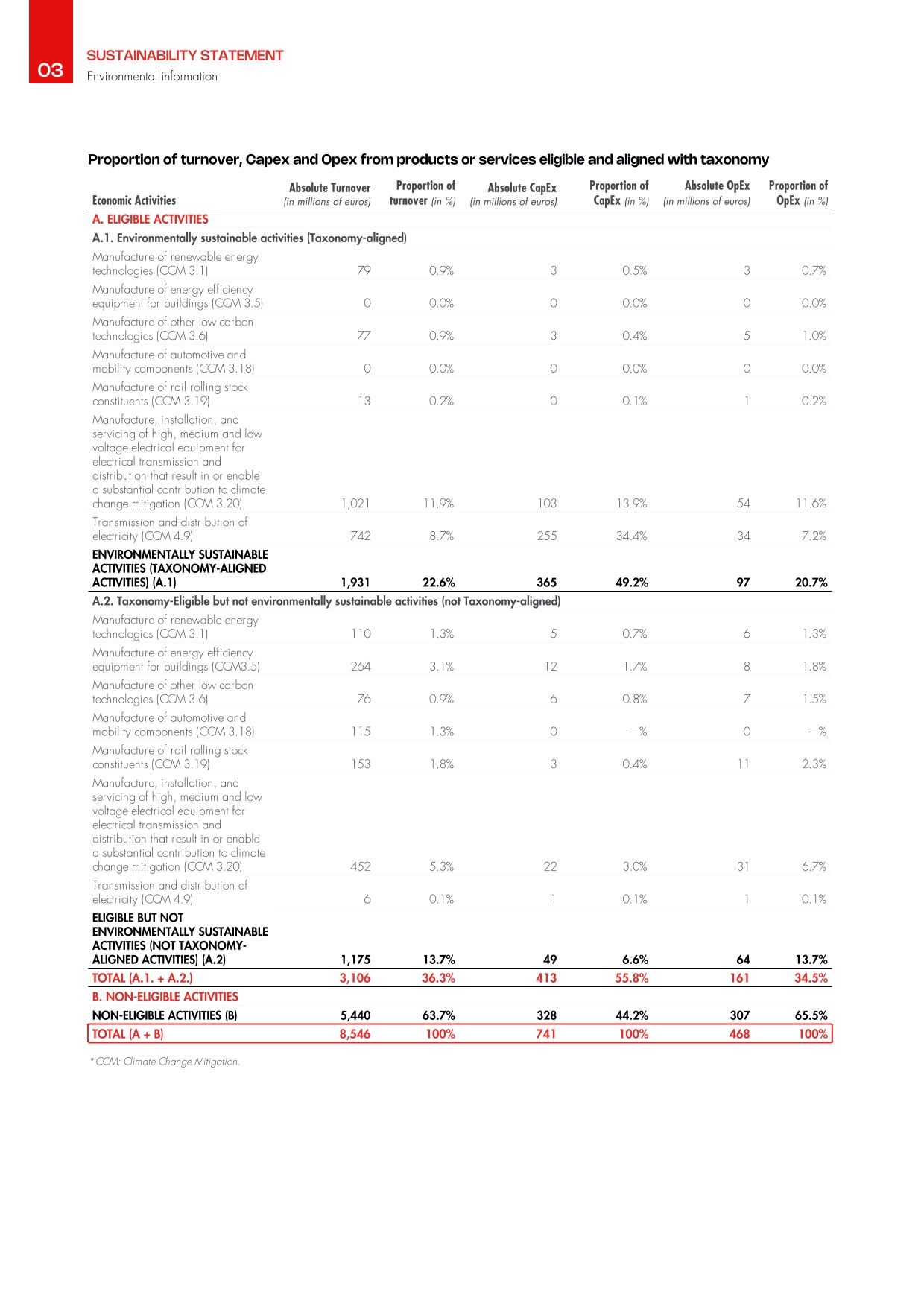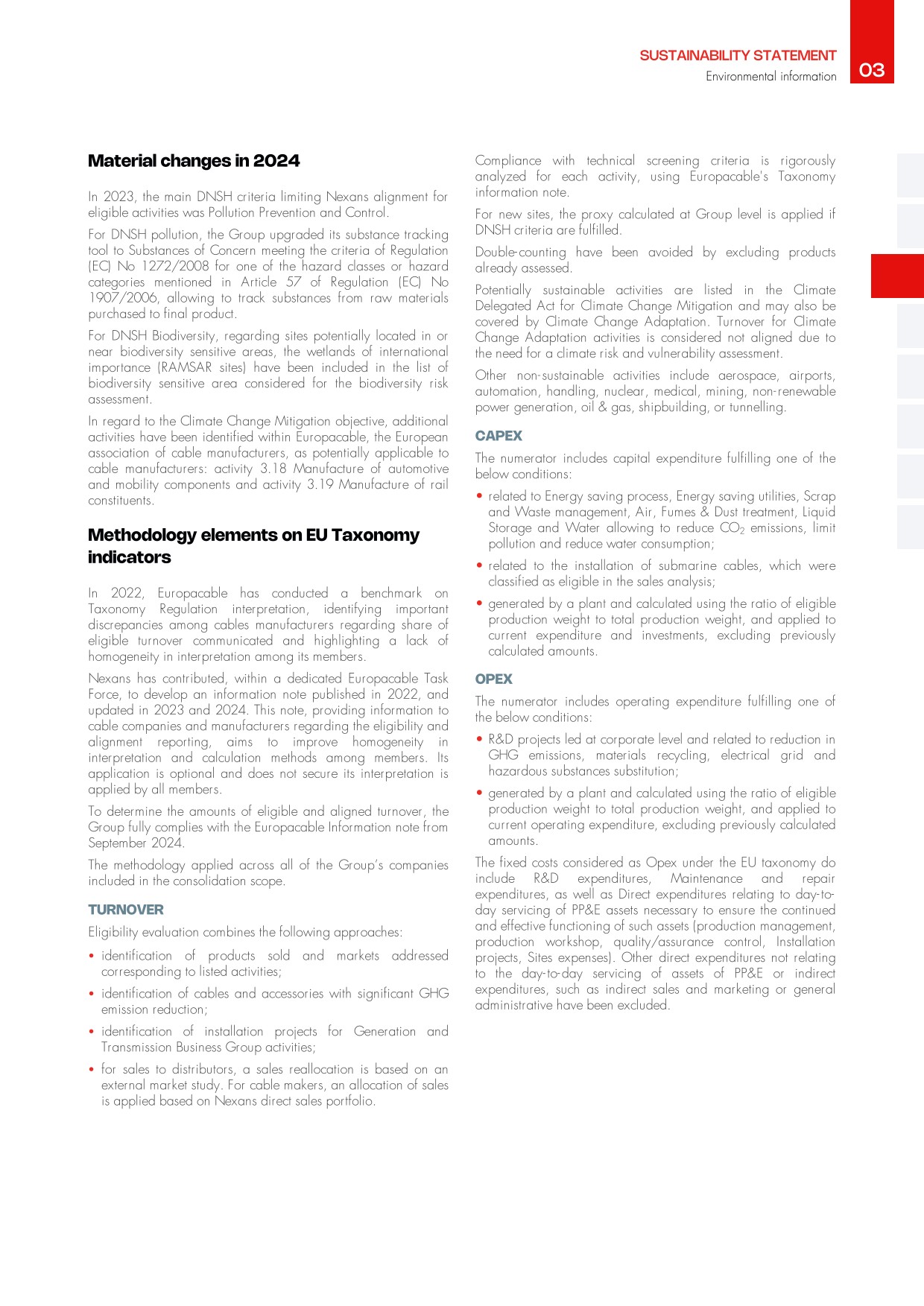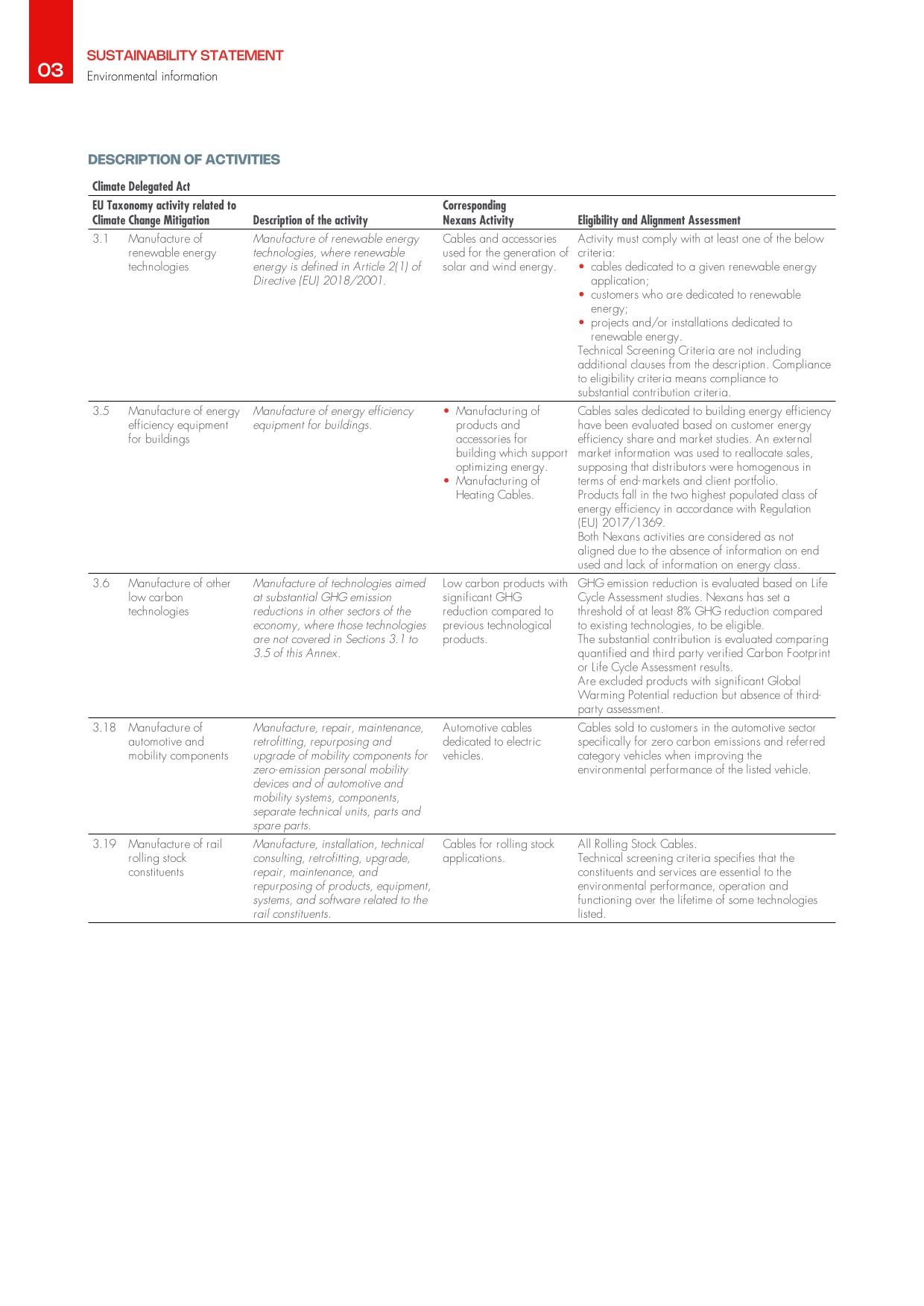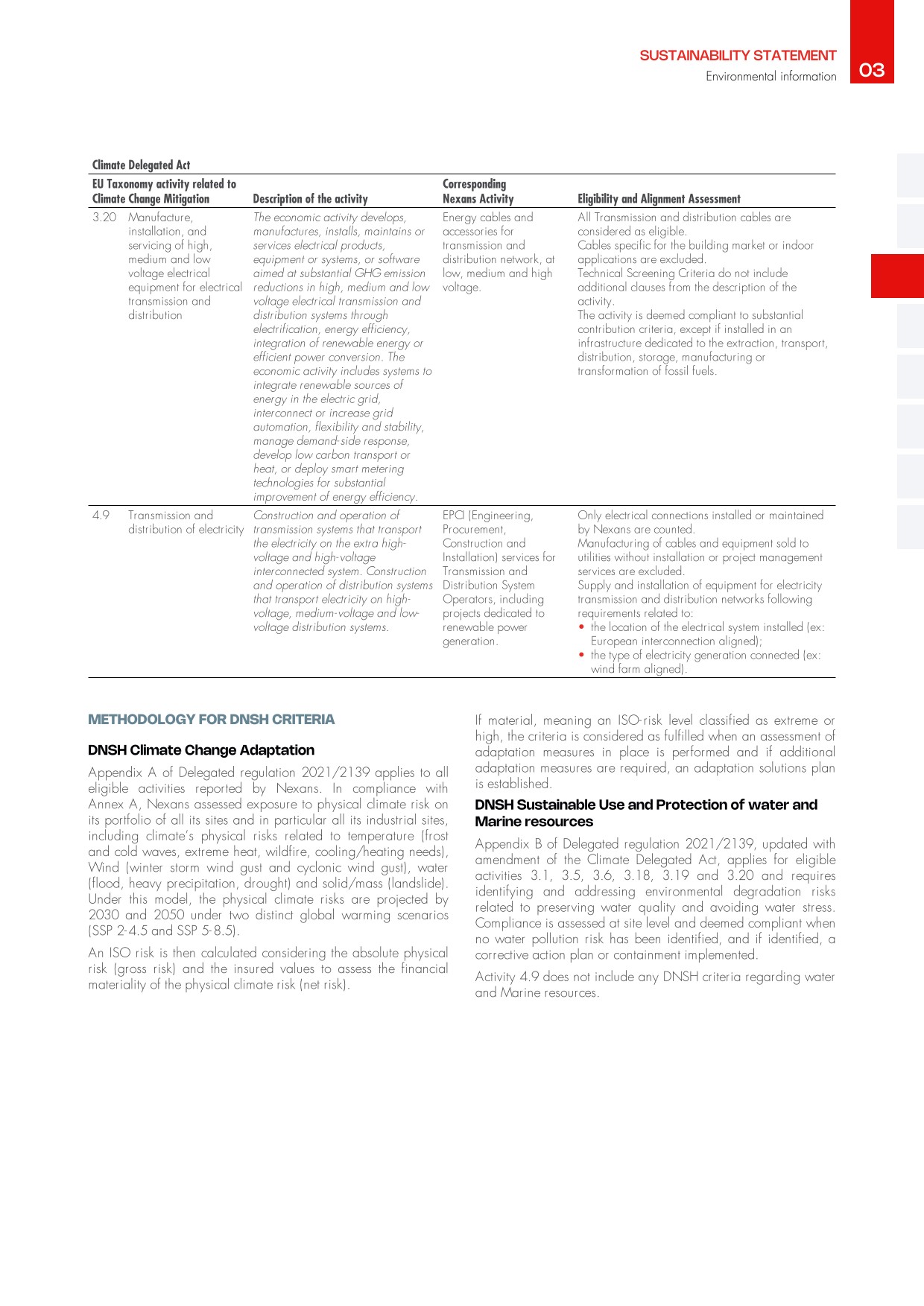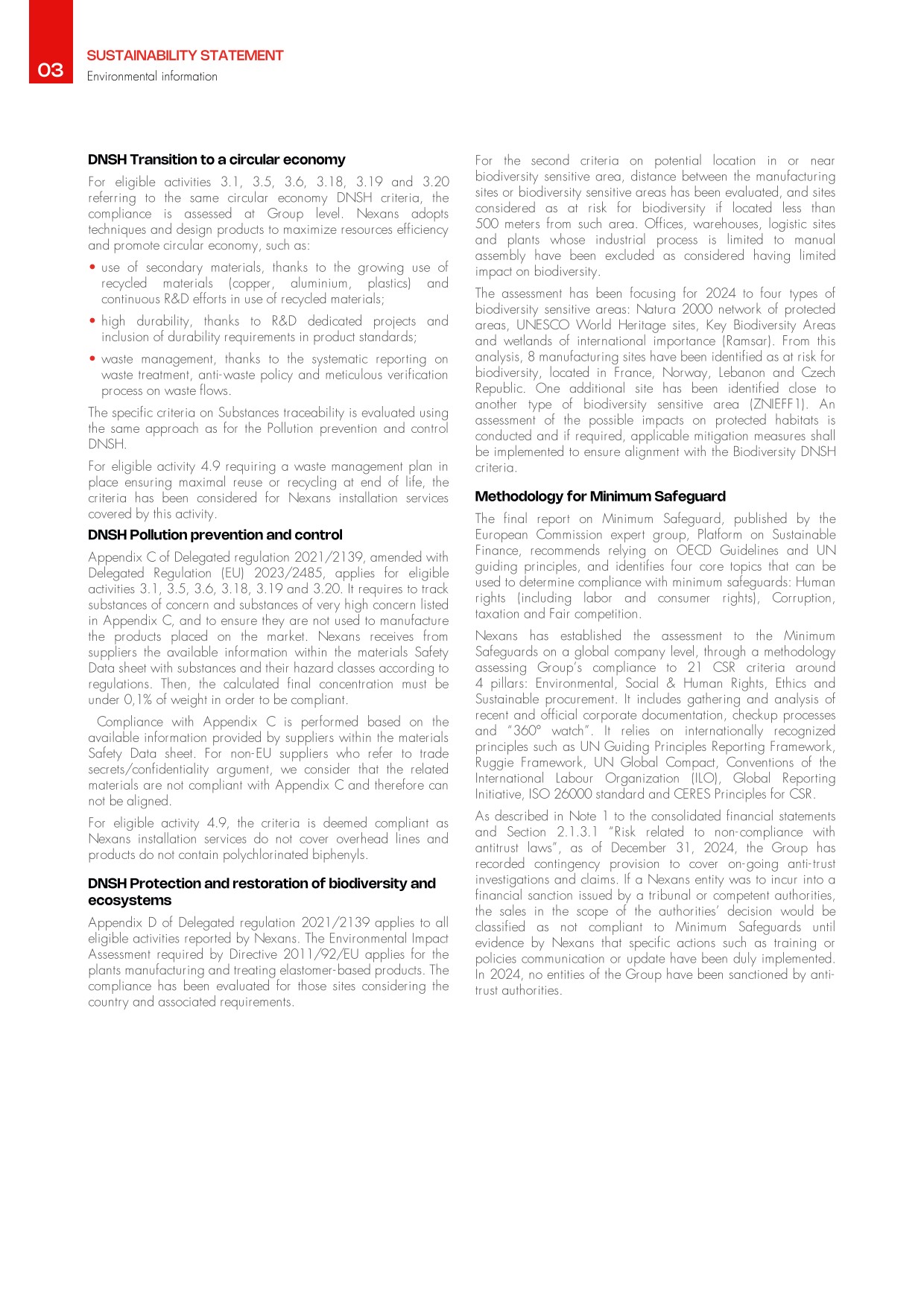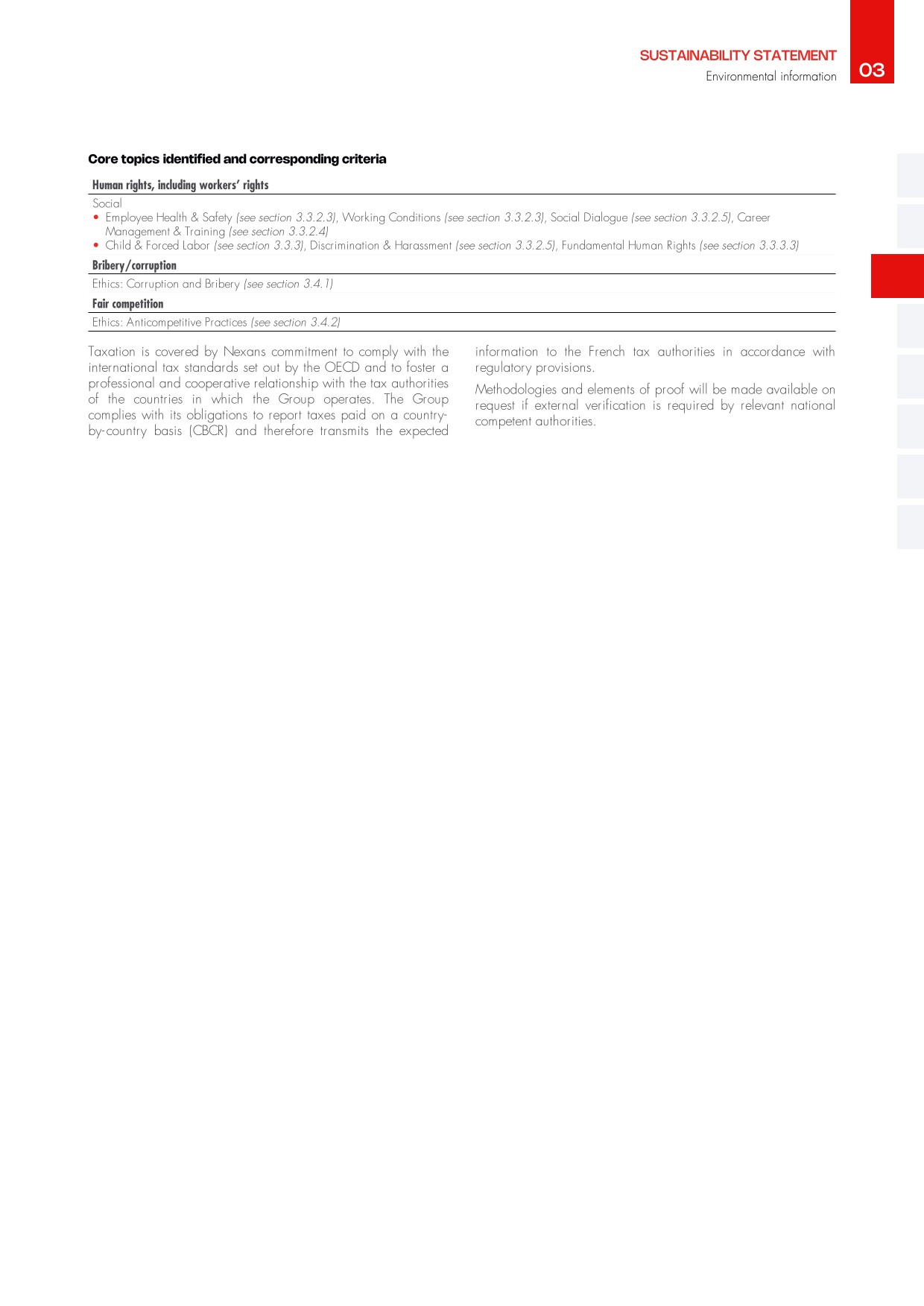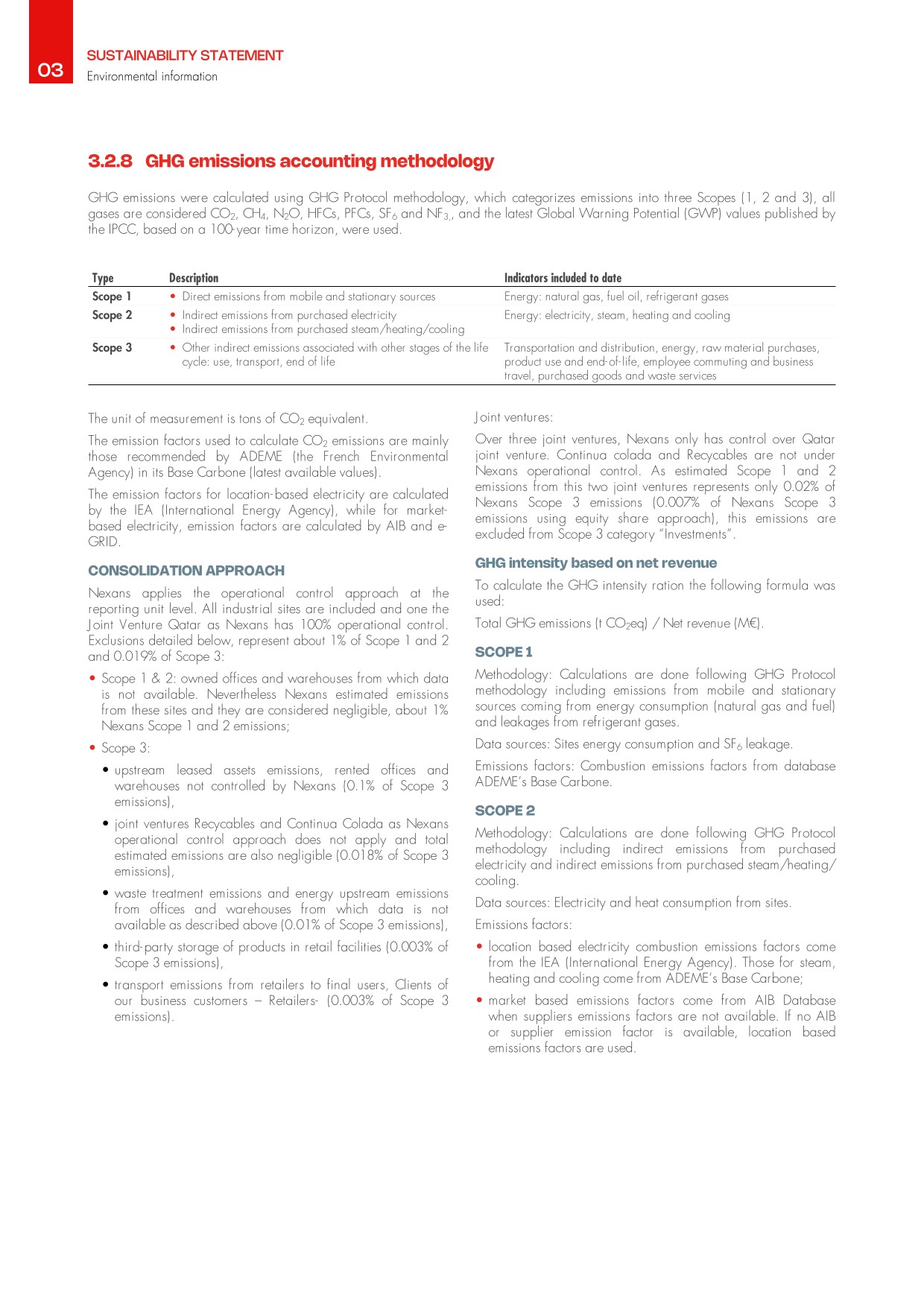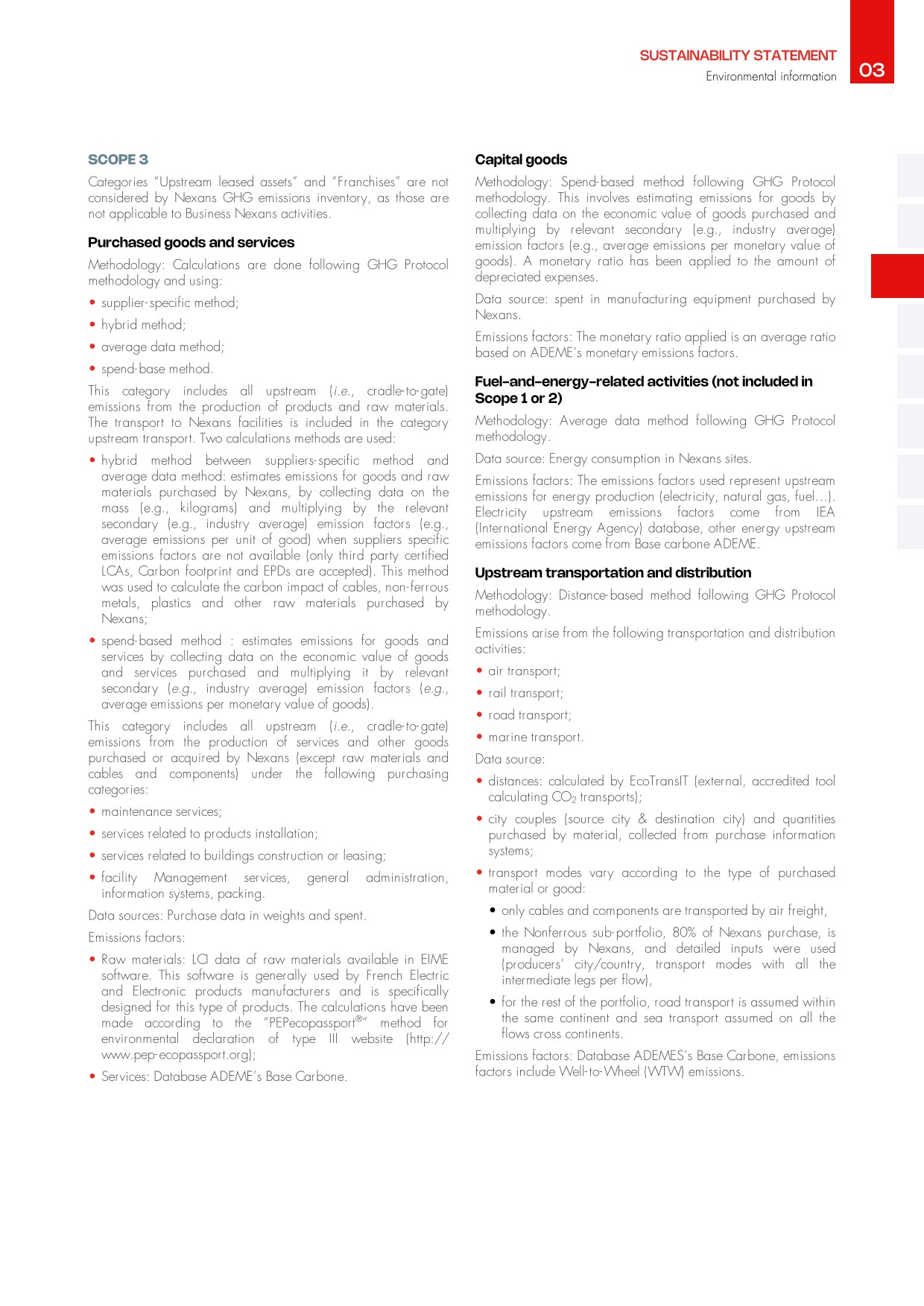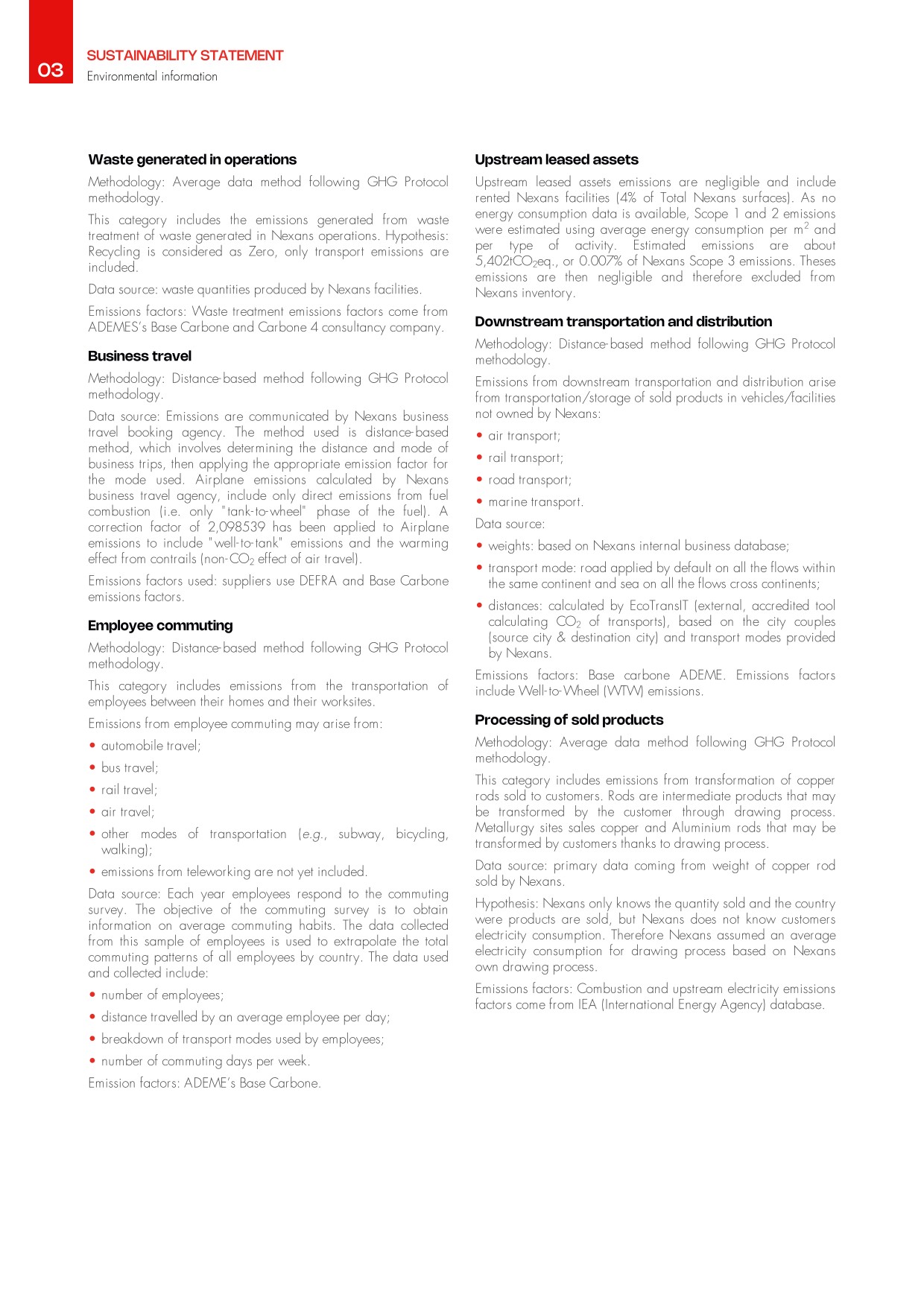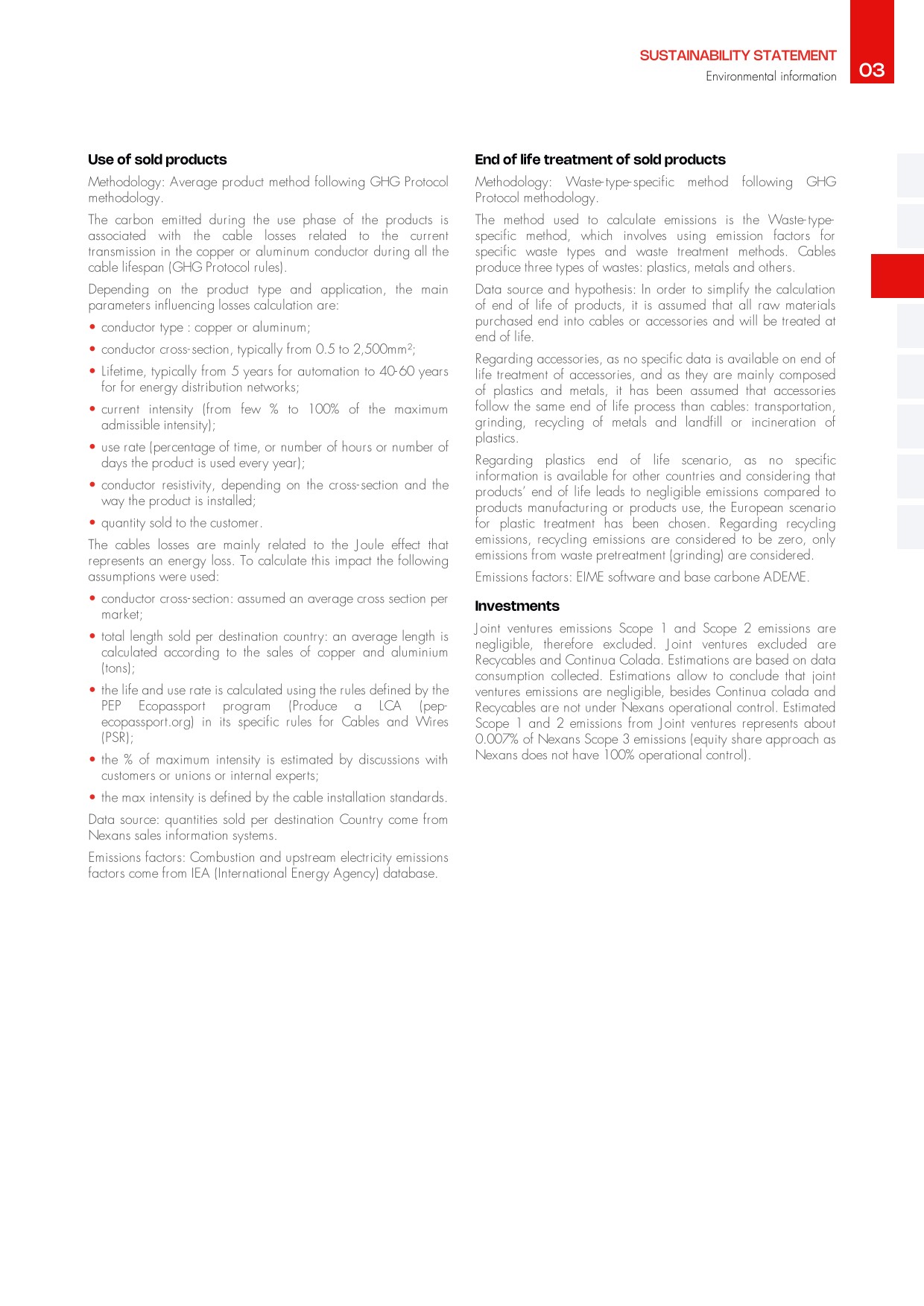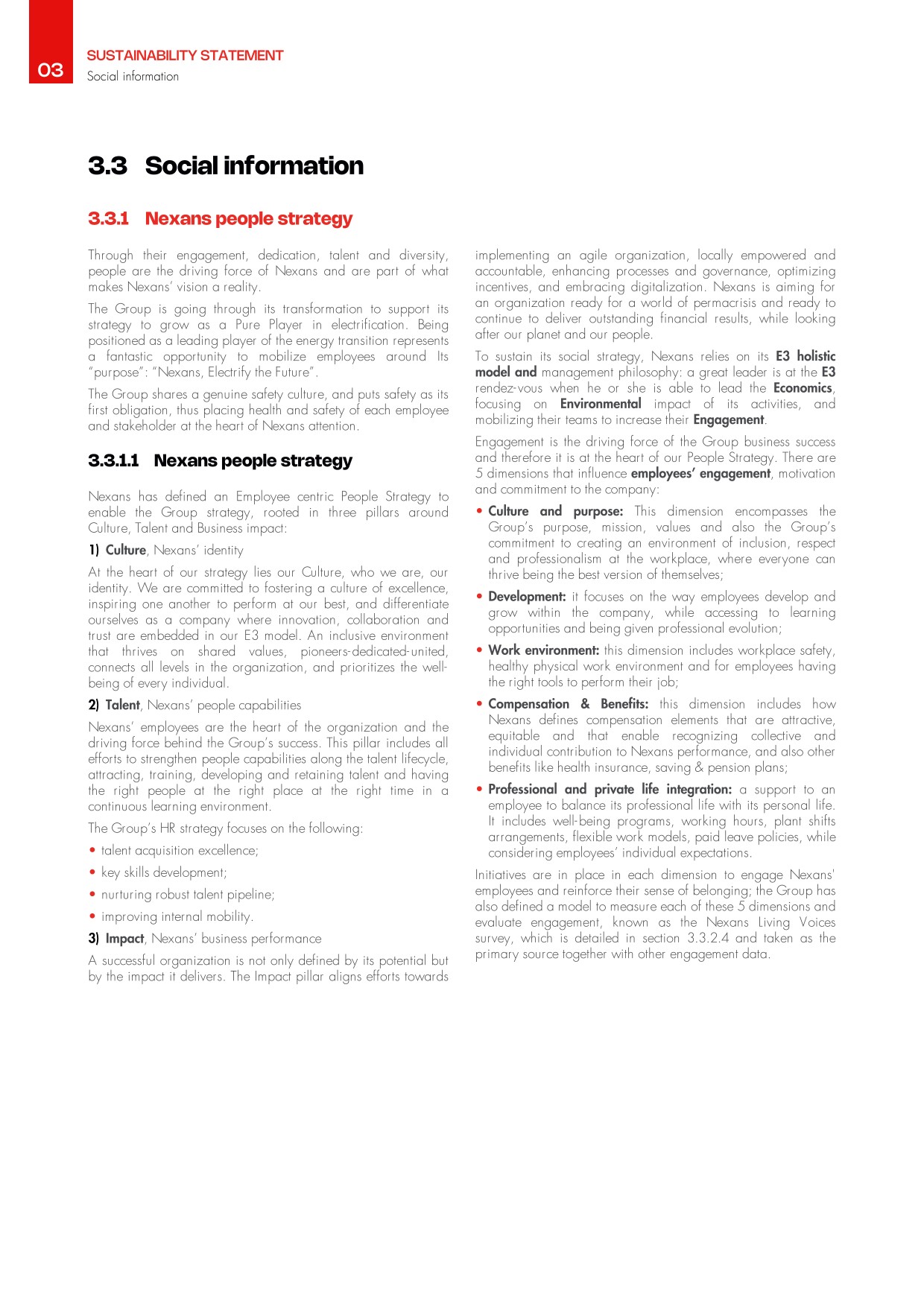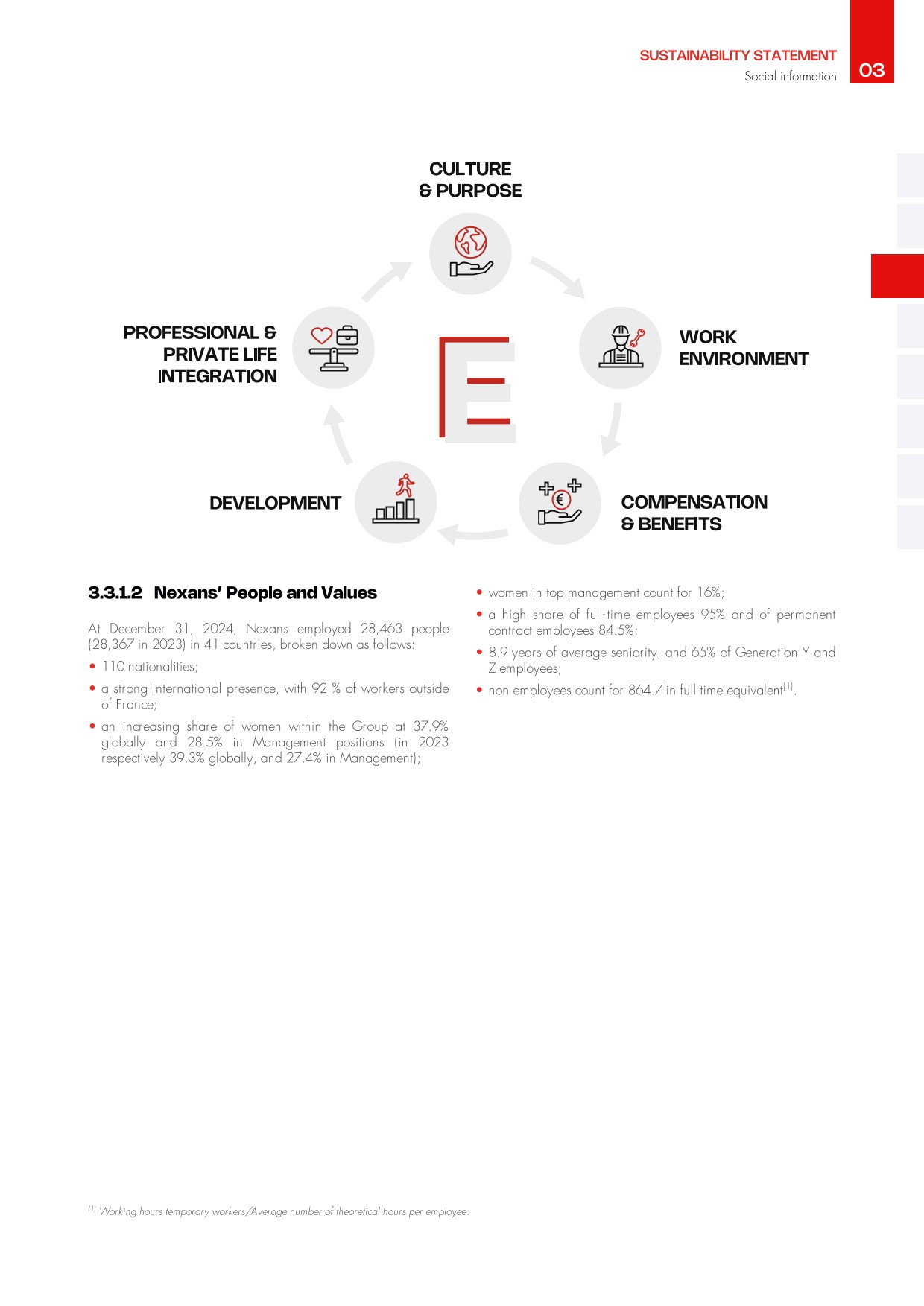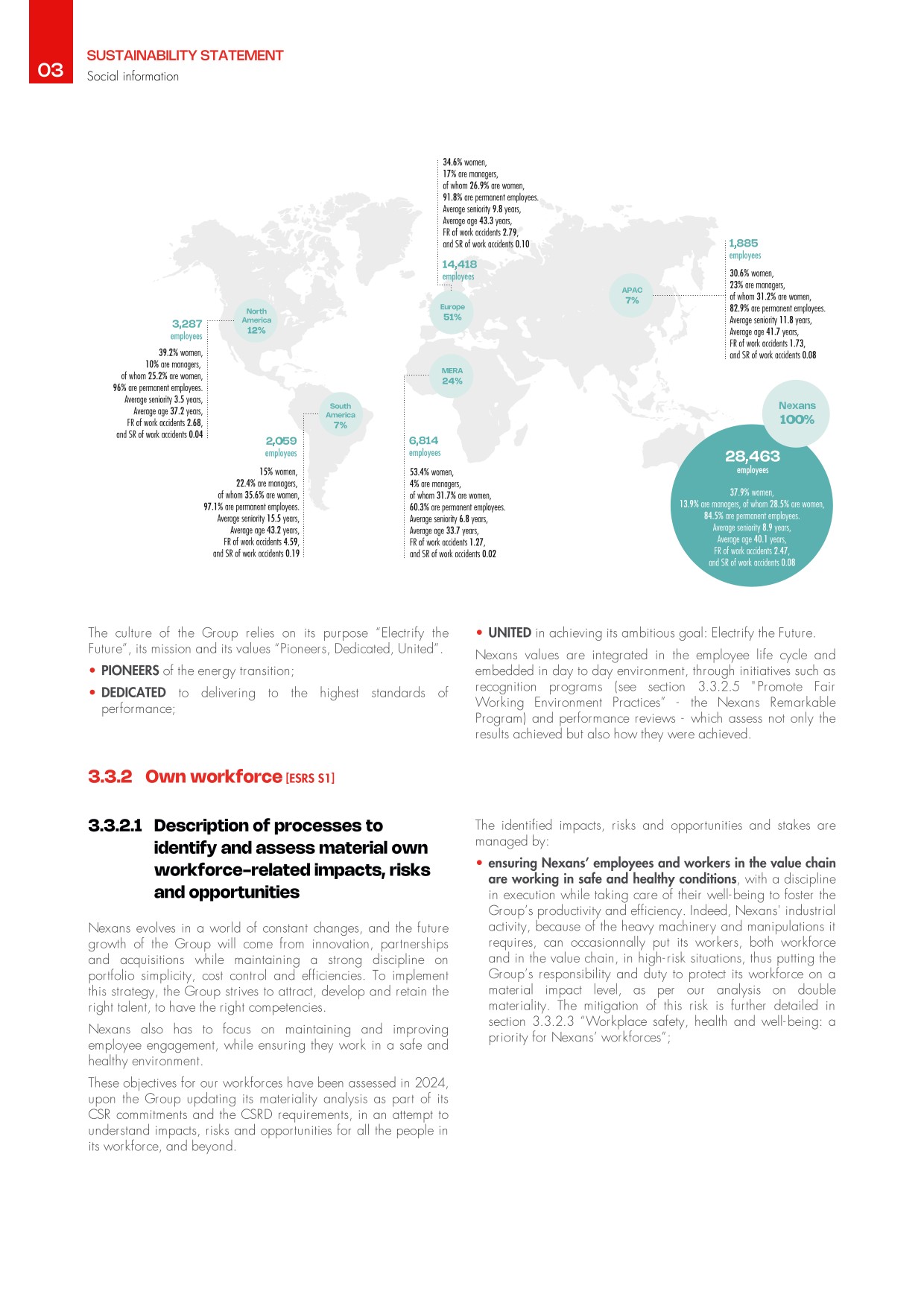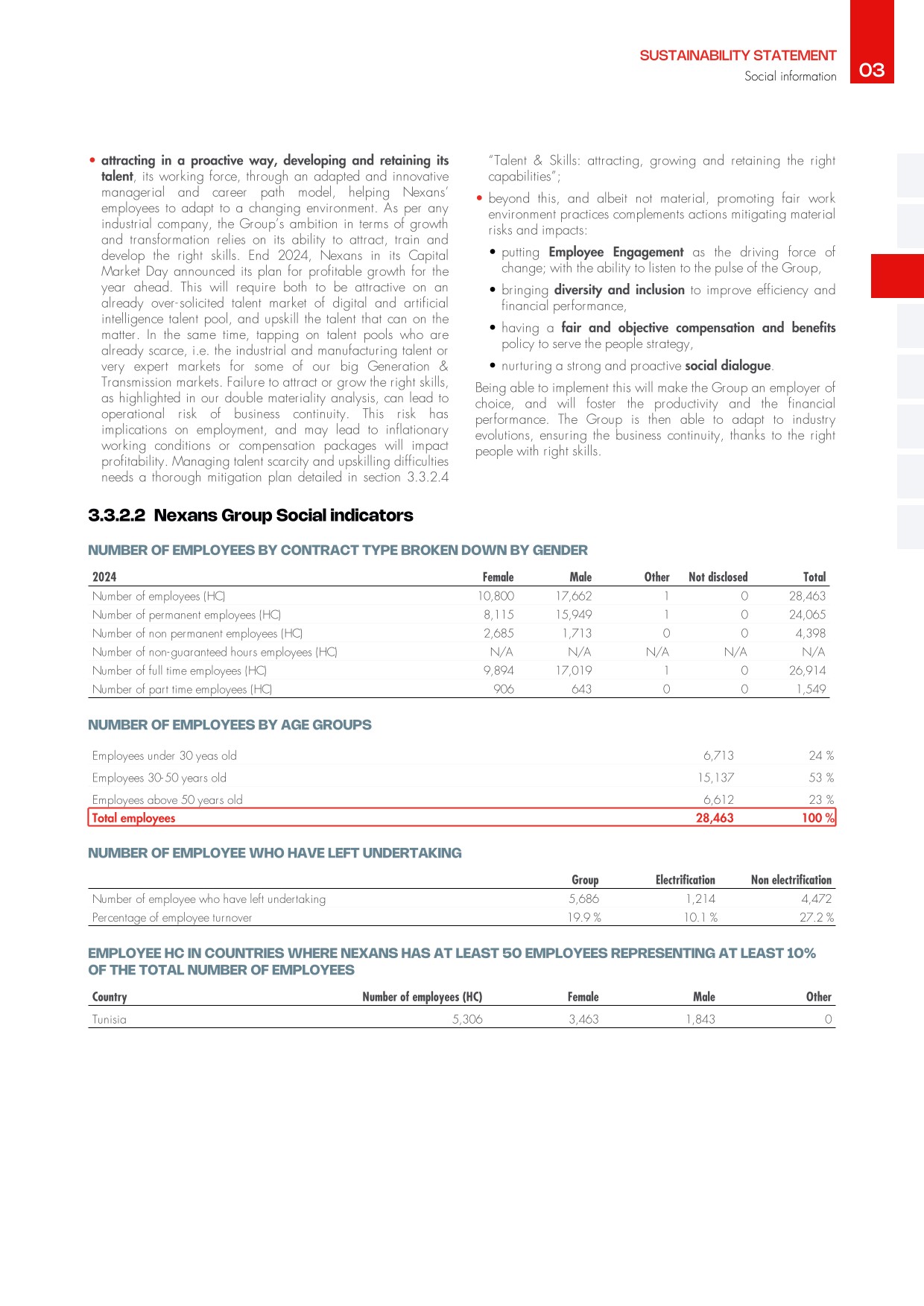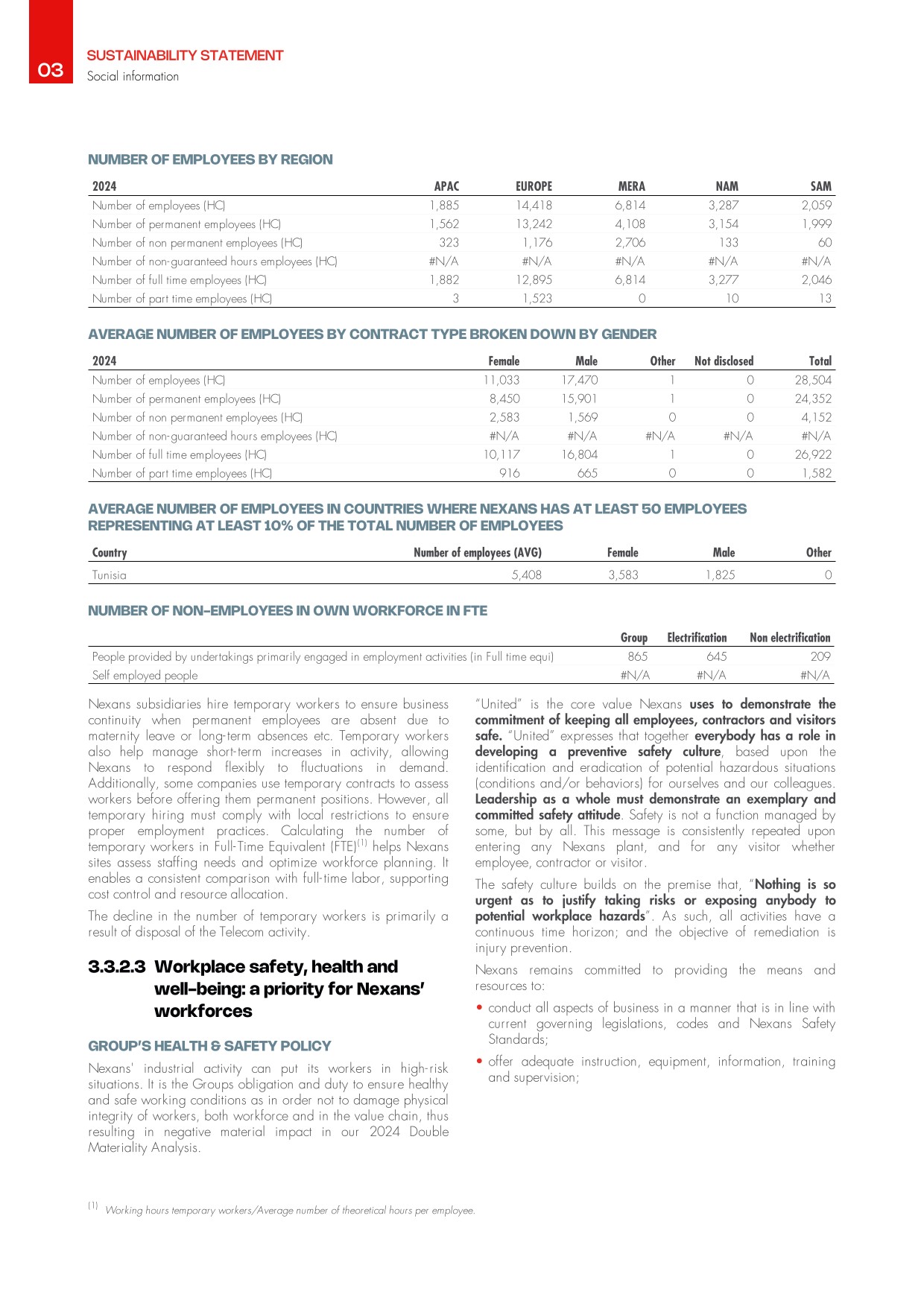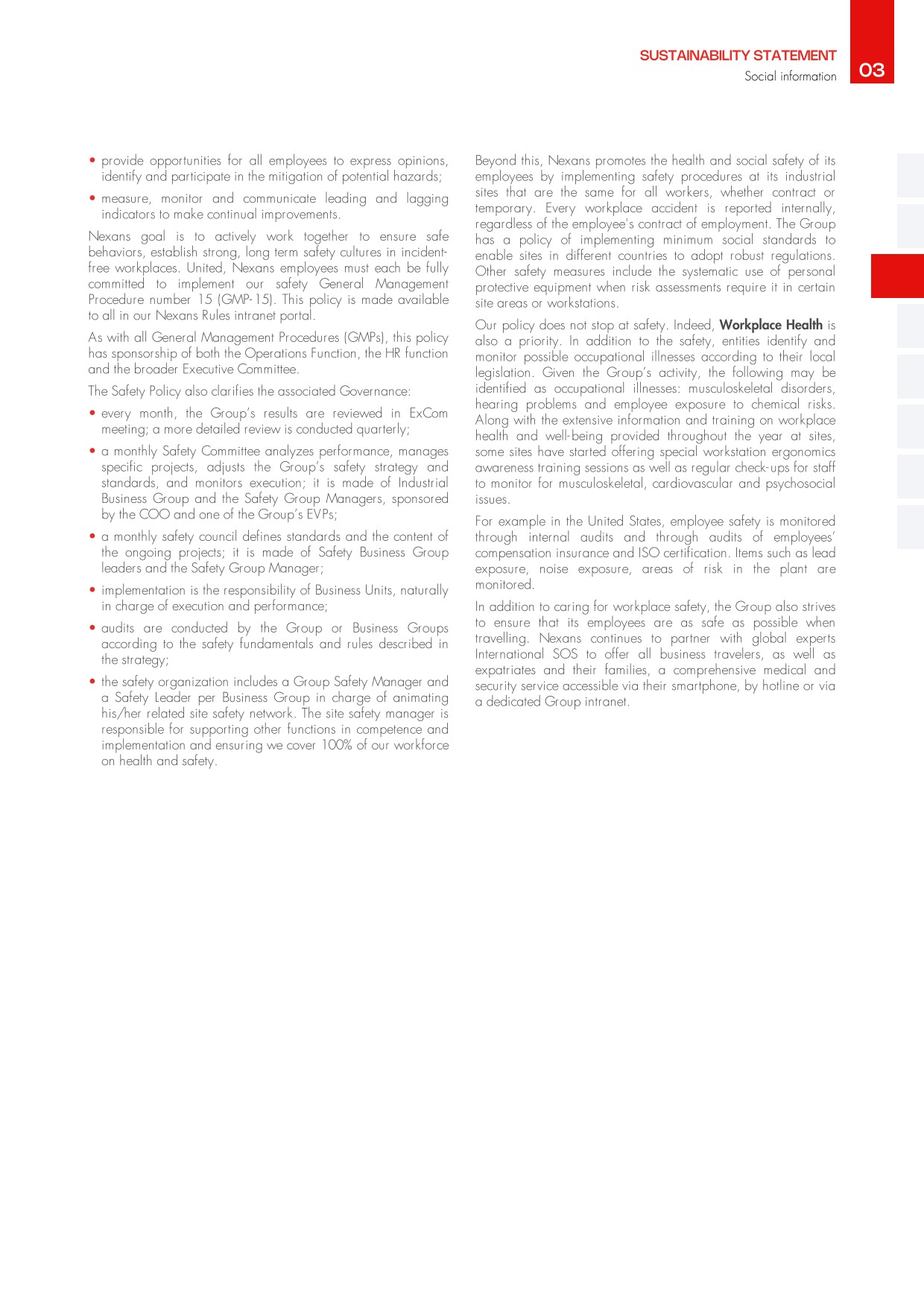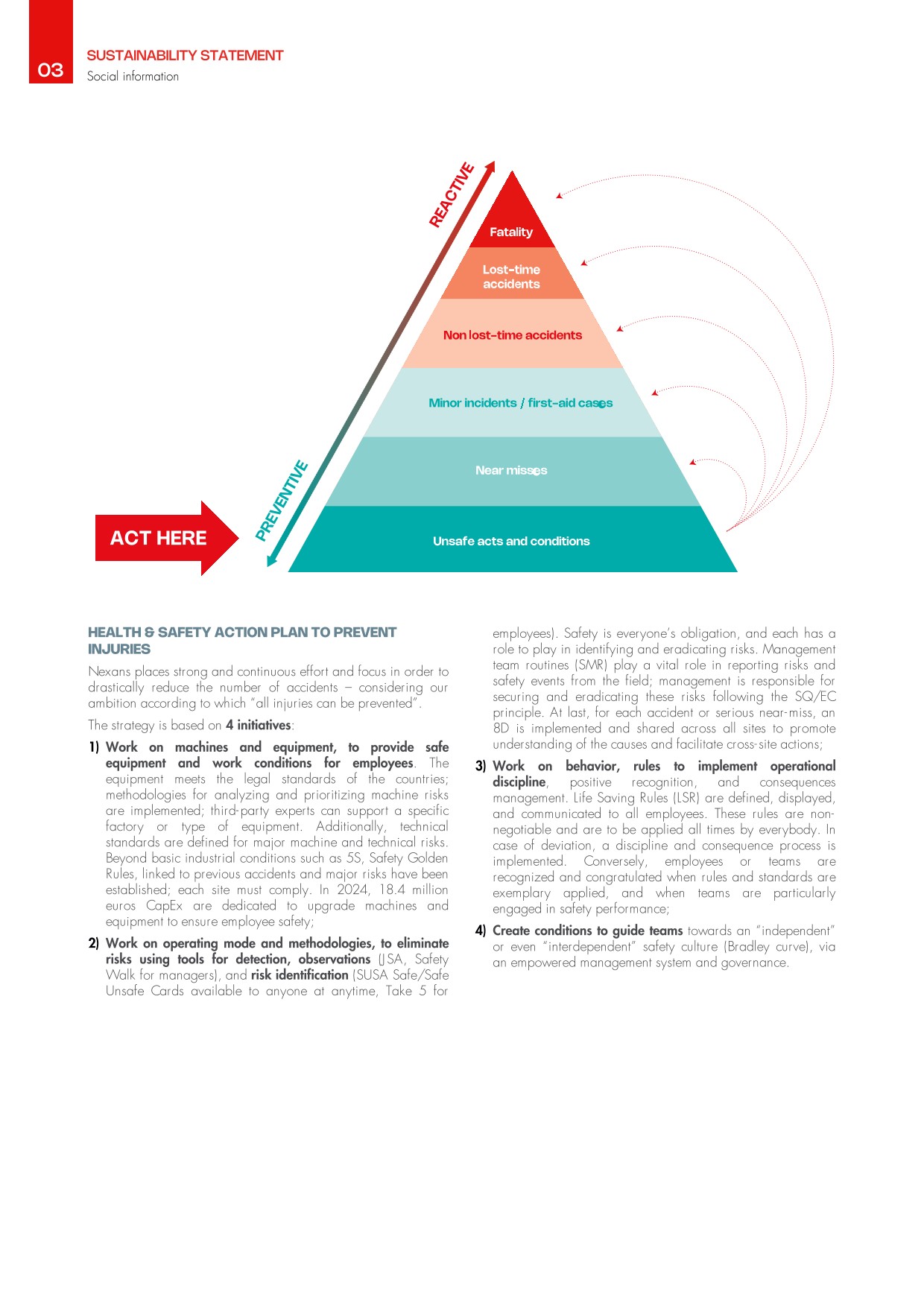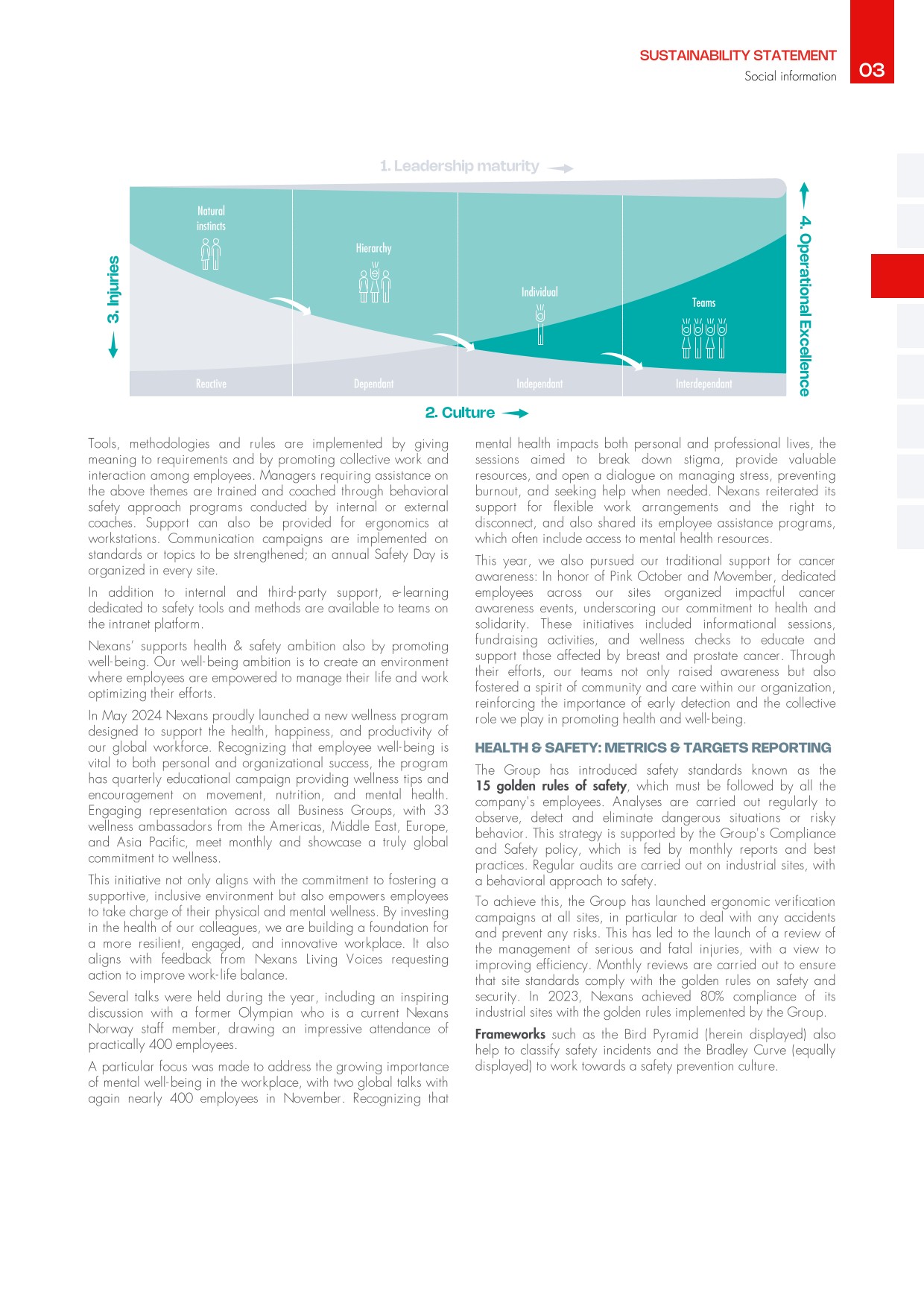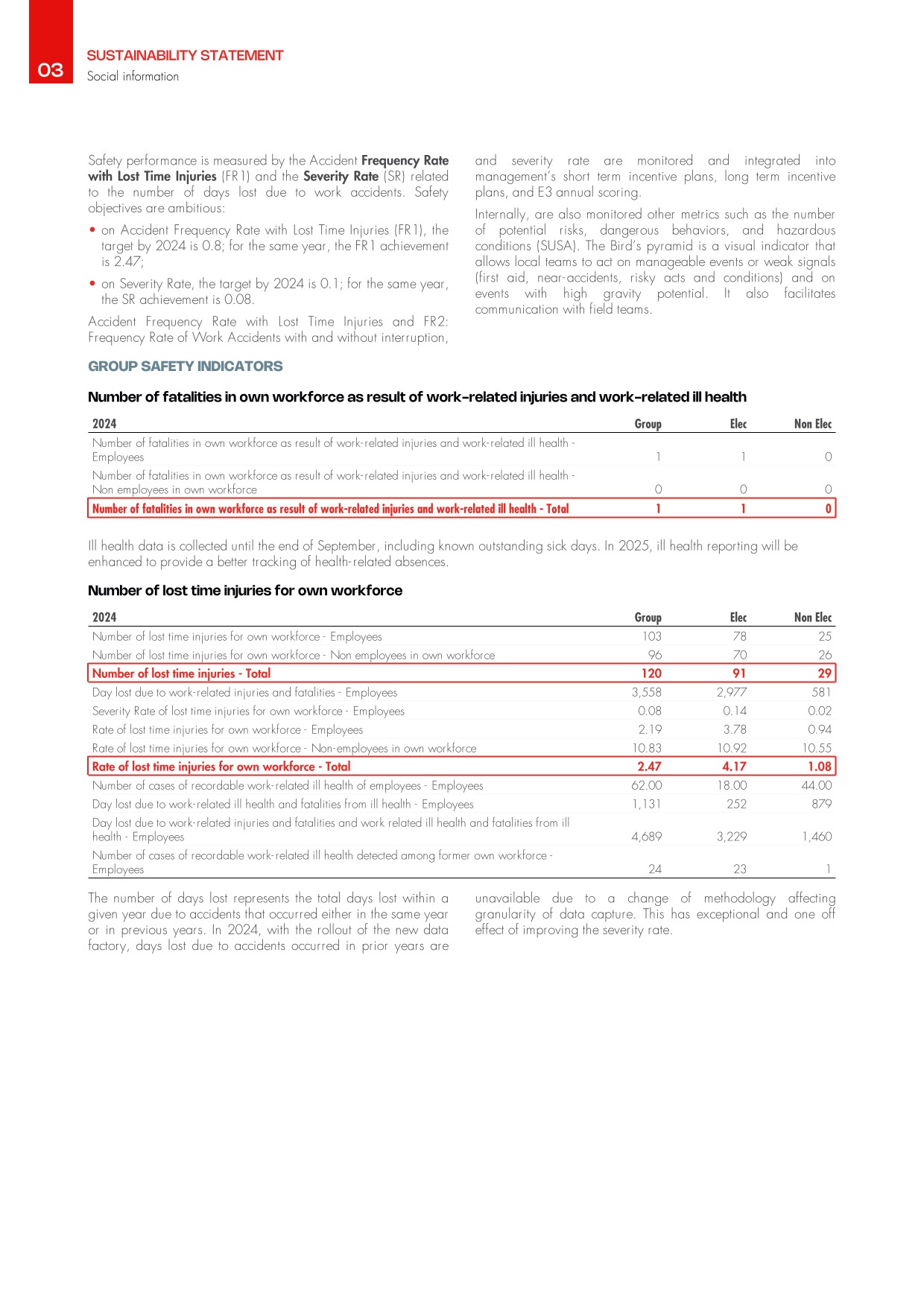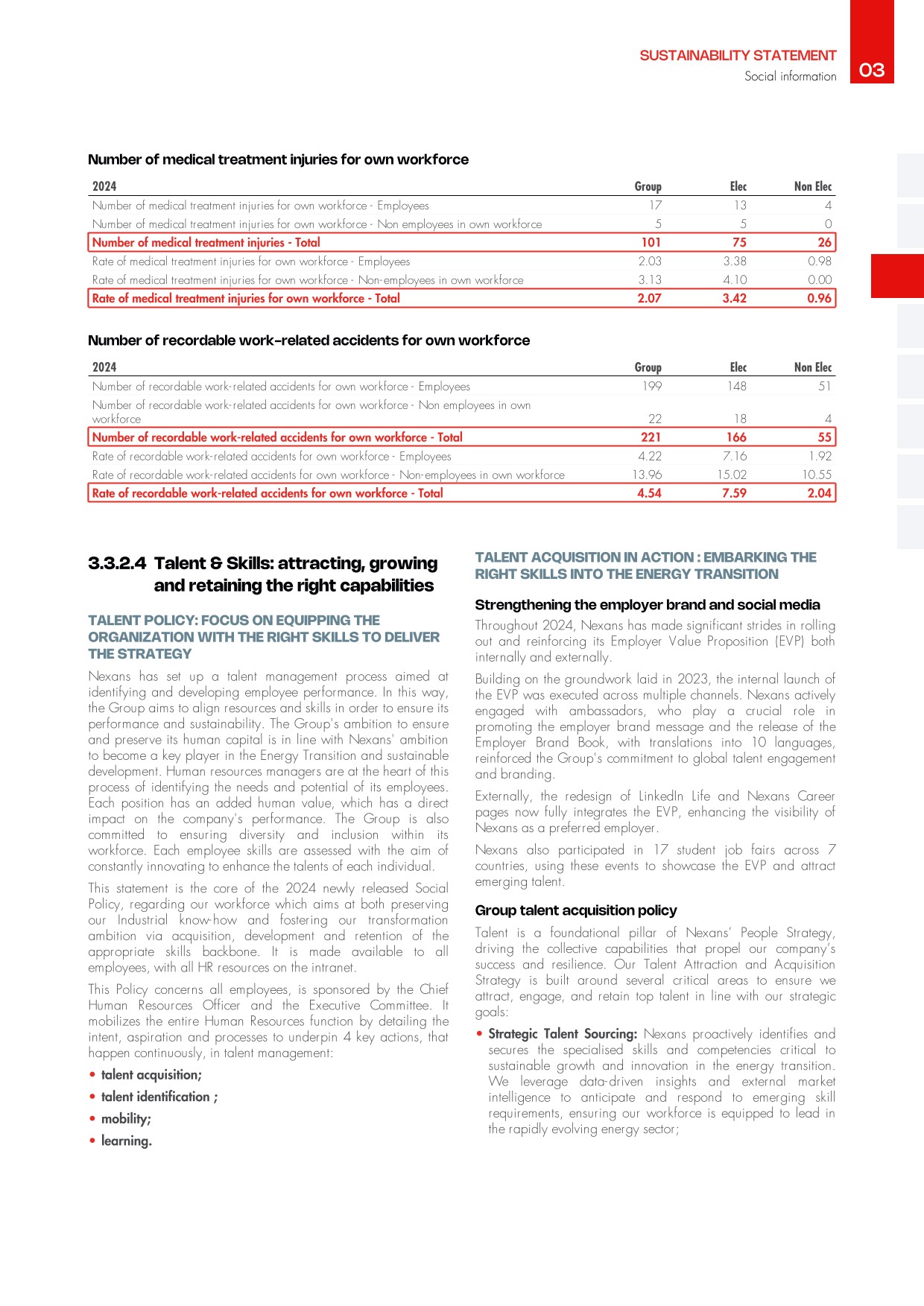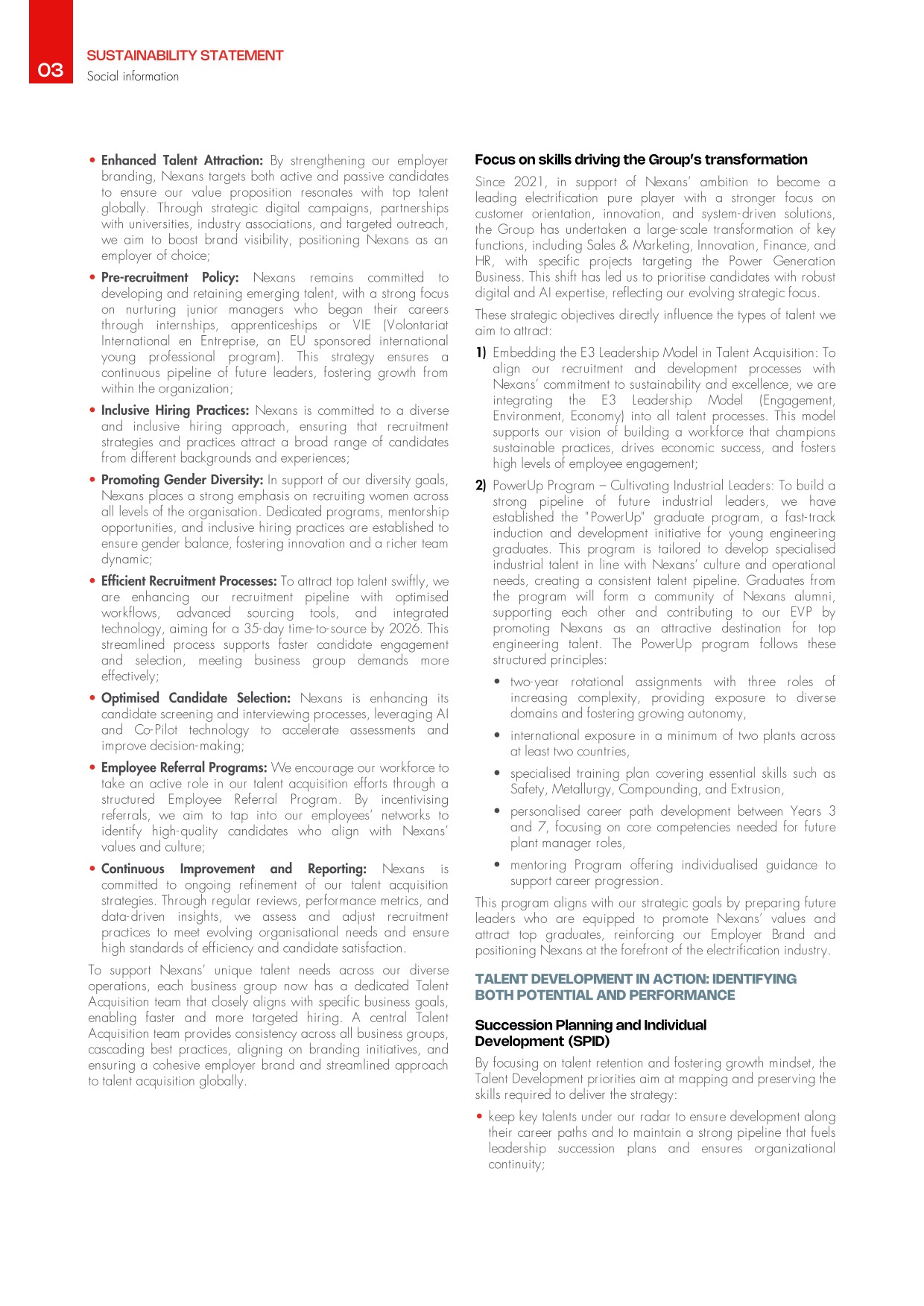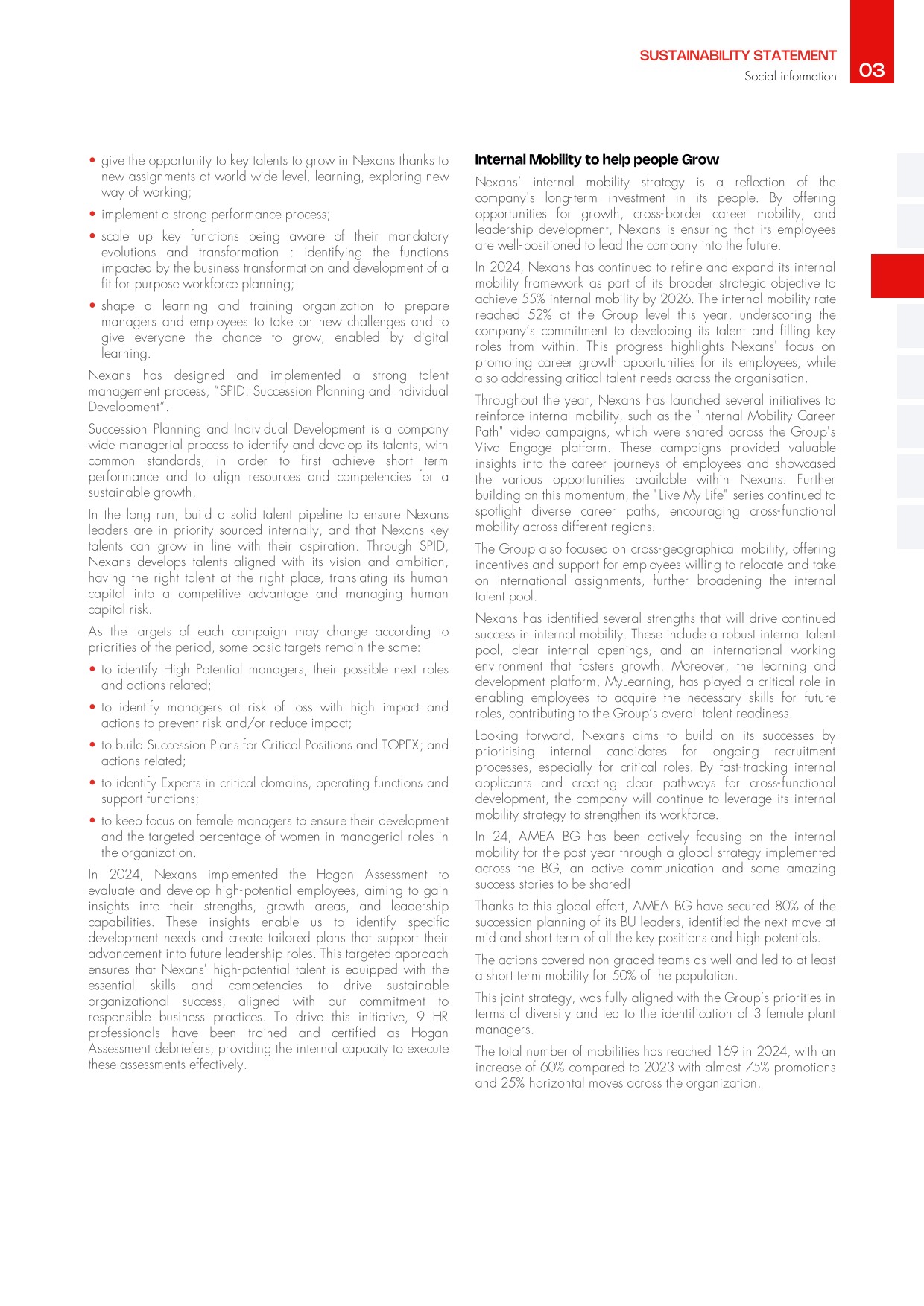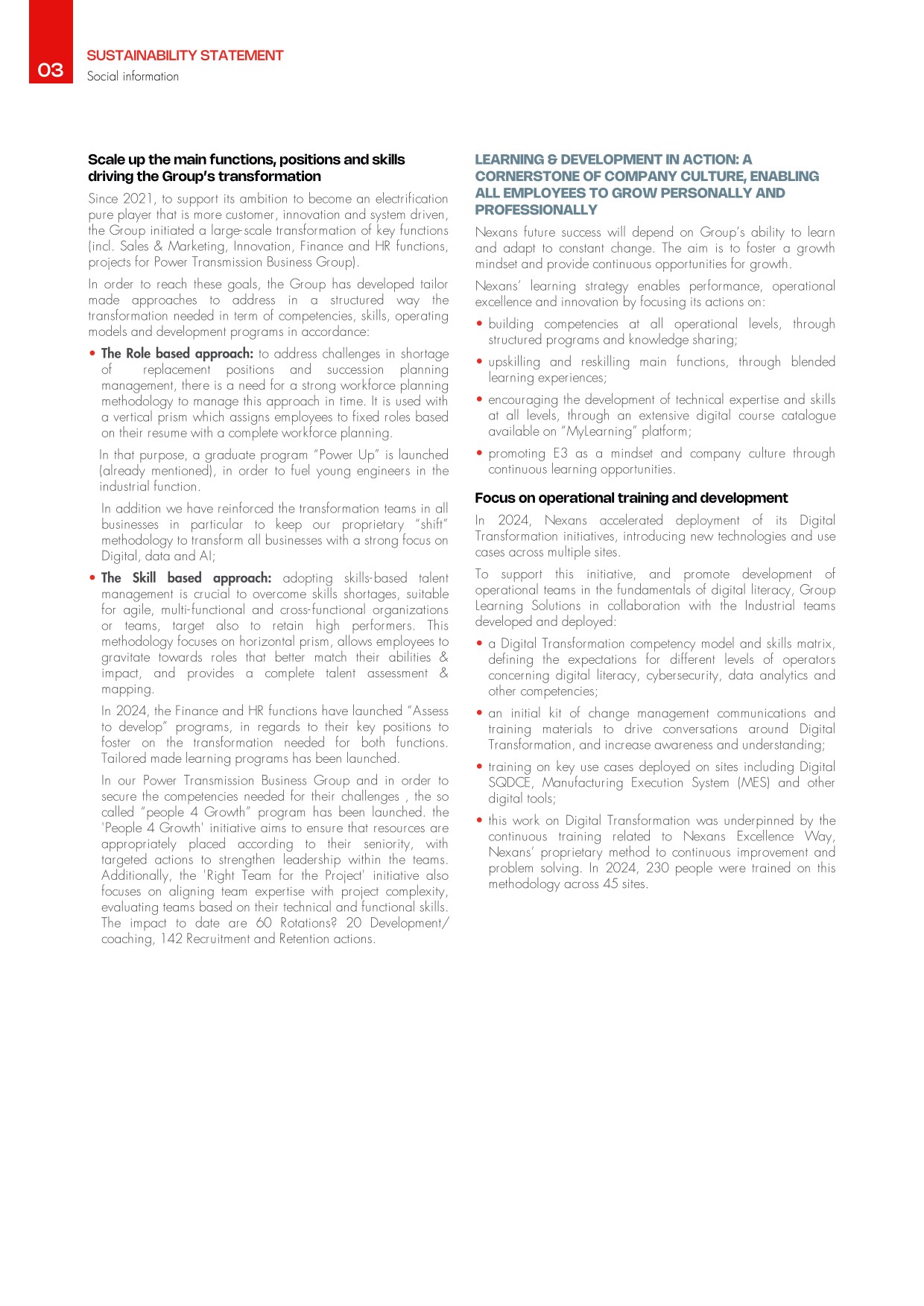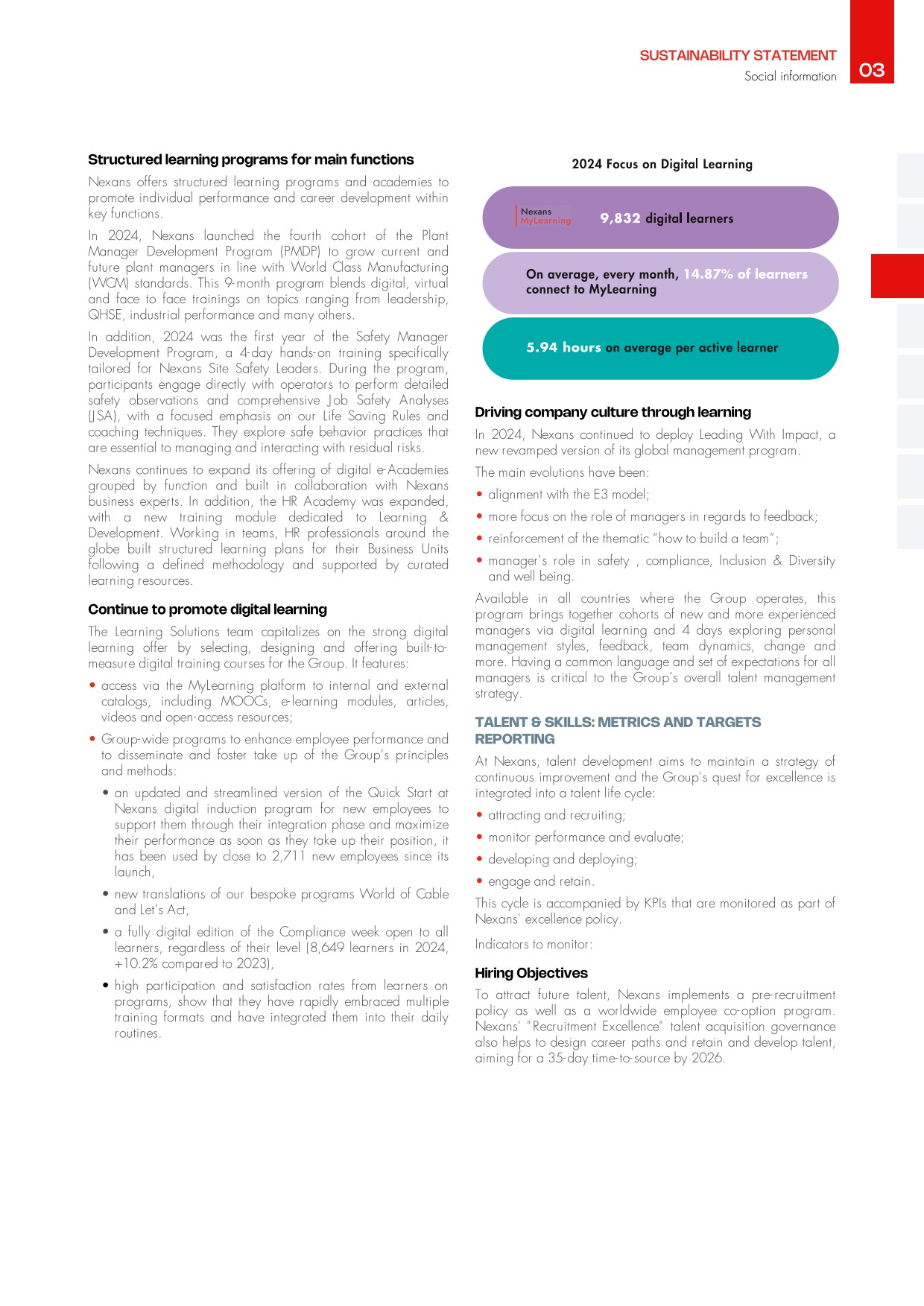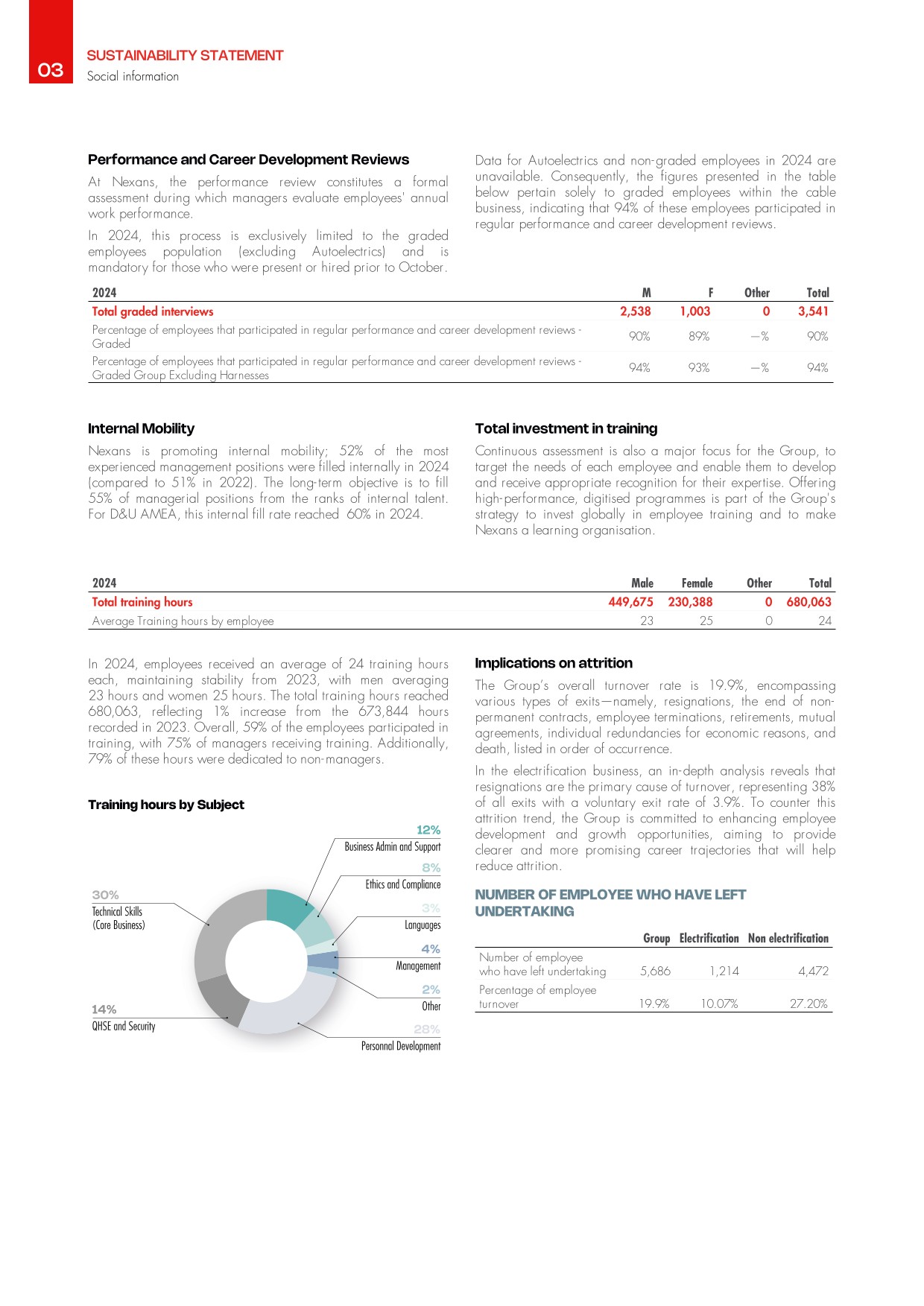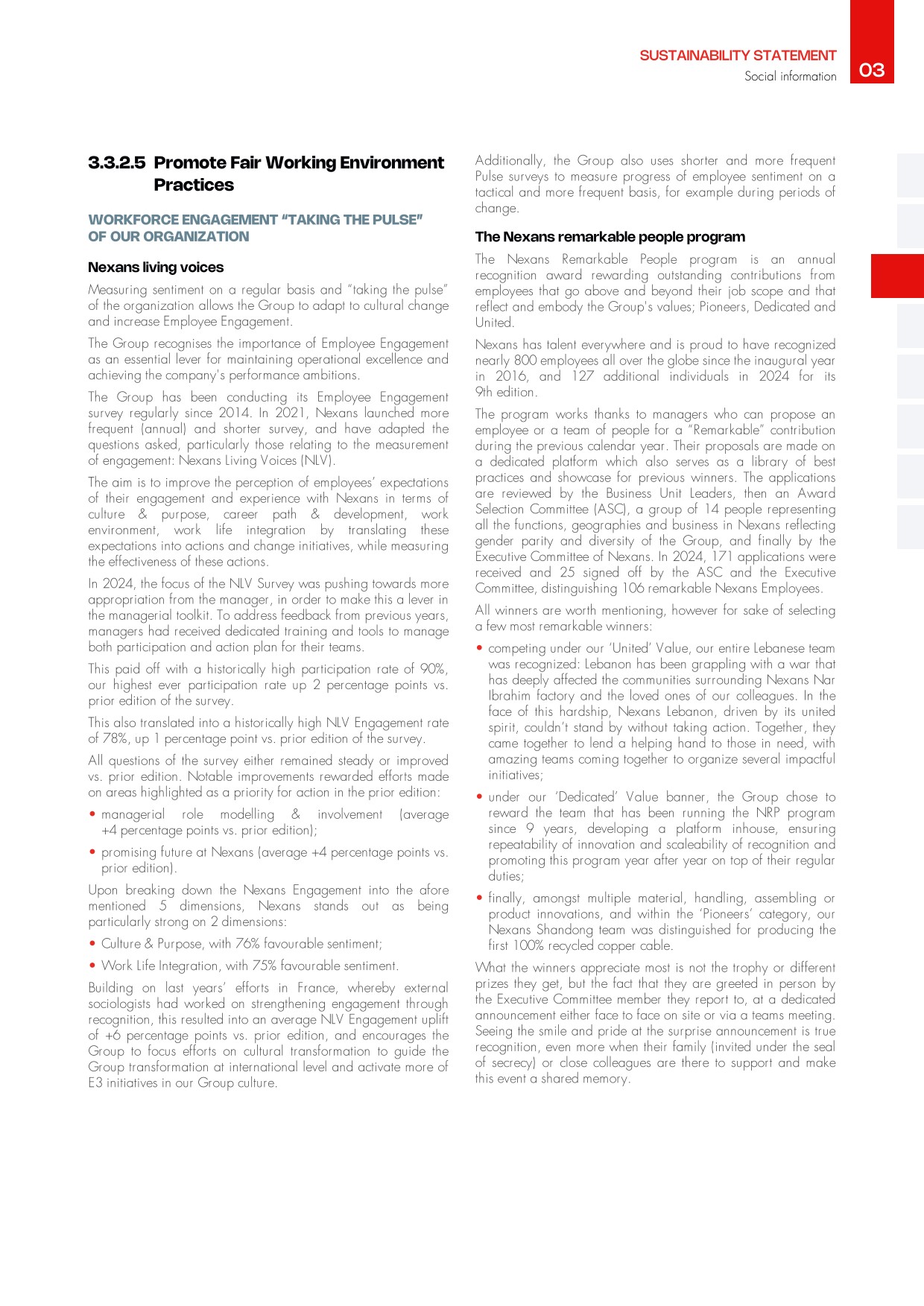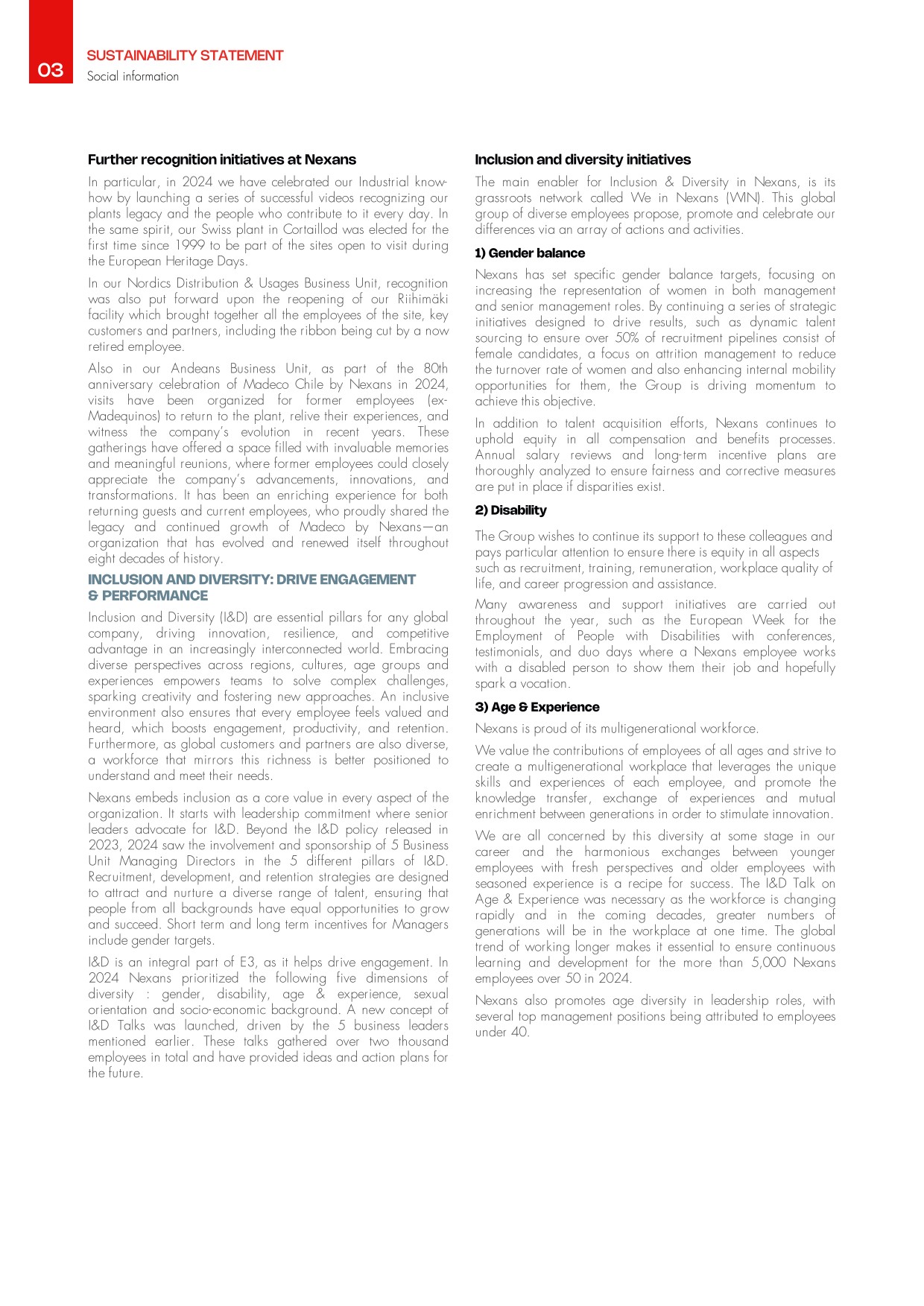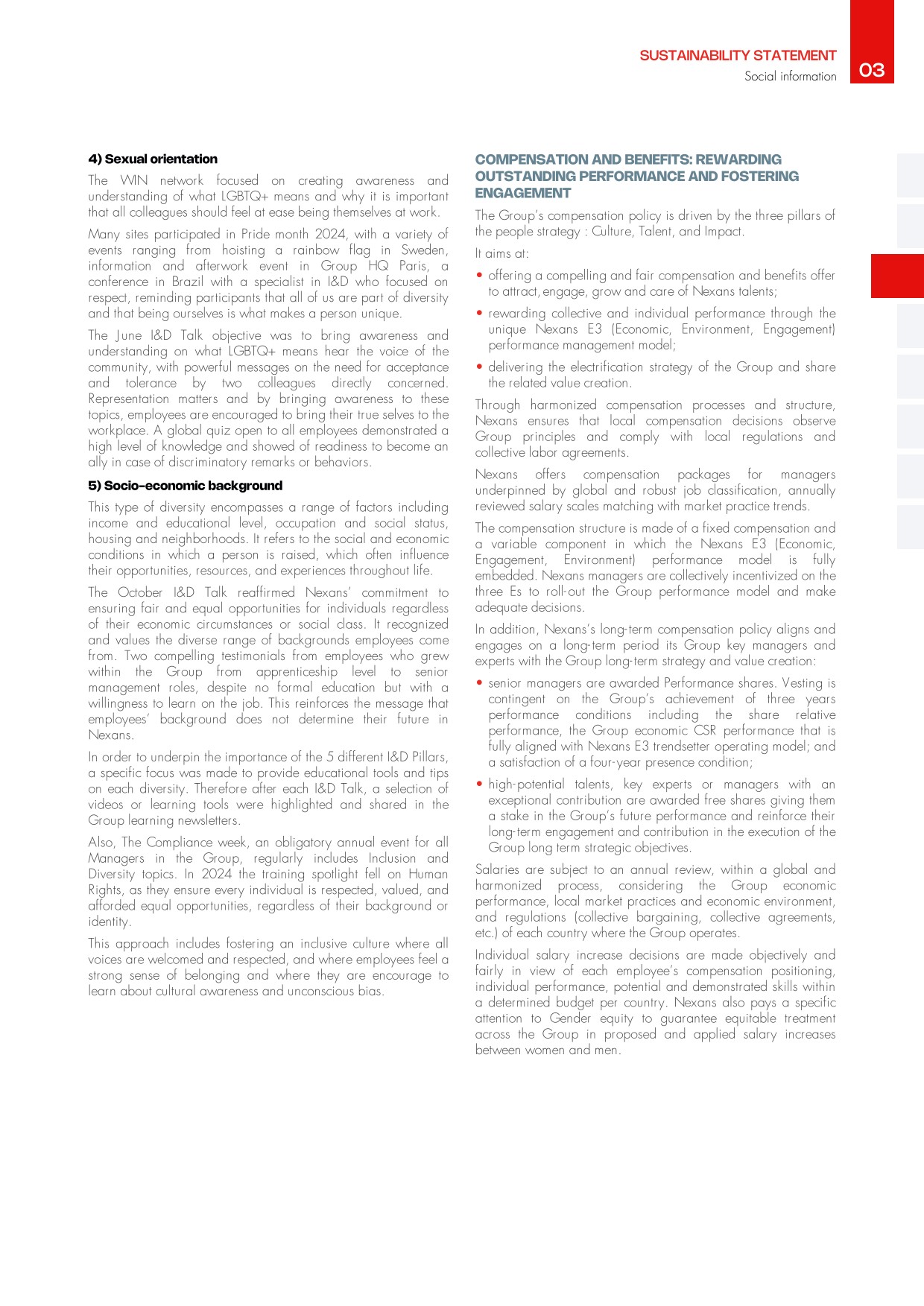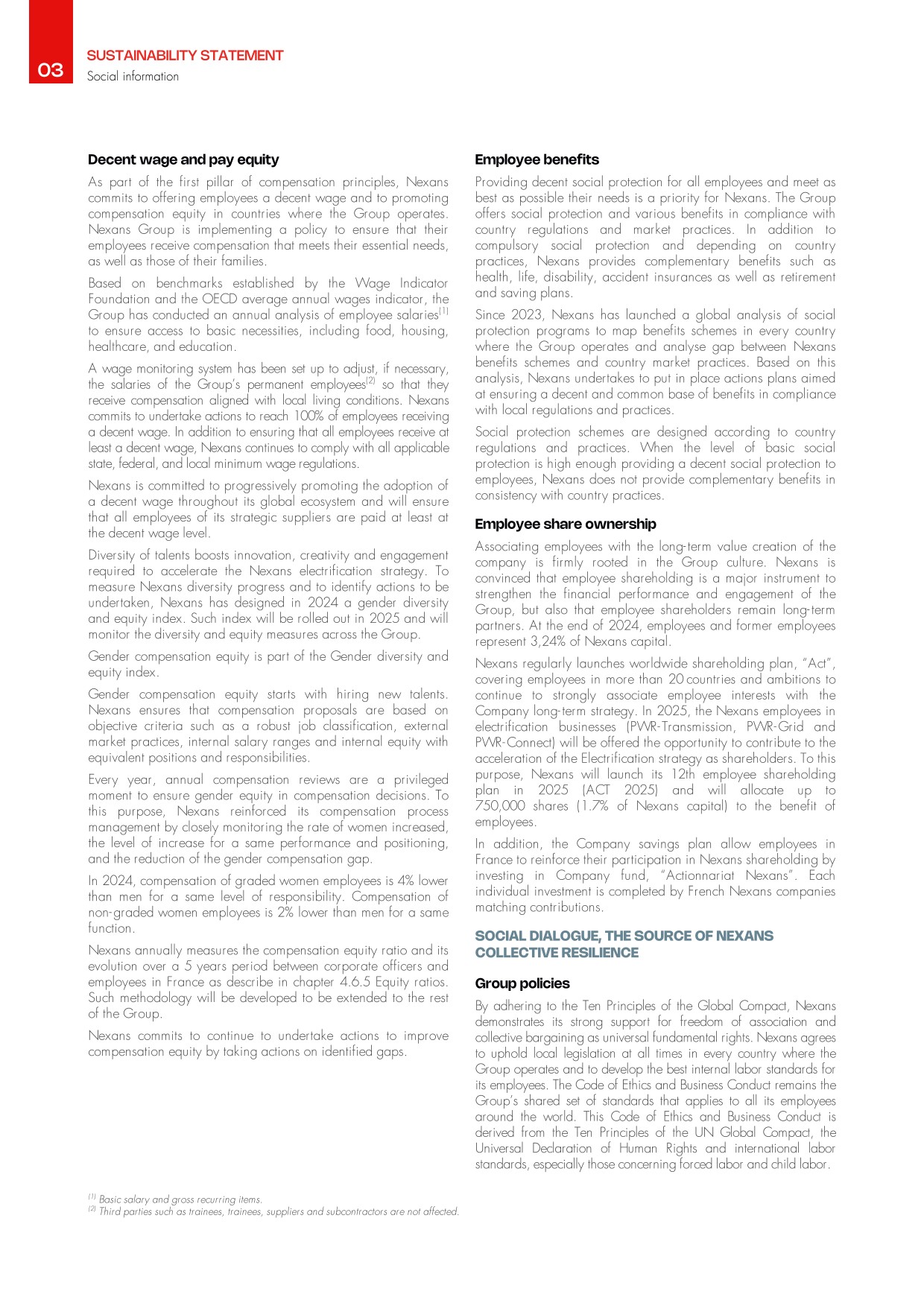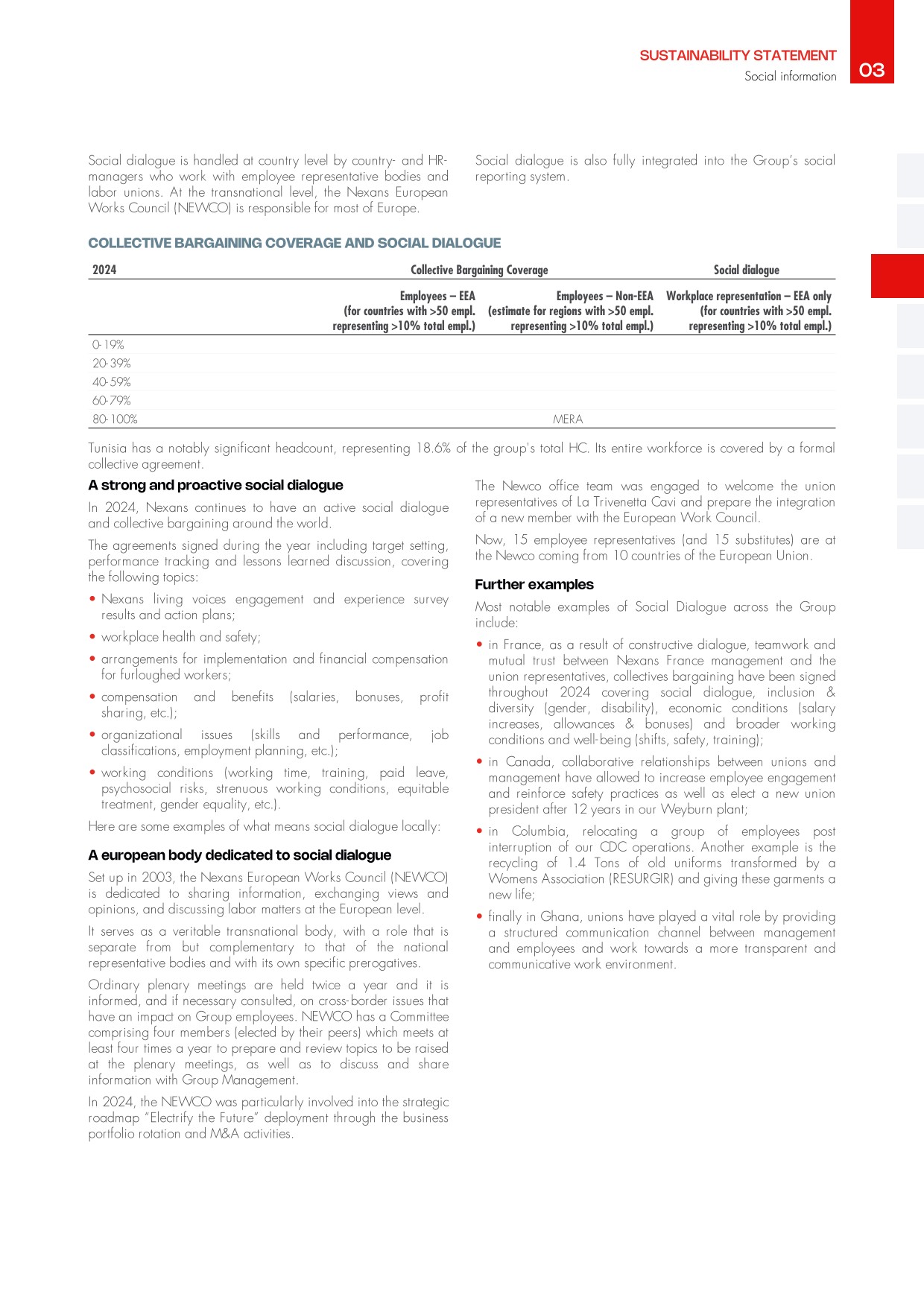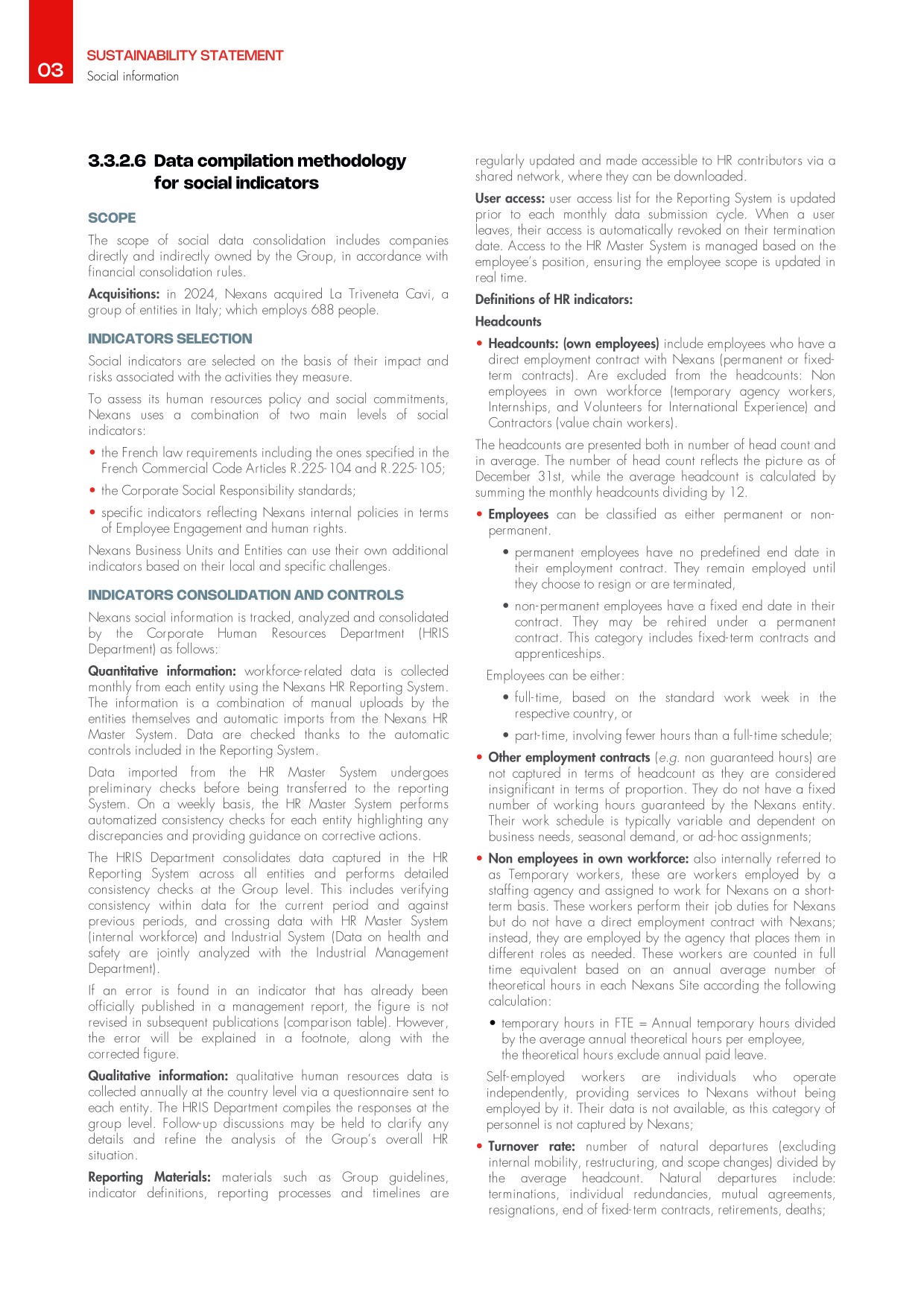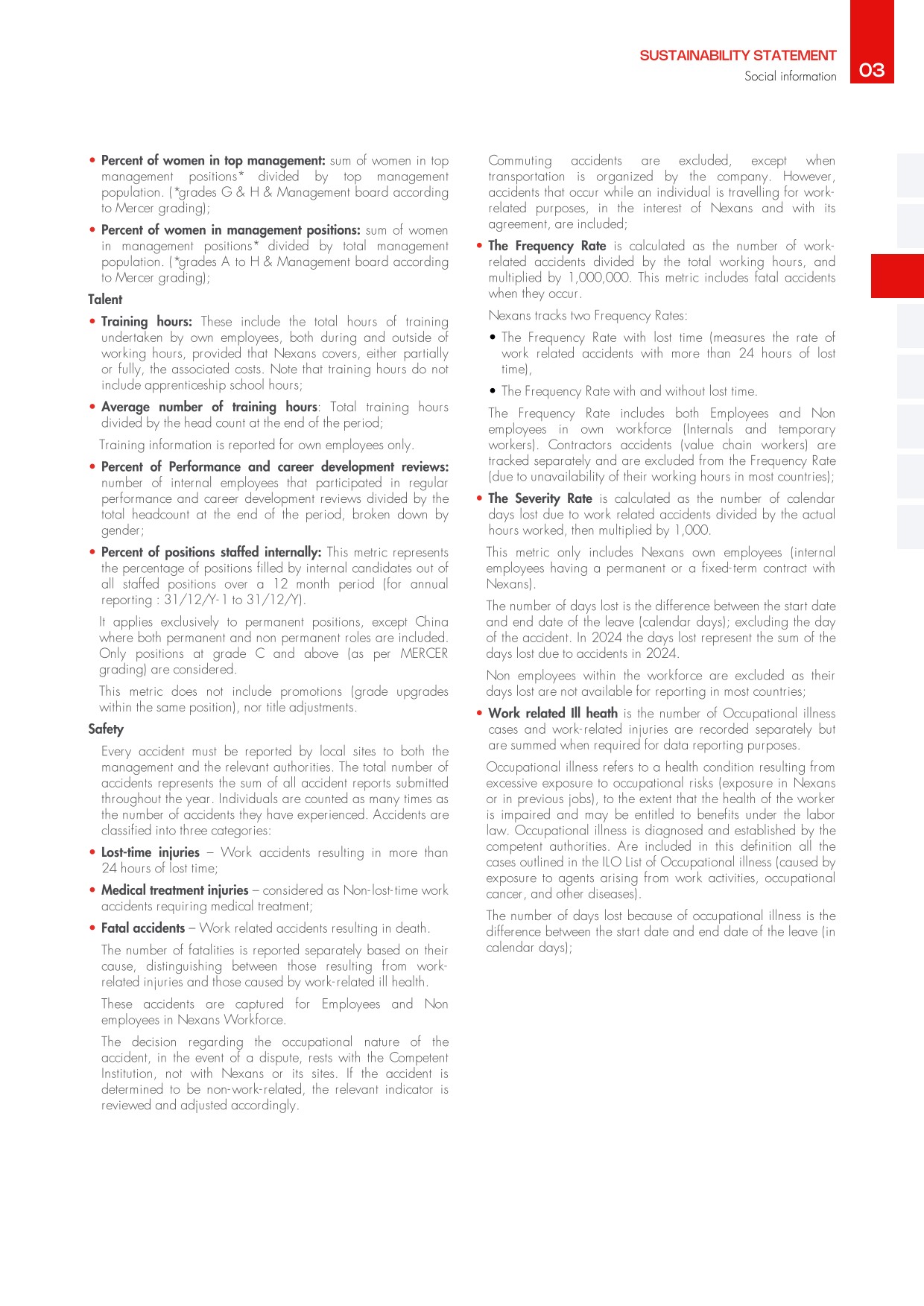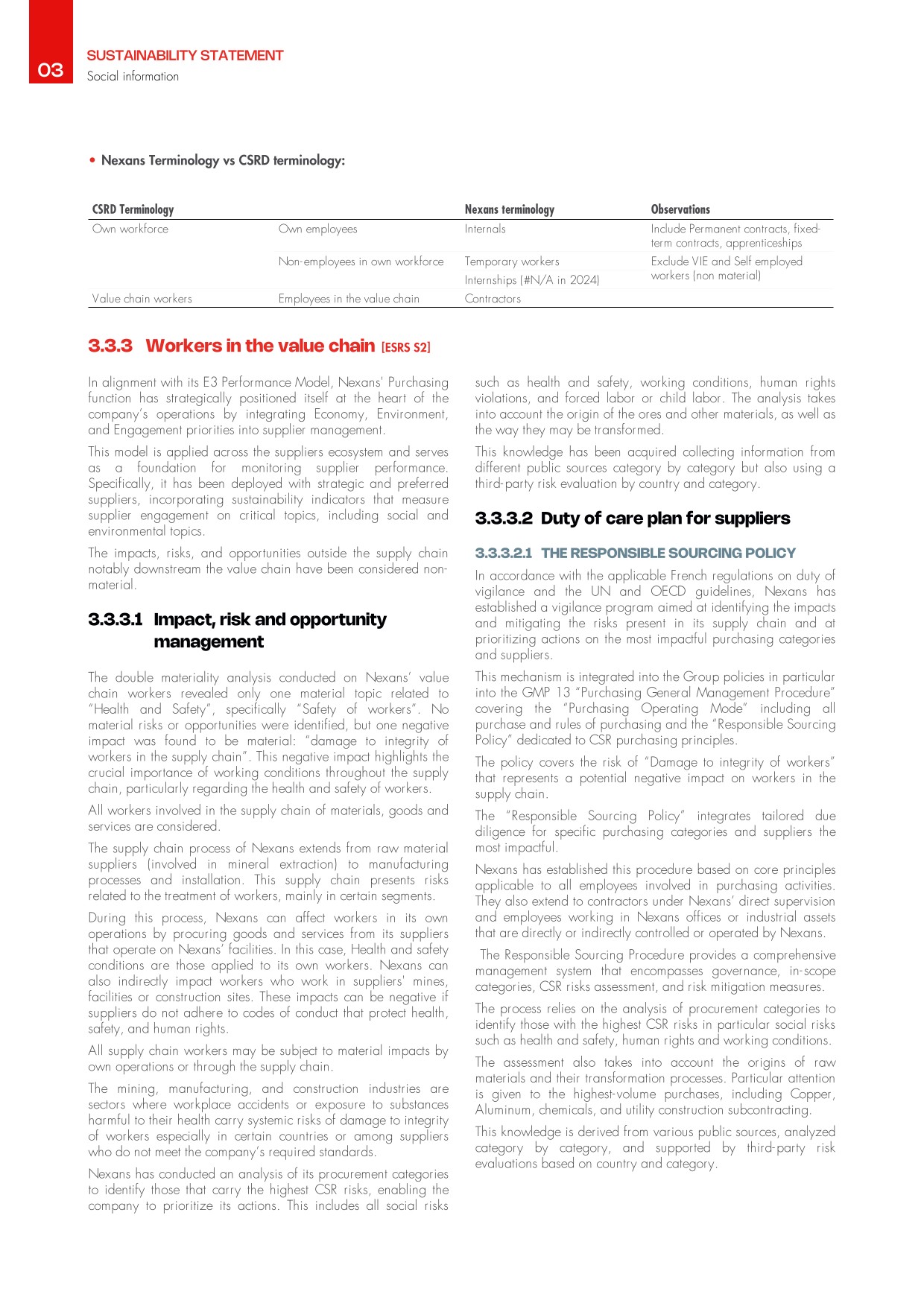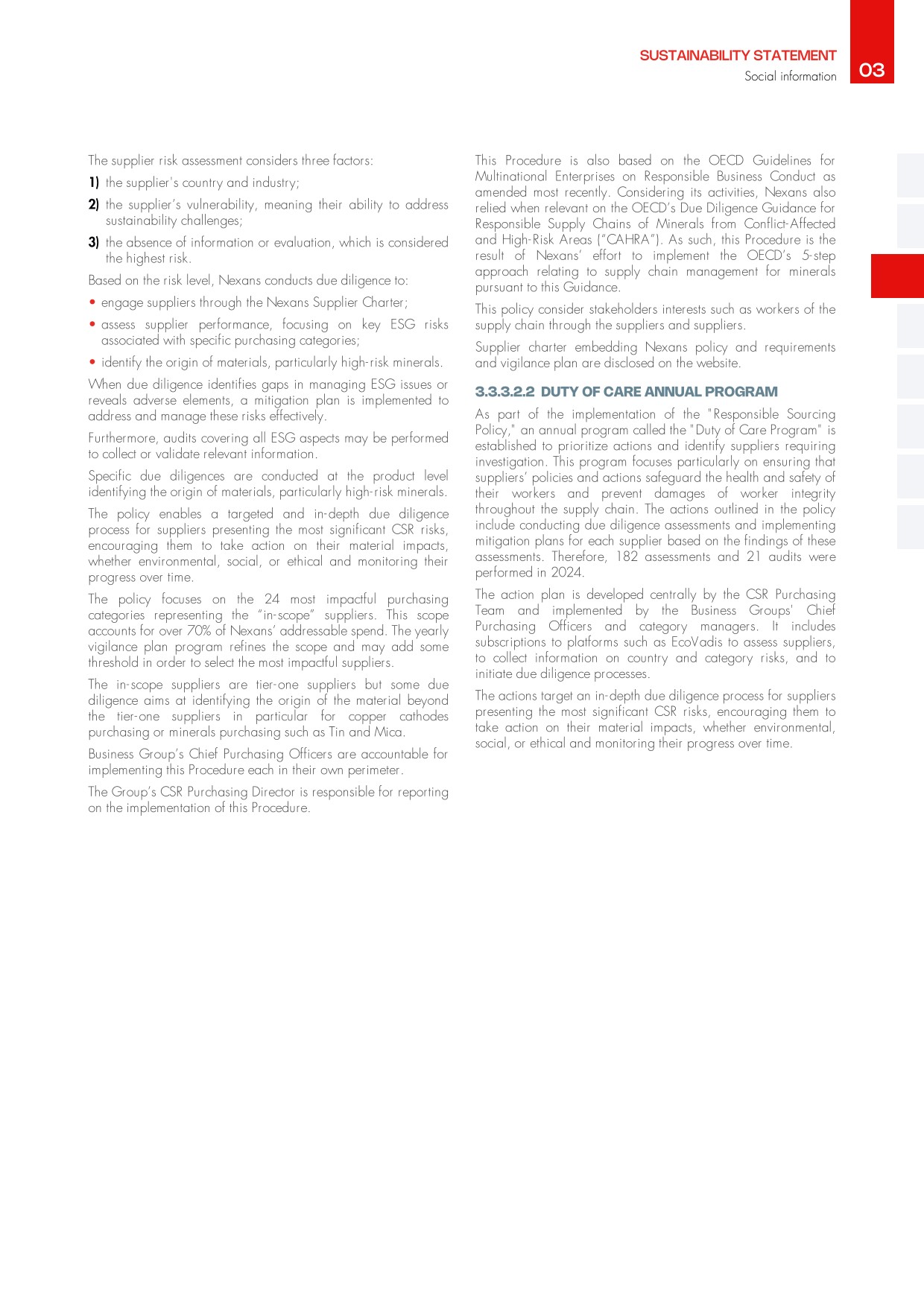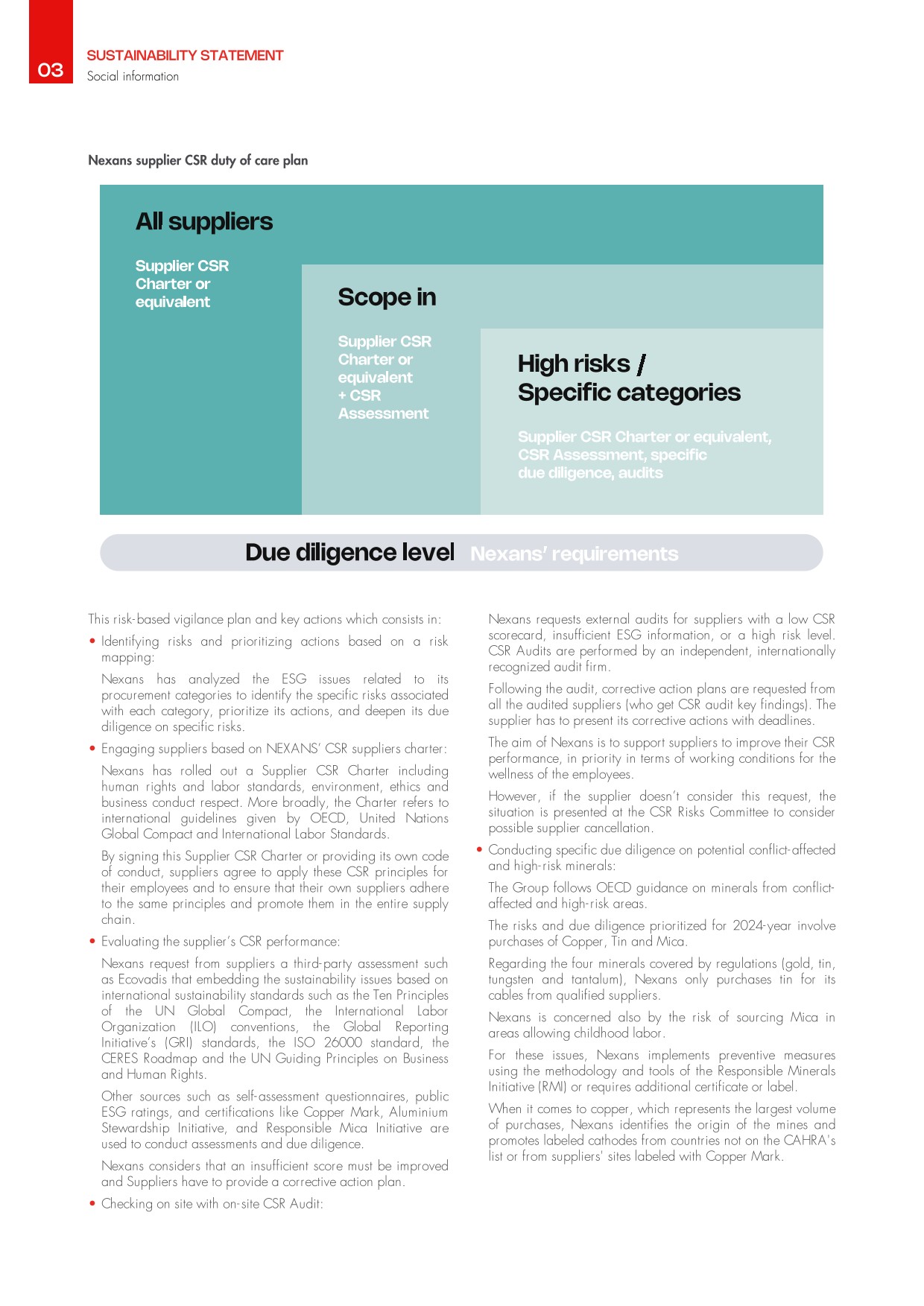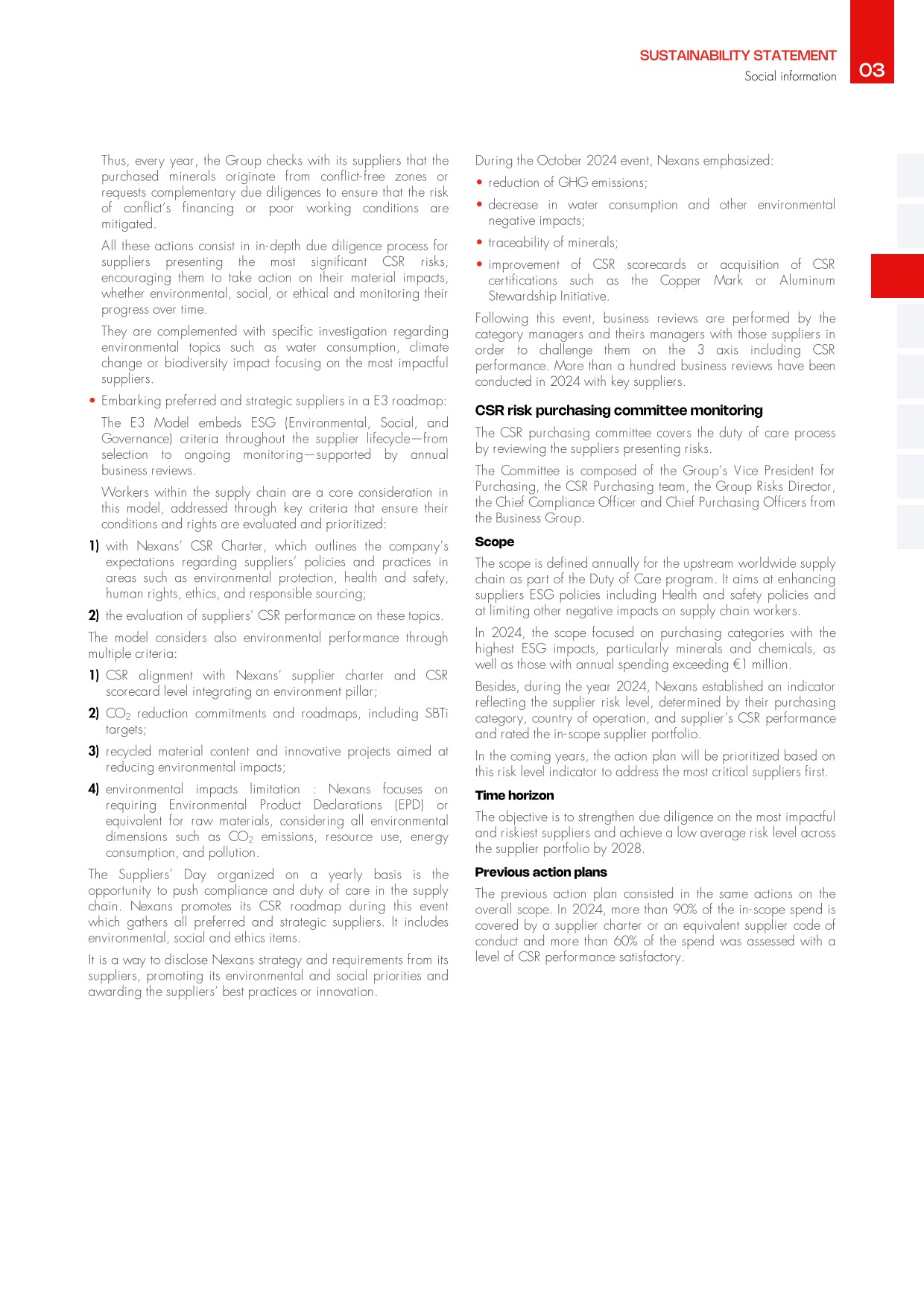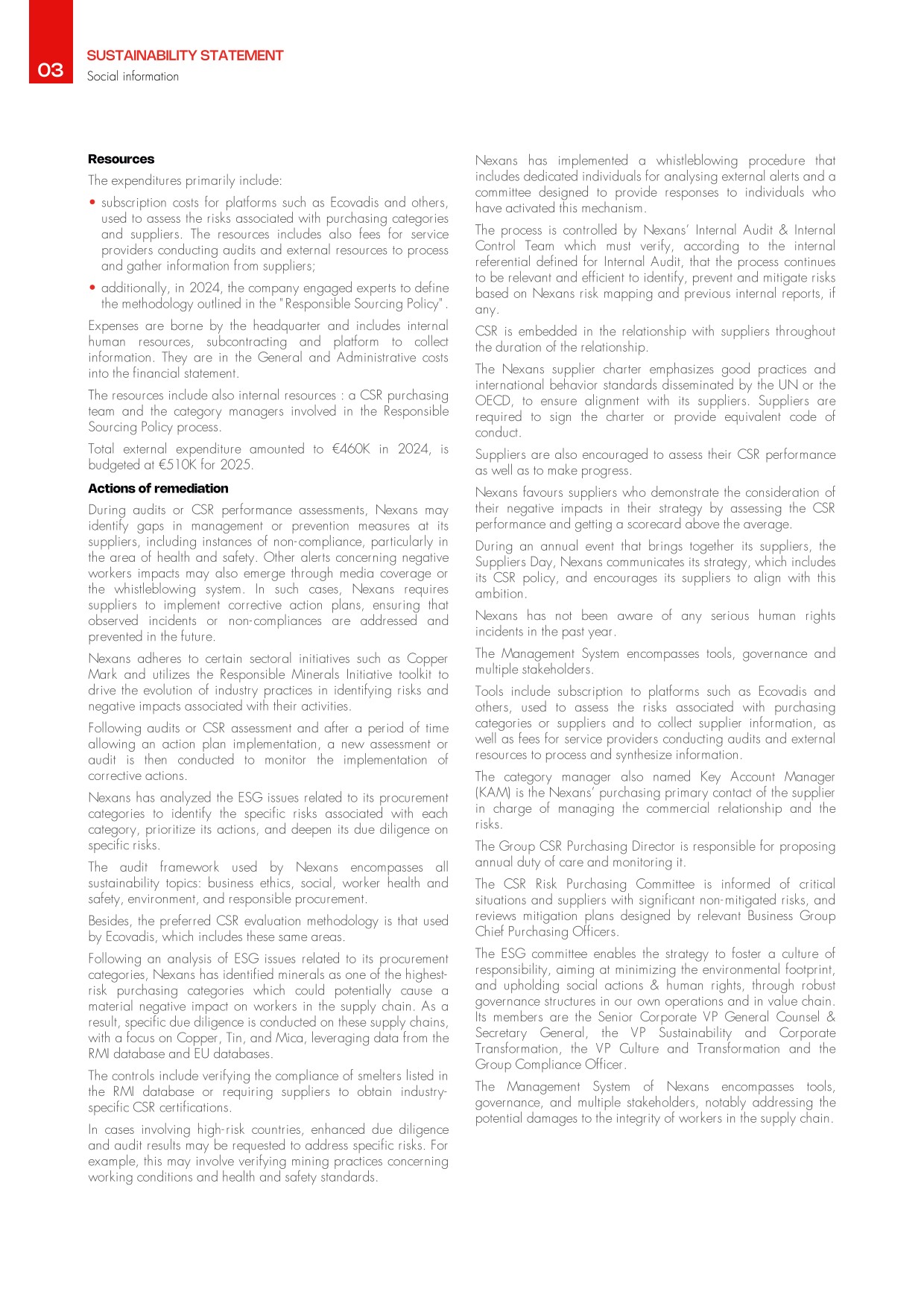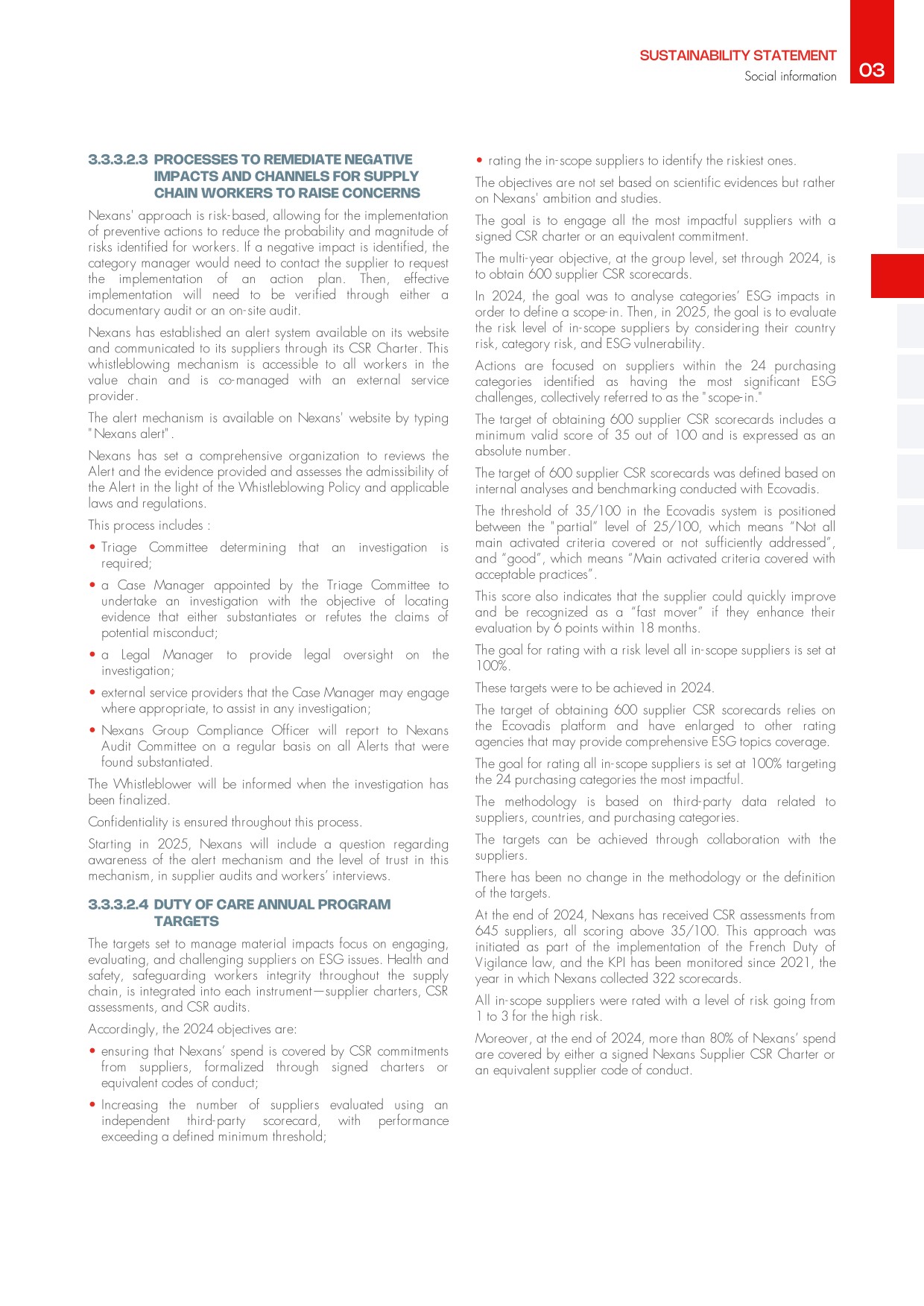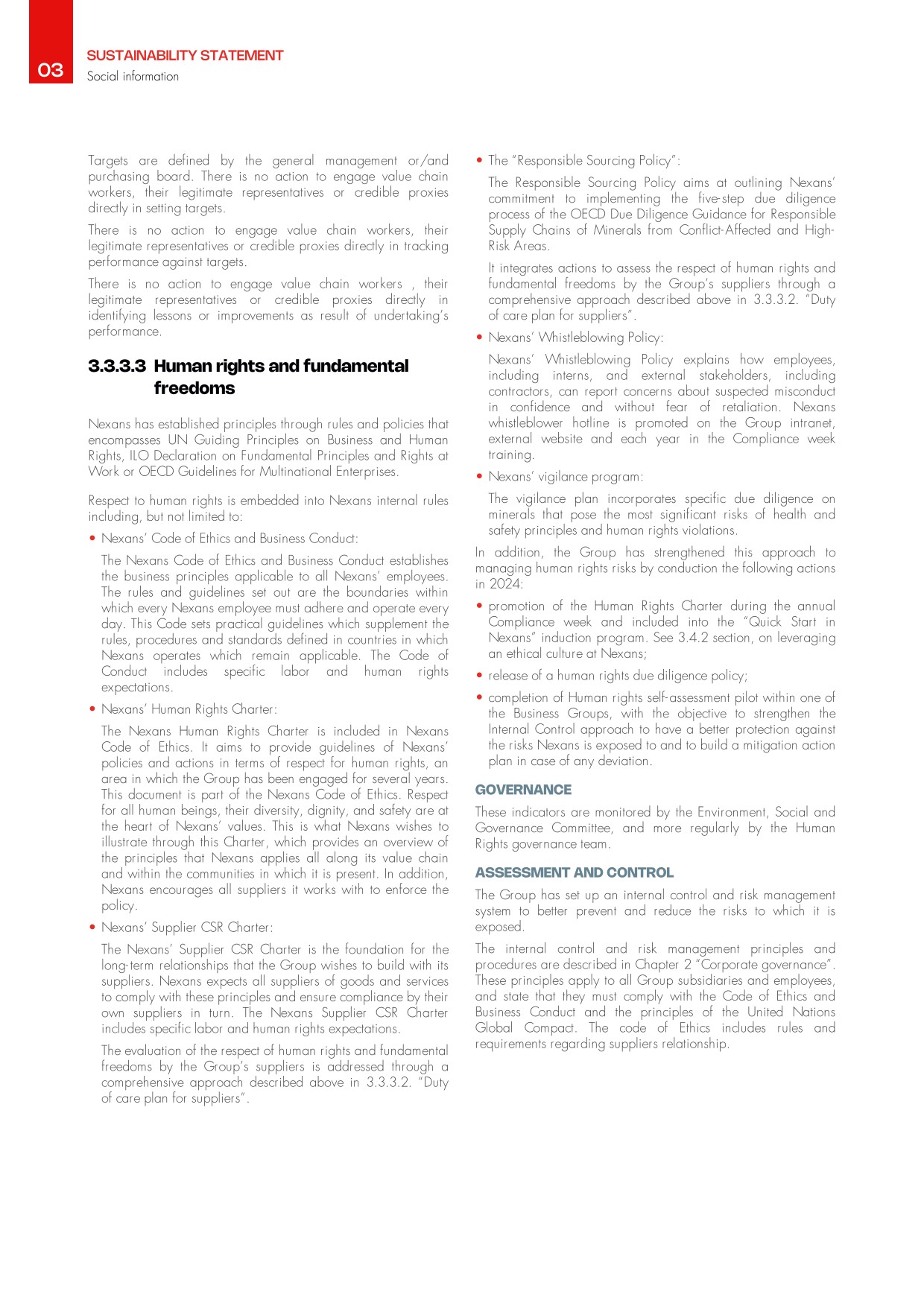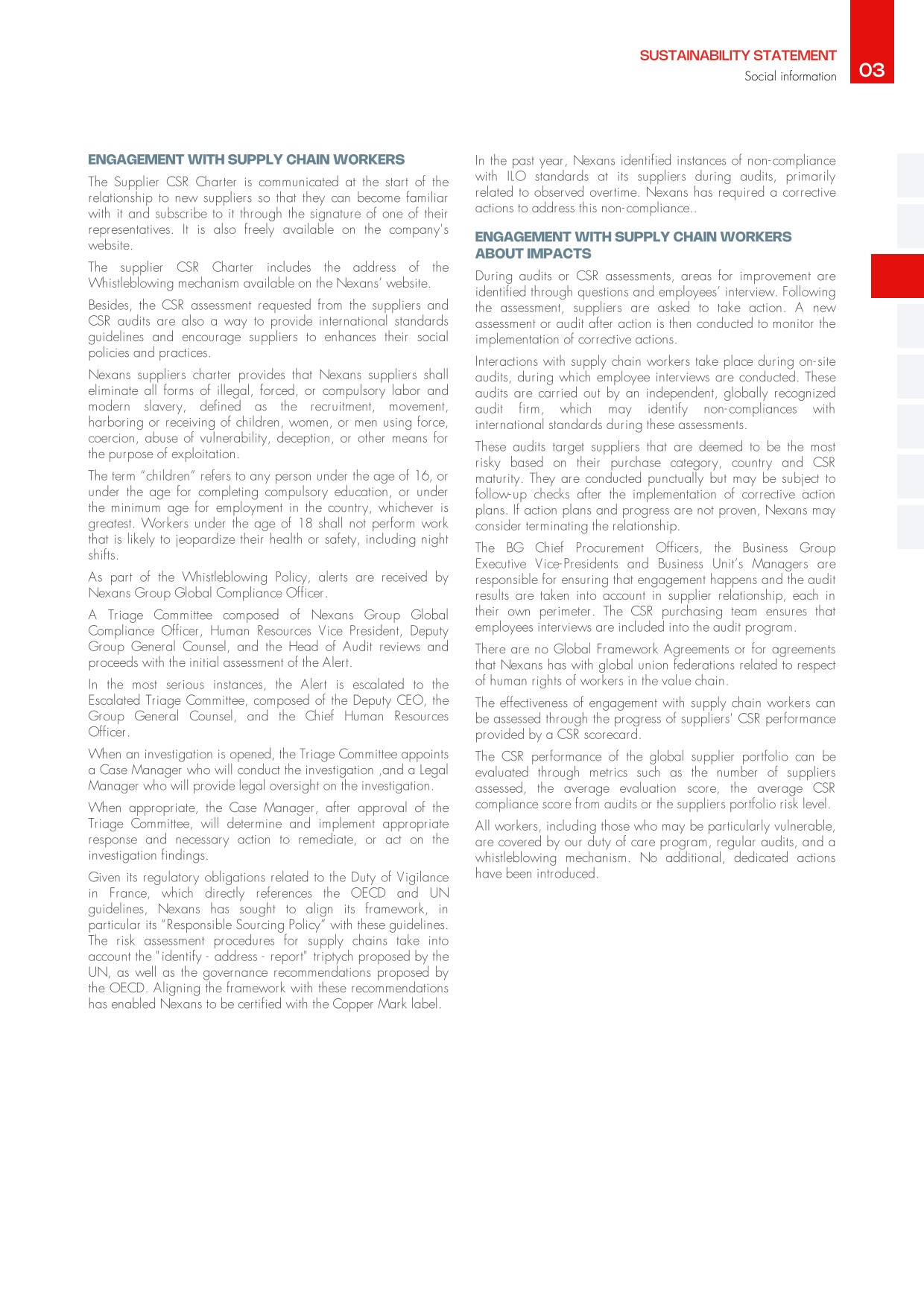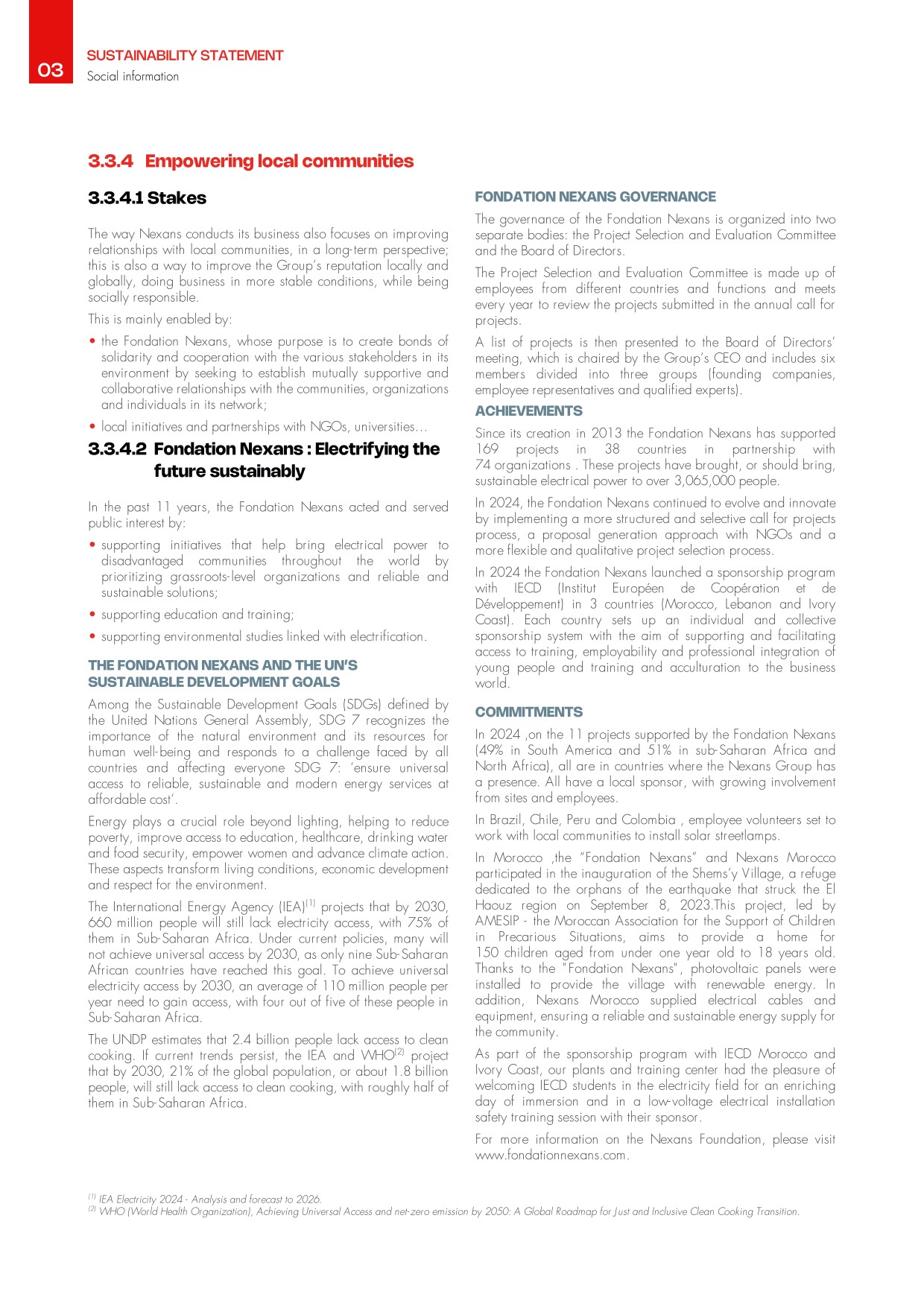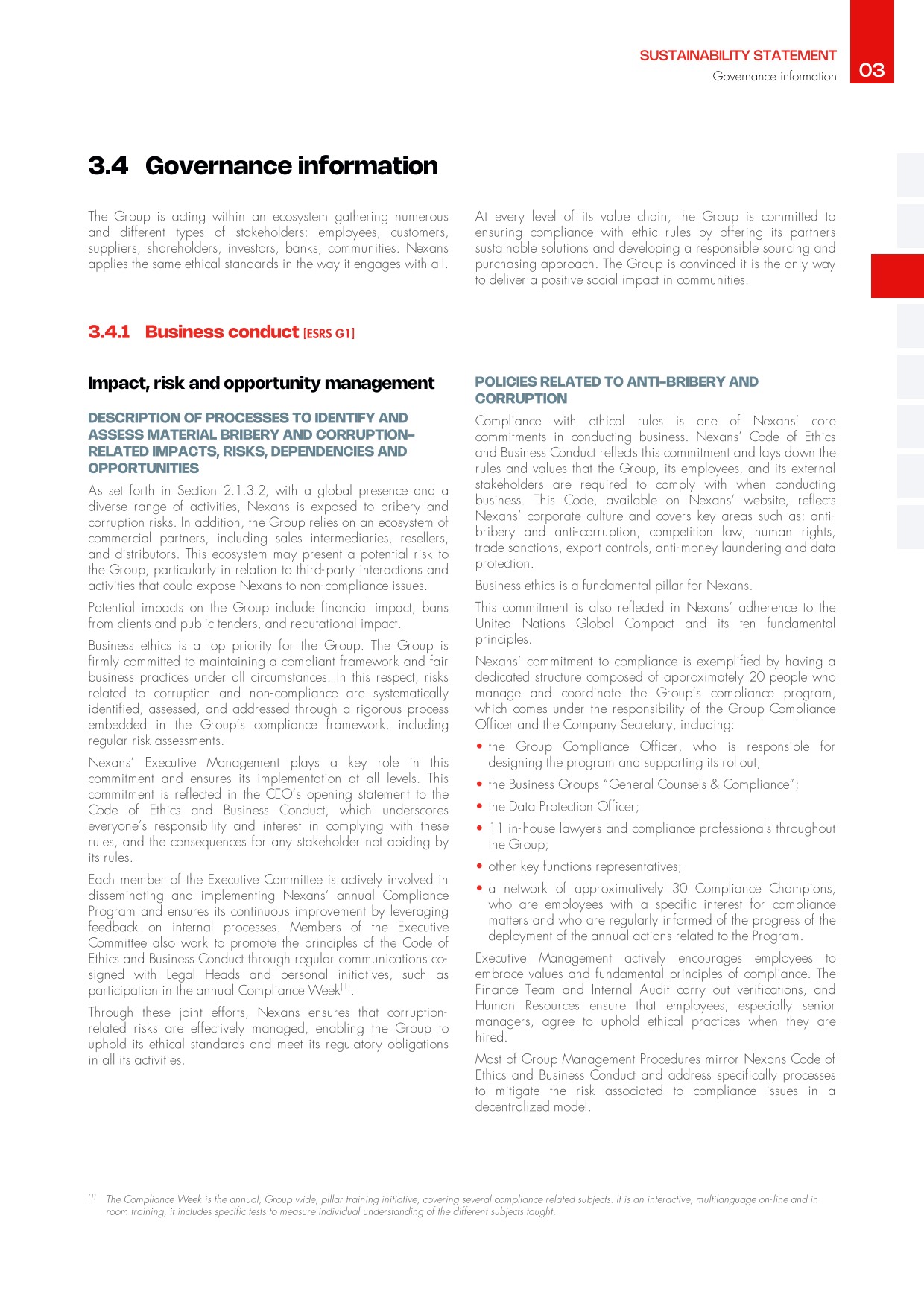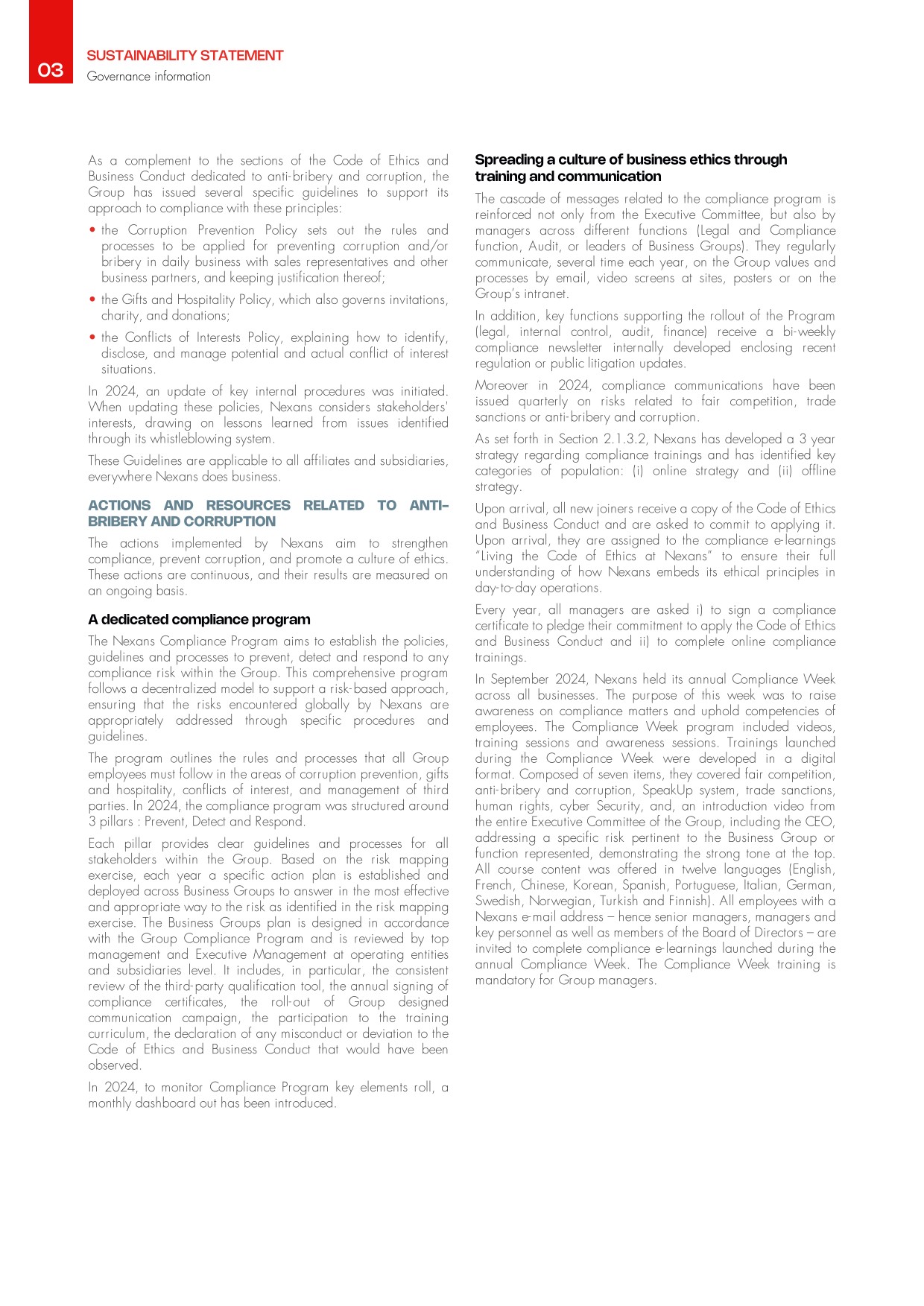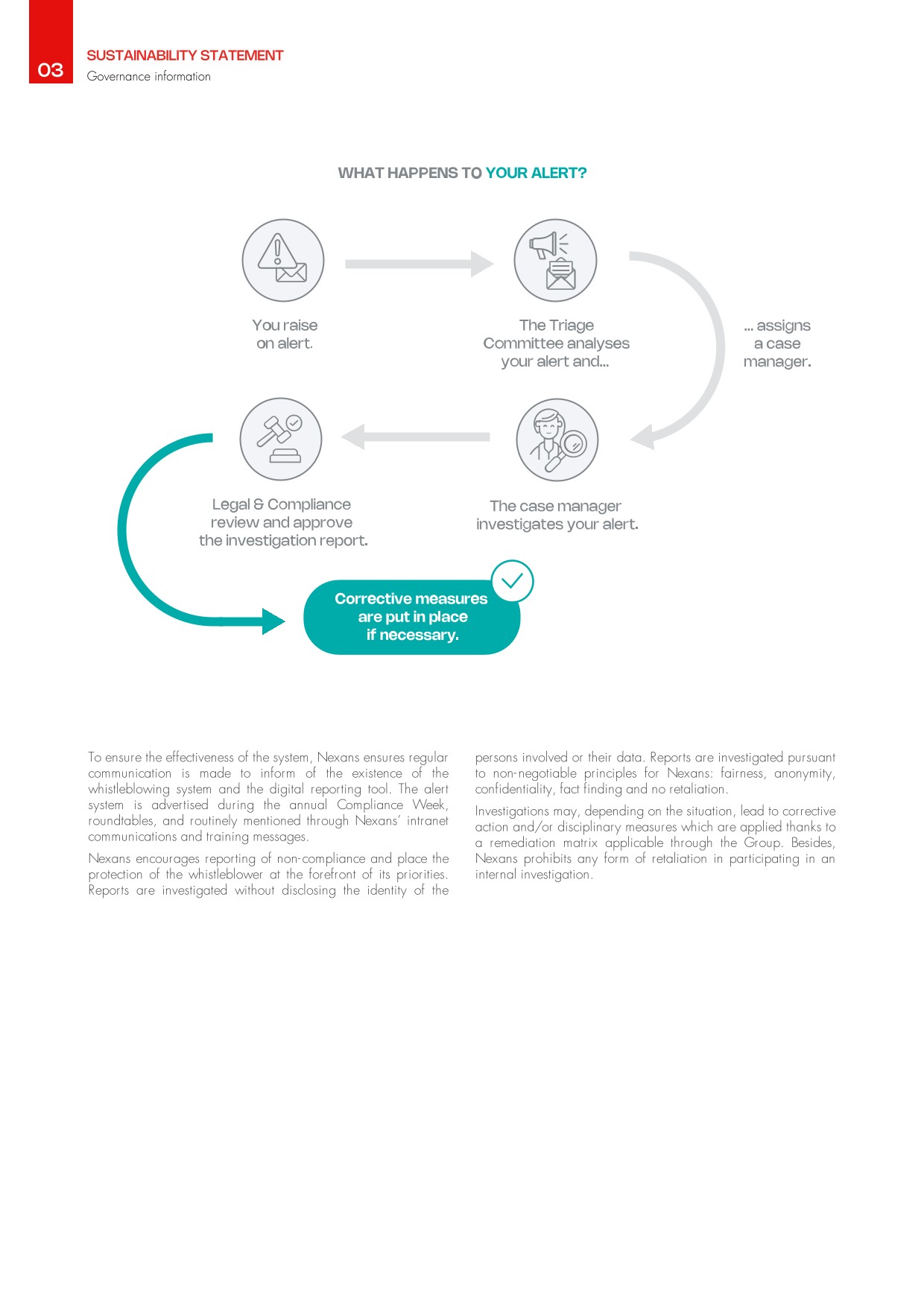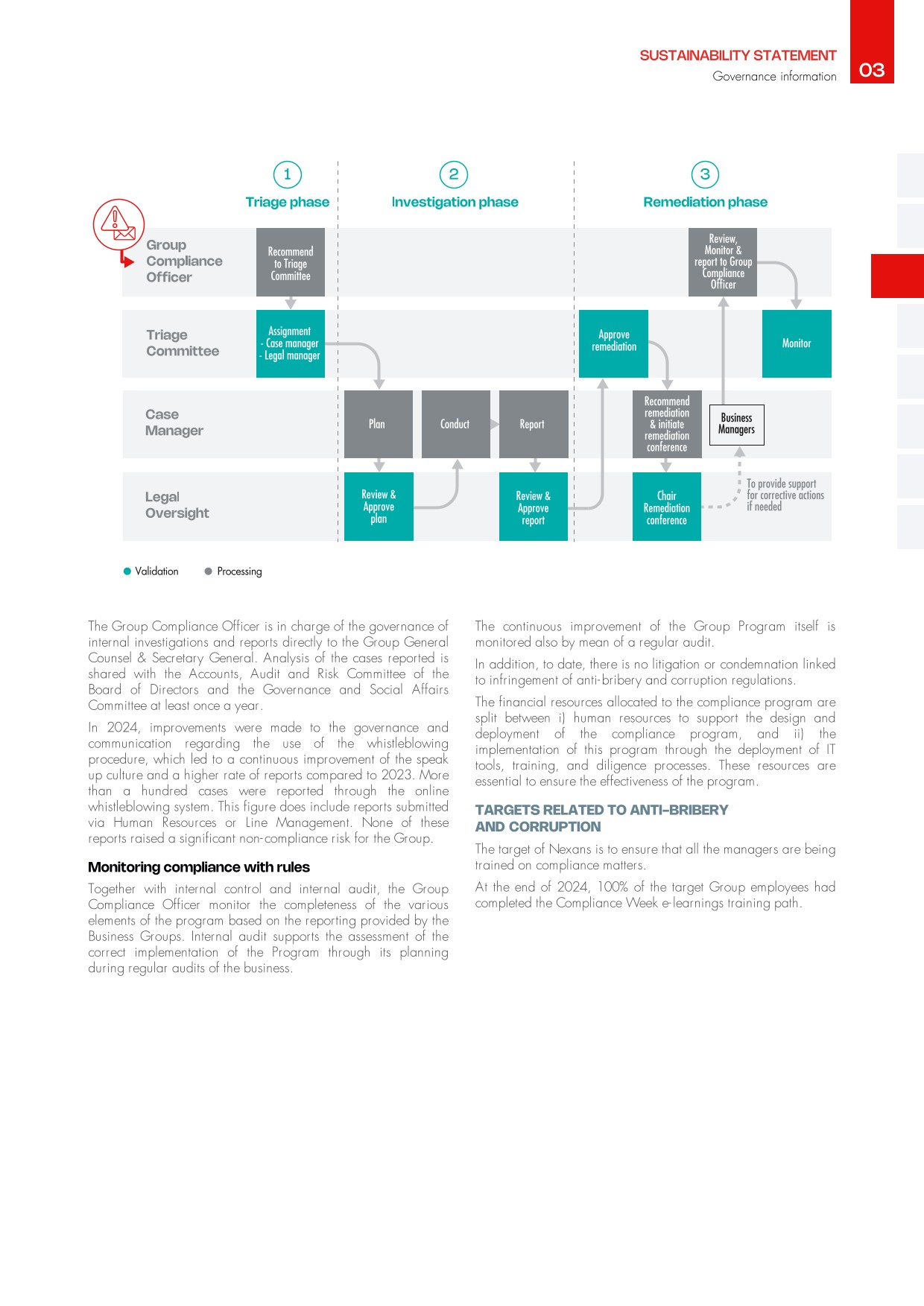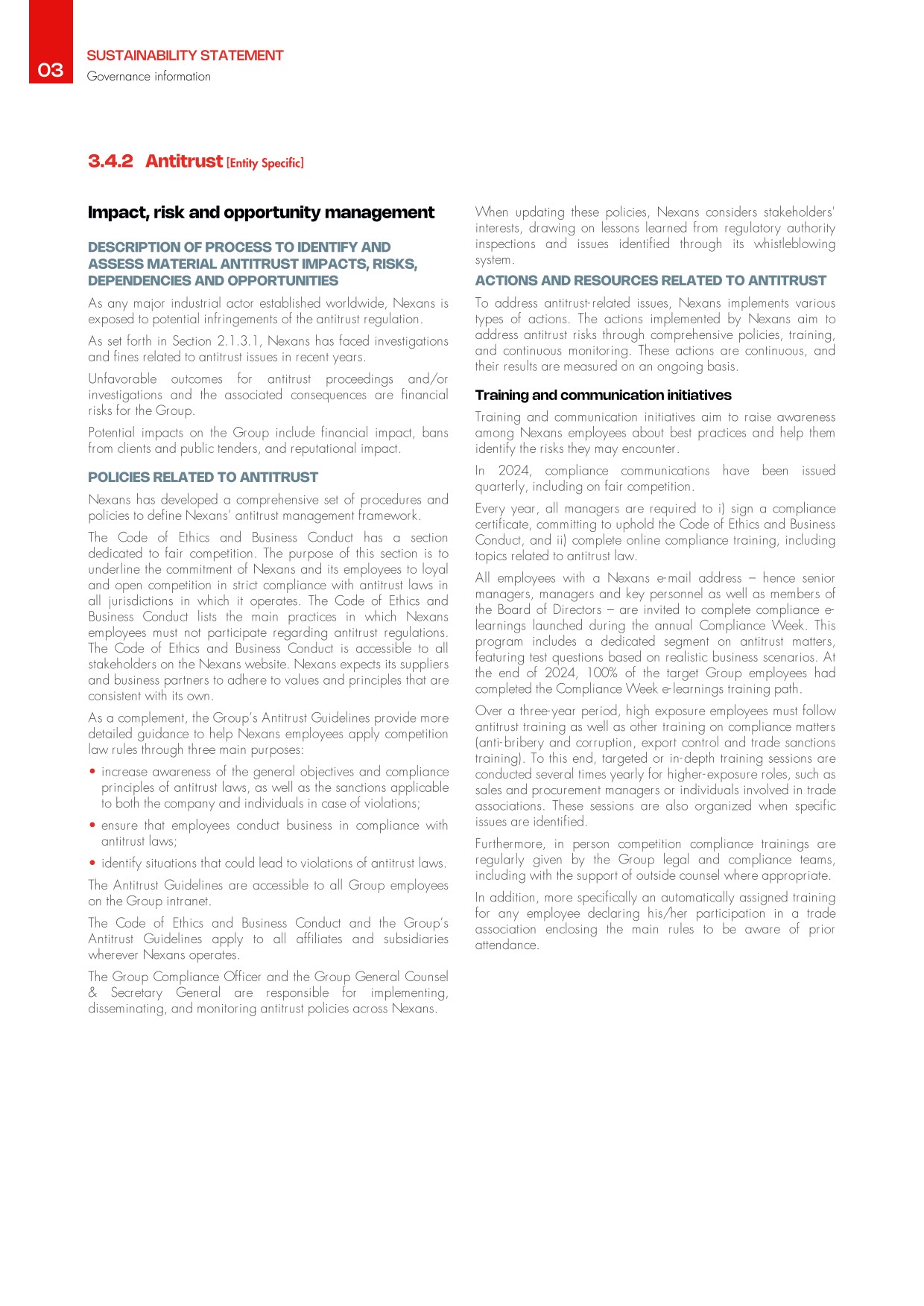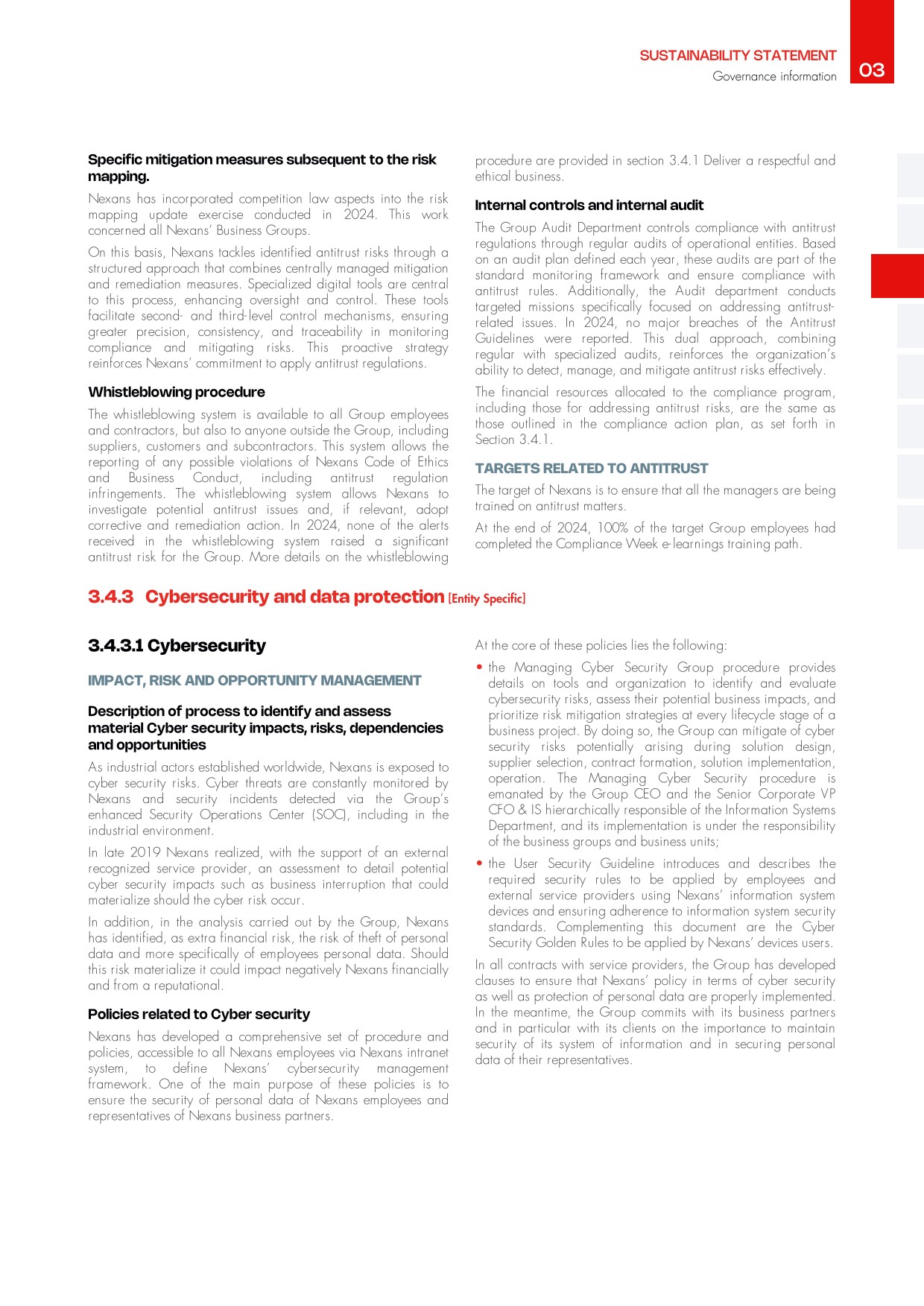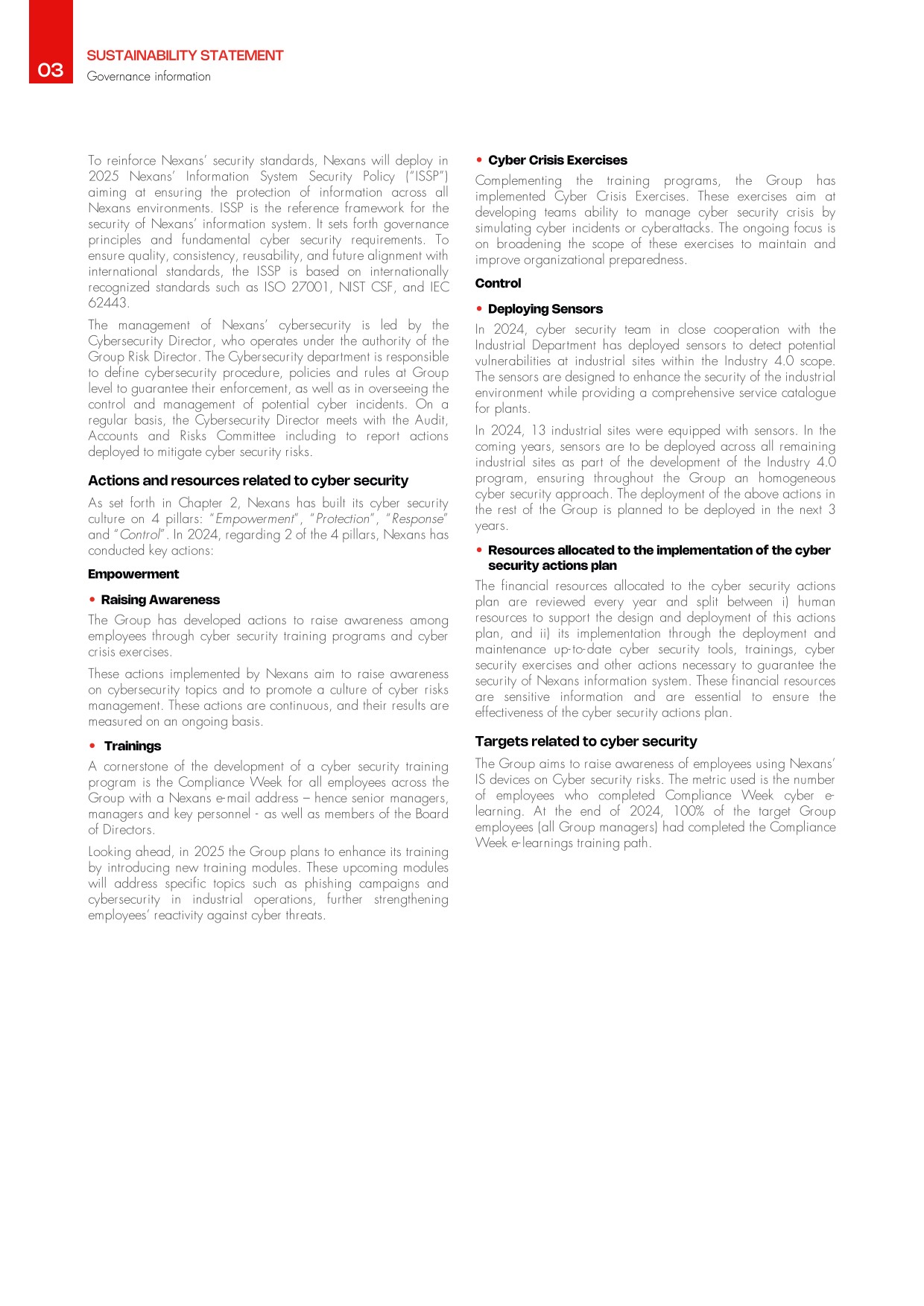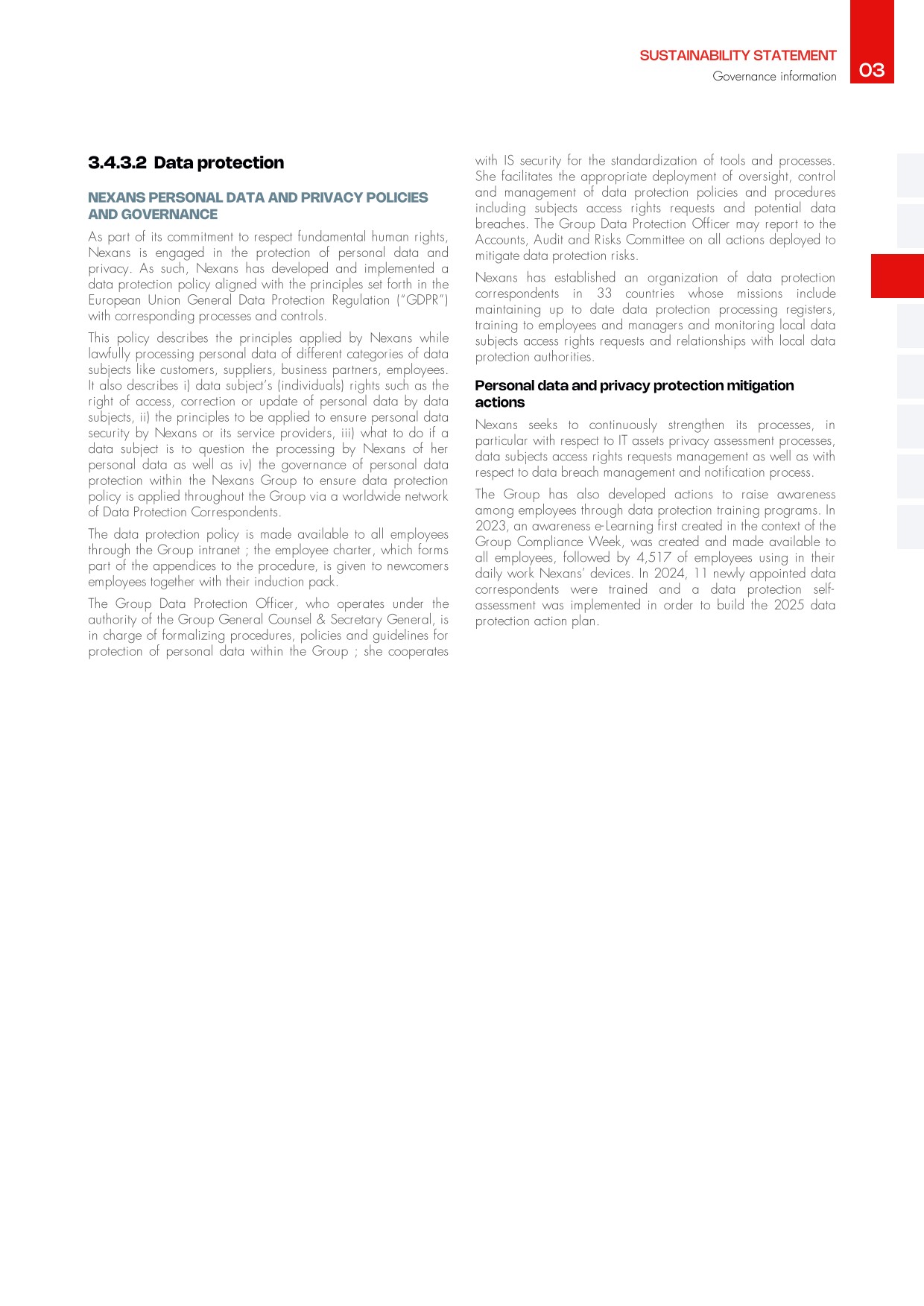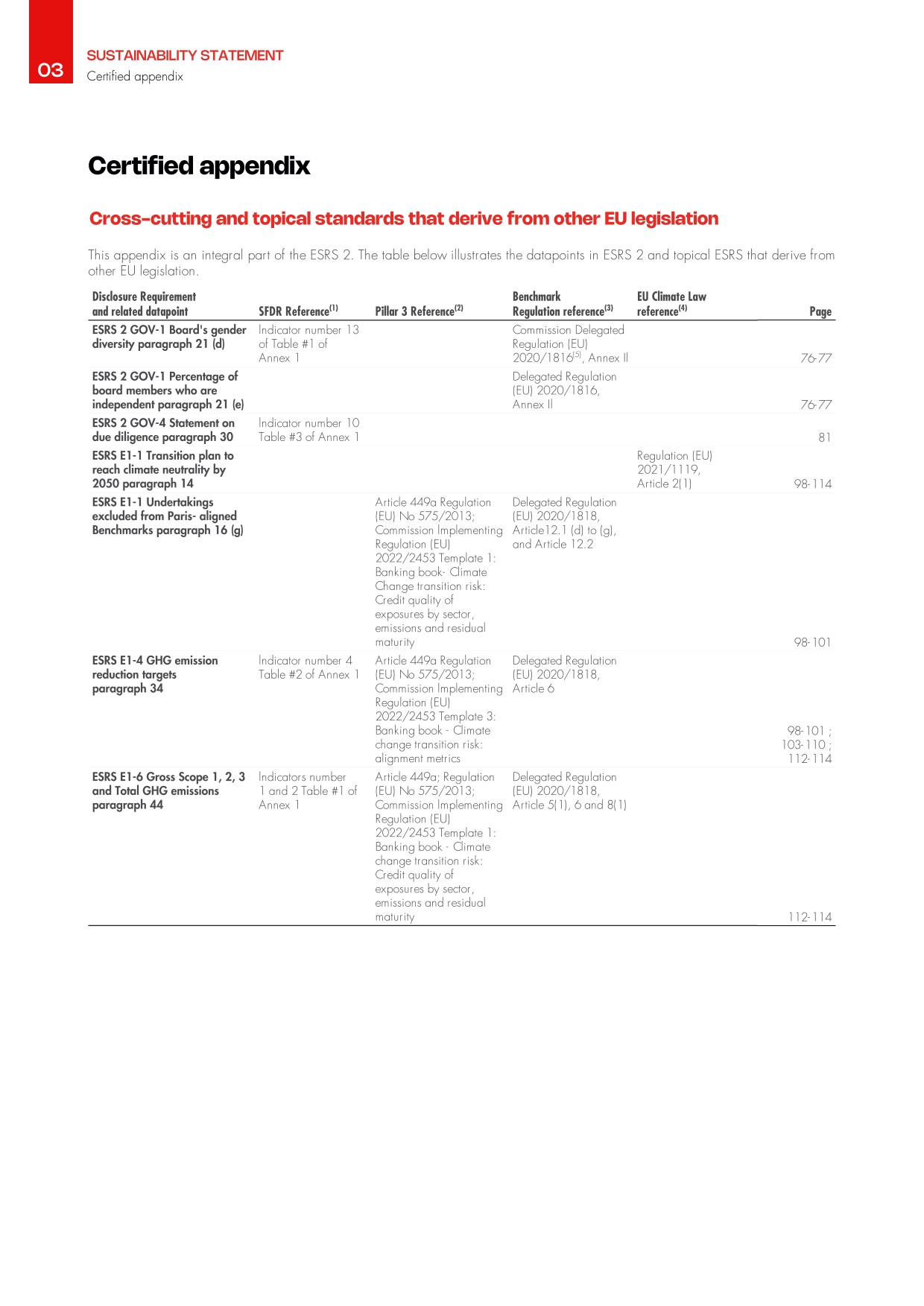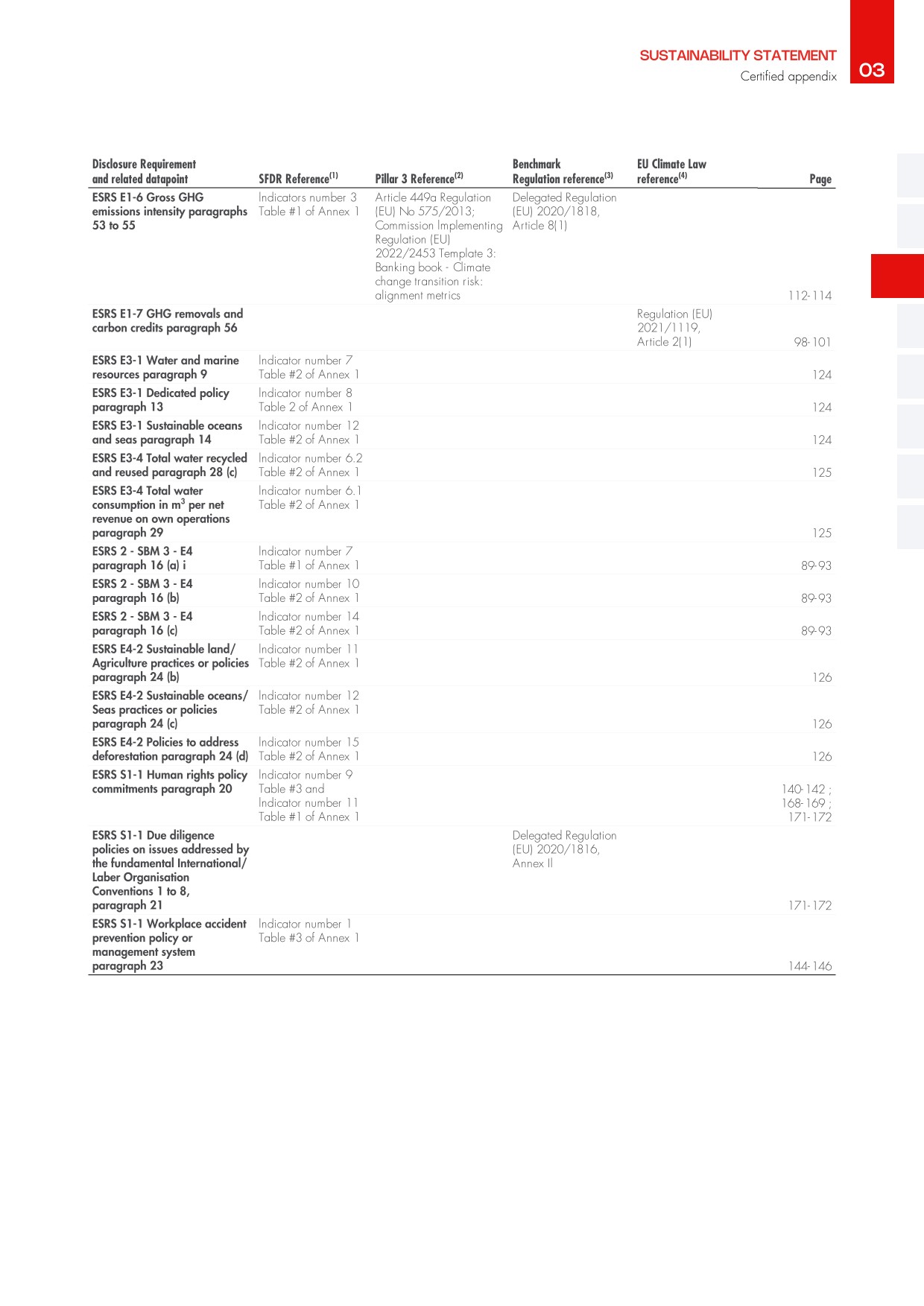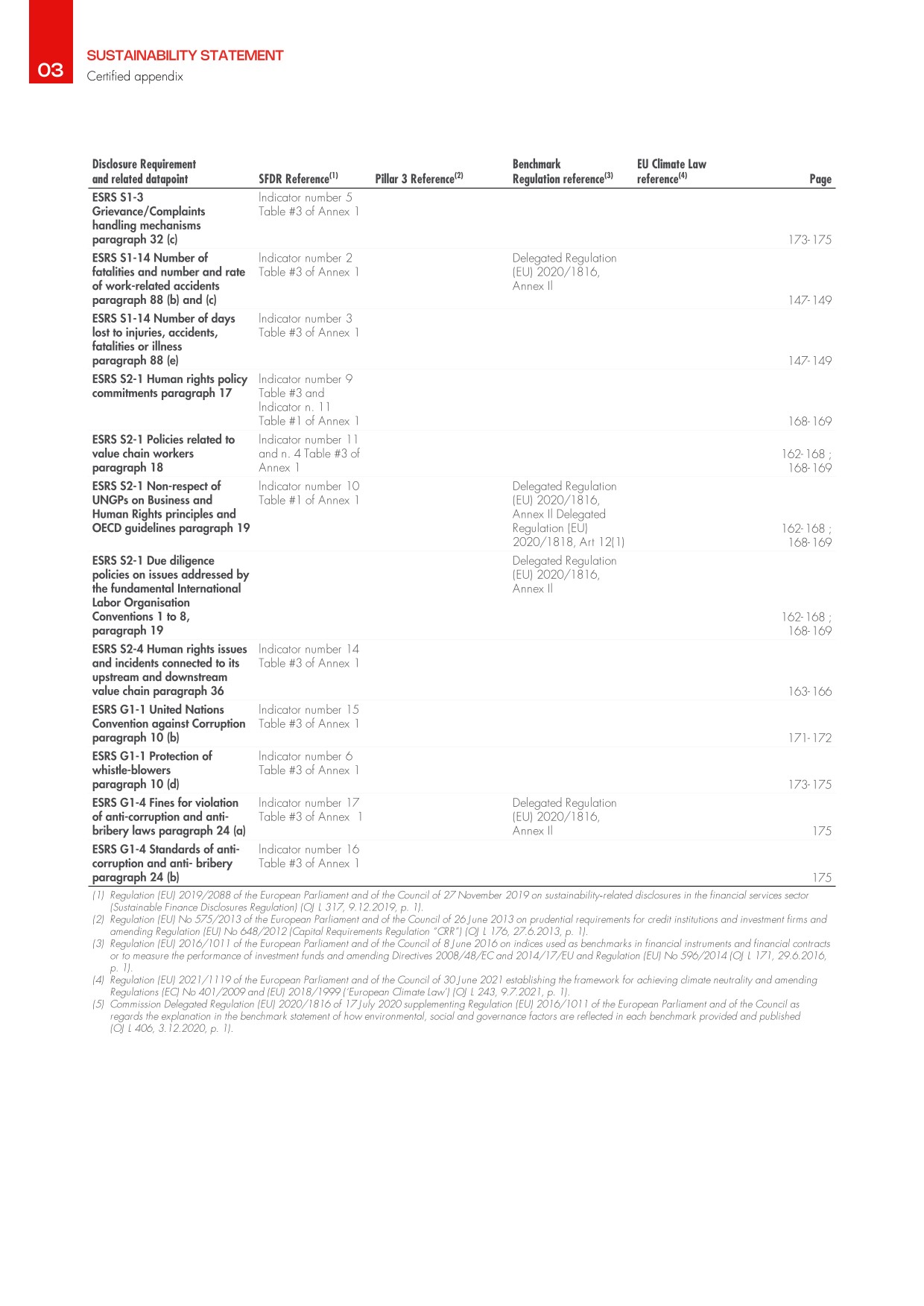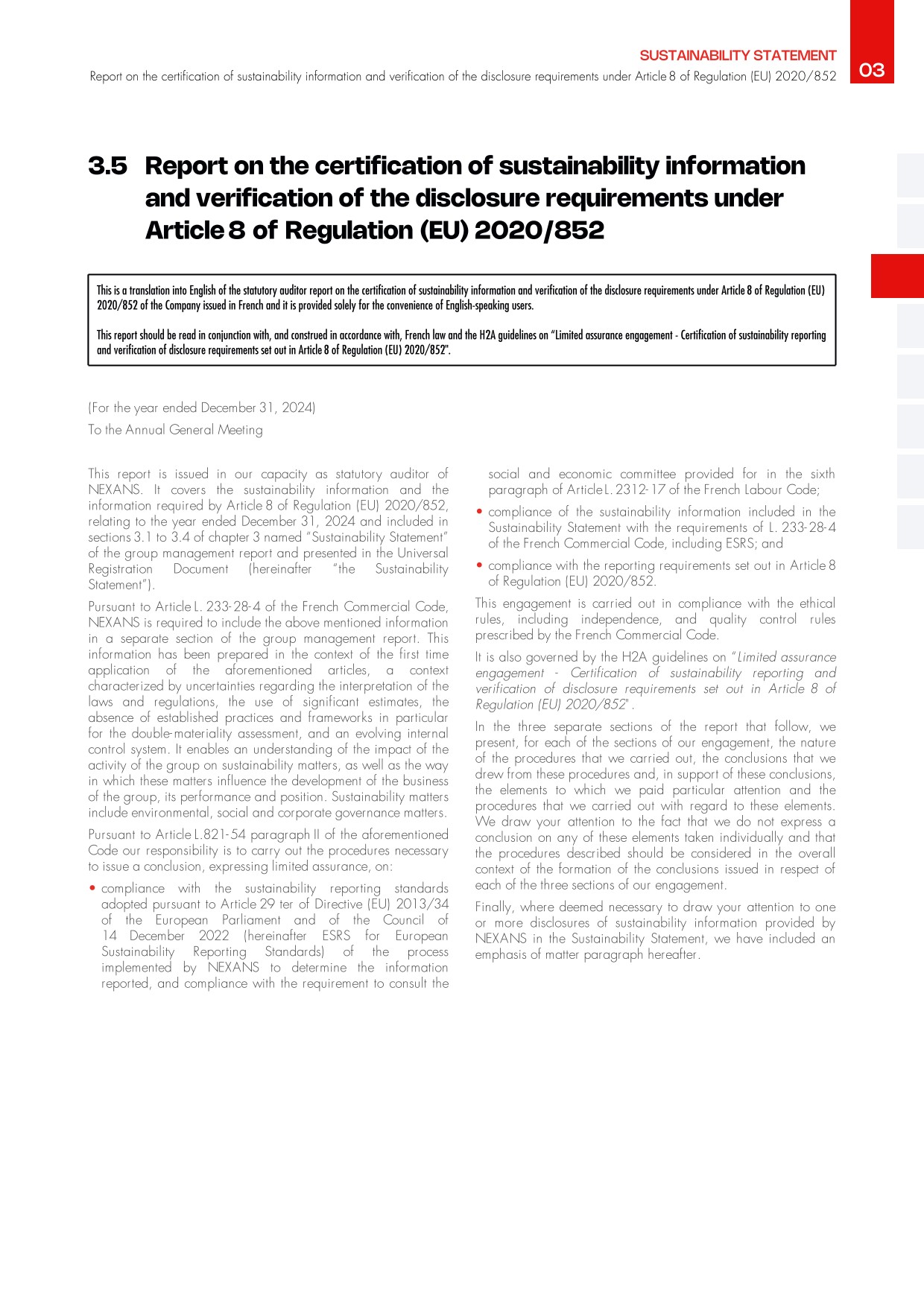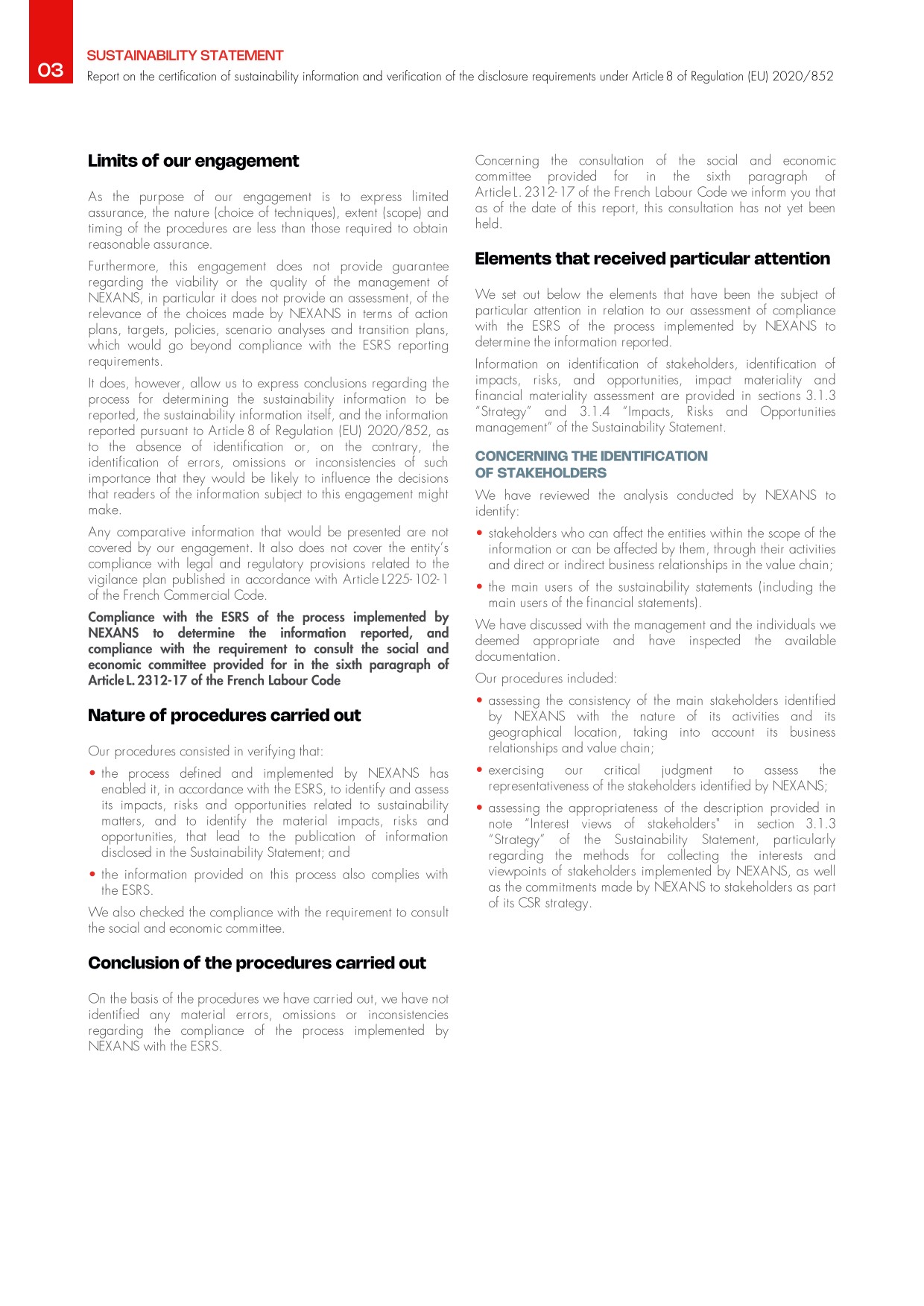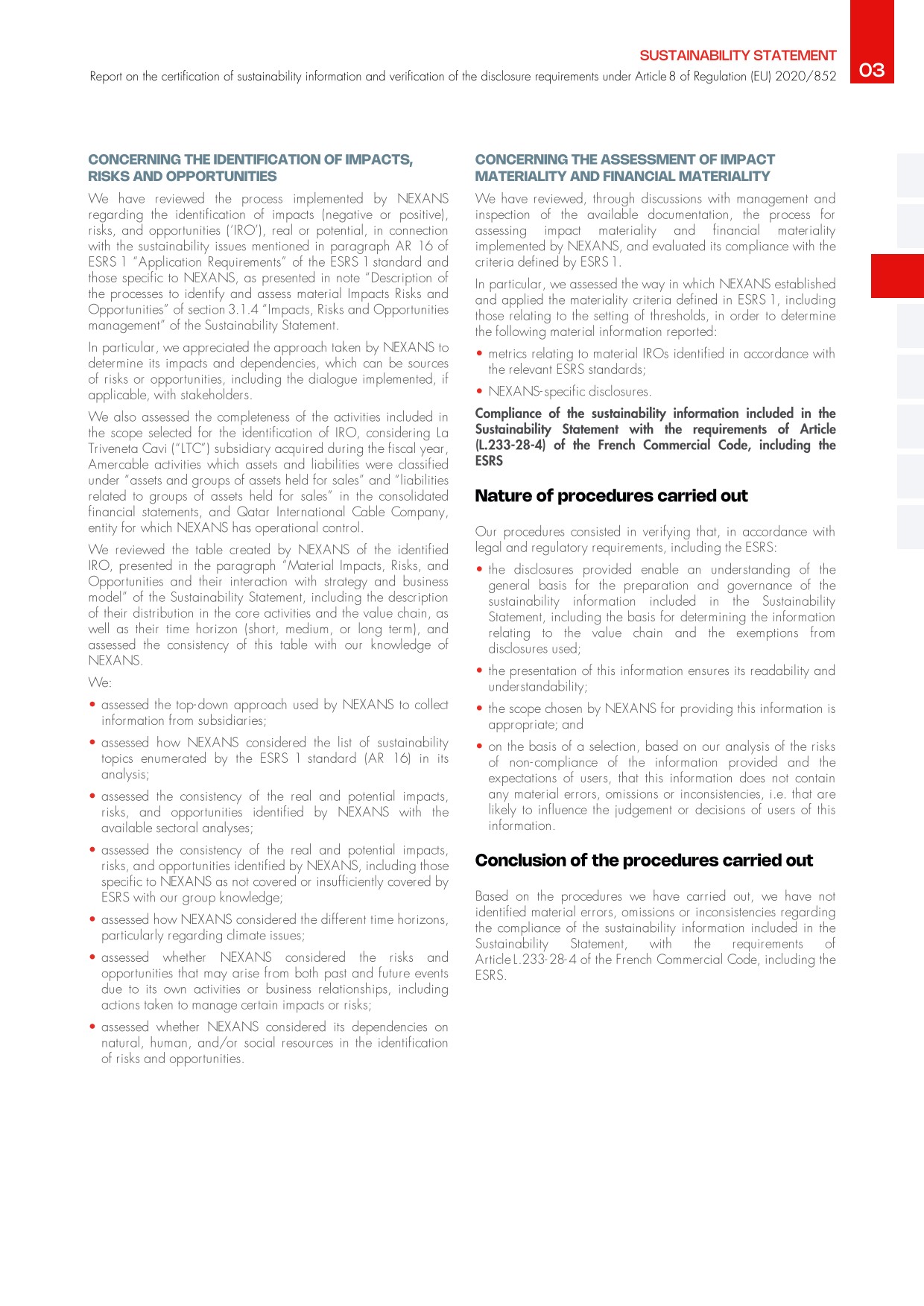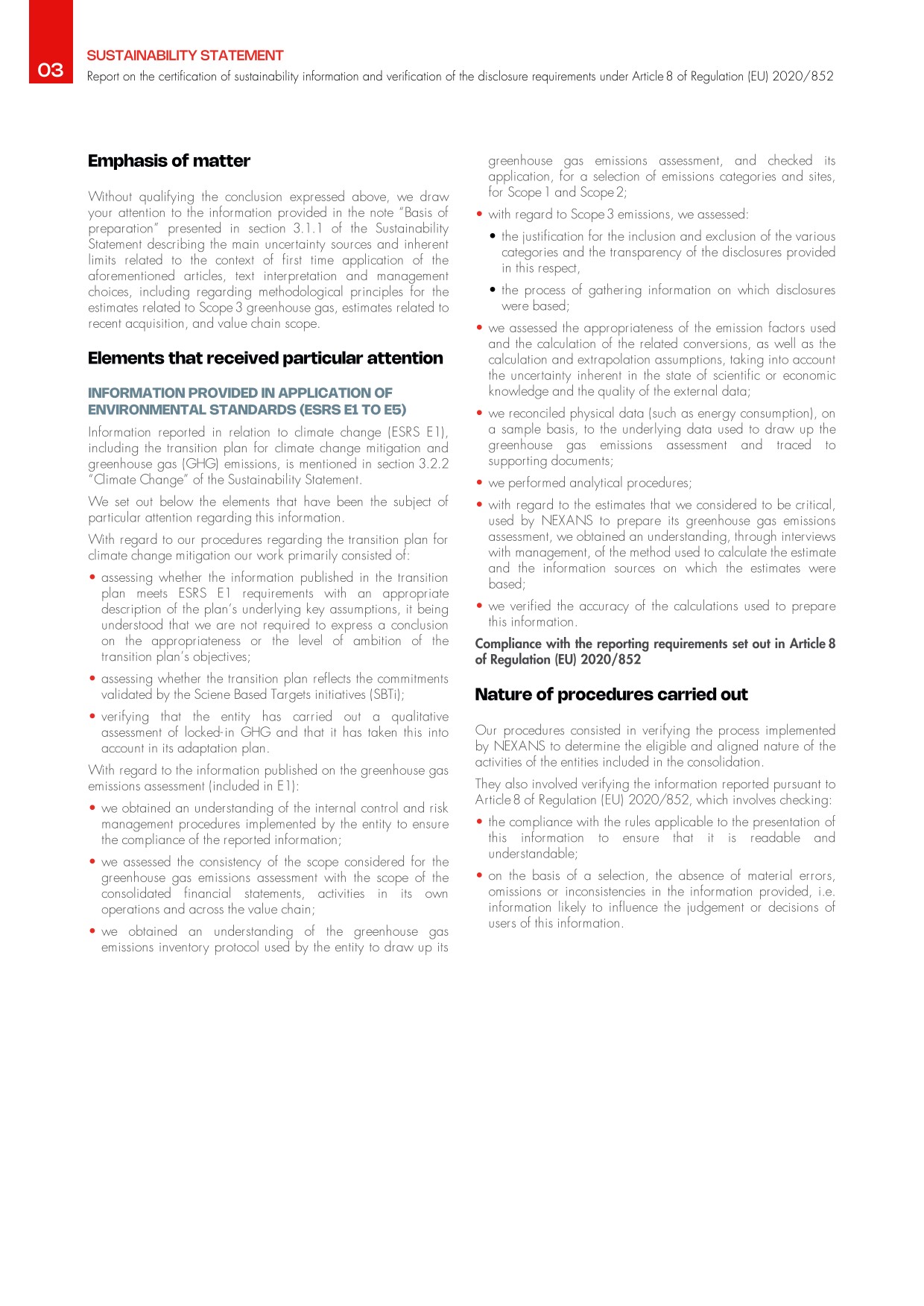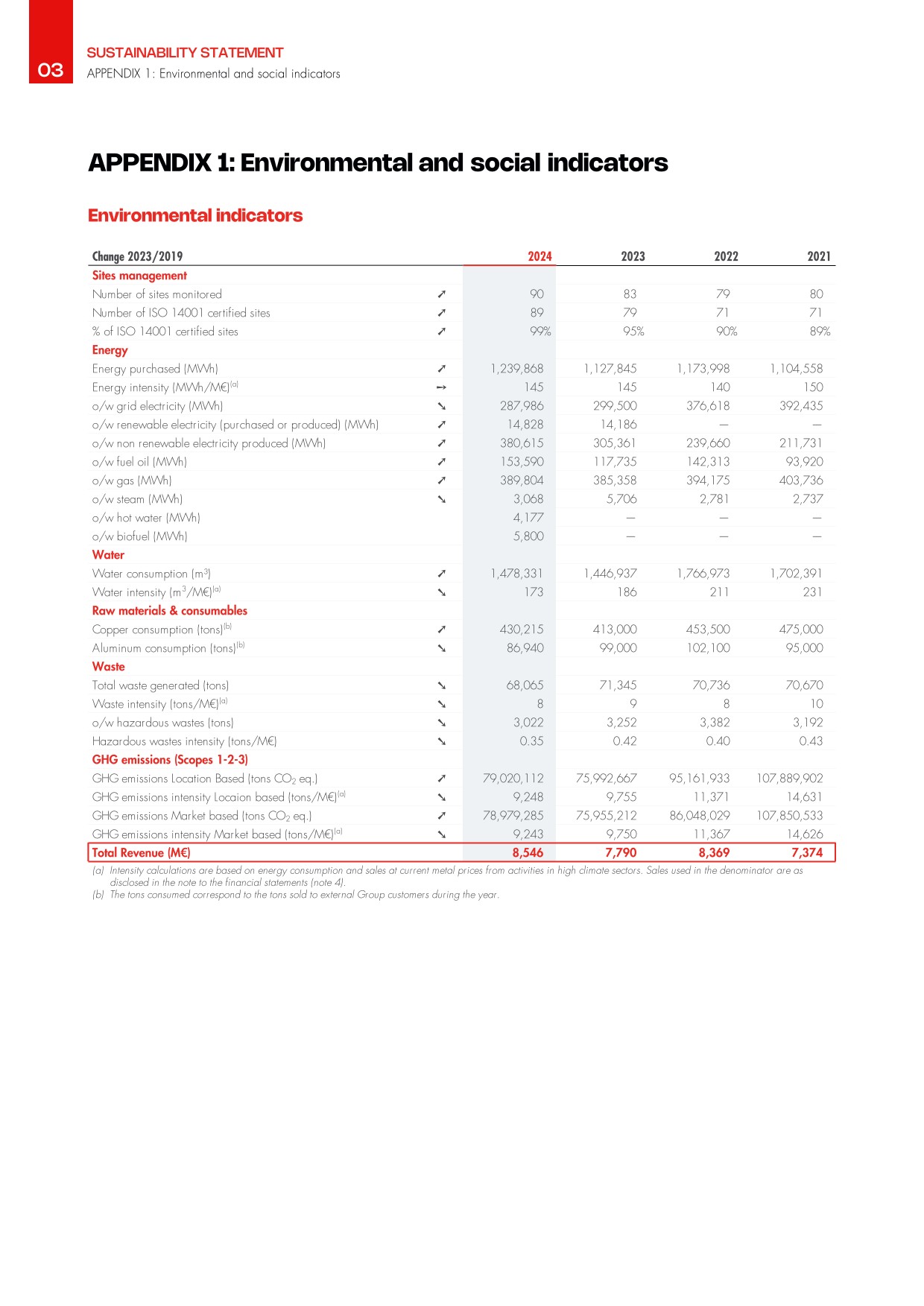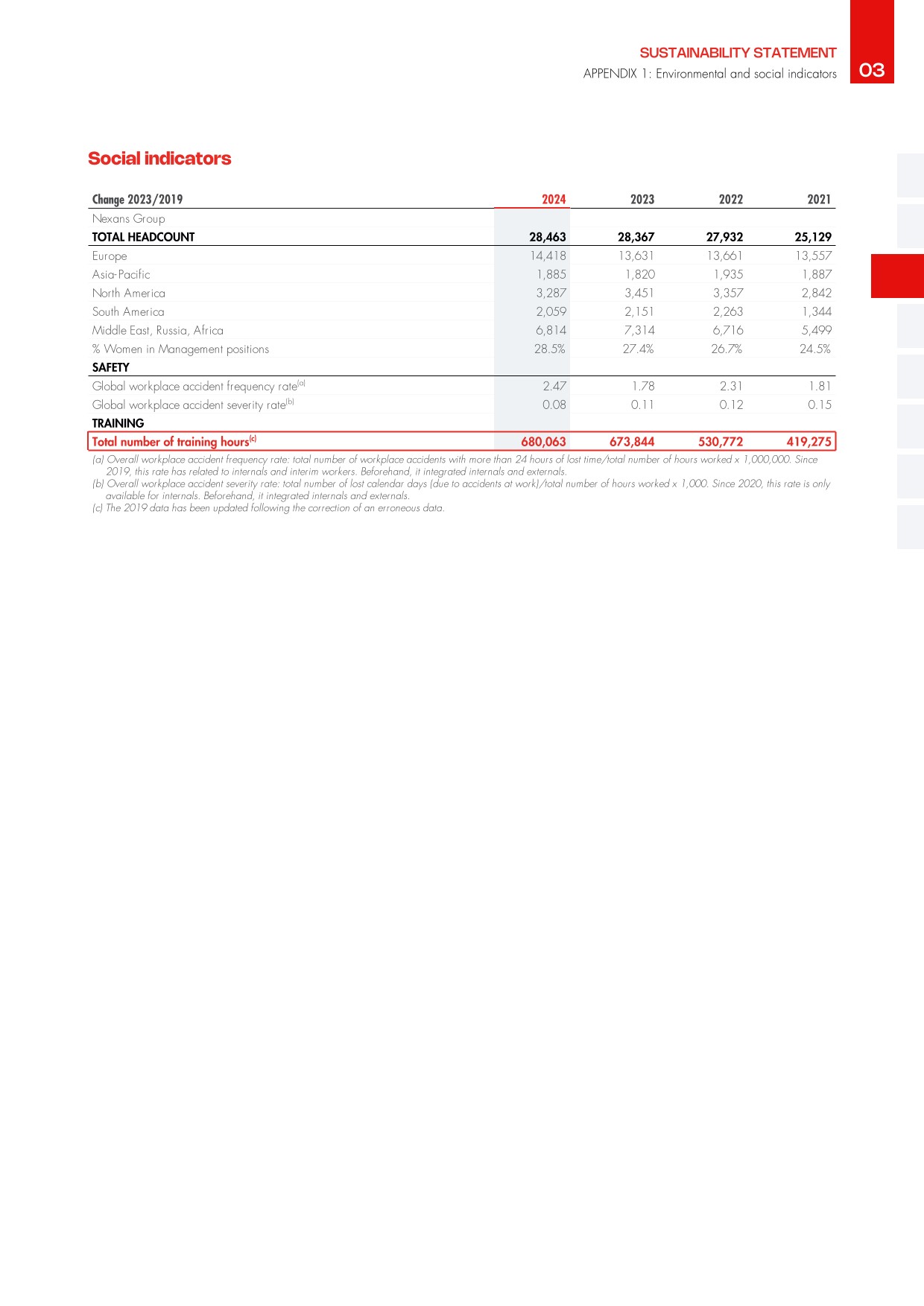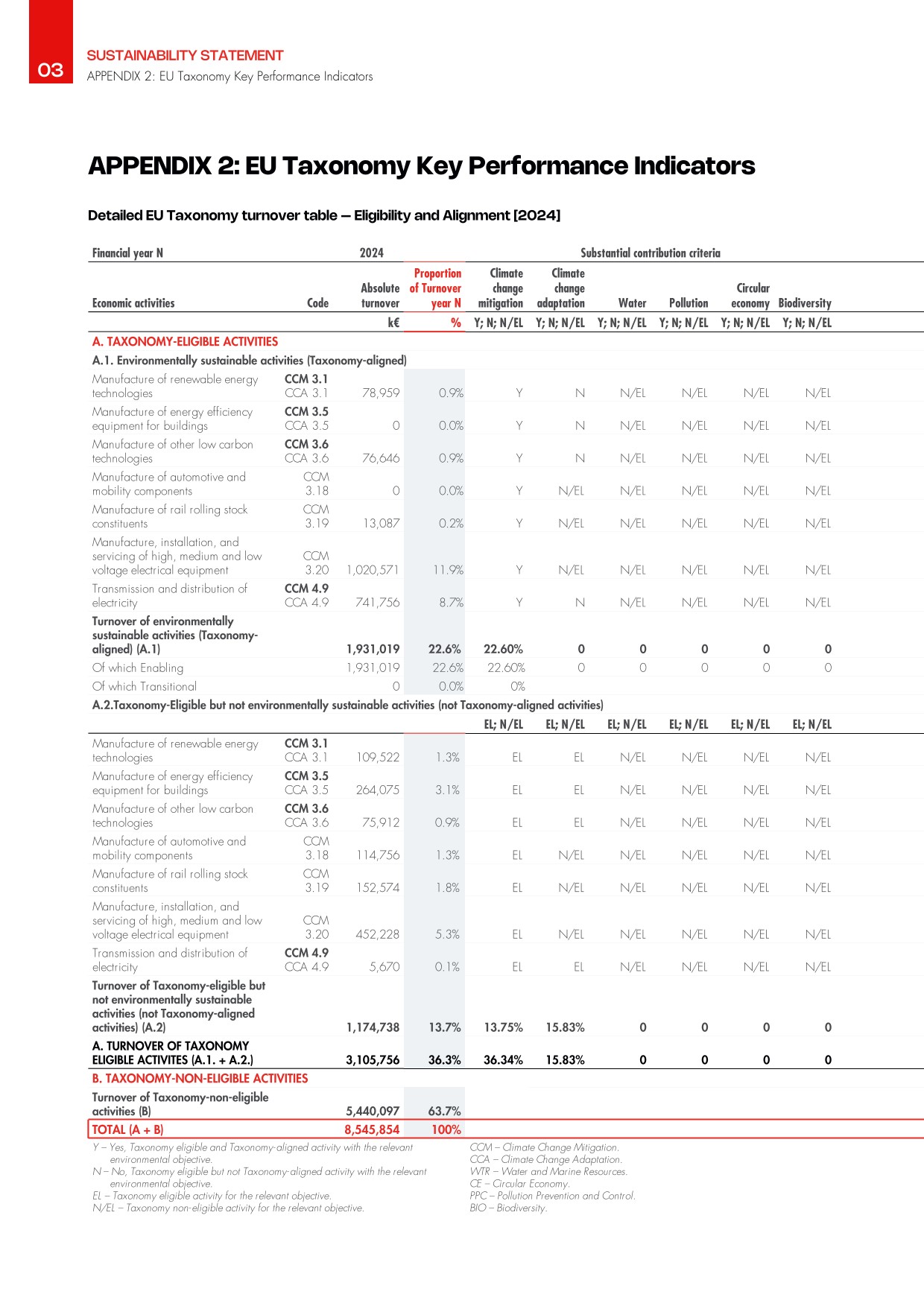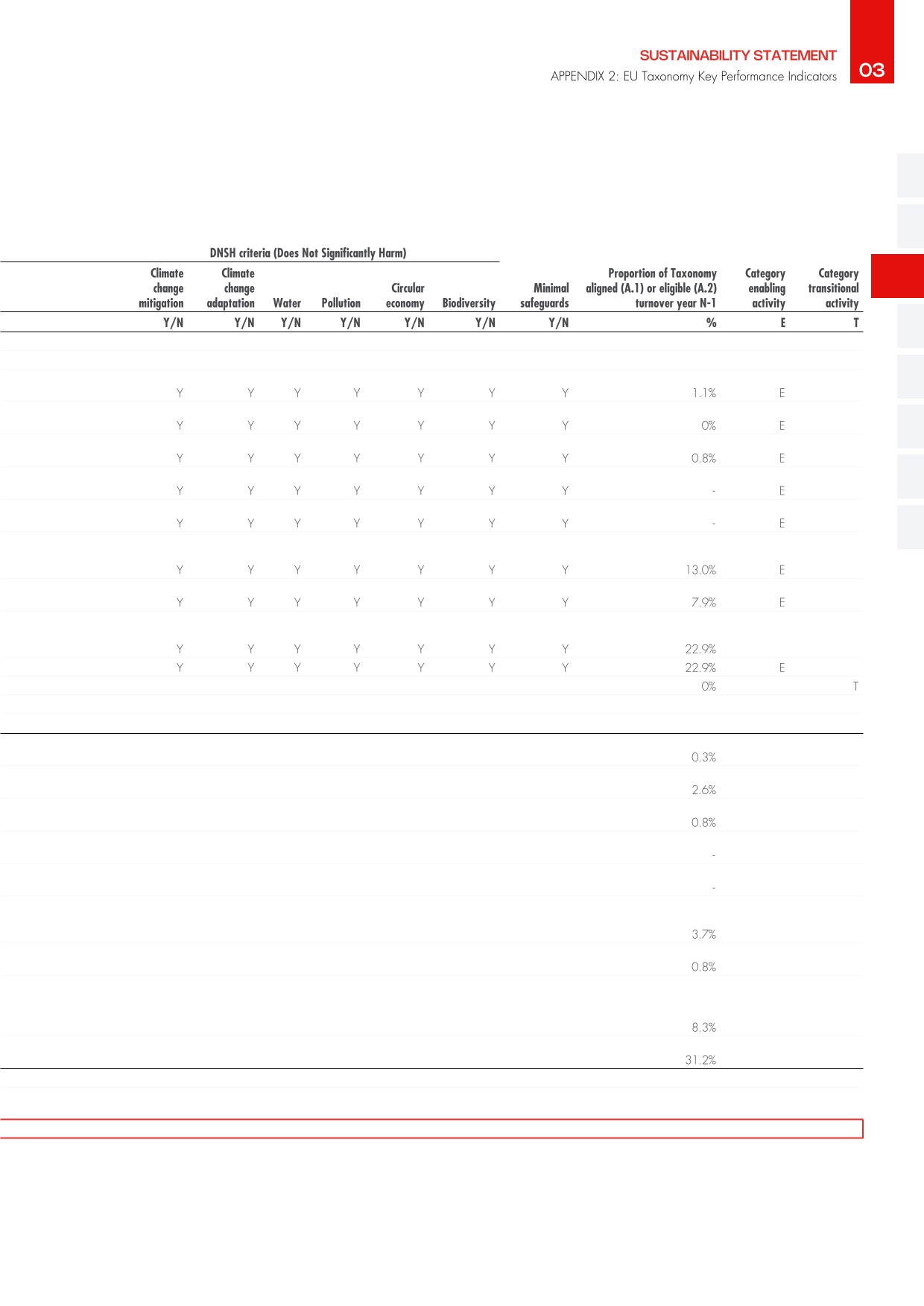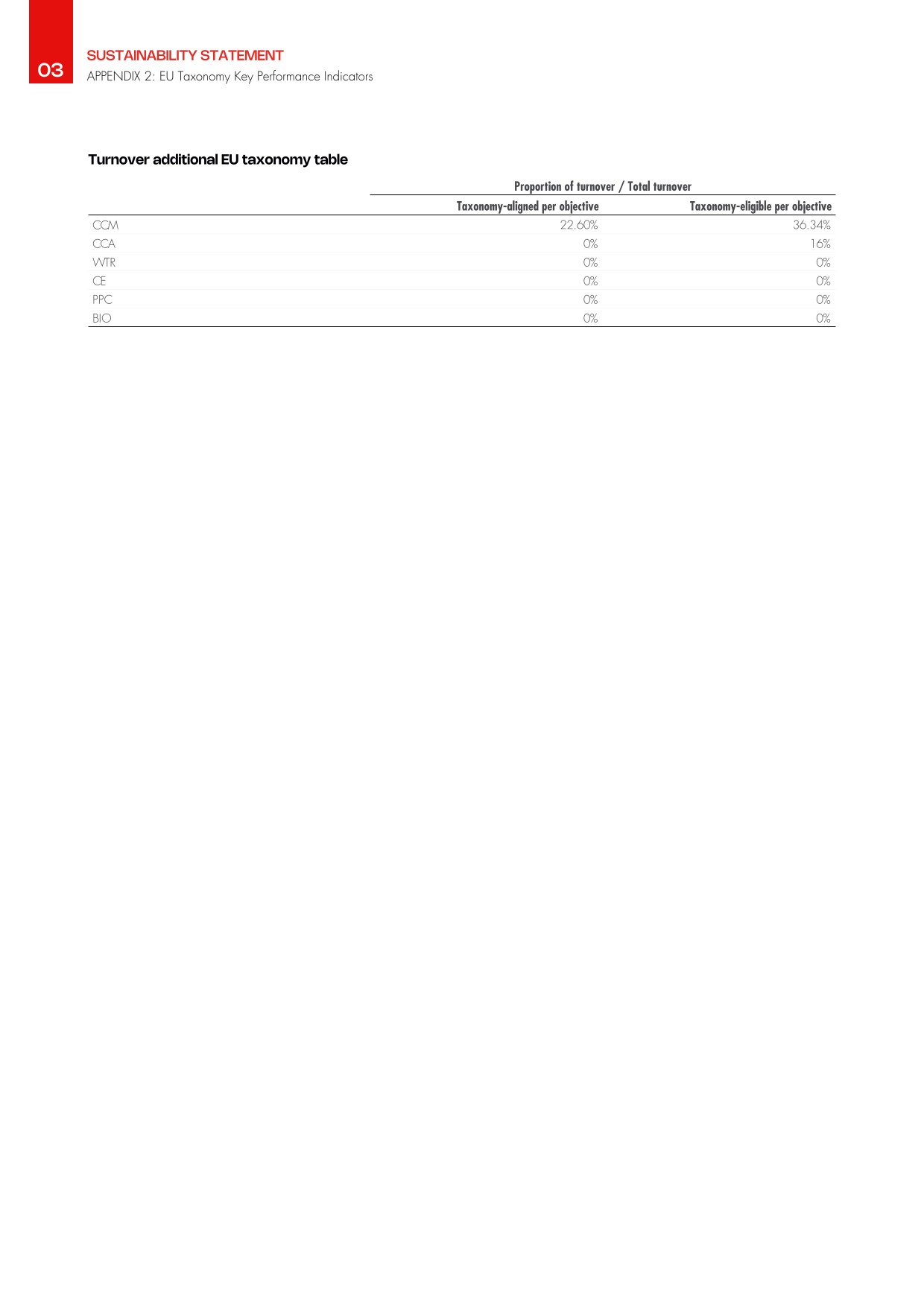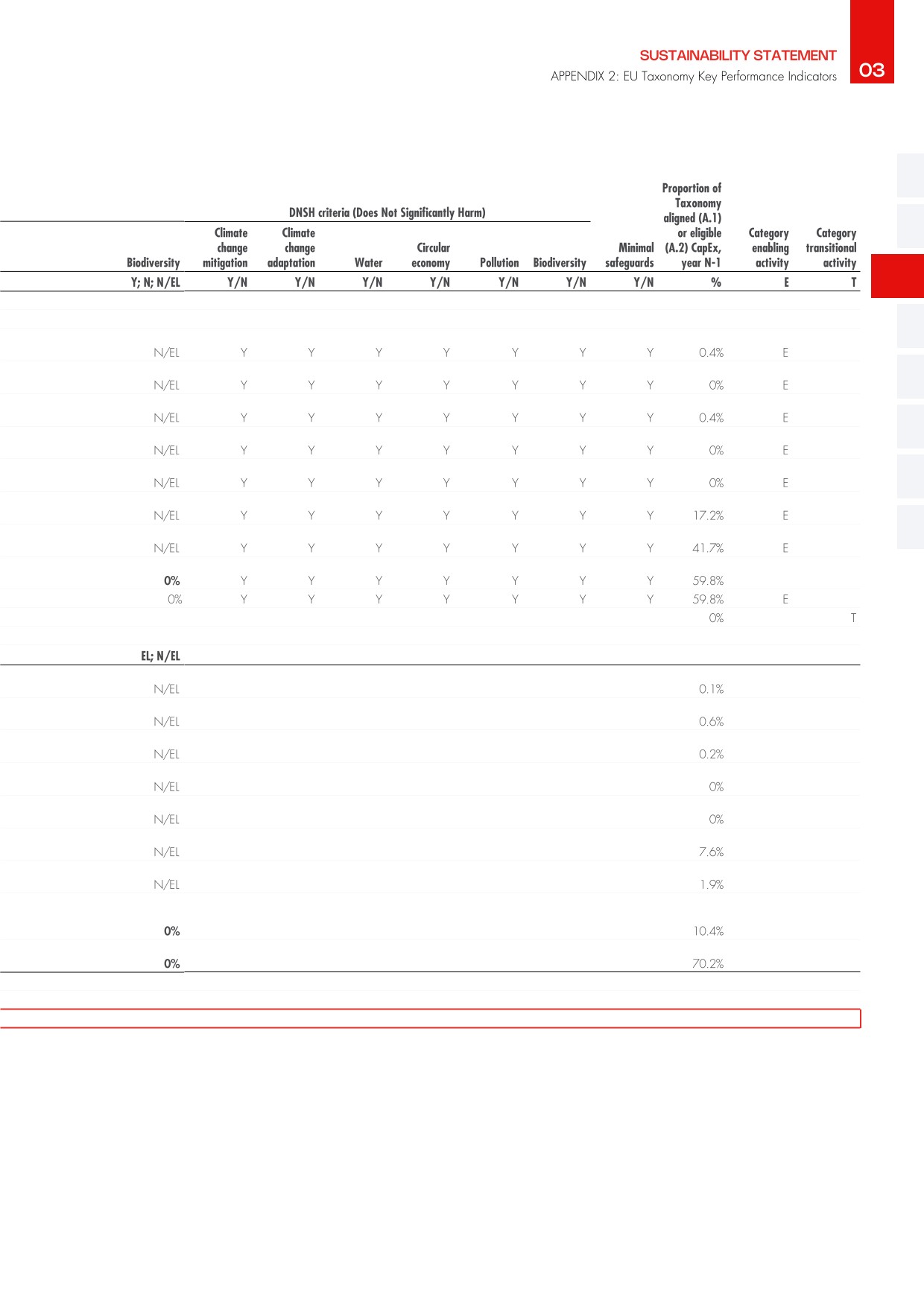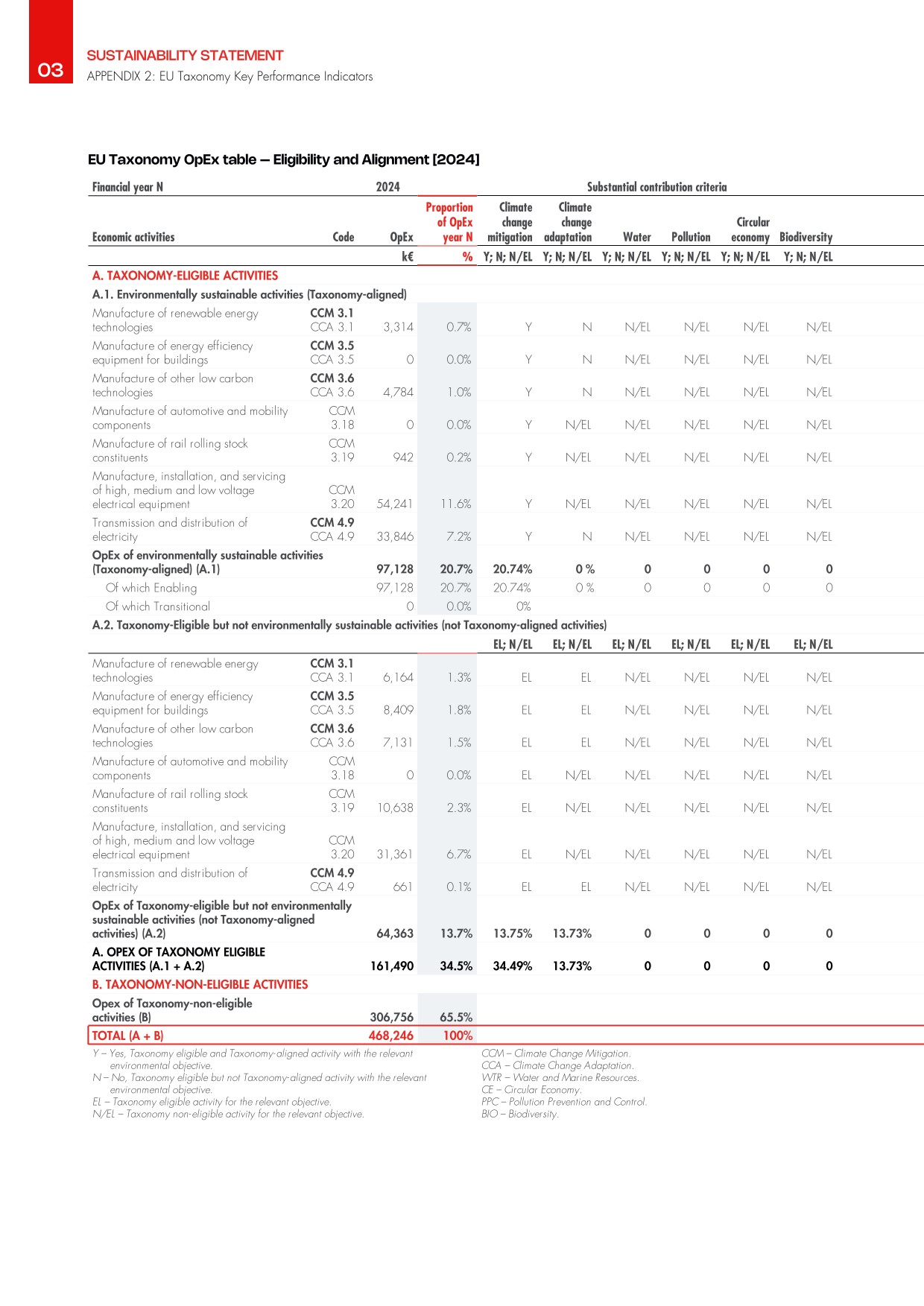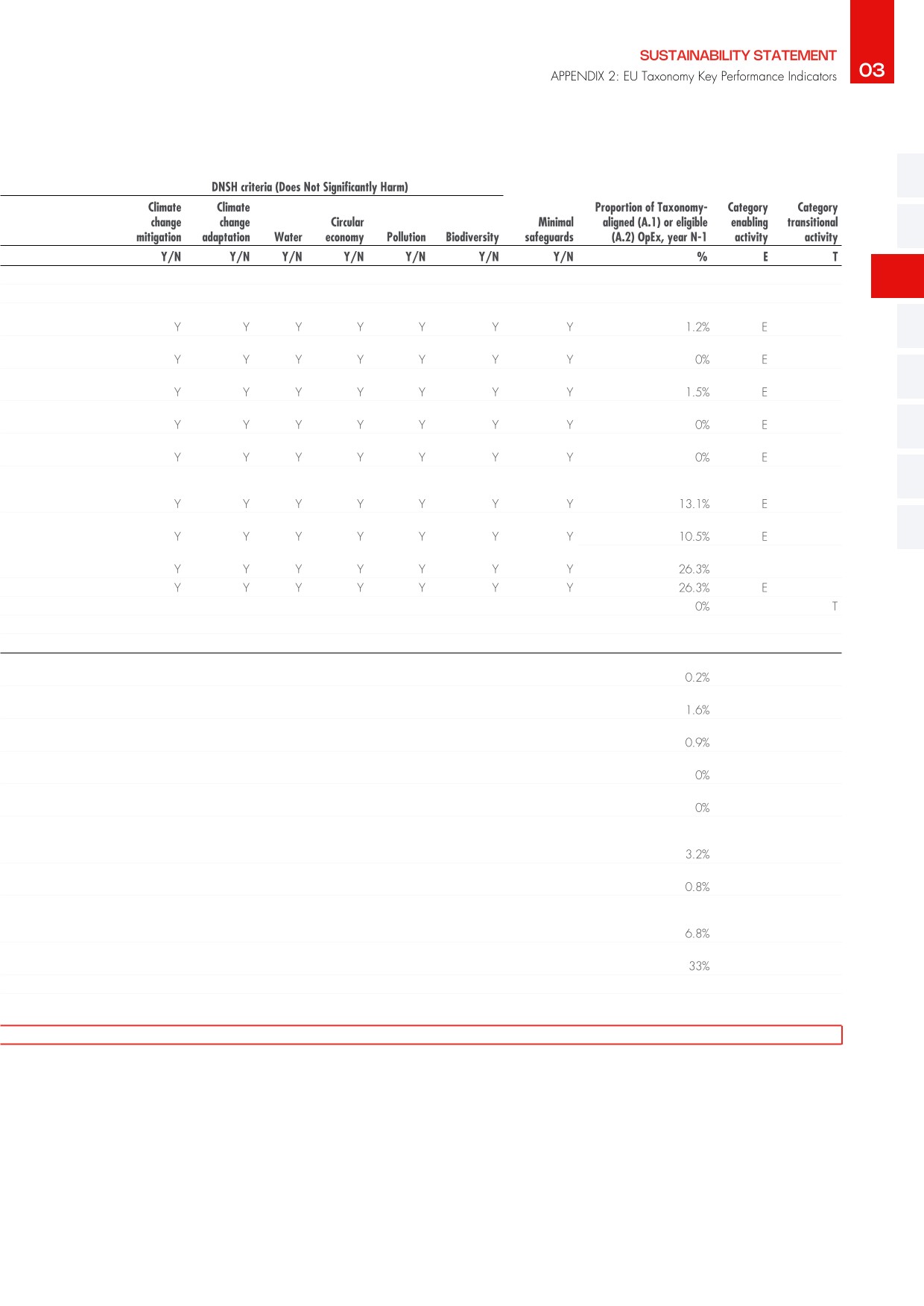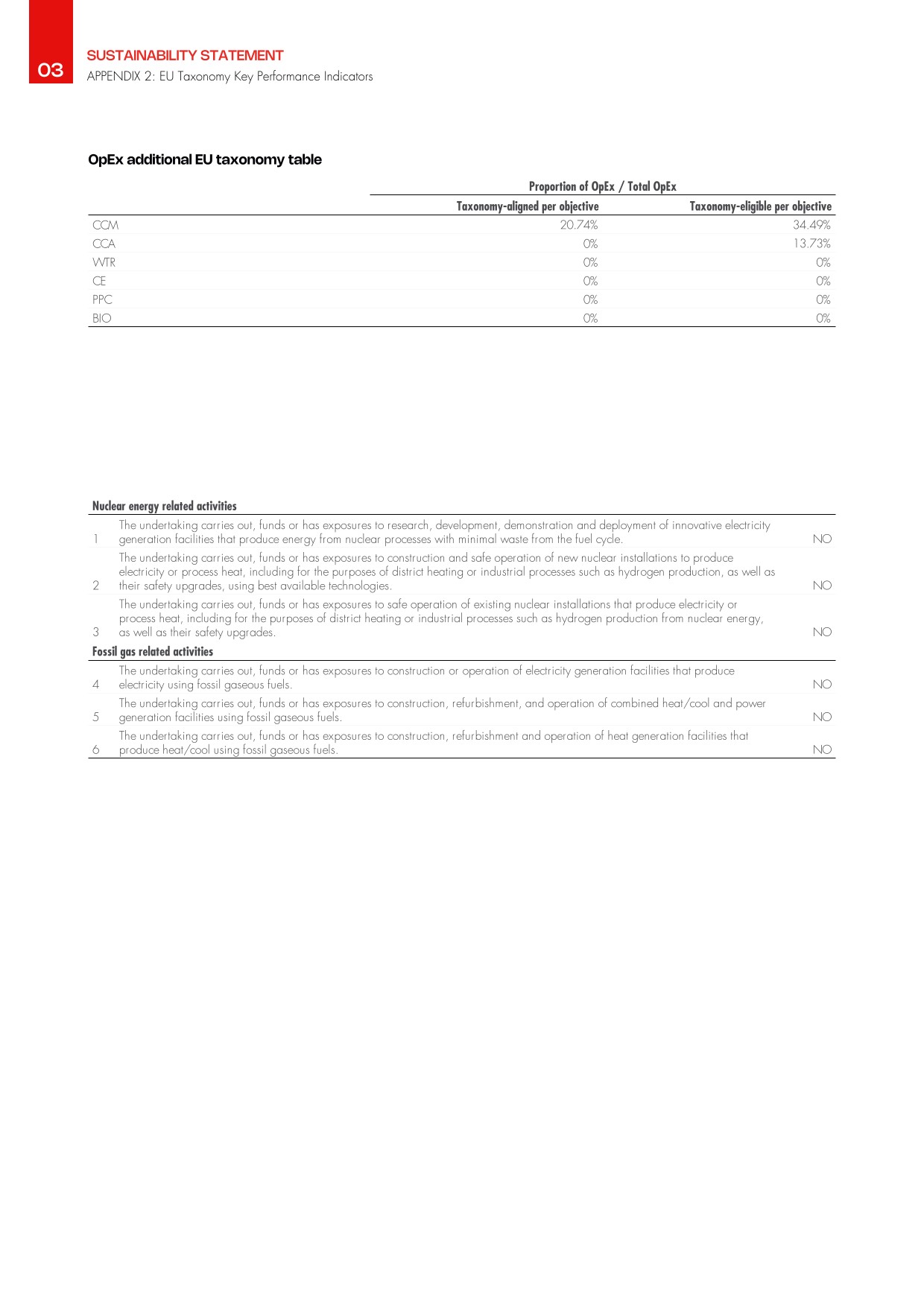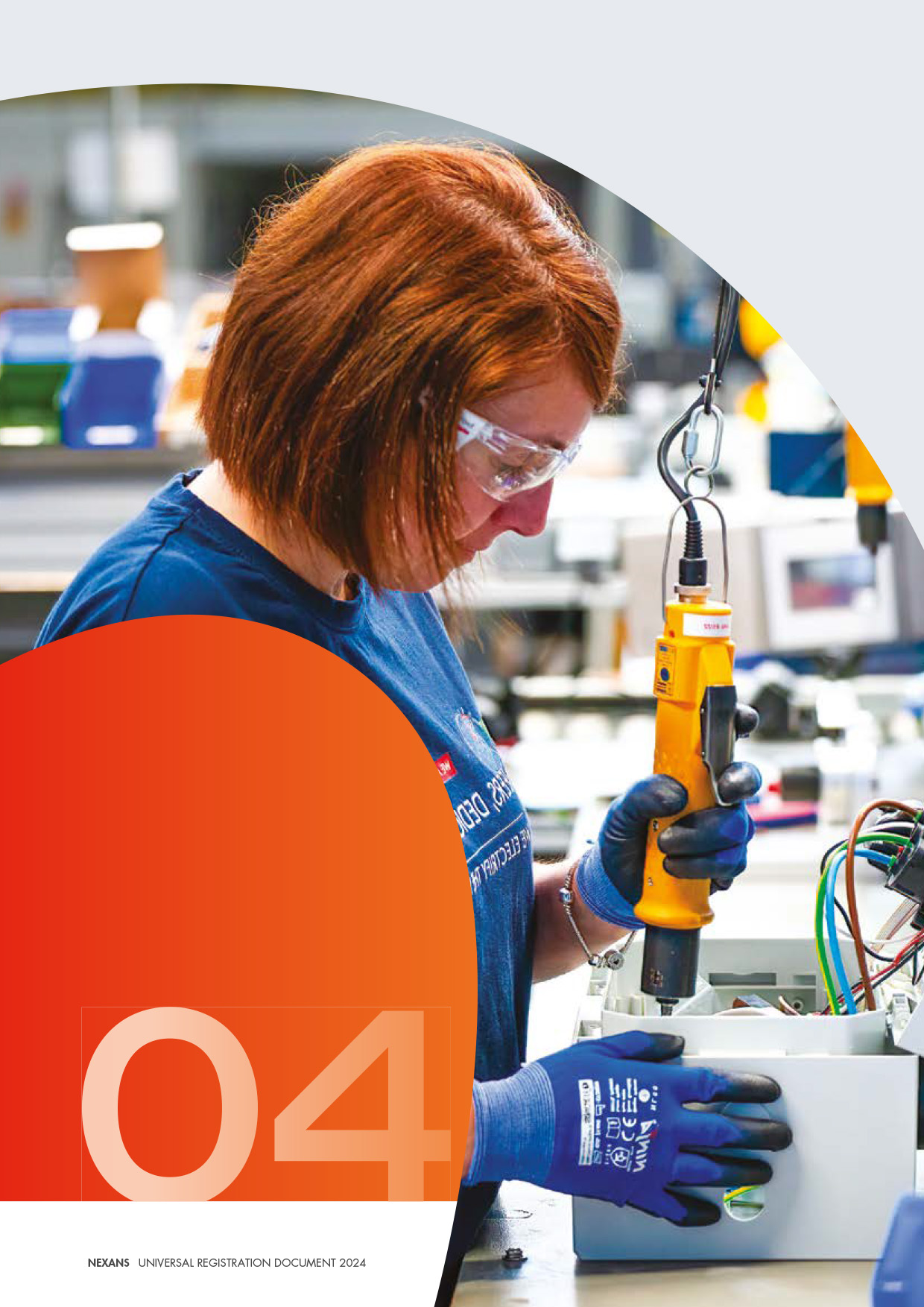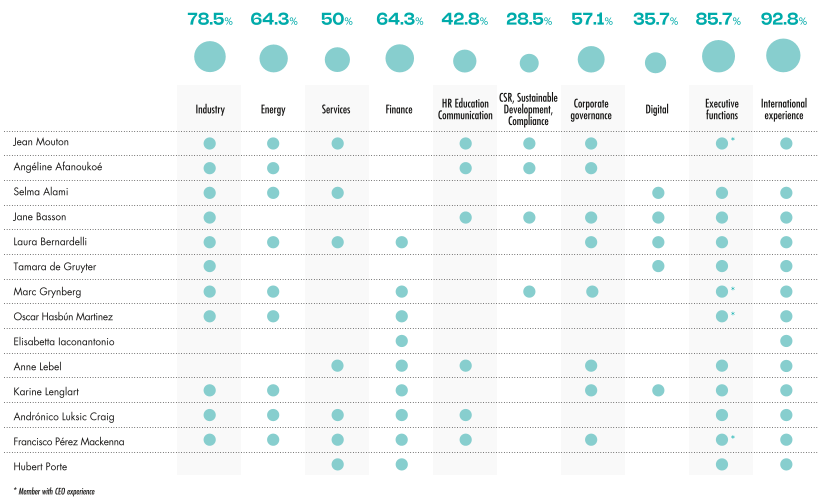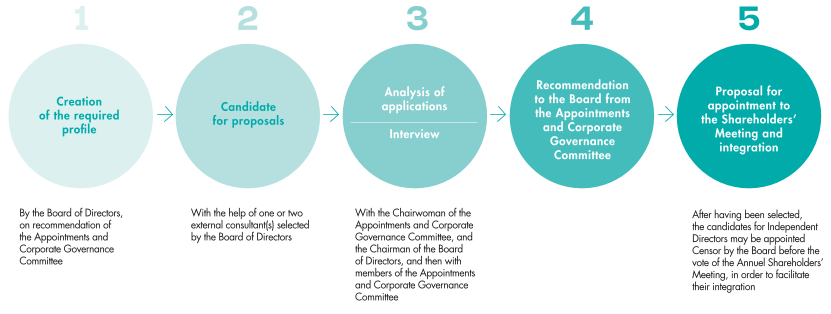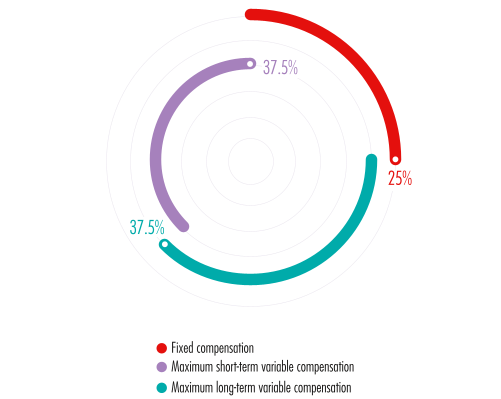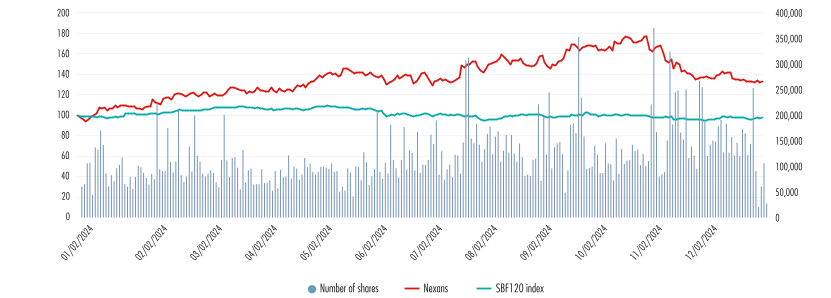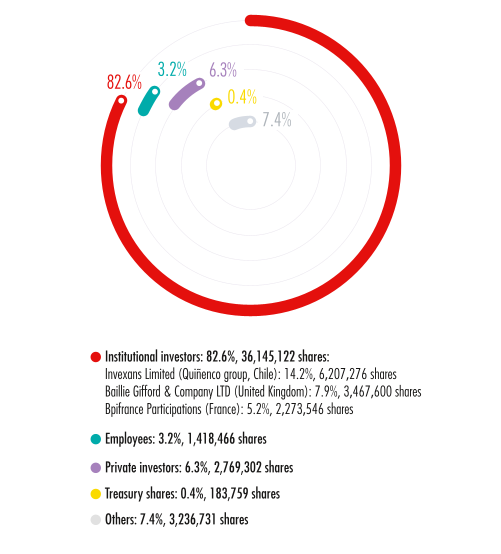URD 2024
-
1.1History of the Group
Nexans has always played a major role in the history of electricity, from its discovery by Thomas Edison and Benjamin Franklin to the new electrified world, and is amplifying its role by becoming a pure player in this field.
A cable pioneer
1879: Thomas Edison created his first high resistance, incandescent electric light. At the same time, two entrepreneurs, the Swiss engineer François Borel and business man Edouard Berthoud, invented a waterproof electric cable. They formed Berthoud, Borel et Cie to develop the system, which consisted of wrapping wire with bituminous paper, which was then sealed with lead. The invention caused a revolution in a number of nascent industries, notably in the telecommunications and electrical power industries.
They created Société d’Exploitation des Câbles Électriques (SCE) to build the first cables: Nexans was born.
1881: Société d’Exploitation des Câbles Électriques successfully presented its lead sheet at the first International Electricity Exhibition in Paris and was awarded the lighting of the Champs Elysée for the 1900 Paris Exhibition.
1897: Creation of Société Française des Câbles Électriques in Lyon, an affiliate of the Swiss company Berthoud, Borel et Cie, to manufacture cables using the Berthoud and Borel system.
1912: The Compagnie Générale d’Électricité (CGE) took a majority holding in Société d’Exploitation des Câbles Électriques which had already become one of the most prominent companies in France’s growing electrical power sector, with operations spanning across both power generation and distribution, and manufacturing.
1925: Merger of Compagnie Générale des Câbles de Lyon with CGE. Câbles de Lyon became a division of CGE.
1938: CGE acquired Société Industrielle des Téléphones of which cable plants in Bezons and Calais were transferred to CGE-Câbles de Lyon.
1969: CGE acquired Alcatel, founded in 1879 as Société Alsacienne de Construction Mécanique, and which had become one of the leading manufacturers of telecommunication technologies. The Alcatel acquisition boosted CGE’s own telecommunication business, CIT. The two companies merged to form CIT-Alcatel, stepping up Câbles de Lyon’s business.
-
1.2Strategy
1.2.1Megatrends
The global electrification revolution is accelerating, driven by a convergence of profound megatrends that define the energy and infrastructure landscape. Nexans, as a leader in the electrification space, has positioned itself to address these transformative forces.
Decarbonization and energy transition
The urgency of addressing climate change has placed decarbonization at the forefront of global priorities. Electrification is the fastest path to a low-carbon future, with renewable energy sources projected to ensure 80% of the global power generation by 2050. This transition demands enhanced grid infrastructure to integrate renewables and support the rising complexity of power systems.
Electrification and rising energy demand
Electrification underpins the world’s pathway to sustainability, with electricity demand forecasted to grow six times faster than overall energy demand. This trend is fueled by the adoption of electric vehicles, increased use of renewable energy systems, and the electrification of buildings and industries.
Urbanization and population growth
Rapid urbanization is driving demand for resilient and efficient energy systems in densely populated areas. Critical infrastructure, such as hospitals, data centers, and industrial complexes, requires specialized, high-performance electrical solutions to ensure safety and reliability.
AI revolution
The Artificial Intelligence (AI) revolution is a significant megatrend impacting various sectors, including the energy industry. Data Centers are expected to account for around 10% of global electricity consumption by 2030. Besides, the integration of artificial intelligence into energy systems is reshaping customer expectations and operational efficiency.
Sustainability
The convergence of electrification needs in both developed and emerging economies has created unprecedented pressure on global supply chains. The frequency and intensity of climate-induced disasters, such as storms and wildfires, have surged. Electrical infrastructure must be resilient to these risks, ensuring continuity in energy supply to safeguard lives and economies. Raw material shortages, particularly in copper and aluminum, combined with geopolitical risks, emphasize the need for sustainable resource management and recycling initiatives.
-
1.32025 trends and outlook
In 2025, Nexans expects to benefit from continued buoyant market demand, supported by global megatrends in electrification, as well as its structural transformation and value-added solutions to support its growth and profitability improvements. The Distribution market is currently entering a hyper cycle of investment. The record risk-reward backlog in Generation & Transmission provides solid visibility.
-
1.4Description of business segments and markets
With a unique level of integration, from metallurgy to recycling, the Group offers its customers a unique proposition: cutting-edge cabling technologies and services, tailor-made support and solutions for the entire value chain – engineering and design, production, installation and maintenance.
1.4.1Electrification businesses
1.4.1.1PWR-Transmission
The PWR-Transmission segment (previously Generation & Transmission) is at the heart of the energy transition and sustainable electrification. It provides high-voltage cables and services for the connection of offshore wind farms to land, short or long distance, as well as for transnational land or subsea interconnection projects between electricity production and consumption areas.
The Group also manufactures submarine data transmission, monitoring or power cables connecting floating vessels to subsea infrastructure or interlinking subsea infrastructures.
Nexans provides a fully integrated offering from early engagement, design and engineering, manufacturing and installation to business continuity solutions such as inspection, maintenance and repair. The Group’s value proposition is based on four pillars:
- ●solid experience in project execution;
- ●strong risk management system through a unique risk-reward modeling process and continuous innovation to detect any failures;
- ●state-of-the-art cable manufacturing and installation assets;
- ●cutting edge technologies with the highest voltages: mass impregnated (MI), cross-linked polyethylene (XLPE) and dynamic cables.
Nexans has made several major investments in this activity in recent years to double its manufacturing capacities. The business’ industrial footprint is now the following:
- ●three subsea high-voltage facilities in Halden (Norway), Charleston (United States) and Futtsu (Japan);
- ●a land high-voltage facility in Charleroi (Belgium);
- ●a special telecom facility in Rognan (Norway).
The Group currently owns and operates two cable laying vessels: Nexans Aurora, the most technologically advanced cable laying vessel in the industry with over 10,000 metric tons of cable load capacity, and Nexans Skagerrak, with the longest track record of the industry. Nexans invested in the Nexans Electra, a new ultra-modern, technology advanced, cable-laying vessel to be equipped with a state-of-the-art logistics and handling system capable of laying four cables simultaneously and expected to be operational by 2026. Nexans is able to install and repair cables at water depth beyond 2,000m, enabling critical links to be established in deep-water environments such as the Mediterranean Sea.
As a long-term partner, Nexans has developed long lasting relationships and credentials with major offshore wind developers, such as Ørsted or Equinor, and Transmission Systems Operators (TSO), such as RTE, Terna, ADMIE or TenneT. In May 2023, Nexans secured a 1.7 billion euros frame-agreement from TenneT for turnkey high voltage direct current projects for offshore wind farms in Germany.
Market trends
The PWR-Transmission sector is growing at 10% annually, from 16 billion euros in 2023 to 26 billion euros by 2028(1), driven by regional interconnections and offshore wind farms. Renewables are expected to make up 80% of the energy mix by 2050(2), increasing grid complexity and the need for advanced power transmission solutions.
Offshore wind energy development has reached varying stages of maturity on a global scale. While it has become a mature and established market in countries such as Denmark, Germany, and the United Kingdom, where commercial parks have been operational for over two decades, it is still in its early stages in many regions, including the U.S., Japan, and parts of Asia. Despite this, offshore wind already represents an important and growing market for power cables. Projections indicate that approximately 275 gigawatts of new offshore wind capacity will be installed worldwide by 2030, with this figure expected to exceed 390 gigawatts by 2032, driven by accelerated efforts to decarbonize electricity supply.
This growth is underpinned by significant improvements in competitiveness, widespread acceptance, and regulatory pressure in favor of renewable energies. Notably, floating wind technology is poised to open new market perspectives, facilitating projects in areas such as the Mediterranean, South Korea, Scotland, and the west coast of the U.S., where deep waters had previously limited offshore wind development. Furthermore, planned and ongoing projects are increasingly larger, deeper, and farther from the shore, making technology and risk management pivotal differentiators for customers.
The sustainable electrification of the world requires the increase in energy production capacities, in particular from renewable sources, but also the increase of interconnections able to transport more energy over longer distances at sea and on land, thus the exchange of energy between countries to fully exploit the potential of renewable energies, which are characterized by intermittent production. By increasing the connectivity between national electricity grids, it is possible to match electricity supply and demand at the transnational level, stabilize the electricity supply of countries, and reduce blackouts, shortages and price fluctuations.
1.4.1.2PWR-Grid
Cables and electrical accessories are key elements of the electricity value chain to transport the energy produced to its point of consumption. Distribution system operators (DSO) provide electricity distribution via overhead lines and underground cable systems. Nexans designs and manufactures medium- and low-voltage cables from 700 V to 72 kV and medium- and low-voltage accessories from 1 kV to 145 kV. Through a comprehensive suite of integrated services, including specialized training for the installation of underground cables and their connecting accessories, cables systems engineering, installation supervision, and extended warranty coverage, the Group delivers turnkey solutions that empower operators. These solutions encompass a wide spectrum of offerings, from high-quality cables and accessories (such as connectors, bushings, terminations, joints, and splices) to cutting-edge services designed to optimize network operation and maintenance. By offering this holistic range of products and services, the Group is committed to supporting operators in their journey towards network modernization and operational excellence.
- ●long-term framework agreements with major energy distribution operators;
- ●turnkey solutions for electrification and bundled offers including cables and accessories for renewable or energization projects; and
- ●a revolutionary technologies: from shock-proof to low-carbon cables, or cutting-edge superconductivity.
In addition, the Group has developed innovative digital solutions: Asset Electrical, an asset management solution from Nexans powered by Artificial Intelligence specially designed to help network operators obtain maximum returns on their electricity network; or Ultracker , a unique solution using IoT technologies to locate drums in real time, in order to optimize their management, logistics and turnaround times while avoiding the loss and theft of cables and reels.
The Group has a long-term relationship with its strategic DSO customers – Enel, Enedis, E-On, Fluvius, UKPN, SSE renewable energy operators such as Enel Green Power, ERG; and, in some countries, major energy installers such as Vinci, Eiffage, etc.
The PWR-Grid segment operates globally in Europe, North America, Asia-Pacific, Africa and the Middle East, through a local industrial presence and through European Accessories plants serving 90 countries.
Market trends
Massive investments of around 10 trillion euros by 2030(3) will be made globally for the development of networks, mainly due to global electrification and the development of renewable energies. All over the world, DSOs are facing an increase in investments to develop and replace aging electricity networks.
The expected investments in renewable energies, data centers, giga factories are generating new connection needs, while the increasing electrification of emerging countries is leading to the development of new electricity grids to cover isolated areas.
In industrialized countries, massive investments will be necessary to modernize aging infrastructures, ensure the security and reliability of networks and cope with the energization of data center and AI gigafactories projects, particularly in Europe and North America.
The PWR-Grid market is expected to grow by 7% annually, increasing from 26 billion euros in 2023 to an estimated 37 billion euros by 2028(4).
1.4.1.3PWR-Connect
The Group designs, manufactures and distributes low-voltage cables (<1kV) and related accessories for electrical systems connecting the terminated point of the energy distribution network to the end user’s power outlet. This market addresses the usage of electricity in residential, infrastructures, industrial, commercial, datacenters and e-mobility end-markets.
- ●the electrical safety of end users;
- ●products that are easy to handle and install;
- ●smart products integrated into a digital ecosystem.
Nexans pursues a strategy of differentiation through technical performance and its ability to offer its customers solutions and systems beyond cable to support them in their projects before, during and after. This is supported by a wide range of services, including professional training, recycling services, shared inventory management at distributors’ premises, and digital services for asset management.
The Group is expanding its range of solutions for clients by introducing new packaging solutions through the MOBIWAY smart packaging, and also providing a comprehensive fire safety offering, to Electrify the Future in a safer way for people and assets. The Group also develops sustainable and environmentally-friendly products in order to reduce their environmental impact, in particular by integrating recycled products into its cables or offering recycling solutions to its customers.
The Group’s main customers are global specialized electrical distributors such as Rexel, Sonepar or Wesco, international purchasing groups like Imelco and Fegime, large electrical installers (Vinci, Eiffage, Bouygues Construction, etc.) and retail distributors such as Brico Depôt, Leroy Merlin, Sodimac and Bunnings.
The segment operates in Europe, North America (primarily in Canada), Asia-Pacific, Africa and the Middle East, thanks to its strong distribution network and a local presence to reduce transport-related CO2 emissions.
Market trends
In an increasingly electric world, electricity consumption is expected to be multiplied by 3 by 2050. In this context, the cable market is estimated at 74 billion euros in 2023 and is expected to grow at a rate of +5% per year to reach 94 billion euros by 2028(5). This dynamic is supported by different drivers depending on the region:
- ●emerging countries are mainly driven by ongoing urbanization, improvement of housing standards in urban areas, and electrification of buildings in rural areas;
- ●industrialized countries are mainly driven by heavy transformation: improvement of building safety, energy positive/smart buildings, decreasing energy consumption, transforming the role of buildings including local energy production, storage capacity and electrical charging stations.
-
1.5Innovation and technology
With a unique vision on the market, fully dedicated to electrification, Nexans makes a point of offering all its customers the highest level of services and innovation.
This is not only a differentiating marker of the Company, but also plays a key role in the Group’s financial and non-financial performance: it contributes to Nexans’ growth in value through the development and marketing of new offers, while meeting the new challenges of its customers. The Group is positioned at the heart of promising markets thanks to its solutions for the energy transition, the climate and the protection of people and infrastructure.
The Group’s spending on innovation amounted to 89 million euros in 2024. This amount illustrates the Group’s commitment to developing and maintaining a portfolio of innovations, often co-developed with a solid ecosystem of partners, to serve its operational excellence.
More than 800 experts and engineers work in dedicated entities or contribute to innovation through the development and marketing of new offers and products. Lastly, patented inventions contribute to the Group’s competitiveness and the differentiation of its offers, and illustrate its capacity for technological innovation. With more than 60 new inventions protected under first patent applications in 2024 in various regions, Nexans is among the top patent applicant in its industry. Nexans’ global portfolio comprises more than 1,700 patents.
1.5.1Innovate with ecosystems
Nexans relies on its Design Labs and Technocenters including AmpaCity, its new global innovation center, inaugurated in Lyon (France) in 2022, to federate its innovation ecosystems.
To meet and anticipate the challenges of its customers, Nexans has created a network of Design Labs responsible for managing the design, development and industrialization of new offers, based on an in-depth analysis of customer and market expectations:
- ●the Digital Design Lab is dedicated to the development of digital services and solutions based on technologies such as cloud, artificial intelligence (AI) and the Internet of Things (IoT);
- ●the Electrical Grid Design Lab helps network operators optimize the performance and reliability of their electrical infrastructure, from generation to distribution to the end user;
- ●the Building Design Lab focuses on the needs of customers, users and installers of cabling systems for buildings. It aims to facilitate the installation of cable networks, improve electrical safety and fire protection, and contribute to Smart Buildings.
The Group’s new Innovation Center in Lyon embodies its commitment to dedicate all of its research to sustainable electrification. The research covers electrical insulation performance (including very high voltage and aging), the ability to anticipate and detect failures, the development of materials with reduced environmental impact, fire-rated cable systems, cable production processes and digital technology. The Innovation Center employs 90 Nexans engineers and technical experts from different countries.
In order to accelerate the development of unique solutions, Nexans has partnered with leading industrial and technological players.The Group has signed strategic partnerships with leaders in its ecosystem such as Bureau Veritas, Digital Matter, Suez and Schneider Electric for a joint program to accelerate its digital transformation.
In particular, Nexans has signed a partnership agreement with Orange Business Services for the provision of IoT connectivity and has set up partnerships with Microsoft Azure to develop enhanced artificial intelligence and cloud solutions to transform the customer experience and ensure just-in-time delivery. It also developed partnerships with Suez to improve the separation between mixed plastic and metal scrap to increase the usage of recycled material.
Nexans is also involved in collaborations with universities, research centers and foundations (SuperGrid, EnergyVille, universities, CNRS laboratories, CurrentOS) for technology development projects, in particular on cable aging and the behavior of insulation under very high voltage, the development of recycling solutions, and new DC electrical architectures. In particular the Group is engaged in two collaborative projects supported by the France 2030 program: Ophelia for the development of medium voltage direct current solutions for long linear solar farms, and the RENOV initiative which is dedicated to the advancement of technologies for recycling cross-linked polymers.
In PWR-Transmission, early engagement and innovation with our key customers is an important vehicle to drive product and system development and close technology gap for future projects. During the year Nexans have had innovation projects with particular focus on dynamic export cables for floating offshore wind to address the challenges in the upcoming floating offshore wind market.
-
1.6Group operations during 2024
1.6.1Consolidated results of the Group
1.6.1.1Overview
In 2024, sales at standard metal prices reached €7,078 million, demonstrating strong organic growth of +5.1% at constant scope and currency compared to 2023. Excluding the Other activities segment, which is being strategically scaled down, organic growth stood at +8.1%. The Electrification businesses grew by +13.0% organically, driven largely by the PWR-Transmission segment's strong growth thanks to capacity expansion at the Halden plant in Norway. After a double digit organic growth in 2023, the Non-electrification business proved resilient with a small organic decline of -2.5%.
Net acquisitions/disposals had an impact on standard sales of +€219 million reflecting i) the integration of La Triveneta Cavi into the PWR-Connect segment from June 1, 2024, ii) the acquisition of Reka Cables since April 2023 bolstering PWR-Grid and PWR-Connect segments, and iii) the divestment of the Telecom business since October 2023 in line with Nexans’ vision to become an Electrification Pure Player.
Adjusted EBITDA reached a record high of €804 million in 2024, up by a solid +21.0% versus €665 million in 2023. This strong performance underscored the profitability enhancements across all business segments. The adjusted EBITDA margin reached an all-time high of 11.4%, surpassing the previous year's strong performance of 10.2%. This achievement illustrates the Group’s strategic focus on operational excellence, selectivity and value-driven growth. Electrification businesses achieved 12.9% adjusted EBITDA margin, outperforming the 2023 achievement of a 12.5% margin.
In 2024, specific operating items amounted to a negative €22 million. They included €19 million related to share-based payment expenses, and €3 million related to additional costs on long-term projects impacted by past reorganizations.
EBITDA including share-based payment expenses – as per the 2021 Capital Markets Day definition – amounted to €785 million in 2024, versus €652 million in 2023. The Group’s EBITDA margin stood at 11.1% in 2024, in line with the Group’s 2021 Capital markets day target of 10%-12%.
ROCE (including the 12-month contribution of La Triveneta Cavi and AmerCable) pursued its strong trajectory, reaching 21.1% for the Group, and 26.3% for the Electrification businesses.
Operating margin totaled €566 million in 2024, representing 8.0% of sales at standard metal prices (versus 6.6% in 2023).
1.6.1.2Detailed analysis by segment
PWR-TRANSMISSION
PWR-Transmission standard sales came in at €1,287 million in 2024, up +50.3% organically compared to 2023, boosted by the completion of the Halden, Norway, plant capacity expansion at the beginning of the year, which doubled XLPE technology capacities. In the fourth quarter of 2024, Nexans achieved organic growth of +41.9% compared to the fourth quarter of 2023.
The segment’s adjusted EBITDA reached €142 million in 2024, up +72.3% compared to the same period last year. The adjusted EBITDA margin showcased a significant increase to 11.0% in 2024, versus 9.5% in 2023. As expected, the margin upturn throughout the year was supported notably by Revolution Wind successful installation campaign, Inspection Maintenance and Repair (IMR) projects as well as continued execution of the Great Sea Interconnector project.
Customer activity remained dynamic, and in line with the Group’s risk-reward selectivity approach, the segment’s adjusted backlog reached €7.4 billion at December 31, 2024, up +21.4% compared to December 31, 2023. The strong order intake was notably fueled by a substantial contract for the Gotland electricity connection project, an important contract for East Anglia TWO offshore wind project in the southern North Sea, and the LanWin 2 final award as part of the frame-agreement with TenneT for around €1 billion. This record-high adjusted backlog is more than 90% subsea-driven (subsea interconnection and offshore wind projects) and provides multi-year visibility with around 90% of the topline of the business secured for the 2024-2028 period.
The robust visibility of manufacturing and installation asset loads has been extended through 2030, with both Charleston and Halden plants more than 90% loaded up to 2028. Construction of Nexans’ third cable-laying vessel, Nexans Electra, is on-track and will be completed in 2026. This state-of-the-art vessel is a strategic asset that will significantly enhance capacity to address the substantial growth in the business’ backlog. The Group also unveiled a strategic €90 million investment at its facilities in France and Belgium to increase the production of advanced 525kV onshore cables meeting the requirements of the TenneT frame agreement.
PWR-GRID
Standard sales in the PWR-Grid segment rose organically by +3.1% compared with 2023 to €1,243 million. Fourth quarter 2024, saw strong organic sales growth of +7.6% compared to the same quarter last year. Europe benefited from increased demand and the securing of new frame-agreements. The Middle East and Africa region was boosted by renewable energy projects. North America was stable with a good second half, while South America encountered some project delays. The Accessories business was a solid contributor throughout the year.
Adjusted EBITDA rose by a sharp +9.0% year-on-year to €170 million supported by selectivity on new frame-agreements, operational excellence and the contribution of the Reka Cables acquisition completed in April 2023. The adjusted EBITDA margin reached an unprecedented 13.6% in 2024 compared with 13.2% in 2023, reflecting selective growth and successful business transformation.
PWR-CONNECT
Standard sales in the PWR-Connect segment amounted to €2,073 million in 2024, up +1.4% organically. Europe suffered from lower demand in some residential markets, despite sustained momentum in commercial and infrastructure segments. Near East & Africa and South America remained very strong while North America (Canada) rebounded in the second half of the year. In fourth-quarter 2024, Nexans achieved organic growth of +4.2% compared to fourth quarter 2023 and +0.5% compared to the third quarter of 2024.
The 2024 figures reflect the contributions of La Triveneta Cavi, starting from June 1, 2024, and Reka Cables, since April 2023. These acquisitions are integral to Nexans' Electrification strategy, expanding the Group’s capabilities and reinforcing its market position in key regions.
Adjusted EBITDA reached €283 million in 2024, up +23.8% year-on-year. Adjusted EBITDA margin was a robust 13.7%, thanks to structural performance improvement initiatives, selectivity and value-added solutions.
NON-ELECTRIFICATION (Industry & Solutions)
In the Industry & Solutions segment, standard sales for 2024 amounted to €1,701 million, reflecting a low organic decrease of -2.5% year-on-year, while fourth-quarter 2024, up +2.1% compared to fourth-quarter 2023.
The performance reflects a slowdown in the Automation market in Europe, which was partially offset by a stable Shipbuilding, Rollingstock and Nuclear business. The Auto-harnesses business was stable during the year.
Adjusted EBITDA for the segment increased by +11.9% and reached €207 million, resulting in an adjusted EBITDA margin of 12.2% in 2024, compared to 10.6% the previous year. This improvement reflected a positive mix and pricing effect resulting from the successful transformation of the business.
Other Activities
The Other activities segment – corresponding for the most part to copper wire sales and corporate costs that cannot be allocated to other segments – reported standard sales of €774 million in 2024. Standard sales were down -14.4% organically year-on-year, mainly linked to the Group’s strategy to reduce copper wire external sales through tolling agreements in order to mitigate their dilutive effect.
-
1.7Other relevant information on Group activities
1.7.1Investments
The Group’s tangible and intangible capital expenditure came to 378 million euros in 2024 compared to 377 million euros in 2023.
- ●Strategic CAPEX in the PWR-Transmission segment encompassing mainly the expansion of the Halden high-voltage cable plant in Norway, addition of capabilities at the Charleston plant in the United States and Nexans Electra new cable laying vessel. In 2024 Strategic CAPEX amounted to 202 million euros, versus 199 million euros in 2023;
- ●Nexans’ World Class manufacturing program to improve sites’ industrial performance, digital transformation and Industry 4.0 has been speed up – more than 30 sites are using digital management routines and 10 sites have deployed a manufacturing execution system (MES);
- ●the decarbonization of the Group’s own operations, by investing progressively in energy efficiency, site electrification, renewable energies, and electrical vehicles. In 2024, these investments amounted to around 5 million euros;
- ●the evolution of the Group’s products and solutions.
-
1.8Information on the Nexans Group and company
1.8.1General information about the Group
1.8.1.1Company identity
The Company is registered in the Nanterre Trade and Companies Register under number 393 525 852. Its APE code is 7010Z.
The Legal Entity Identifier (unique identifier of financial market participants) of Nexans is: 96950015FU78G84UIV14.
1.8.1.2Legal form and applicable legislation
Public limited company under French law, subject to all the texts governing commercial companies in France, and in particular to the provisions of the French Commercial Code.
1.8.1.3Documents accessible to the public
The Company’s Bylaws, its parent company and consolidated financial statements, the reports presented to its Meetings by the Board of Directors and the Statutory Auditors, as well as the Internal Regulations of the Board of Directors and the Code of Ethics and Business Conduct and all other corporate documents may be consulted by shareholders in accordance with the legal and regulatory provisions in force. They are available for consultation at the Company’s registered office and on the website: www.nexans.com, which contains regulated information published in accordance with Articles 221-1 et seq. of the General Regulations of the AMF.
1.8.1.4Date of incorporation and term
The Company was incorporated on January 5, 1994, under the corporate name “Atalec” (replaced by “Nexans” at the Shareholders’ Meeting of October 17, 2000), for a period of 99 years, until January 7, 2093. Nexans results the consolidation of most of the cable activities of Alcatel, which is no longer a shareholder of Nexans, and was listed on the stock exchange in 2001 (for more information on the history of the Company, see section 1.1 of this Universal Registration Document).
1.8.1.5Corporate purpose (summary of Article 2 of the Bylaws)
In all countries, study, manufacture, operation and trade all apparatus, hardware and software relating to domestic, industrial, civil or military and other applications of electricity, telecommunications, data processing, electronics, space industry, nuclear energy, metallurgy and, in general, any means of production or transmission of energy or communications (cables, batteries and other components), as well as, in the alternative, all activities relating to operations and services relating to the means referred to above. The acquisition of stakes in all companies, whatever their form, associations, French or foreign groups regardless of their corporate purpose and activity; and, in general, all operations industrial, commercial, financial, movable and immovable relating, directly or indirectly, in whole or in part, to any of the objects indicated in the statutes and to any similar or related objects.
1.8.1.6Fiscal year
-
2.1Risk factors
In an ever-evolving environment, Nexans is dedicated to protecting the safety and health as well as the interests of its employees, the interests of its shareholders, clients, suppliers, and all of its stakeholders, while achieving its objectives. To navigate this landscape, Nexans has implemented a proactive risk management policy to efficiently respond to any internal and external threats likely to affect its finance, operations, reputation or future prospects. Given Nexans’ global presence, the competitive nature of the cable industry and the diversity of its businesses, Nexans faced a variety of risks, both endogenous and exogenous. Nexans diligently manages Strategic, Operational, Legal and Compliance, and Financial risks to not only minimize their occurrence but also to mitigate their potential impact. To achieve this, the Group has established and consistently enhances its risk management processes and organization.
As part of Nexans’ risk management process, the Group has conducted an assessment to identify the primary risk factors it faces.
Pursuant to the provisions of Article16 of Regulation (EU) 2017/1129 of the European Parliament and of the Council, this chapter outlines the main specific risks that could, on the date of this Universal Registration Document, impact the Group’s business, financial condition, outlook reputation, operational results or ability to achieve its objectives. The 15 risks are clustered in four categories (Strategic Risks, Operational Risks, Legal and Compliance Risks, and Financial Risks). These 15 risks are, however, not exhaustive and other risks or uncertainties, whether unknown or not considered herein at the date of this Universal Registration Document, could occur or arise and have a material adverse effect on the Group.
Methodology
In term of methodology, the 15 identified risks are those which are specifically pertinent to Nexans and have the most significant net impact.
Led by the Group Risks Department, the management of Nexans' business groups and main functional departments have assessed in 2024 among Nexans' environment of risks, the risks that could have a material impact on the Group’s operations or performance, including the main ESG issues.
The ranking of the net score of each risk is based on the assessment of i) the highest level of criticality (potential impact on the Group multiplied by probability of occurrence), and ii) the effectiveness of the risk mitigation measures deployed by the Group to detect, prevent and/or mitigate their impact and frequency of occurrence of the said risk. The risks are ordered by their level of importance, and within each category, those with the greatest residual exposure are presented first. The Group classifies the residual risks on a scale ranging from “low”, “moderate”, “material” to “critical”.
-
2.2Insurance
Nexans Insurance Department is in charge of subscribing, negotiating and deploying insurance programs throughout the Group. It seeks the best coverage available in the insurance market at an optimum price for its specific exposures with highly reputed insurance companies with strong financial ratings.
The Group’s insurance policies cover current identified risks while taking into account new acquisitions or disposals that may occur during the year. Working closely with international brokers, the Insurance Department always seeks to optimize costs while ensuring adequate coverage based among other criteria on regular risk assessments, Group’s claims experience, advice from brokers with industry benchmarks as well as specific risks and/or actuarial studies. On a regular basis, the Insurance Department launches insurer and broker bids.
The overall cost of insurance policies (excluding life & health and accident insurance) taken out at Group level represents less than 0.5% of consolidated sales at constant non-ferrous metal prices.
To contain insurance premiums and secure coverage, Nexans reinforces the use of its reinsurance captive in the insurance structures and is permanently studying the opportunity to add new risks. Finally, the Group regularly reassesses its risk appetite to counter any negative impact of the insurance market.
Apart from the directors and officers liability policy, the main insurance programs taken out by the Group are as follows:
Property damage – business interruption
The property damage insurance program covers Nexans assets worldwide and consequential interruption of business in the case of a loss.
-
2.3Risk management within the Group
The main items of Nexans’ risks management and internal control system are described in the chart below and are based on three defense lines.
2.3.1Three lines of defense
First Line of defense – Business Groups and operating entities
The Business Groups and operating entities play a front-line role in managing risks in their respective geographic and business areas.
Their departments are responsible for applying all of the Group Management Procedures in their areas of responsibility, covering compliance with applicable laws and regulations and with the Group’s Code of Ethics and Business Conduct and Management of Incident reports.
Second Line of Defense – Risk Management, Internal Control and Compliance
Coordinated by the Departments of Risk Management, Internal Control and Compliance together with the functional departments in their fields of expertise, the second line of defense aims at designing and piloting a system of control of the Group activities, in particular by:
- ●assisting operating units in the identification and assessment of the main risks within their scope of expertise;
- ●designing Group policies and procedures by area of activity;
- ●contributing, with operating units, in designing adapted controls systems or mechanisms;
- ●raising awareness on risk management, internal control and compliance by communicating on best practices and training operating employees.
Third Line of defense – Internal Audit
Internal Audit Department is to provide Nexans’ Board of Directors and Executive Committee with reasonable assurance on the robustness of the system of risk management, internal control and compliance management of the Group in realizing audits of functions and business units on the deployment of risk management, internal control system and compliance management as well as related procedures.
-
4. Corporate governance
The Board of Directors’ report on corporate governance was reviewed by the Appointments and Corporate Governance Committee and the Compensation Committee on February 10, 2025. It was approved by the Board of Directors on February 18, 2025, in accordance with the requirements of Article L.225-37 of the French Commercial Code. This report is included in this chapter.
-
4.1Corporate Governance Code
The Company refers to the Corporate Governance Code for listed companies published by the Association Française des Entreprises Privées (AFEP and the Mouvement des Entreprises de France (MEDEF, as amended in December 2022. The AFEP-MEDEF Code is available on the MEDEF website, www.medef.com, and the AFEP website, www.afep.com.
-
4.2Governance structure
Separating the duties of Chairman of the Board and Chief Executive Officer (CEO)
On May 15, 2014, on the recommendation of its Chairman, the Board of Directors approved the principle of separating the duties of Chairman of the Board and Chief Executive Officer (CEO).
This organization allows the Company and Executive Management to concentrate on its strategic priorities and implement the strategic plan under the best possible conditions. It is carried out in conjunction with the Group’s transformation. It also helps ensure that the Board of Directors operates better. The interest of this separation of duties has been confirmed by the Board assessments carried out each year since 2014.
-
4.3Management bodies
4.3.1Chief Executive Officer (CEO)
Christopher Guérin
Chief Executive Officer (CEO) since July 4, 2018

Number of shares held: 59,653
Number of corporate mutual fund units invested in Nexans shares: 1,152
Age: 52
Nationality: French
Address: 4 allée de l’Arche, 92400 Courbevoie, France
Expertise/Experience
Christopher Guérin is Chief Exectuive Officer of Nexans (CEO) since July 4th, 2018. Since taking up the position of CEO, he has made a major strategic shift to reposition the Group on the world's sustainable electrification markets. This transformation is based on the E3 management model, balancing business performance with environmental protection and employee engagement. In this way, Nexans has placed climate issues at the very heart of its strategy, driving a more rational approach to growth, while significantly improving the company's profitability. Christopher began his management career with the Linde Group in the UK, before moving in 1997 to Alcatel Câbles, which became Nexans in 2001. He held a number of management positions in the Metallurgy Division. Between 2005 and 2007, Christopher was Sales Director for Europe. From 2007 to 2013, he held various sales and marketing positions in France and then in Europe. From 2013 to 2018, he managed the industry market line. From 2014 to 2018, he was Senior Vice-President for Europe and the Telecommunications, Data and Power Connection Systems Groups at Nexans.
Christopher Guérin is a graduate of ESDE/American Business School. He also followed INSEAD’s Management Acceleration program.
Directorships and other positions held during the 2024 fiscal year (and still in force at the 2024 year-end)
- –Chairman of Europacable*
- –Vice-Chairman of ICF*
Directorships that have expired in the last five years
- –None
* Positions held in foreign companies or institutions.
-
4.4Administrative body
4.4.1Board of Directors’ composition and diversity policy
4.4.1.1Composition of the Board, the Committees and the diversity policy
In accordance with Article 11 of the Company’s Bylaws, the Board of Directors may include between 3 and 18 members at the most. At December 31, 2024, the Board of Directors included 14 directors.
In accordance with Recommendation 7.2 of the AFEP-MEDEF Code, at its meeting of February 18, 2025, the Board discussed the balance reflected in its composition and that of its Committees, notably in terms of diversity. The Board of Directors aims to boost diversity and complementary skills and maintain a diverse profile in terms of age, nationality, international experience and gender balance. The Board of Directors is also attentive to maintaining a balanced distribution between directors with historical knowledge of the Company and directors who have joined the Board more recently.
Pursuant to Article L.22-10-10 of the French Commercial Code, the following table sets out the diversity policy applied within the Board of Directors and indicates the criteria used, the objectives set down by the Board of Directors, the implementation procedures and the results obtained over the fiscal year ended December 31, 2024.
Criteria
Objectives
Procedures implemented and results obtained in 2024
Size of the Board
Maintaining the number of directors at between 12 and 16.
Given the breakdown of its share capital and the fact that three directors of the principal shareholder Invexans Limited (Quiñenco Group) and the shareholder Bpifrance Participations sit on its Board of Directors, the latter considered 14 directors at the end of 2024 to be a satisfactory number.
Age and seniority of directors
Less than one third of directors should be over 70 years of age.
In addition to the age of the directors, seeking a balanced distribution in terms of seniority on the Board.
At December 31, 2024, the ages of the directors ranged from 42 to 70 years and the average age of the directors was 56.8 years.
One director is over 70 years old.
The Board considers that its composition is balanced, with directors having historical knowledge of the Group and directors who have joined the Board more recently. The length of service for directors ranges from 1 to 14 years, with an average of 6.8.
Gender
Maintaining a balanced representation between men and women with at least 40% of women.
The proportion of women(a) on the Board at December 31, 2024, was 45.5%.
Nationalities
Over 25% of directors are foreign nationals.
Eight directors are foreign nationals. As such, 57.1% of the directors were foreign nationals at December 31, 2024.
Independence
The Board set itself the objective of maintaining an independence rate of at least 50% in accordance with Recommendation 10.3 of the AFEP-MEDEF Code.
The independence rate was over 54.5%(b) at December 31, 2024. Concerning the characterization of directors’ independence, see Section 4.4.1.3 of this Universal Registration Document.
Expertise/experiences
Seeking out complementary expertise in industry, energy, finance, communications, CSR, compliance, human resources and services, as well as extensive knowledge of the Nexans Group and its stakeholders, and rounded out by senior executive experience.
Of the Board of Directors’ members, at least:
- ●10 have a career in industry;
- ●2 have a career in energy;
- ●4 have a career in finance, banking or private equity;
- ●3 have a career in human resources, education, talent management;
- ●2 have a career in communications;
- ●2 have a career in services;
- ●3 work within the Nexans Group;
- ●11 have exercised senior management functions.
Representation of stakeholders
Ensuring balanced representation of the different stakeholders.
Three directors were appointed based on a proposal submitted by the principal shareholder, Invexans Limited (Quiñenco Group).
The shareholder Bpifrance Participations has been appointed as director.
Pursuant to Article 12 bis of the Bylaws, one of the Board members is appointed at the Ordinary Shareholders’ Meeting, from among the two candidates proposed by the employee shareholders.
Pursuant to Article 12 ter of the Bylaws, two directors representing employees are appointed by the French Works Council and the European Group Works Council.
- (a)Proportion of women on the Board calculated without counting the directors representing employees and employee shareholders, in accordance with paragraph 2 of Article L.22-10-6 of the French Commercial Code. This rate would be 50% when taking into account the employee shareholder representative.
- (a)Independence rate calculated without counting the directors representing employees and employee shareholders in accordance with Recommendation 10.3 of the AFEP-MEDEF Code.
Summary table of the composition of the Board of Directors and its Committees
The following table summarizes the composition of the Board of Directors and the Committees at December 31, 2024.
Personal information
Position on the Board
Participation in a Committee
Surname and name, corporate name
Age
Woman/
Man
(W/M)Nationality
Number of shares held
Start of first term of office
End of current term of office
Length of service on the Board (number of years)
Inde-
pendenceAccounts, Audit and Risk Committee
Appointments and Corporate Governance Committee
Compensation Committee
Strategy and Sustainable Development Committee
Chairman
Mouton Jean
68
M

9,994
05/15/2019
2027 AGM
6
Yes
Directors proposed by the main shareholders
Bpifrance, represented by Karine Lenglart
52
W

2,273,546
05/15/2019
2027 AGM
6
No
✓
✓
✓
Hasbún Martínez Oscar
55
M

500
05/15/2019
2027 AGM
6
No
C
Luksic Craig Andrónico
70
M

6,740
05/14/2013
2025 AGM
12
No
Pérez Mackenna Francisco
66
M

500
05/31/2011
2025 AGM
14
No
✓
✓
✓
✓
Independent directors
Lebel Anne Lead Independent Director
59
W

500
05/17/2018
2026 AGM
7
Yes
C
C
Basson Jane
55
W

500
05/13/2020
2028 AGM
5
Yes
✓
✓
✓
Bernardelli Laura
55
W

510
05/11/2021
2026 AGM
3
Yes
C
Grynberg Marc, director responsible for monitoring climate and environmental issues
59
M

2,000
05/11/2017
2025 AGM
8
Yes
✓
✓
Tamara de Gruyter
52
W

35
05/16/2024
2028 AGM
1
Yes
✓
✓
✓
Porte Hubert
60
M

571
11/10/2011
2027 AGM
14
No
✓
Directors representing employees and employee shareholders
Afanoukoé Angéline
54
W

520
10/11/2017
2025 AGM
8
No
✓
Alami Selma
49
W

734
05/12/2021
2025 AGM
4
No
Iaconantonio Elisabetta
42
W

0
05/16/2024
2028 AGM
1
No
Skills and qualifications matrix of the members of Nexans' Board of Directors
As a group, the members of Nexans’ Board of Directors have a wide range of the skills required for the Group’s businesses. These skills range from significant industry and global markets expertise, for many of them, to executive management roles, and functional areas such as human resources, compliance, finance and communication. The qualifications and expertise of the directors are analyzed by external firms and the Appointments and Corporate Governance Committee at the time of their recruitment as part of the selection process for new members. The results are presented in a skills matrix below.
Industry: Professional experience acquired within a French or foreign industrial group, or as an external consultant, in institutions, professional organizations or in the exercise of a corporate mandate.
Energy: Professional experience in one or more energy fields, acquired within a French or foreign industrial group, or as an external consultant, in institutions, professional organizations or in the exercise of a corporate mandate.
Services: Experience in a digital services company, software company, consulting firm, or business services.
Finance: Expertise in the field of private equity or corporate finance, including in-depth knowledge of financial reporting processes, risk management, audit or internal control, accounting, treasury, taxation, mergers and acquisitions, and financial market mechanisms.
Human Resources - Education - Communication: Degree and/or professional experience acquired in the field of Human Resources, Training or Communication, in companies or as an external consultant, in institutions, professional organizations or as part of the exercise of a corporate mandate.
CSR - Sustainable Development - Compliance: Experience in the management of environmental and societal issues and CSR governance as well as in the management of compliance programs.
Corporate governance: Experience as a member of a corporate governance committee in a listed company, knowledge of corporate governance through training courses, membership of the Institut Français des Administrateurs.
Digital: Direct technical or managerial expertise or experience in the development and implementation of technology and/or digital strategies, digitization and innovative technologies in relevant sectors.
Executive functions: Experience as Chief Executive Officer (CEO), member of the Executive Committee or senior executive in a large entity or in a large international group.
International experience: Directors with in-depth knowledge of foreign markets and having been directly responsible for them.
Length of directors' term of office
Pursuant to Article 12 of the Bylaws, the term of office of directors is four years. At December 31, 2024, the terms of office of the directors appointed by the Shareholders’ Meeting expire as follows:
2025 AGM
Selma Alami(b), Marc Grynberg, Andrónico Luksic Craig(a), Francisco Pérez Mackenna(a)
2026 AGM
Laura Bernardelli, Anne Lebel
2027 AGM
Jean Mouton, Bpifrance Participations represented by Karine Lenglart, Oscar Hasbún Martínez(a), Hubert Porte
2028 AGM
Jane Basson, Tamara de Gruyter
- (a)Directors proposed by the main shareholder Invexans Limited (Quiñenco Group).
- (b)Director representing employee shareholders.
Changes that occurred in the composition of the Board of Directors and the Committees during the 2024 fiscal year
The summary table below lists the changes that occurred in the composition of the Board of Directors and the Committees during the 2024 fiscal year:
Date of event
Person concerned
Change
March 20, 2024
Tamara de Gruyter
Appointment as a Censor
May 16, 2024
Jane Basson
Renewal of the term of office as Director and member of the Appointments and Corporate Governance Committee, the Compensation Committee and the Strategy and Sustainable Development Committee
May 16, 2024
Sylvie Jéhanno
End of the term of office as Director and member of the Accounts, Audit and Risk Committee, the Appointments and Corporate Governance Committee and the Compensation Committee
May 16, 2024
Tamara de Gruyter
Appointment as Director and member of the Accounts, Audit and Risk Committee, the Appointments and Corporate Governance Committee and the Compensation Committee
May 16, 2024
Bjørn Erik Nyborg
End of the term of office as director representing employees
May 16, 2024
Elisabetta Iaconantonio
Appointment as Director representing employees by the European Works Council
Changes that occurred in the composition of the Board of Directors and the Committees since December 31, 2024
Identification and selection process for new independent directors
The appointment of Directors is subject to a transparent selection process before being submitted to shareholders for approval at the Shareholders’ Meeting. The purpose of this selection process is to determine the profile of Directors that the Company needs in terms of skills, qualifications and experience, in order to enrich those already present on the Board of Directors.
Particular attention is paid to availability, multiple offices in other companies and the independence of the Directors. At the beginning of 2025, the Appointments and Corporate Governance Committee analyzed the participation of each member of the Board of Directors in the meetings of the Board and the Committees during 2024, as well as the offices held by each of them as of December 31, 2024, in all French or foreign companies, listed or not.
As part of the process for identifying and selecting new independent directors, the Appointments and Corporate Governance Committee avails itself of one or several independent headhunting firms to help with the selection of candidates to be submitted to the Board of Directors. This selection is based on criteria drawn up by the Board of Directors at the proposal of the Appointments and Corporate Governance Committee, in line with the Board of Directors’ diversity policy and the results of its previous annual assessments.
The Chairwoman of the Appointments and Corporate Governance Committee and the Chairman of the Board of Directors meet with the candidates shortlisted by the Committee and present the various applications to the Committee. The Committee then makes its recommendation to the Board of Directors, which makes the final decision.
The Board of Directors’ Internal Regulations, which are available in full on the Company’s website, include a description of this process.
Selection process for Directors REPRESENTING A SHAREHOLDER OR PROPOSED BY A SHAREHOLDER
When a director represents a shareholder or is proposed by a shareholder, the profile sought is determined by the shareholder taking into consideration the objectives set by the Board of Directors, on the proposal of the Appointments and Corporate Governance Committee. The candidate is selected by the shareholder concerned and is then presented to the Chairman of the Board of Directors, the Chairwoman of the Appointments and Corporate Governance Committee and the Chief Executive Officer (CEO). The Appointments and Corporate Governance Committee then examines the application and interviews the proposed candidate before issuing a recommendation to the Board of Directors.
The Internal Regulations of the Board of Directors include a specific procedure applicable to the appointment of the permanent representative of a legal entity director.
4.4.1.2Members of the Board of Directors
Jean Mouton
Chairman of the Board of Directors

First elected as a director: May 15, 2019
Appointed as Chairman of the Board of Directors: May 15, 2019
Expiration of current term as director: 2027 AGM
Number of shares held: 9,994
Age: 68
Nationality: French
Address: 4 allée de l’Arche, 92400 Courbevoie, France
Expertise/Experience
Jean Mouton was Senior Partner and Managing Director of the Boston Consulting Group (BCG) until April 30, 2019, and then Senior Advisor until April 30, 2020. Since joining the BCG in 1982, Jean has worked extensively, primarily in France and Italy, in a wide range of industrial sectors, including energy, industrial goods and infrastructure. He has partnered with global companies to redefine their strategies and organization and has supported numerous clients through mergers and acquisitions. Prior to joining BCG, Jean worked for Vinci in the Middle East. He is a member of the Supervisory Board of Aéroports de la Côte d’Azur (ACA). Jean Mouton is also a director of Getlink and of Egis, an international player in consulting, construction engineering and mobility services. He is also the Chairman of Stelmax SASU. Jean is a graduate engineer from the École Supérieure des Travaux Publics and holds an MBA from the University of Chicago.
Directorships and other positions held during the 2024 fiscal year (and still in force at the 2024 year-end)
- –Member of the Supervisory Board of ACA (Aéroports de la Côte d’Azur)
- –Member of the Board of Directors of Getlink and Egis
- –Chairman of Stelmax SASU
Directorships that have expired in the last five years
- –Senior Partner and Managing Director of the Boston Consulting Group
- –Member of the Board of Directors of Atlantia S.p.A.* (now Mundys S.p.A.*)
Positions held in listed French or foreign companies.
* Positions held in foreign companies or institutions.
Angéline Afanoukoé
Director representing employees

Head of Employer Brand and Educational Partnerships at Nexans
First elected as a director: October 11, 2017
Expiration of current term as director: 2025 AGM
Member of the Compensation Committee
Number of shares held: 520
Number of corporate mutual fund units invested in Nexans shares: 95
Age: 54
Nationality: French
Address: 4 allée de l’Arche, 92400 Courbevoie, France
Expertise/Experience
Angéline Afanoukoé is Nexans' Head of Global Employer Brand and Educational Partnerships having been Nexans Head of Institution Relations from 2020 to 2023 and the Head of External Affairs between 2017 and 2019. In her current role, Angéline is responsible for talent acquisition, employer branding and partnership strategies in the field of education. She is also responsible for the dissemination and promotion of Nexans Foundation projects while strengthening employee engagement in this area.
Previously, she was responsible for improving the Group’s visibility and enhancing the brand image with Nexans stakeholders by managing the institutional communication and sponsorship activities on a global scale and was in charge of communication with individual shareholders and employees in the Investor Relations Department from 2001, before taking on responsibility for the Group’s press relations in 2012. Angéline joined the financial department of the Metallurgy Division of Alcatel Câbles and Components in 1998. She started her career in 1991, working in small and medium-sized companies in the sales and events sector.
Angéline holds a Master’s in International Business from University Paris V René Descartes as well as a Certified European Financial Analyst (CEFA) certificate from Société Française des Analystes Financiers (SFAF). She is also certified as a Company Director by Sciences-Po and the French Institute of Administrators (Institut Français des Administrateurs - IFA) and holds the ESG Analyst Certificate from the European Federation of Financial Analysts Societies (EFFAS).
Directorships and other positions held during the 2024 fiscal year (and still in force at the 2024 year-end)
- –None
Directorships that have expired in the last five years
- –None
Selma Alami
Director representing employee shareholders
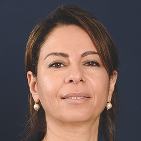
General Manager of the North West Africa Usages Business Unit
First elected as a director: May 12, 2021
Expiration of current term as director: 2025 AGM
Number of shares held: 734
Number of corporate mutual fund units invested in Nexans shares: 314
Age: 49
Nationality: Moroccan
Address: Route de Tit-Mellil – Ain Sebaa – Boulevard Ahl Loghlam – Casablanca 20250 – Morocco
Expertise/Experience
Selma Alami is General Manager of Nexans’ North West Africa Business Unit. She started her career in 2000 in information systems at a software company (SSII) specialized in ERP integration in the medical sector. Attracted by the industrial sector, in 2001 she joined a Moroccan holding company that produced and distributed consumer products to support its mergers and acquisitions projects with regard to IT, processes and internal control. In 2003, she joined Sirmel, the distribution subsidiary of Nexans in Morocco, where she was in charge of upgrading and deploying infrastructures and information systems based on Group standards. She then held the position of CIO Morocco and later CIO MERA, before taking over the general management of the distribution subsidiary in Morocco in 2018.
After leading Sirmel in its transformation and implementation of strategic projects for its profitable growth plan through 2020, she was Deputy General Manager of the North West Africa Business Unit in charge of operations and support functions from March 2020 and became General Manager on January 31, 2022. Selma is an IS engineer and has completed a Master’s degree in Audit and Management of Information Systems at the University of Lille, France.
Directorships and other positions held during the 2024 fiscal year (and still in force at the 2024 year-end)
- –Positions held within the Nexans Group: Director of Sirmel Morocco*, Nexans Morocco* and Nexans Côte d’Ivoire*
Directorships that have expired in the last five years
- –Director of Sirmel Sénégal* and Câbleries du Sénégal*
* Positions held in foreign companies or institutions.
Jane Basson
Independent director
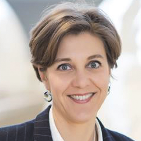
Head of Transformation, Corporate Secretary and member of the Executive Committee of Airbus Defence and Space
First elected as a director: May 13, 2020
Expiration of current term as director: 2028 AGM
Member of the Appointments and Corporate Governance Committee
Member of the Compensation Committee
Member of the Strategy and Sustainable Development Committee
Number of shares held: 500
Age: 55
Nationality: French
Address: Willy-Messerschmitt-Str. 1, 82024 Taufkirchen, Germany
Expertise/Experience
Jane Basson has been Head of Transformation, Corporate Secretary and member of the Executive Committee of Airbus Defence and Space since October 1, 2021. She was previously Chief of Staff to the Chief Operating Officer and Head of People Empowerment in Operations at Airbus and, prior to that, Chief of Staff to the Chief Executive Officer (CEO) (2016-2019).
Jane worked for various law firms and the Business and Industry Advisory Committee to the OECD in Paris before joining Airbus in 2000. She held various roles in Corporate Communications before being appointed Vice President Internal Communications in 2003. In 2008 she moved to human resources to develop a culture change program in support of the company’s business transformation strategy Power8 and was appointed Senior Vice President Leadership Development & Culture Change for the group in June 2012 when she set up the Airbus Leadership University. She also chairs Balance for Business, a 10,000 strong employee-led inclusion and diversity platform at Airbus.
Jane has a degree in International Communications, Journalism and Business Administration. Originally South African, Jane has French nationality and lives in Toulouse, France with her husband and daughter.
Directorships and other positions held during the 2024 fiscal year (and still in force at the 2024 year-end)
- –None
Directorships that have expired in the last five years
- –Censor of Nexans from February 19, 2020 to May 13, 2020
Laura Bernardelli
Independent director

Chief Financial Officer of the Coesia Group
First elected as a director: May 11, 2022
Expiration of current term as director: 2026 AGM
Chairwoman of the Accounts, Audit and Risk Committee
Number of shares held: 510
Age: 55
Nationality: Italian
Address: Via Battindarno, 91 – 40133 Bologna – Italy
Expertise/Experience
Laura Bernardelli is currently Chief Financial Officer of Coesia, a global leader in industrial and packaging automated solutions, starting from April 2022. Laura was the CFO of the Datalogic Group from July 2019 to March 2022 and has been in charge of investor relations since November 2020.
Prior to joining Datalogic, Laura was Senior Vice President Group Controlling, Reporting and Digital Finance at Schneider Electric, from 2017. She joined Schneider Electric in 2014 as Senior Vice President, Finance Building & IT Business.
Prior to Schneider Electric, Laura was Vice President, Corporate Strategy and Business Development at Xylem from 2011, when the company was formed from the spin-off of the water business of ITT Corporation. Laura was subsequently appointed Vice President, Finance and CFO of EMEAI. Laura joined ITT Corporation in 2007 as CFO Italy.
Previously, Laura held positions of increasing responsibility in the finance function at Fiat, General Electric and Eridania Béghin-Say; she has lived and worked internationally for almost 10 years.
Directorships and other positions held during the 2024 fiscal year (and still in force at the 2024 year-end)
- –Member of the Board of Directors of System Ceramics SpA* (Coesia Group)
- –Member of the Board of Directors of Bakel SpA (Italy) since December 16, 2024
Directorships that have expired in the last five years
- –Member of the Board of Directors of Datalogic S.r.l.*
- –Member of the Board of Directors of Datalogic IP Tech S.r.l.*
- –Censor of Nexans from September 20, 2021 to May 11, 2022
Positions held in listed French or foreign companies.
* Positions held in foreign companies or institutions.
Bpifrance Participations
represented by Karine Lenglart

Senior Investment Director, Large Cap, Bpifrance
First elected as a director: May 15, 2019
Expiration of current term as director: 2027 AGM
Member of the Strategy and Sustainable Development Committee
Member of the Appointments and Corporate Governance Committee
Member of the Compensation Committee
Number of shares held by Bpifrance Participations: 2,273,546
Age: 52
Nationality: French
Address: 6-8 boulevard Haussmann, 75009 Paris, France
Expertise/Experience
Karine Lenglart has been a Senior Investment Director, at Bpifrance's Large Cap Capital Development Department, since October 2022. She was previously and since 2016, Head of Mergers and Acquisitions and Investments at the Casino Group and a member of the Executive Committee since 2020.
She began her career in 1996, first at the Dutch investment bank ABN Amro and then at Société Générale investment bank. She then joined the Alstom Group in 2007, where she was Vice-Chair of Mergers and Acquisitions until 2015.
Karine Lenglart is a business school graduate and holds a Master’s degree in Financial Techniques from ESSEC.
Directorships and other positions held during the 2024 fiscal year (and still in force at the 2024 year-end)
- –Censor on the Board of Directors of GGE TCo 1 (Galileo Global Education)
- –Permanent representative of Bpifrance Investissement, member of the Board of Directors of Bureau Veritas and member of the Appointments and Compensation Committee (since June 20, 2024)
- –Permanent representative of Bpifrance Investissement, member of the Supervisory Board of Hygie31
- –Permanent representative of Bpifrance Investissement, member of the Strategic Committee of TSE
Directorships that have expired in the last five years
- –Member of the Board of Directors of Perspecteev (Bankin’)
- –Permanent representative of Bpifrance Investissement, member of the Supervisory Board of EMSponsors
Marc Grynberg
Independent director
Director responsible for monitoring climate and environmental issues

First elected as a director: May 11, 2017
Expiration of current term as director: 2025 AGM
Director responsible for monitoring climate and environmental issues since January 20, 2022
Member of the Strategy and Sustainable Development Committee
Member of the Accounts, Audit and Risk Committee
Number of shares held: 2,000
Age: 59
Nationality: Belgian
Address: 4 allée de l’Arche, 92400 Courbevoie, France
Expertise/Experience
Marc Grynberg was Chief Executive Officer (CEO) of Umicore from November 2008 to October 2021. He was head of the Group’s Automotive Catalysts business unit from 2006 to 2008 and served as Umicore’s CFO from 2000 until 2006. He joined Umicore in 1996 as Group Controller. Marc holds a Commercial Engineering degree from the University of Brussels (École de Commerce Solvay) and, prior to joining Umicore, worked for DuPont de Nemours in Brussels and Geneva.
Directorships and other positions held during the 2024 fiscal year (and still in force at the 2024 year-end)
- –Member of the Supervisory Board of Wienerberger*, member of the Sustainable Development and Innovation Committee and the Audit and Risk Committee
- –Member of the Supervisory Board of Umicore*, member of the Investment Committee and the Audit Committee
Directorships that have expired in the last five years
- –Chief Executive Officer (CEO) of Umicore*
- –Positions held within the Umicore Group*
- –Chairman of the Supervisory Board of Umicore Management AG (Germany)*
- –Chairman of the Board of Directors of Umicore Poland Sp. z.o.o.*, Umicore Japan KK* and Umicore Marketing Services Korea Co. Ltd*
- –Director of Umicore Marketing Services (Hong Kong) Ltd*, and Umicore Korea Ltd*
Positions held in listed French or foreign companies.
* Positions held in foreign companies or institutions.
Oscar Hasbún Martínez
Director proposed by Invexans Limited (Quiñenco Group)

Chief Executive Officer (CEO) of CSAV (Compañía Sud Americana de Vapores S.A.)
First elected as a director: May 15, 2019
Expiration of current term as director: 2027 AGM
Chairman of the Strategy and Sustainable Development Committee
Number of shares held: 500
Age: 55
Nationality: Chilean
Address: Av. Apoquindo 2827, piso 14, Las Condes, Santiago, Chile
Expertise/Experience
Oscar Hasbún Martínez is Chief Executive Officer (CEO) of CSAV (Compañía Sud Americana de Vapores S.A.), member of the Supervisory Board of Hapag-Lloyd AG and a member of its Audit and Finance Committee. From 1998 to 2002, he was Managing Director and member of the Executive Board of the Chilean subsidiary of Michelin. He then joined the Quiñenco Group, where he was in charge of its investments in Croatia. In 2011, he was appointed Chief Executive Officer (CEO) of CSAV, where he oversaw the shipping company’s transformation, restructuring and subsequent merger with Hapag-Lloyd AG. Oscar Hasbún Martínez has a degree in business administration from Universidad Católica of Chile.
Directorships and other positions held during the 2024 fiscal year (and still in force at the 2024 year-end)
- –Positions held within Quiñenco Group companies:
- –Chief Executive Officer (CEO) of CSAV* (Compañía Sud Americana de Vapores S.A.)
- –Member of the Supervisory Board and Deputy Vice-Chairman of the Supervisory Board of Hapag Lloyd AG*
- –Chairman of the Board of Directors of SM SAAM* (Sociedad Matriz SAAM S.A.), a listed company that invests in ports, tug boats and logistics in America
- –Director of Invexans SA*, which owns 100% of Invexans UK Ltd (Nexans’ main shareholder)
- –Director of CCU* (Compañía Cervecerías Unidas S.A.), Compañía Cervecerías de Chile S.A.*, ECCUSA*
- –Advisor of SOFOFA* (professional non-profit federation of Chilean industry and trade unions)
Directorships that have expired in the last five years
- –Director of various subsidiaries of SM SAAM*: SAAM S.A.*, Florida International Terminal LLC*, Sociedad Portuaria de Caldera (SPC) S.A.*, Sociedad Portuaria Granelera de Caldera (SPGC) S.A.*, San Antonio Terminal Internacional S.A.*, San Vicente Terminal Internacional S.A.*
Positions held in listed French or foreign companies.
* Positions held in foreign companies or institutions.
Tamara de Gruyter
Independent director

President Portfolio Business and member of the Executive Committee of Wärtsilä
First appointment as a censor: March 20, 2024
First elected as a director: May 16, 2024
Expiration of current term as director: 2028 AGM
Member of the Appointments and Corporate Governance Committee
Member of the Compensation Committee
Member of the Accounts, Audit and Risk Committee
Number of shares held: 35
Age: 52
Nationality: Dutch
Address: Wärtsilä Netherlands - James Wattlaan 23, 5151 DP Drunen, Netherlands
Expertise/Experience
Tamara de Gruyter is President Portfolio Business and member of the Executive Committee of Wärtsilä.
She began her career in 1996 at LIPS, which was acquired in 2002 by Wärtsilä. Tamara has held various management positions within the company, both in the Maritime and Services sectors. She was Chief Executive Officer (CEO) of two joint ventures in China and of the pumps business in Singapore. Back in Europe, she held various Vice-President positions before becoming Chief Transformation Officer at the end of 2019. Tamara has been a member of the Wärtsilä Executive Committee since 2020 as President Marine Systems. Since January 1, 2024, Tamara has been President Portfolio Business.
Tamara is a graduate of the École polytechnique of Haarlem and holds a degree in shipbuilding engineering.
Directorships and other positions held during the 2024 fiscal year (and still in force at the 2024 year-end)
- –Director of Combient Oy*
- –Positions held within the Wärtsilä Group:
- –Chairwoman of the Board of Directors of Wärtislä Suzhou China*, Wärtislä Gas Solutions Norway*, Wärtsilä SAM Electronics*, Wärtsilä Water Systems*, Wärtsilä Gas Solutions Sweden*
- –Director of Wärtsilä Lyngsoe Marine*, Wärtsilä APSS S.r.l.*
Directorships that have expired in the last five years
- –Chairwoman of the Board of Directors of Trident B.V.*, American Hydro*, Wärtsilä Defence Solutions*
Anne Lebel
Lead Independent Director

Chief Human Resources Officer of the Capgemini Group and member of the Executive Board
First elected as a director: May 17, 2018
Expiration of current term as director: 2026 AGM
Chairwoman of the Appointments and Corporate Governance Committee
Chairwoman of the Compensation Committee
Number of shares held: 500
Age: 59
Nationality: French
Address: 11 rue de Tilsitt, 75017 Paris, France
Expertise/Experience
Anne Lebel has been Chief Human Resources Officer of the Capgemini Group since July 20, 2020. She is also a member of Capgemini’s Executive Board. She began her career in 1987 at Bossard Consultants as an organization and change management consultant. In 1997, Anne joined Schering Plough France as Human Resources and Training Manager for France and later headed up HR organization and development projects in Europe. In 2004, she joined Serono France as Head of Human Resources in France. In 2008, Anne Lebel moved to Allianz Global Corporate & Specialty where she was appointed Head of Human Resources for France, Italy and Spain, and later for Europe and Asia, before becoming Global Head of Human Resources between 2012 and 2016. Anne Lebel joined Natixis in 2016 as Chief Human Resources Officer and a member of Natixis’ Executive Board. In 2019, she also took over as Natixis’ Corporate Culture Officer. Anne Lebel is a graduate of the Institute of Political Studies in Strasbourg and holds a postgraduate diploma in Business Management and Administration (DESS CAAE) from the Institut d’Administration des Entreprises in Paris.
Directorships and other positions held during the 2024 fiscal year (and still in force at the 2024 year-end)
- –Positions held within the Capgemini Group:
- –Member of the Supervisory Board of Capgemini Gouvieux SAS
- –Director of Altran Engineering Solutions Incorporated*, Altran UK Limited*, Altran (Singapore) Pte. Ltd.*, Altran Engineering Solutions Japan Limited*, Altran Israel Limited*, Capgemini Suisse SA*, Capgemini Portugal SA*, Capgemini Services Malaysia Sdn Bhd*, Capgemini (China) Co. Ltd.*, Capgemini Technology Services India Limited*
- –Director of Knowledge Expert SA* (until December 31, 2024)
Directorships that have expired in the last five years
- –Director of Natixis Assurances
- –Altran Switzerland AG*: director from November 3, 2021 to April 1, 2022
- –Chappuis Halder Inc.*
- –Braincourt (Switzerland) AG*
Andrónico Luksic Craig
Director proposed by Invexans Limited (Quiñenco Group)
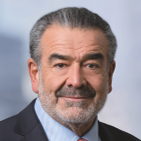
Former Chairman of the Board of Directors of Quiñenco
First elected as a director: May 14, 2013
Expiration of current term as director: 2025 AGM
Number of shares held: 6,740
Age: 70
Nationality: Chilean
Address: Enrique Foster Sur 20, piso 16, Las Condes, Santiago, Chile
Expertise/Experience
Andrónico Luksic Craig was Chairman of the Board of Directors of Quiñenco for more than 10 years, one of the main conglomerates in Chile, and has been a member of the Board of Directors from 1978 to December 2023. He resigned from the Board of Directors of Quiñenco, Banco de Chile, Compañía Cervecerías Unidas S.A. (CCU), Compañía Sudamericana de Vapores S.A. (CSAV), LQ Inversiones Financieras and Invexans.
Outside the Quiñenco Group, Andrónico Luksic Craig is an active member of several leading organizations and advisory boards, both nationally and internationally, including the International Advisory Councils of the Brookings Institution, the Americas Society and the China Investment Corporation (CIC), as well as the Advisory Board of the Panama Canal Authority. Andrónico Luksic Craig is extremely committed to education. He is involved in educational foundations that he helped to create and takes part in advisory committees for Columbia and Harvard Universities, MIT, the University of Oxford, Tsinghua University, Fudan University and Babson College.
Directorships and other positions held during the 2024 fiscal year (and still in force at the 2024 year-end)
- –Director of Antofagasta Minerals S.A.* and Antofagasta Plc*
- –Director of the Luksic Foundation*
- –Member of the International Advisory Council of the Brookings Institution*, the International Advisory Council of the China Investment Corporation* (CIC), the China National Financial Regulatory Administration, the Advisory Board of the Panama Canal Authority* and the Chairman’s International Advisory Council of the Council of the Americas*
- –Member of the Global Advisory Council of Harvard University*, the World Projects Council of Columbia University*, the International Advisory Board of the Blavatnik School of Government* at the University of Oxford, the Advisory Board of the School of Economics and Management at Tsinghua University* and the Guanghua School of Management at PKU in Beijing, and of the School of Management at Fudan* University in Shanghai
- –Member of the Americas Executive Board at the MIT Sloan School of Management*
- –Emeritus Trustee of Babson College*
- –Member of Harvard Kennedy School Dean’s Council*
- –Member of the Global Board of Advisors of the Council on Foreign Relations*
Directorships that have expired in the last five years
- –Chairman of the Board of Directors of Quiñenco S.A.*
- –Chairman of the Board of Directors of LQ Inversiones Financieras* and CCU* (Compañía Cervecerías Unidas S.A.)
- –Vice-Chairman of the Board of Directors of Banco de Chile* and CSAV* (Compañía Sud Americana de Vapores S.A.)
- –Director of Invexans S.A.*
- –Director of Tech Pack S.A.* and SM Chile*
- –Member of the Chilean Federation of Manufacturers – SOFOFA* (Sociedad de Fomento Fabril) and the Chile-Pacific Foundation*
- –Advisor to the Board of Directors of Inversiones Río Argenta* (the parent company of Enex*)
- –Member of the International Advisory Board of Barrick Gold*
- –Vice-Chairman of the Board of Directors of the Amparo y Justicia Foundation* (ABC) and the Luksic Scholars Foundation* (GMA)
- –Member of the International Business Leaders’ Advisory Council of the municipality of Shanghai*
Positions held in listed French or foreign companies.
* Positions held in foreign companies or institutions.
Elisabetta Iaconantonio
Director representing employees

Chartered accountant at the Pioltello site in Italy
First elected as a director: May 16, 2024
Expiration of current term as director: 2028 AGM
Number of Nexans shares held: 0
Number of corporate mutual fund units invested in Nexans shares: 0
Age: 42
Nationality: Italian
Address: Via Piemonte 20, 20096 Pioltello, Italy
Expertise/Experience
Elisabetta Iaconantonio, an Italian national, is a General Accounting Specialist at the Pioltello industrial site in Italy. She has 14 years of experience within the Nexans Group. A graduate in Economics with distinction, she began her career as an auditor at KPMG in Milan, Italy, and joined Nexans in 2011 as a management controller, then as a specialist in general accounting.
In 2009, she founded Officine Buone, a volunteer organization bringing together more than 50 hospitals and implementing social innovation projects that strengthen the humanization of patient care.
Directorships and other positions held during the 2024 fiscal year (and still in force at the 2024 year-end)
- –Chairwoman of Officine Buone Onlus (non-profit organization)*
Directorships that have expired in the last five years
- –None
* Positions held in foreign companies or institutions.
Francisco Pérez Mackenna
Director proposed by Invexans Limited (Quiñenco Group)

Chief Executive Officer (CEO) of Quiñenco
First elected as a director: May 31, 2011
Expiration of current term as director: 2025 AGM
Member of the Accounts, Audit and Risk Committee
Member of the Appointments and Corporate Governance Committee
Member of the Compensation Committee
Member of the Strategy and Sustainable Development Committee
Number of shares held: 500
Age: 66
Nationality: Chilean
Address: Enrique Foster Sur 20, piso 14, Las Condes, Santiago, Chile
Expertise/Experience
Francisco Pérez Mackenna has served as Chief Executive Officer (CEO) of the Chilean company Quiñenco S.A. since 1998. Since December 29, 2023, he has been the Chairman of the Board of Directors of CCU (Compañía Cervecerías Unidas S.A.) and LQ Inversiones Financieras, as well as Vice-Chairman of the Board of Directors of Banco de Chile. He is also a director of several companies in the Quiñenco Group, including Tech Pack, CSAV (Compañía Sud Americana de Vapores), SM SAAM (Sociedad Matriz SAAM S.A.) and Enex (Empresa Nacional de Energía Enex S.A.). Before joining Quiñenco, between 1991 and 1998, Francisco Pérez Mackenna was Chief Executive Officer (CEO) of CCU.
Directorships and other positions held during the 2024 fiscal year (and still in force at the 2024 year-end)
- –Chief Executive Officer (CEO) of Quiñenco S.A.*
- –Positions held within the Quiñenco Group:
- –Chairman of the Board of Directors of CSAV* (Compañía Sud Americana de Vapores S.A.), CCU* (Compañía Cervecerías Unidas S.A.), LQ Inversiones Financieras S.A.*, ENEX* (Empresa Nacional de Energía Enex S.A.), Invexans S.A.*, Invexans Ltd* and Tech Pack S.A.*
- –Vice-Chairman of the Board of Directors of Banco de Chile*
- –Director of SM SAAM* (Sociedad Matriz Sudamericana Agencias Aéreas y Marítimas S.A.)
- –Member of the Supervisory Board of Hapag-Lloyd AG*
Directorships that have expired in the last five years
- –None
Positions held in listed French or foreign companies.
* Positions held in foreign companies or institutions.
Hubert Porte
Director

Chairman of Eramet Chile S.A.
Founding Partner and Chief Executive Officer (CEO) of Ecus Capital
First elected as a director: November 10, 2011
Expiration of current term as director: 2027 AGM
Member of the Strategy and Sustainable Development Committee
Number of shares held: 571
Age: 60
Nationality: French
Address: Enrique Foster Norte 0115, 5th floor, Las Condes, Santiago, Chile
Expertise/Experience
Hubert Porte is Founding Partner and Chief Executive Officer (CEO) of the private equity firm Ecus Capital, which was founded in 2004 and invests in Chile through private equity funds. Hubert Porte is a director of the Chilean company AMA Time. He is also managing partner of Latin American Asset Management Advisors and Ecus Investment Advisors, which distribute UCITS for the Chilean, Peruvian and Colombian institutional markets. Since 2018, Hubert Porte has been supporting the Eramet Group in Chile to develop a lithium project and he is Chairman of Eramet Chile S.A.
Directorships and other positions held during the 2024 fiscal year (and still in force at the 2024 year-end)
- –Chairman of Eramet Chile S.A.*
- –The following positions in Chilean companies whose financial investments are managed by Ecus Capital*:
- –Chairman of AMA Time SpA* (agri-food company)
- –Managing Partner of Latin America Asset Management Advisors* and Ecus Investment Advisors*
Directorships that have expired in the last five years
- –Director of Loginsa S.A. Chile*
Positions held in listed French or foreign companies.
* Positions held in foreign companies or institutions.
4.4.1.3Independence
The characterization of the independent director is discussed by the Appointments and Corporate Governance Committee and reviewed by the Board of Directors each year, prior to the preparation of the report on corporate governance, and whenever a new director is appointed.
On January 15, 2025, the Board of Directors reviewed the individual status of each of its members in light of the independence criteria defined by Recommendation 10 of the AFEP-MEDEF Code, detailed below:
Criterion 1 – Employee or corporate officer over the past five years
Not to be, or not to have been during the previous five years, an employee or executive officer of the Company, nor an employee, executive officer or director of a company consolidated by the Company, or of the parent company of the Company, or a company consolidated by this parent company.
Criterion 2 – Cross-directorships
Not be an executive corporate officer of a company in which the Company directly or indirectly holds a directorship, or in which an employee appointed as such or an executive corporate officer of the Company (current or having been for less than five years) has held a directorship.
Criterion 3 – Significant business ties
Not to be (or to be directly or indirectly related to) a customer, supplier, investment or financing banker, or significant advisor to the Company or its Group, or for which the Company or its Group represents a significant portion of activity.
Criterion 4 – Family ties
Not to have close family ties with a corporate officer.
Criterion 5 – Statutory Auditors
Not to have been a Statutory Auditor of the Company during the previous five years.
Criterion 6 – Term of office more than 12 years
Not to have been a director of the Company for more than 12 years.
Criterion 7 – Compensation linked to the Company's or Group's performance
A non-executive corporate officer cannot be considered independent if he or she receives variable compensation in cash or securities or any compensation linked to the performance of the Company or the Group.
Criterion 8 – Status of significant shareholder
Directors who are major shareholders of the Company or its parent company may be considered independent if these shareholders have no involvement in the management of the Company. However, beyond 10% of the share capital or voting rights, the Board, based on a report by the Appointments, Compensation and Governance Committee, systematically examines the independent status taking into account the composition of the Company’s share capital and the existence of a potential conflict of interest.
The following table summarizes the situation of each Director with regard to the independence criteria set out in Recommendation 10 of the AFEP-MEDEF Code, as of December 31, 2024:
Criterion
Employee or corporate officer over the past five years
Cross-
directorshipsSignificant business ties
Family ties
Statutory Auditors
Term of office more than 12 years
Compensation linked to the Company’s or Group’s performance
Status of significant shareholder
Jean Mouton
Angéline Afanoukoé
✓
Selma Alami
✓
Jane Basson
Laura Bernardelli
Bpifrance Participations
✓
Tamara de Gruyter
Marc Grynberg
Oscar Hasbún Martínez
✓
Elisabetta Iaconantonio
✓
Anne Lebel
Andrónico Luksic Craig
✓
✓
Francisco Pérez Mackenna
✓
✓
Hubert Porte
✓
The Board conducted a quantitative and qualitative review of the business relationships between the groups and entities in which the members of the Board are senior managers, by analyzing the offices held by each, their duration, as well as the revenue generated between Nexans and the entities concerned.
- ●the following Directors are qualified as independent: (1) Jean Mouton, (2) Jane Basson, (3) Laura Bernardelli, (4) Tamara de Gruyter, (5) Marc Grynberg and (6) Anne Lebel;
- ●the Board of Directors considered that Jean Mouton, Marc Grynberg and Laura Bernardelli were independent given the absence of business relations during the 2024 fiscal year between Nexans and the companies and organizations in which they held offices in 2024,
- ●Jane Basson is Head of Transformation, Corporate Secretary and member of the Executive Committee of Airbus Defence and Space, an Airbus Group company, which is one of the Nexans Group’s customers. The Board of Directors has examined the significant business relationships between Nexans and Airbus, using both quantitative and qualitative criteria.
- In 2024, the Nexans Group generated less than 0.1% of its revenue through direct sales to Airbus and less than 1% of its revenue through indirect sales to various Airbus subcontractors. As a result, the Board of Directors does not consider the business relationship to be significant for the purpose of the independence criteria.
- The Board of Directors also took into account other criteria such as the length and continuity of the relationship between the two companies as it is a longstanding relationship dating back prior to Jane Basson’s appointment as a director of Nexans. The Board of Directors also took into consideration Jane Basson’s duties as Head of Transformation, Corporate Secretary and member of the Executive Committee of Airbus Defence and Space. This position does not give her direct decision-making power over the commercial agreements or projects that correspond to the business relationship between Nexans and Airbus. She does not receive any compensation in relation to any agreements, connections or business relationships that may exist between Nexans and Airbus.
- Lastly, to maintain her character of independence, Jane Basson has undertaken not to participate in (i) the preparation of projects or contracts to be entered into by Airbus or any company in the Airbus Group or by its subcontractors with Nexans or a Nexans Group company, (ii) the work performed by Airbus under a contract signed with Nexans or any Nexans Group company, or (iii) any votes on matters discussed by the Board of Directors of Nexans relating to projects in which Airbus would or could be directly or indirectly interested, as a client,
- ●Tamara de Gruyter is President Portfolio Business of Wärtsila, which is one of the Nexans Group’s clients. The Board of Directors has assessed whether there were any significant business relationships between Nexans and Wärtsila using both quantitative and qualitative criteria. In 2024, the Nexans Group generated less than 0.1% of its revenue through direct sales to Wärtsila and less than 1% of its revenue through indirect sales to various Wärtsila subcontractors. As a result, the Board of Directors does not consider the business relationship to be significant for the purpose of the independence criteria.
- The Board of Directors also took into account other criteria such as the length and continuity of the relationship between the two companies as it is a longstanding relationship dating back prior to Tamara de Gruyter’s appointment as a director of Nexans. The Board of Directors also took into consideration the functions of Tamara de Gruyter within Wärtsila as President Portfolio Business and member of the Executive Committee of Wärtsila. This position does not give her direct decision-making power over the commercial agreements or projects that correspond to the business relationship between Nexans and Wärtsila. She does not receive any compensation in relation to any agreements, connections or business relationships that may exist between Nexans and Wärtsila.
- Lastly, to maintain her character of independence, Tamara de Gruyter has undertaken not to participate in (i) the preparation of projects or contracts to be entered into by Wärtsila or any company in the Wärtsila Group or by its subcontractors with Nexans or a Nexans Group company, (ii) the work performed by Wärtsila under a contract signed with Nexans or any Nexans Group company, or (iii) any votes on matters discussed by the Board of Directors of Nexans relating to projects in which Wärtsila would or could be directly or indirectly interested, as a client,
- ●Anne Lebel is Chief Human Resources Officer and a member of the Executive Management Committee of Capgemini, a service provider to Nexans. The Board of Directors has assessed whether there were any significant business relationships between Nexans and Capgemini using both quantitative and qualitative criteria. Capgemini’s net revenue generated by its activities with Nexans in 2024 was less than 0.01% of Capgemini’s total net revenue. The relationship between Nexans and Capgemini is not significant for Capgemini. Furthermore, Capgemini is one of Nexans' regular suppliers and a competitive bidding procedure automatically takes place between the various suppliers for each project or contract, in accordance with the Nexans Group's procurement policy. The Board of Directors does not consider this business relationship to be significant for the purpose of the independence criteria. In addition, the Board of Directors took into account other criteria such as the longevity and continuity of the relationship between these two companies, which predates the appointment of Anne Lebel as director. In addition, to preserve her character of independence, Anne Lebel has agreed not to participate in (i) the preparation or solicitation of Capgemini services from Nexans or any of the Group's companies, (ii) the provision of services by Capgemini (iii) and votes on any decision of the Board of Nexans concerning a project in which Capgemini is or could be involved as a service provider.
At December 31, 2024, six of Nexans’ eleven Directors were independent, representing an independence rate of more than 54.5%.(1) This exceeds the 50% recommended by the AFEP-MEDEF Code for widely held companies.
The Directors qualified as non-independent are: (1) Oscar Hasbún Martínez, (2) Andrónico Luksic Craig, and (3) Francisco Pérez Mackenna, these three Directors being proposed by the main shareholder Invexans Limited (Quiñenco Group); (4) Bpifrance Participations, which holds 5.19% of the share capital and voting rights of Nexans; (5) Hubert Porte, Director of the Company for 13 years, who lost his status as independent director as of November 11, 2023, in accordance with Article 10.5.6 of the AFEP-MEDEF Code; and lastly (6) Angéline Afanoukoé, (7) Selma Alami, and (8) Elisabetta Iaconantonio as Group employees.
-
4.5Transactions in the Company’s securities by corporate officers and senior managers
In accordance with Article 223-26 of the AMF General Regulations, transactions in the Company’s securities carried out and disclosed to the AMF during the 2024 fiscal year by the corporate officers and senior managers referred to in Article L.621-18-2 of the French Monetary and Financial Code are listed in the following table.
Date of transaction
Type of
transactionFinancial
instrumentNumber (of corporate mutual fund units or shares)
Total
gross amount(in euros)
Juillard Jean-Christophe
Deputy Chief Executive Officer
and Chief Financial Officer
02/22/2024
Sale
Equities
2,500
€237,127.50
Dessale Vincent
Chief Operating Officer and Senior Executive VP
03/13/2024
Sale
Equities
2,500
€237,531.25
Juillard Jean-Christophe
Deputy Chief Executive Officer
and Chief Financial Officer
03/14/2024
Sale
Equities
500
€47,525.00
Dessale Vincent
Chief Operating Officer and Senior Executive VP
03/17/2024
Purchase
Equities
4,700
€0.00(a)
Juillard Jean-Christophe
Deputy Chief Executive Officer
and Chief Financial Officer
03/17/2024
Purchase
Equities
6,580
€0.00(a)
Guérin Christopher
Chief Executive Officer (CEO)
03/17/2024
Purchase
Equities
18,800
€0.00(a)
Guérin Christopher
Chief Executive Officer (CEO)
03/21/2024
Sale
Equities
5,000
€501,500.00
Juillard Jean-Christophe
Deputy Chief Executive Officer
and Chief Financial Officer
09/05/2024
Sale
Equities
1,580
€193,779.89
Guérin Christopher
Chief Executive Officer (CEO)
09/05/2024
Sale
Equities
15,405
€1,831,375.47
De Gruyter Tamara
Director
10/11/2024
Purchase
Equities
35
€4,700.50
Mouton Jean
Chairman of the Board of Directors
11/15/2024
Donation
Equities
2,720
€318,784.00
Bpifrance Participations
11/15/2024
Sale
Equities
1,090,000
€125,731,500.00
Mouton Jean
Chairman of the Board of Directors
11/28/2024
Donation
Equities
752
€80,764.80
- (a)Shares vested under Compensation Plan no. 20 of March 17, 2020 with an underlying share value of €92.65 (see Section 4.6 below for more information on the conditions of this plan).
Pursuant to Article 11 of the Company’s Bylaws, all directors – except the directors representing employees – must own at least 10 shares. This principle is respected by all directors. Furthermore, the Directors’ Charter appended to the Board of Directors’ Internal Regulations recommends that each Board member should own at least 500 shares.
-
4.6Compensation and benefits
4.6.1Compensation policy for corporate officers for 2025
The 2025 Compensation policy for corporate officers was decided by the Board of Directors at its meeting on February 18, 2025, based on the recommendation of the Compensation Committee. In accordance with Article L.22-10-8 of the French Commercial Code, the policy presented in this section will be submitted for approval at the 2025 Shareholders’ Meeting.
4.6.1.1Compensation policy for members of the Board of Directors
At December 31, 2024, the Company had 14 directors. The aggregate annual amount of compensation for Board members was set at 820,000 euros at the Shareholders’ Meeting held on May 16, 2024, effective from the fiscal year that commenced on January 1, 2024.
The rules for determining and allocating directors’ compensation is approved by the Board of Directors and only reviewed in the event of a change in the conditions and in the organization of the work performed by the Board of Directors and its Committees. These rules generally include the calculation of a fixed compensation and a predominant variable compensation based on directors’ attendance at Board meetings and Committees.
The allocation rules of directors’ compensation will remain unchanged for 2025 and will be as follows from January 1, 2025, being subject to the vote at the Shareholders’ Meeting. Each of the directors will receive:
- ●fixed compensation of 13,000 euros per year;
- ●3,500 euros for each Board meeting attended, capped at an aggregate 26,000 euros per year;
- ●3,500 euros per Committee meeting attended for Committee members, capped at an aggregate 21,000 euros per year;
- ●9,000 euros per Committee meeting for the Chairman of the Accounts, Audit and Risk Committee, capped at 36,000 euros per year;
- ●6,000 euros per Committee meeting attended for the other Committee Chairs, capped at an aggregate 36,000 euros per year.
When the meeting of the Appointments and Corporate Governance Committee and the Compensation Committee are held on the same day, the members of the Compensation Committee do not receive any additional compensation to the amount received for the meeting of the Appointments and Corporate Governance Committee. If the meeting of the Compensation Committee is held on a different day than the day of the meeting of the Appointments and Corporate Governance Committee, the members of the Compensation Committee shall be compensated in accordance with the provisions of this paragraph.
The Lead Independent Director and the climate and environmental Director will receive additional compensation of 35,000 euros each per year. Directors representing employees and employee shareholders do not receive any compensation as Directors or Committee members.
The Chairman of the Board of Directors does not receive any compensation as a Board member. His compensation as Chairman of the Board of Directors is detailed in Section 4.6.2.1 below.
Non-executive officers do not receive any compensation from the Company or its subsidiaries other than that shown above, apart from directors representing employees and employee shareholders, who receive compensation from the subsidiary that employs them.
Lastly, members of the Board of Directors may be reimbursed by the Company for travel expenses incurred during their duties, subject to the production of all necessary supporting documents, under the conditions laid down in the travel expenses reimbursement policy for the Company’s Board members. Travel expenses that may be reimbursed include plane tickets for domestic and international air travel, train tickets, public transport, taxis and driven cars, as well as accommodation and meal costs.
4.6.1.2Compensation policy for executive corporate officers
Principles applicable to all executive officers
The Compensation Committee are organized around three to four work meetings throughout the year and intermediate preparatory working sessions carried out by the Chairwoman of the Committee. The compensation policy for Nexans’ executive corporate officers for the 2025 fiscal year was reviewed by the Compensation Committee during three meetings between October 2024 and February 2025, before being proposed to and approved by the Board of Directors.
The Board takes constant care to ensure that the various components of compensation for executive corporate officers are competitive, fair, comprehensible, consistent and performance oriented. Compensation components for executive corporate officers, whether vested or awarded, are made public after the related decision of the Board of Directors.
In accordance with Article L.22-10-8 III of the French Commercial Code, in exceptional circumstances, the Board of Directors may, on the recommendation of the Compensation Committee, adapt certain provisions of the compensation policy in alignment with the main principles of the compensation policy, provided that this exemption is temporary, in accordance with the corporate interest and necessary to guarantee the sustainability or viability of the Company.
Compensation of non-executive officers
To propose the compensation structure for the Chairman of the Board of Directors, the Compensation Committee relies on benchmarks, provided by external consultants, indicating market practices in comparable companies. It also considers the specific duties entrusted to the Chairman of the Board as detailed in the Internal Regulations available on the website www.nexans.com.
The Chairman of the Board receives a fixed annual compensation. He does not receive variable compensation. He does not receive additional compensation as member of the Board of Directors.
Compensation of executive officers
When the Compensation Committee proposes to the Board the compensation for executive officers, it ensures that the rules applied are consistent and aligned with the Company performance. It also takes into account Company’s strategic, financial and corporate social responsibility objectives, the interests of shareholders and other stakeholders in compliance with the AFEP-MEDEF Code.
The Committee reviewed the positioning of the compensation of executive corporate officers by comparing them with the median of a panel of 15 French and international companies which were defined according to four main criteria: project-based, industrial companies of comparable size and attractiveness. This panel was updated in 2023 to make it more relevant to the Group’s electrification and project oriented activities.
Industry
Size
Process
Cable & Electrification
Projects
Size
Market capitalization
Alstom SA
●
●
●
Arkema SA
●
●
BIC SA
●
●
●
Bureau Veritas
●
Imerys SA
●
●
●
ISS A/S
●
●
●
Legrand SA
●
●
Plastic Omnium SE
●
●
●
Prysmian SpA
●
●
Rexel SA
●
●
SEB SA
●
●
●
SPIE SA
●
●
●
Technip FMC
●
●
●
Valeo SE
●
●
Vallourec SA
●
●
●
●
Figure 1: Reference panel selection criteria.
The Committee ensures that none of the components of the compensation package is disproportionate and analyzes the compensation package as a whole by taking into account all of its components: fixed compensation, annual variable compensation, long-term incentive plan, supplementary pension plan and benefits-in-kind. Variable components make up a predominant portion of the compensation paid to executive officers.
Fixed compensation
The fixed compensation package for executive officers is determined in consideration of the level and complexity of responsibilities, experience in the position, and market practices for comparable groups and companies. It is only reviewed every three years. However, an early review is possible if the scope of responsibilities changes significantly or if the comparison of compensation with the benchmark panel reveals a significant gap.
Annual variable compensation
Executive officers are entitled to annual variable compensation for which the Board of Directors, on the recommendation of the Compensation Committee, defines each year performance criteria that are diverse, demanding, precise and pre-defined, resulting from a comprehensive performance analysis, aligned with the Company’s challenges, strategy, and shareholders’ interests. The assessment of the performance is based on a balance between predominant collective criteria and individual criteria, both operational and managerial.
The Board of Directors defines target, minimum and maximum rates of the annual variable compensation as a percentage of the annual fixed compensation. It determines the proportion of collective and individual objectives as well as all related criteria.
Payment of the annual variable compensation due to executive officers is subject to approval by the Annual Ordinary Shareholders’ Meeting.
Long-term compensation in shares
The Group’s long-term compensation policy is part of a global strategy to retain, motivate and engage executives and employees. It is competitive with regard to market practices, aligned with the corporate interest of the Company and its shareholders. Each long-term compensation plan, taking the form of performance shares awards, is subject to prior approval of shareholders at the Annual Shareholders’ Meeting.
Performance shares awarded to each executive officer are valued in IFRS 2 at the date of the board of Directors approval and must not represent a disproportionate percentage of the overall compensation and shares awarded.
Performance and free share plans are awarded every year, within a same calendar period, except in case of exceptional circumstances.
Executive corporate officers who receive performance shares formally undertake not to use hedging instruments during the vesting period. By extension, employees who have received performance shares do not have the option to use hedging instruments during the vesting period.
Executive corporate officers may not sell their vested shares during “blackout” periods, in accordance with the applicable legal and regulatory requirements and the Group’s “Insider dealing” procedures.
Executive corporate officers who are removed from their position forfeit their right to any shares that have not yet vested at the date of their removal. On retirement, rights to performance shares are maintained and calculated on a pro rata temporis basis, unless the Board of Directors decides otherwise with good reason. On departure for other reasons, performance share rights are maintained unless the Board of Directors decides otherwise, upon the recommendation of the Compensation Committee.
Shareholding obligation
In accordance with the law and procedures periodically adopted by the Board of Directors, executive officers must hold an increasing number of shares.
Executive corporate officers are required to hold, in registered form and for as long as they remain executive corporate officers, 25% of vested performance shares. This requirement applies unless the Board of Directors decides otherwise in view of the executive officer’s situation and particularly taking into account the objective of holding an increasing number of shares acquired under such plans.
Exceptional compensation
Highly specific circumstances may warrant the award of exceptional compensation to executive corporate officers (e.g. due to their importance for the Company; the required involvement and the difficulties they represent). The allocation of exceptional compensation is non-recurring, justified and disclosed by the Board.
Payment would be subject to approval by the Annual Ordinary Shareholders’ Meeting. It would be capped at a maximum amount of 100% of the fixed compensation.
Exceptional premium for taking up a position
Exceptional premium for taking up a position may only be granted to a new executive corporate officer who has been appointed from a company outside the Group. The payment is intended to compensate the executive officer for the loss of his or her entitlements before joining the Group.
It is explicitly indicated and the amount is made public at the time it is determined. It cannot be higher than the value of the entitlements lost by the new executive corporate officer upon leaving his or her previous position.
Commitments given to executive corporate officers
All commitments given to executive corporate officers are authorized by the Board of Directors and submitted for approval to the Annual Ordinary Shareholders’ Meeting. Details can be found in Section 4.6.4.4 of this document.
Termination and non-compete indemnities
In accordance with the AFEP-MEDEF Code, the total termination and non-compete indemnities may not exceed two (2) years’ worth of actual compensation (fixed and variable).
Termination indemnity
The payment to an executive officer of a termination indemnity is conditional on the acknowledgment by the Board that the performance conditions determined by the Board have been satisfied and can only occur in case of forced departure linked to a change of control or a change of strategy with it being specified that this condition will be deemed to be met unless otherwise decided by the Board of Directors, particularly in the case of serious misconduct.
The termination indemnity may not exceed two years of effective compensation (fixed and variable) (see Section 4.6.4.4 “Termination indemnity”).
Non-compete indemnity
The Chief Executive Officer (CEO) has undertaken not to exercise any business that would compete either directly or indirectly with any of the Company’s businesses for a period of two years from the end of his term of office as the Chief Executive Officer (CEO). In return for his undertaking, he will receive a non-compete indemnity which will be paid in 24 equal and successive monthly installments and will not exceed one year of his total fixed and variable compensation. The Board could decide to impose a non-competition obligation on the Chief Executive Officer (CEO for a shorter period than two years. In such a case, the non-compete indemnity would be reduced pro rata temporis (see Section 4.6.4.4 “Non-compete indemnity”).
Supplementary pension plan
Executive corporate officers benefit from an “Article 82” supplementary pension plan set up on September 1, 2018. The annual contribution paid by the Company corresponds to 20% of the total annual compensation of the beneficiaries. (See Section 4.6.4.4 “Pension plan”).
Pension and welfare plans and unemployment insurance plan
Executive corporate officers benefit from Group pension, welfare plans and life plans (medical, disability, disability and life) under the same terms and conditions as Nexans employees. They are also covered by an unemployment insurance plan. (See Section 4.6.4.4 “Pension and welfare plans and unemployment insurance plan”).
Benefits-in-kind
Other components of compensation
Executive corporate officers do not benefit from multi-year or deferred variable compensation in cash. The Board of Directors prefers to use a share-based mechanism to strengthen the alignment of executive corporate officers with shareholders' interests. They are also not entitled to any compensation in respect of their term of office as Director.
Discontinuance of the employment contract in case of appointment to a corporate office
When a senior executive of the Group becomes Chief Executive Officer (CEO), Deputy Chief Executive Officer (Directeur Général Délégué) or Chairman and Chief Executive Officer (CEO) of the Company, the employment contract with the Company is terminated either contractually or by resignation, unless the Board of Directors decides otherwise with a motivated decision.
The results of the votes on the compensation policies submitted at the Shareholders’ Meeting of May 16, 2024 are presented below:
Resolution
Policy to be voted
% of votes for
9
Approval of the information relating to the components of compensation paid to corporate officers during, or awarded in respect of, the fiscal year ended December 31, 2023
97.47%
10
Approval of the components of compensation paid during, or awarded in respect of, the fiscal year ended December 31, 2023 to Jean Mouton, Chairman of the Board of Directors
98.88%
11
Approval of the components of compensation paid during, or awarded in respect of, the fiscal year ended December 31, 2023 to Christopher Guérin, Chief Executive Officer (CEO)
94.89%
12
Approval of the compensation policy for the members of the Board of Directors for the 2024 fiscal year
99.07%
13
Approval of the compensation policy for the Chairman of the Board of Directors for the 2024 fiscal year
98.85%
14
Approval of the compensation policy for the Chief Executive Officer (CEO) for the 2024 fiscal year
96.23%
4.6.1.3Appendix to the compensation policy for executive corporate officers: Components set for 2025
Compensation of the Chairman of the Board of Directors
Pursuant to the Board of Directors’ decision on February 18, 2025, the fixed annual compensation of Jean Mouton as Chairman of the Board of Directors for 2025 has been set at 320,000 euros. This compensation has remained unchanged since January 1, 2022.
Compensation of the Chief Executive Officer (CEO)
The structure of the compensation of Christopher Guérin as Chief Executive Officer (CEO) was reviewed on February 14, 2024, and approved at the Shareholders' Meeting on May 16, 2024. Pursuant to the compensation policy for executive corporate officers, the compensation of Christopher Guérin was remained unchanged for a period of three years, from 2021 to 2023.
The 2025 compensation policy was reviewed by the Compensation Committee during three meetings between October 2024 and February 2025, before being proposed and approved by the Board of Directors.
At its meeting of February 18, 2025, the Board of Directors, on the recommendation of the Compensation Committee, set the new compensation policy for 2025 for Christopher Guérin in line with the compensation policy approved in 2024 and in line with the “Sparking Electrification” strategic plan announced on November 13, 2024 during the Capital Markets Day.
Structure of the 2025 compensation of the Chief Executive Officer (CEO)
On the recommendation of the Compensation Committee, the Board of Directors decided to maintain the compensation structure approved by the Shareholders’ Meeting of May 16, 2024, ensuring the balance of short-term and long-term variable compensation. The portion of the fixed, maximum short-term variable and maximum long-term variable components (excluding exceptional compensation) in the Chief Executive Officer's (CEO) total compensation is the following:
Fixed compensation
At its meeting of February 18, 2025, the Board of Directors set the fixed compensation of Christopher Guérin at 950,000 euros for 2025. This compensation, reviewed on February 14, 2024 and approved by the Shareholders’ Meeting of May 16, 2024, remains unchanged in 2025. Pursuant to the compensation policy, it is only reviewed every three years.
Variable compensation
At its meeting of February 18, 2025, the Board of Directors set the structure and objectives of Christopher Guérin’s annual variable compensation for 2025. The target rate of the annual variable compensation remains unchanged at 100% of the annual fixed compensation. The annual variable compensation may vary from 0% to 150% of the fixed annual compensation according to the achievement of demanding objectives set by the Board of Directors. This is made of collective objectives representing 65% of the target variable compensation and individual objectives representing 35%.
Target amounts for the selected objectives are those of the 2025 budget approved by the Board of Directors. All targets are set with a minimum and maximum threshold in order to ensure that performance is appropriately rewarded (see Figure 3).
Variable compensation structure and objectives
The Board of Directors decided, on the recommendation of the Compensation Committee, to revise the indicators of the collective portion as well as their breakdown in order to ensure the alignment of the Chief Executive Officer’s (CEO) annual variable compensation with Nexans’ ambitions for 2028 as communicated on November 13, 2024 through “Sparking Electrification”, the third phase of its long-term strategy to build the global pure player in electrification.
The Board of Directors has decided to include the criterion of organic growth in the annual variable compensation. This organic growth criterion expressed in percentage of growth, aligned with the Group's long-term strategy, aims at ensuring its operational implementation.
In 2025, the collective portion of the annual variable compensation is then made up of five criteria: organic growth expressed as a percentage of growth, ROCE, EBITDA, free cash flow and net income expressed in euros.
Minimum and maximum targets are defined by the Board of Directors in absolute value within predefined brackets set for each indicator and aligned with the annual budget approved by the Board of Directors. For confidentiality reasons, Financial annual targets are disclosed within the ex-post compensation.
Bonus payment trigger threshold may not be lower than 50% of the organic growth target, 90% of the ROCE, EBITDA and net income targets, and 80% of the Free Cash Flow target. In the event of outperformance, the bonus payment threshold may not exceed 150% of the organic growth target, 110% of the ROCE, EBITDA and net income targets, and 120% of the FCF target.
Below the trigger threshold, no bonus is paid out, then the bonus follows a linear interpolation from 0% to 150% of the basic salary between the respective minimum and maximum thresholds is followed.
Criteria
Weighting
Minimum
Target
Maximum
Collective objectives
65%
0% of target compensation
100% of target compensation
150% of target compensation
Organic growth (in %)
10%
50%
Budget
150%
ROCE (in %)
20%
90%
Budget
110%
EBITDA (in €M)
30%
90%
Budget
110%
Net income (in €M)
10%
90%
Budget
110%
Free Cash Flow (in €M)
30%
80%
Budget
120%
Individual objectives
35%
80% of target compensation
100% of target compensation
150% of target compensation
Deployment of the strategy
30%
Quantitative and qualitative objectives set by the Board of Directors
Operational efficiency
40%
Quantitative and qualitative objectives set by the Board of Directors
Culture, engagement and deployment of the ESG Policy
30%
Quantitative and qualitative objectives set by the Board of Directors
Figure 3: Short-term variable structure.
In the event of a significant change in the Group’s reporting structure, the Board may decide to adjust these criteria accordingly.
- ●Strategy deployment – 30%:
- ●Organic: deployment of the CMD 2025-2028 through the launch of new offers and a growth above +3%,
- ●Inorganic: divestment of non-electrification activities upon approval by the Board of Directors: close 1 or 2 divestment before the year end;
- ●Conduct the necessary postmortem analysis to ensure value creation;
- ●Operational efficiency – 40%:
- ●Success of the new organization through the new PWR-Transmission team, synergies between market divisions and regions,
- ●Deployment of the Group's industrial strategy with the reinforcement of Industry 4.0. Reach 85% of industrial sites,
- ●PWR-Transmission execution and quality performance. Ensure an order book 6 billion euros and above. Implement required actions to reach 90% of the budget to prevent the risk of project delays,
- ●Integration of acquisitions: Achieve €20m in synergies with LTC;
- ●Culture, engagement and deployment of the ESG Policy – 30%:
- ●Culture and engagement
- ●Succession planning for the key critical positions for the Group,
- ●Deployment and adoption of the new culture (leadership model and associated behaviors),
- ●Roll-out the E3 leadership development program;
- ●Deployment of the ESG Policy
- ●Safety: workplace frequency rate (FR1: 0.9 at constant perimiter taking into account the impact of M&A),
- ●E3 Leadership: 20% sites are E3 compatible, new training dedicated to E3 in place. Climate strategy aligned with target,
- ●Diversity: 22% women in top management positions and 18% for all Group employees (excluding harnesses).
- ●Culture and engagement
These objectives were set in line with the Group’s strategy and approved on the basis of the projected budget as reviewed by the Board of Directors on January 14, 2025. Collective and individual objectives were set by the Board of Directors on February 18, 2025.
Payment of annual variable compensation will be subject to the approval at the 2026 Shareholders’ Meeting of the resolution related to the total compensation and benefits-in-kind paid in 2026 or granted to the Chief Executive Officer (CEO) for 2025 in accordance with Article L.225-100 of the French Commercial Code.
Long-term compensation in shares
The maximum amount of the long-term compensation, expressed in the form of the valuation of share awards, remains unchanged at 150% of the annual fixed compensation.
At its meeting of February 18, 2025, the Board of Directors set out the performance conditions for the long-term incentive plan:
- ●40% of the performance shares awarded to the Chief Executive Officer (CEO) for 2025 will be subject to a vesting condition based on the Nexans’ relative performance of the Total Shareholder Return (TSR).
- On the recommendation of the Remuneration Committee, the Board of Directors has decided to change the way the external performance condition is measured for the long-term remuneration scheme. This external performance condition will be measured with a combined TSR performance, compared with a panel of 9 companies (the only criteria of TSR performance in previous plans), and with the Eurostoxx 600 industrial goods & services.
- This decision to move towards a combined TSR reflects the willingness of the Board of Directors to structure, for the CEO and the Group's key managers, a more balanced remuneration between the recognition of the Group's economic performance and shareholder return performance, while still being highly demanding.
- Changes in the economic landscape and in capital operations limit the possibility of measuring the relative TSR performance in a stable and reliable manner, and prompt to broaden the basis of comparison for stock market performance.
- A detailed benchmark analysis of SBF120 companies shows that a large proportion of companies that measure external performance against an Index. Nevertheless, it is important for Nexans to maintain a basis for industry segment comparison with a selected panel and an industrial segment index, the Eurostoxx 600 industrial Goods & Services.
- With 40% of shares allocated as part of long-term remuneration based on relative TSR performance, Nexans maintains a high standard of long-term remuneration. For a balanced remuneration policy, the Board of Directors has decided to allocate TSR performance with 30% of performance measured against the panel (TSR-Panel) and 70% of performance measured against an index (TSR-Index)”. No shares can be vested with a TSR performance lower than the median of the panel and lower the index performance.
- For the considered period, the TSR corresponds to the increase in the share price plus the dividend per share. The increase in the share price is measured by comparing the average opening price and index values for the three months preceding the share grant with the averaged TSR for the three months preceding the end of the performance assessment period.
- ●40% of the performance shares awarded in 2025 will be subject to a financial performance condition based on the EBITDA, assessed at December 31, 2027, with a minimum level of Free Cash Flow conversion at the end of 2027. In the event of a significant change in the Group’s reporting structure, the Board of Directors may decide to adjust the operating margin and capital employed to take account of this change;
- ●20% of the performance shares awarded in 2025 will be subject to a performance condition linked to the Group’s CSR ambitions, assessed at December 31, 2027, as set out in the roadmap for 2025-2028.
For 2025, the shares that may be awarded to the Chief Executive Officer (CEO) are capped by the resolution adopted by the Shareholders’ Meeting of May 16, 2024 at no more than 12% of the aggregate number of performance shares awarded (i.e. 39,600 shares), corresponding to around 0.09% of the Company’s share capital at December 31, 2024 (made up of 43,753,380 shares).
In accordance with the compensation policy for executive corporate officers, Christopher Guérin, as Chief Executive Officer (CEO), must hold 25% of the performance shares definitively vested in registered form until the end of his duties with a minimum of 15,000 shares as set by the Board of Directors.
Long-term share-based compensation scheme in connection with the “Sparking Electrification” strategic plan (2025-2028)
On November 13, 2024, at its Capital Market Day 2024, Nexans presented its strategic plan and the Group's ambitions for the period 2025-2028. This new strategic roadmap is focused on strengthening its position in the electrification markets, through innovative solutions and new market segments.
This Strategic Long-Term Incentive Plan aims at supporting the growth of the Group's financial performance, including an adjusted EBITDA target of 1,150 million euros by 2028.
Considering that achieving these ambitious targets will require an outstanding commitment of the Executive Committee and key leaders for the Group, the Board of Directors is willing to set up a specific Long-Term Incentive Plan, based on the allocation of performance shares such as the 2021 Strategic Long-Term Incentive supporting the strategy “Winds of change”.
This plan, the “Strategic Long-Term Incentive Plan”, will apply to about 50 beneficiaries, including the Chief Executive Officer and the Executive Committee.
It will take the form of Performance shares pursuant to the 21st resolution adopted by the Annual Shareholder meeting of May 16th, 2024. This resolution authorized the Board of Directors to grant performance shares, up to a maximum of 130,000 shares to the purpose of a special Long-Term incentive plan based on the new Long-Term Strategy.
At its meeting of March 21st, 2025, the Board of Directors set the performance conditions for the Strategic Long-Term Incentive Plan to be achieved by the end of 2028, with the aim of reinforcing the managers alignment with shareholders' interests in line with the strategic plan : “Sparking Electrification”.
- ●10% of performance shares will be subject to a performance condition based on a ROCE condition in alignment with the 2028 ambition. This ROCE criteria illustrates the Group operational efficiency. Vesting 100% of the performance shares related to this condition requires the achievement of a ROCE of 20% by December 31, 2028.
- ●20% of performance shares will be subject to a performance condition based on organic growth targets of the Group's electrification activities. Vesting 100% of the performance shares related to this condition requires an average annual growth rate (CAGR) in the Group's electrification activities of +4% from 2025 à 2028.
- ●20% of performance shares will be subject to a performance condition based on an adjusted EBITDA target. Vesting 100% of the performance shares related to this condition requires an adjusted EBITDA of €1,150 million by the end of end 2028, meaning more +40% from 2024
- ●20% of performance shares will be subject to a performance condition based on a Free Cash Flow conversion rate. Vesting 100% of the performance shares related to this condition requires cash conversion rate of 45%.
- ●30% of performance shares will be subject to a combined stock market performance condition consisting in measuring Nexans' Total Shareholder Return (TSR) compared with a panel of comparable companies (30%) and compared with the Eurostoxx 600 Industrial index (70%) over the performance measurement period. No shares may be vested for a lower TSR performance of Nexans than the panel median and than the index performance.
The number of performance shares that will vest at the end of the performance period of the Strategic Long-Term Incentive Plan shall not exceed 100% of the number of performance shares allocated by the Board of Directors in 2025.
The vesting of performance shares will be conditional on a presence condition of the beneficiaries until the end of March 2029, without exception (except in the event of death or disability). This presence condition aligned with the objective of retaining beneficiaries of the Strategic Long-Term Incentive Plan.
The Board of Directors may adjust the performance objectives of the Strategic Long-Term Incentive Plan or the performance measurement at the end of the vesting period in the event of the occurrence including unpredictable changes in the economic environment or market dynamics, having an impact on the parameters used to measure performance, with the sole purpose of neutralizing the impact of said events.
The allocation of shares to the Chief Executive Officer will be conditional on the adoption of the 2025 compensation policy for the Chief Executive Officer by the Annual Shareholder Meeting of May 15th, 2025. On the recommendation from the Compensation Committee, the Board of Directors decided to grant 26,000 shares to the Chief Executive Officer, being the maximum authorized by the 21st resolution adopted by the Annual Shareholders Meeting on May 16th, 2024.
-
4.7List of related-party agreements and commitments
4.7.1Agreement and commitment remaining in force in 2024
In accordance with Article L.225-40-1 of the French Commercial Code, at its meeting held on February 18, 2025 the Board of Directors reviewed the agreements and commitments authorized and entered into in prior years and which remained in force during the 2024 fiscal year.
Agreements entered into with a shareholder holding more than 10% of the share capital and voting rights and corporate officers concerned: Francisco Pérez Mackenna (Director of Nexans and Chairman of the Board of Directors of Invexans SA), Oscar Hasbún Martínez (Director of Nexans and Invexans SA) and Andrónico Luksic Craig (Director of Nexans and shareholder holding more than 10% of the share capital and voting rights of Invexans Limited)
Invexans Limited (Quiñenco Group) engagement letter of October 25, 2022
On October 25, 2022, the Board of Directors accepted Invexans’ long-term commitment, under the terms and conditions of which Invexans will not request representation on the Board of Directors in excess of three non-independent members on a Board of 14 members, or if the Board were to be enlarged, in excess of a number of directors proportionate to its shareholding.
The principle, content and terms of the commitment of Invexans Limited were reviewed by the Board of Directors on October 25, 2022, without the presence of Andrónico Luksic Craig, Francisco Pérez Mackenna and Oscar Hasbún Martínez (Nexans and Invexans Board members).
The Board noted the interest for Nexans to accept this commitment given the pre-existing commitment entered into in 2014, in the context of the termination of the shareholders’ agreement.
This commitment entered into force on October 25, 2022 and will expire on November 22, 2030 or before this date should one of the following events transpire:
- ●the filing of a public offer for Nexans’ entire share capital and voting rights (including, to avoid any ambiguity, by Invexans);
- ●a third party not acting in concert, within the meaning of Article L.233-10 of the French Commercial Code, with Invexans, holds a share in the Company that exceeds the lower of the following thresholds: (i) 15% of the share capital or voting rights or (ii) the percentage of the share capital or voting rights held by Invexans;
- ●the percentage of the share capital held by Invexans in Nexans falls below 10%;
- ●Invexans holds 30% or more of the share capital or voting rights in Nexans following a transaction approved by Nexans’ shareholders and has obtained an exemption from the obligation to file a takeover bid from the French Financial Markets Authority (Autorité des marchés financiers – AMF).
Tax agreement of September 20, 2022
On July 26, 2022, the Board of Directors authorized the conclusion of a tax agreement with Invexans S.A. as part of the ratification of the Supervening Tax Credit Allocation Agreement. In accordance with the acquisition agreement entered into in 2008 for the sale by Invexans to Nexans of its cables business in Latin America, Invexans S.A. is entitled to receive 90% of the tax refund covering the period from 2002 to 2008 (net of all taxes related to the tax refund) that may be paid by the Brazilian authorities to Nexans’ Brazilian subsidiary, Nexans Brazil.
Invexans S.A. indirectly holds 14.19% of the share capital and voting rights of Nexans through its subsidiary Invexans Limited. Nexans Brazil is indirectly wholly-owned by Nexans through its subsidiary Nexans Participations. Accordingly, pursuant to Articles L.225-38 et seq. of the French Commercial Code, this transaction was subject to prior approval by the Board of Directors.
The principle, content and terms of the proposed agreement were examined by the Board of Directors without the presence of Andrónico Luksic, Francisco Pérez and Oscar Hasbún (Nexans and Invexans Board members). The Board noted the interest for the Company to enter into this agreement in view of the pre-existing commitments made in 2008 to Invexans S.A. as part of the acquisition of Nexans Brazil.
-
5.1Consolidated financial statements
5.1.1Consolidated income statement
in millions of euros
Notes
2024
2023
Net SALES(a)
1.E.A, 4 and 5
8,546
7,790
Cost of sales
(7,373)
(6,795)
Gross profit
1,173
995
Administrative and selling expenses
(518)
(474)
R&D costs
(89)
(89)
Operating margin(b)
1.E.B and 4
566
432
Core exposure effect(c)
1.E.C
44
(12)
Reorganization costs
25
(62)
(49)
Other operating income and expenses
7, 8 and 9
(34)
1
Share in net income of associates
-
1
Operating income
1.E.D
513
374
Cost of debt (net)
1.E.E
(55)
(59)
Other financial income and expenses(d)
1.E.E and 10
(61)
(24)
Income before taxes
398
292
Income taxes
1.E.F and 11
(115)
(68)
Net income (loss) from continuing operations
283
223
Net income from discontinued operations
-
-
Consolidated net income (loss)
283
223
- ●attributable to owners of the parent
279
221
- ●attributable to non-controlling interests
3
2
Net income attributable to owners of the parent per share (in euros)
12
- ●basic earnings (loss) per share
6.39
5.08
- ●diluted earnings (loss) per share
6.20
4.92
- (a)In addition to net Sales, The Group uses the indicator Sales at constant metal prices calculated using reference prices. They are presented in the segment information provided in Note 4 and in the activity report in Part 2. Sales at constant copper and aluminum prices are used by the Group to monitor its operational performance, because the effect of changes in non-ferrous metals prices is neutralized to show underlying business growth. Cost of sales is restated on the same basis.
- (b)Operating margin is one of the business management indicators used to assess the Group’s operating performance.
- (c)Effect relating to the revaluation of core exposure at its weighted average cost.
- (d)The other financial income and expenses includes the adjustment on the monetary impact of Turkey and Ghana due to the application of IAS 29 standard “Hyperinflation”, see Notes 1 and 10.
-
5.2Corporate financial statements
5.2.1Income statement
in thousands of euros
Notes
2024
2023
REVENUE
4.A
55,404
41,094
Other operating income
4,613
2,598
Total operating income
60,017
43,692
Other purchases and external charges
(64,215)
(40,377)
Taxes other than on income
(920)
(850)
Payroll expenses
4.B
(14,329)
(14,936)
Operating additions
(1,480)
(1,135)
Other expenses
(780)
(768)
Total operating expenses
(81,724)
(58,066)
Net operating income (loss)
4
(21,707)
(14,374)
Dividend income
229,732
169,365
Net interest expense
(37,609)
(33,046)
Net (additions to)/reversals of depreciation, amortization and provisions
(334)
(616)
Net foreign exchange gains/(losses)
(121)
(110)
Financial income and expenses
5
191,668
135,593
Net income (loss) from ordinary activities before tax
169,961
121,219
Net non-recurring items
6
(15,364)
(17,065)
Employee profit-sharing
(199)
(217)
Income taxes
7
607
906
Net income for the year
155,006
104,843
-
5.3Account control
STATUTORY AUDITORS
-
6.2Share capital
At December 31, 2024, the Company’s share capital stood at 43,753,380 euros, fully paid-up and divided into 43,753,380 shares with a par value of one (1) euro each.
6.2.1Estimated breakdown of share capital and voting rights
at December 31, 20246.2.1.1Table of changes in the Company’s share capital over the last five years
Date
Transaction
Number of shares issued/canceled
Nominal amount
of the transactionTotal amount of share capital (in euros) and number of shares
November 13, 2020
Share capital increase reserved for employees
499,621
499,621
44,105,941
December 17, 2020
Capital reduction via cancellation of shares
350,314
350,314
43,755,627
July 26, 2022
Share capital increase reserved for employees
497,753
497,753
44,253,380
July 26, 2022
Capital reduction via cancellation of shares
500,000
500,000
43,753,380
6.2.1.2Potential share capital at December 31, 2024
- 1)the 1,129,635 free shares subject to performance conditions (maximum performance achievement) granted to employees and corporate officers, or to some of them, and not yet fully vested, representing approximately 2.57% of the Company’s share capital at December 31, 2024;
- 2)the 172,570 free shares not subject to performance conditions granted to employees and corporate officers and not yet fully vested, representing approximately 0.40% of the Company’s share capital at December 31, 2024.
At December 31, 2024 there were no other securities carrying rights, directly or indirectly, to the Company’s share capital.
The potential share capital (existing capital plus any securities likely to carry rights to the Company’s shares) represented approximately 102.97% of the Company’s share capital at December 31, 2024.
6.2.1.3Estimated distribution of share capital and voting rights(1) at December 31, 2024
As the Company’s ownership structure changes frequently, the above breakdown is not necessarily representative of the situation at the date this Universal Registration Document was published.
At December 31, 2024, the corporate officers owned approximately 5.4%(2) of the Company’s share capital.
To the best of the Company’s knowledge, at December 31, 2024, no shareholder other than those cited above held more than 5% of the share capital.
Nexans is not aware of the existence of any individual or legal entity that, directly or indirectly, acting alone or in concert, exercises control over its share capital, nor of any agreement that, if implemented, could trigger a change of control of the Company.
(1)For resolutions in Extraordinary Shareholders’ Meetings that relate to major structural transactions (such as mergers and significant capital increases), no single shareholder may exercise voting rights representing more than 20% of the total voting rights of shareholders present or represented at the meeting concerned (see Article 21 of the Company’s bylaws).(2)Includes the shares held by Bpifrance Participations. -
6.4Shareholders' Meetings
6.4.1Meetings
Nexans’ shareholders are called to Shareholders' Meetings and vote in accordance with the applicable legal provisions and the Company’s bylaws.
Information on Shareholders’ Meetings and the procedures for exercising voting rights is provided in Articles 20 (Shareholders’ Meetings) and 21 (Voting Rights) of Nexans’ bylaws, which can be viewed on Nexans’ website (www.nexans.com, Corporate Governance section) and is set out in section 4.4.3.1 of this Document.
At the Combined Shareholders’ Meeting held on November 10, 2011, the “one-share-one-vote rule” was adopted to replace the double voting rights attached to shares owned by a single shareholder for more than two years.
At the same meeting, shareholders raised the 8% limit on each shareholder’s total voting rights in a Shareholders’ Meeting to 20%, applicable only to decisions made at Extraordinary Shareholders’ Meetings on major transactions affecting the structure of the Group. This limit prevents any single major shareholder from having a right to veto strategic decisions and is therefore in the interest of all shareholders. At the Combined Shareholders’ Meeting held on May 15, 2014, Article 21 of the bylaws was amended to stipulate that the automatic double voting rights provided for by the French law to regulate the real economy, enacted on March 29, 2014, would not apply to Nexans.
-
6.5Summary table of authorizations in force to increase the share capital and use of such authorizations during 2024
Resolutions approved at the Shareholders’ Meetings of May 11, 2023
and May 16, 2024Limit for each resolution(a)
Sub-limits applicable to several resolutions(a)
Limits applicable to several resolutions(a)
Use during fiscal year 2024
Capital increases with and without preferential subscription rights
Issuance of ordinary shares or securities (French ORAs, OBSAs, OCEANEs, ABSAs, ABSOs, ABSARs) with preferential subscription rights (R19 – 2023 SM), with a greenshoe option if over-subscribed (R23 – 2023 SM)
€14,000,000, i.e. 14,000,000 shares (<32% of the share capital at 12/31/2023)
Money market securities = €350,000,000
€14,000,000 or 14,000,000 shares
Shares or securities representing debt and granting rights to equity securities = €350,000,000
-
Issuance of ordinary shares via the capitalization of premiums, reserves or profits, or any other sum, the capitalization of which is authorized (R20 – 2023 SM)
€14,000,000, i.e. 14,000,000 shares (<32% of the share capital at 12/31/2023)
-
Issuance of ordinary shares or securities (French ORAs, OBSAs, OCEANEs, etc.) without preferential subscription rights via a public offering other than an offering governed by Article L.411-2, 1° of the French Monetary and Financial Code (Code monétaire et financier) (R21 – 2023 SM), with a greenshoe option if over-subscribed (R23 – 2023 SM), or an issuance of ordinary shares or securities representing debt and granting rights to equity securities (French ORAs, OBSAs, OCEANEs, etc.) via a public offering governed by Article L.411-2, 1° of the French Monetary and Financial Code (private placement) (R22 – 2023 SM), with a greenshoe option if over-subscribed (R23 – 2023 SM)
€4,375,330, i.e. 4,375,330 shares (<10% of the share capital)
Money market securities = €350,000,000
€4,375,330, i.e. 4,375,330 shares (<10% of the share capital)
-
Issuance of ordinary shares and securities granting rights to equity securities in consideration of tendered securities: as a method of payment for acquisitions (R24 – 2023 SM)
€4,375,330, i.e. 4,375,330 shares (<10% of the share capital)
-
Employee incentive plans
Issuance of ordinary shares or securities granting rights to equity securities and reserved for employees who are members of company savings plans (R17 – 2024 SM)
€600,000 i.e. 600,000 shares
-
-
In the event that the above delegation is used, an issuance of ordinary shares or securities granting rights to equity securities for the benefit of a credit institution for the purpose of implementing a SAR (stock appreciation right) type alternative formula, in favor of certain foreign employees (USA, Italy, Chile, China, South Korea, Greece, Sweden) (R18 – 2024 SM)
€150,000 i.e. 150,000 shares
-
Allocation of performance shares in 2025 (R19 and R21 – 2024 SM)
€330,000 i.e. 330,000 shares
€130,000 i.e. 130,000 shares
-
Allocation of free shares in 2025 (R20 – 2024 SM)
€50,000 or 50,000 shares
-
Allocation of performance shares in 2024 (R27 – 2023 SM)
€300,000 or 300,000 shares
Allocation of 281,100 performance shares on 03/20/2024
Allocation of 3,500 performance shares on 10/29/2024
Allocation of free shares in 2024 (R28 – 2023 SM)
€50,000 or 50,000 shares
Allocation of 45,600 free shares on 03/20/2024
- (a)The maximum number of shares that may be issued corresponds to the maximum nominal amount of the capital increases that could take place as the par value of a Company share is equal to 1 euro.
-
6.6Share buybacks and liquidity contract
6.6.1Share buybacks in 2024 excluding the liquidity contract
In 2024, the Company was authorized to implement share buyback programs pursuant to the resolutions to this effect approved at the Shareholders’ Meetings of May 11, 2023 and May 16, 2024.
At December 31, 2024, the Company held 183,759 of its own shares (0.42% of the share capital), of which 27,951 were held within the framework of the liquidity agreement.
In accordance with Articles L.22-10-62 et seq. of the French Commercial Code, the Shareholders’ Meeting of May 11, 2023 gave the Company an 18-month authorization to buy back its own shares provided that a public offer for the Company was not in progress, for the purposes and by the methods specified in the description of the buyback program published on the Company’s website. The buyback price was capped at 140 euros per share (or the equivalent on the transaction date in foreign currency) and the number of shares that could be bought back at any time under the program was capped at 10% of the Company’s share capital.
At its meeting held on September 26, 2023, the Board of Directors decided to implement a share buyback program complying with the conditions set out in Article 5 of the EU Market Abuse Regulation (Regulation no. 2014/596 of April 16, 2014), for a maximum of 275,000 shares.
The objective of the share buyback program is to meet the obligations under free share and performance share plans for employees and corporate officers, for which the maximum number of shares that may be bought back may not exceed 275,000.
In 2023, the Company repurchased 45,000 shares at a weighted average price of 75.162 euros per share, for a total cost of 3.4 million euros, allocated to meeting the obligations under the free share and performance share plans for employees and executive corporate officers.
The Company has continued this program in 2024 and has repurchased 175,000 shares for a total cost of 16.4 millions euros.
In accordance with Articles L.22-10-62 et seq. of the French Commercial Code, the Shareholders’ Meeting of May 16, 2024 gave the Company an 18-month authorization to buy back its own shares provided that a public offer for the Company was not in progress, for the purposes and by the methods specified in the description of the buyback program published on the Company’s website. The buyback price was capped at 150 euros per share (or the equivalent on the transaction date in foreign currency) and the number of shares that could be bought back at any time under the program was capped at 10% of the Company’s share capital.
At its meeting held on October 29, 2024, the Board of Directors decided to implement a share buyback program complying with the conditions set out in Article 5 of the EU Market Abuse Regulation (Regulation no. 2014/596 of April 16, 2014), for a maximum of 360,000 shares.
-
6.7Factors likely to have an impact in the event of a public offer
In addition to the commitments given to Christopher Guérin in his capacity as Chief Executive Officer, as described in Chapter 4.6, “Compensation and benefits for executive corporate officers”, certain salaried members of the Company’s Executive Committee would be entitled, in the event of termination of their employment contract (for any reason other than gross negligence or serious misconduct), to an indemnity representing one year of their total gross compensation.
- 1)the syndicated loan agreement (Multicurrency Revolving Facility Agreement), signed on October 25, 2022, for an amount of 800 million euros and which contains an acceleration clause that would be triggered by a change in control of the Company;
- 2)the loan agreement with the European Investment Bank (EIB), signed on October 6, 2021, to support its active participation in the global energy transition and its commitment to Net-Zero emissions by 2050, aligned with the Science Based Targets initiative (SBTi), for an amount of 200 million euros;
- 3)the prospectus for the issuance of the 5.50% Sustainability-Linked bonds redeemable in 2028, which provides bondholders with an early redemption option in the event of a change in control of the Company leading to a rating downgrade;
- 4)the prospectus for the issuance of the 4.25% ordinary bonds redeemable in 2030, which provides bondholders with an early redemption option in the event of a change in control of the Company leading to a rating downgrade;
- 5)the prospectus for the issuance of the 4.125% ordinary bonds redeemable in 2029, which provides bondholders with an early redemption option in the event of a change in control of the Company leading to a rating downgrade.
-
6.8Relations with the financial community
The Investor Relations Department acts as the interface between the Group and the international financial community made up of institutional investors, including socially responsible ESG (Environment, Social and Governance) investors, financial analysts and private investors. It provides real-time, clear, rigorous and transparent information to keep them informed of the Group’s strategy, its positioning, its short- and medium-term financial and non-financial results and objectives.
Nexans provides several information documents to the financial community and its shareholders on its website www.nexans.com under a specific “Investors” section. It includes:
- ●the Universal Registration Document including the integrated report and the report on corporate governance and sustainable development, as well as the half-year financial report;
- ●presentations and press releases relating to financial and non-financial results;
- ●information for private investors;
- ●information relating to the Shareholders’ Meeting.
6.8.1Institutional investors
The Investor Relations Department maintains close and ongoing dialogue with the financial community. Throughout the year, it meets with investors and financial and non-financial analysts, during visits to the Group’s sites, roadshows organized in Europe and North America or conferences organized by the 16 analysts covering the Company. In total, more than 500 investors or analysts were met in 2024, including a large number by the Group’s management.
In March 2024, a Corporate Governance roadshow was organised ahead of the Annual General Meeting. This event featured the Chairman of the Board, Independant Board members and members of the Executive Committee. They engaged in dialogues with institutional investors who collectively represented around 19.71% of the Company's share capital. The following topics were discussed during these meetings and tsubsequently integrated into the Company's considerations:
- ●implementation of the Corporate Sustainability Reporting Directive (CSRD);
- ●diversity within the Executive Committee and the Group;
- ●Directors' attendance at Board and committees' meetings;
- ●increase in the proportion of Independent Directors in Committees;
- ●Board members' climate and environmental skills, with an improvement of the skills matrix;
- ●the Board assessment process and action plan;
- ●term of office of Sustainability Auditors;
- ●transparency of the remuneration policy for executive directors;
- ●review of the benchmarking exercise and panel composition regarding executive directors' compensation policy.
-
7.Statement by the person responsible
-
7.1Statement by the person responsible for the Universal Registration Document containing an annual financial report
I hereby declare that the information contained in this Universal Registration Document is, to the best of my knowledge, in accordance with the facts and contains no omission likely to affect its import.
I further declare that to the best of my knowledge, (i) the annual financial statements and the consolidated financial statements have been prepared in accordance with the applicable set of accounting standards and give a true and fair view of the assets, liabilities, financial position and results of operations the Company and its subsidiaries included in the consolidation, and (ii) the management report provides a fair review of the business, results of operations and financial position of the Company and its subsidiaries included in the consolidation, as well as a description of the principal risks and uncertainties to which they are exposed, and that it has been prepared in accordance with the applicable sustainability reporting standards.
-
8.1Concordance table of the Universal Registration Document
- ●the main sections in Annex 1 and 2 of Delegated Regulation (EU) 2019/980 of March 14, 2019 supplementing Regulation (EU) 2017/1129 of June 14, 2017;
- ●the information included in the annual financial report and referred to in Article L.451-1-2 of the French Monetary and Financial Code and Article 222-3 of the AMF’s General Regulations;
- ●the information included in the Management Report presented by the Board of Directors in accordance with the French Commercial Code;
- ●the information that must be reported in the Non-financial Performance Statement in accordance with the French Commercial Code.
Pursuant to Article 19 of Regulation (EU) 2017/1129 of June 14, 2017, the following information is incorporated by reference in this Universal Registration Document:
- ●for the year ended December 31, 2023: the consolidated financial statements and the corresponding Statutory Auditors’ report for the year ended December 31, 2023, the parent company financial statements and the corresponding Statutory Auditors’ report, and the financial information contained in the Management Report presented in the Universal Registration Document filed with the French Financial Markets Authority (Autorité des marchés financiers – AMF) on March 25, 2024 under no. D.24-0162;
- ●for the year ended December 31, 2022: the consolidated financial statements and the corresponding Statutory Auditors’ report for the year ended December 31, 2022, the parent company financial statements and the corresponding Statutory Auditors’ report, and the financial information contained in the Management Report presented in the Universal Registration Document filed with the French Financial Markets Authority (Autorité des marchés financiers – AMF) on March 17, 2023 under no. D.23-0106.
The sections of the 2022 Universal Registration Document and 2023 Universal Registration Document not included are either not applicable for investors or are covered by another section in the 2024 Universal Registration Document.
CONCORDANCE TABLE OF THE UNIVERSAL REGISTRATION DOCUMENT
Sections of Annex 1 and 2 of Delegated Regulation (EU) 2019/980 of March 14, 2019 supplementing Regulation (EU) 2017/1129 of June 14, 2017
Pages
1. PERSONS RESPONSIBLE, THIRD PARTY INFORMATION, EXPERTS’ REPORTS AND COMPETENT AUTHORITY APPROVAL
2. STATUTORY AUDITORS
3. RISK FACTORS
4. INFORMATION ABOUT NEXANS
5. BUSINESS OVERVIEW
5.1 Principal activities
5.2 Principal markets
5.3 Important events in the development of Nexans’ business
5.4 Strategy and objectives
2‑3, 1.2
5.5 Dependence on patents or licenses, industrial, commercial or financial contracts or new manufacturing processes
5.6 Competitive position
49, 50-51
5.7 Investments
6. ORGANIZATIONAL STRUCTURE
6.1 Brief description of the Group
6.2 List of significant subsidiaries
7. OPERATING AND FINANCIAL REVIEW
7.1 Financial position
7.2 Operating results
8. CAPITAL RESOURCES
8.1 Information concerning capital resources
8.2 Source and amount of cash flows
8.3 Information on the borrowing requirements and funding structure
8.4 Restrictions on the use of capital that have materially affected, or could materially affect, the issuer’s operations
8.5 Anticipated sources of funds
9. REGULATORY ENVIRONMENT
10. TREND INFORMATION
2‑3, 8, 9‑13, 1.2
11. PROFIT FORECASTS OR ESTIMATES
12. ADMINISTRATIVE, MANAGEMENT, SUPERVISORY BODIES AND GENERAL MANAGEMENT
12.1 Administrative and management bodies
12.2 Conflicts of interest among administrative and management bodies
Other provisions of the Internal Regulations and Code of Ethics , 4.4.3
13. COMPENSATION AND BENEFITS
13.1 Amount of compensation paid and benefits in kind
13.2 Total amount of provisions set aside or accrued for payment of pensions, retirement or similar benefits
4.6.4.4 , Note 24. , Commitments given to the Chief Executive Officer (CEO)
14. BOARD PRACTICES
14.1 Expiration of current terms of office
Summary table of the composition of the Board of Directors and its Committees , 4.4.1.2
14.2 Service contracts for members of administrative and management bodies
N/A
14.3 Information on the Audit and Compensation Committees
14.4 Corporate governance applicable in the issuer’s country of incorporation
15. EMPLOYEES
15.1 Headcount
6, 141-144, 189
15.2 Shareholdings and stock options held by members of administrative and management bodies
4.3.1 , 4.4.1.2 , Long-term compensation in shares , 4.6.4.3 , 4.6.6.3 , D.
15.3 Arrangements for involving the employees in the capital of the issuer
157-159
16. MAJOR SHAREHOLDERS
16.1 Shareholders holding more than 5% of the Company’s share capital or voting rights
16.2 Existence of different voting rights
N/A
16.3 Issuer control
N/A
16.4 Arrangements, known to the issuer, the operation of which may at a subsequent date result in a change in control of the issuer
N/A
17. RELATED PARTY TRANSACTIONS
18. FINANCIAL INFORMATION CONCERNING THE ISSUER’S ASSETS AND LIABILITIES, FINANCIAL POSITION AND PROFITS AND LOSSES
18.1 Historical financial information
252 et seq. of the 2022 URD and 256 et seq. of the 2023 URD
18.2 Interim and other financial information
N/A
18.3 Auditing of historical annual financial information
18.4 Pro-forma financial information
N/A
18.5 Dividend policy
1.3 , 1.6.4.2 , Appropriation of income (Article 23 of the Bylaws) , 5.1.4 , Note 23.
18.6 Legal and arbitration proceedings
18.7 Significant changes in the issuer’s financial or trading position
19. ADDITIONAL INFORMATION
19.1 Share capital
19.2 Memorandum and Articles of Association
20. MATERIAL CONTRACTS
21. DOCUMENTS AVAILABLE
-
8.2Concordance table of the annual financial report
This Universal Registration Document contains all the information included in the annual financial report and referred to in Article L.451-1-2 of the French Monetary and Financial Code and Article 222-3 of the AMF’s General Regulations.
Information in the annual financial report
Pages
Parent company financial statements of Nexans
Consolidated financial statements of the Nexans Group
Management Report
1-3, 6‑11, 1.1 , 1.2 - 1.7 , 2.1 - 2.2 , 2.3,74-182, 188-200, Note 32. , Note 34. , G. - 5.2.4 , 6.6 - 6.8
The Board of Directors’ report on corporate governance
Statement by the person responsible for the annual financial report
Statutory Auditors’ report on the parent company financial statements
Statutory Auditors’ report on the consolidated financial statements
Statutory Auditors’ fees
-
8.3Concordance table of the management report
Concordance table of the management report provided for in Articles L.22-10-34, L.232-1, II and R.225-102 et seq. of the French Commercial Code.
Information in the Management Report
Pages
ACTIVITY REPORT
1. Company’s position and activity during the year
2. Results of the Company, its subsidiaries and the companies it controls
3. Key financial performance indicators
1, 1.6
4. Objective and exhaustive analysis of business trends, results and financial position, notably on debt, in light of the volume and complexity of business
5. Subsequent events
6. Developments and outlook
3, 6‑11, 1.2
7. Research and development activities
8. Payment periods of trade payables and receivables
9. Description of the main risks and uncertainties
10. Financial risks associated with climate change and low-carbon strategy
11. Internal control and risk management procedures
12. Information on the use of financial instruments
N/A
13. Investments over the past two years
14. Material acquisitions of equity interests in companies headquartered in France
N/A
SUSTAINABILITY STATEMENT
15. Sustainability Statement
74-182
16. Key non-financial performance indicators
1, 112-114, 143-144, 188-189
17. Certification report of the Sustainability Statement
183-187
OWNERSHIP AND SHARE CAPITAL
18. Ownership structure and changes during the year
19. Employee share ownership
20. Purchase and sale by the Company of its own shares
21. Description of the share buyback program
22. Names of and stakes held in controlled companies
23. Disposals of shares to adjust for cross-shareholdings
N/A
24. Dividends and other distributed income paid over the previous three years
25. Disallowed expenses
26. Five-year financial summary
27. Injunctions or fines for anticompetitive practices
-
8.4Concordance table of the report on corporate governance
Concordance table of the report on corporate governance provided for in Articles L.22-10-10 and L.225-37 et seq. of the French Commercial Code.
Information on the report on corporate governance
Pages
GOVERNANCE
1. Body chosen to carry out the executive management of the Company – diversity policy among governance bodies
2. Composition, preparation conditions and organization of the Board of Directors’ work
3. Board of Directors’ diversity policy
4. Application of the principle of balanced representation of men and women
5. List of all the directorships and positions held in any company by each of these corporate officers during the previous year
6. Restrictions on the powers of the Chief Executive Officer
7. Transactions involving the Company’s shares carried out by executives and persons closely related to them
8. Agreements entered into between a corporate officer or shareholder holding more than 10% of the voting rights and a subsidiary
9. Summary table of authorizations in force to increase the share capital and use of such authorizations during the year
10. Reference to the corporate governance code applied by the Company
11. Factors likely to have an impact in the event of a takeover bid
12. Shareholders’ participation at Shareholders’ Meetings
COMPENSATION
13. Principles and criteria for the determination, distribution and allocation of the components of the total compensation and benefits of all kinds of Nexans executive directors
14. Fixed, variable and extraordinary components of compensation and benefits of all kinds due or granted for the previous fiscal year
15. Commitments of any kind benefiting the executives
4.6.4.4 , Commitments given to the Chief Executive Officer (CEO) , Free share plan
16. Terms and conditions for the transfer of free shares allocated to executives during their terms of office
Long-term compensation in shares , Number and value of the free shares allocated to each of the corporate officers during the year in recognition of their positions and activities by the Company and related companies pursuant to Article L.225-197-2 of the French Commercial Code
17. Information on stock option plans for corporate officers and employees
18. Free shares granted to corporate officers and employees
-
8.5Concordance tables for the Sustainability Report
CONCORDANCE TABLE OF THE GLOBAL COMPACT PRINCIPLES
This Universal Registration Document contains all the information related to the ten principles of the Global Compact, which are presented below:
Global Compact principles
Pages of the Universal Registration Document
HUMAN RIGHTS
1. Support and respect the protection of internationally proclaimed human rights
162-169
2. Make sure that they are not complicit in human rights abuses
162-169
INTERNATIONAL LABOR STANDARDS
3. Uphold freedom of association and respect for the right to collective bargaining
158-159
4. Contribute to the abolition of all forms of forced and compulsory labor
158-159; 162-169
5. Contribute to the abolition of child labor
158-159; 162-169
6. Contribute to the elimination of discrimination in respect of employment and occupation
140; 149-151; 156-157; 168-169
ENVIRONMENT
7. Undertake a precautionary approach to environmental challenges
14; 97-128
8. Undertake initiatives to promote greater environmental responsibility
14; 97-128
9. Encourage the development and diffusion of environmentally friendly technologies
34; 97-128
ANTI CORRUPTION
10. Work against corruption in all its forms, including extortion and bribery
171-175
-
8.6Glossary
Governance terms
Definitions
Adjusted PWR-Transmission backlog
See definition in Section 1.6.3.6, p. 1.6.3.6.
AFEP-MEDEF Code
A set of recommendations grouped together in a corporate governance code for listed companies drawn up by the French Association of Private Enterprises (Association française des entreprises privées - AFEP) and the Movement of French Enterprises (Mouvement des entreprises de France - MEDEF), after consulting the various players in the marketplace. It may be designated by issuers as their reference code pursuant to Article L.22-10-10, 4° of the French Commercial Code. The AFEP-MEDEF Code is revised and updated on a regular basis. Its latest version dates from December 2022.
AMF
Autorité des Marchés Financiers - Independent public authority whose role is to ensure that savings invested in financial instruments are protected, investors are properly informed and markets function efficiently.
Backlog
See definition in Section 1.6.3.5, p. 1.6.3.5.
Corporate governance
Refers to all laws, regulations, best practices, institutions and processes that govern the way the Company is managed, administered and controlled.
Dividend
The dividend is the portion of net income or reserves that is available for distribution to shareholders. The amount of the dividend is proposed by the Board of Directors and then voted on by the Annual Shareholders’ Meeting after the approval of the financial statements for the previous year.
Adjusted EBITDA
See definition in Section 1.6.3.4, p. 1.6.3.4.
Electrification
The electrification of an area is the connection of that place to an electricity supply.
For Nexans, the electrification value chain covers the connection of energy generation, distribution, transmission and usage.
EPCI
An EPCI project covers the Engineering, Procurement, Construction, and Installation scope of work to be provided by a contractor.
Free cash flow
See definition in Section 1.6.3.8, p. 1.6.3.8.
Free share grant
Operation whereby the Company grants free shares to certain employees, without any performance conditions. To vest, free shares are subject to a condition of continued employment.
Leverage ratio
Average of last two published net debt to Last Twelve Months EBITDA ratios.
Net financial debt
See definition in Section 1.6.3.10, p. 1.6.3.10.
Normalized cash conversion ratio (NCRR)
See definition in Section 1.6.3.9, p. 1.6.3.9.
Normalized free cash flow (NFCF)
See definition in Section 1.6.3.8, p. 1.6.3.8.
Operating margin
See definition in Section 1.6.3.3, p. 1.6.3.3.
Operating working capital requirement
See definition in Section 1.6.3.7, p. 1.6.3.7.
Organic growth
See definition in Section 1.6.3.2, p. 1.6.3.2.
Performance share grant
Operation whereby the Company grants free shares to certain employees and executive corporate officers, subject to continued employment and financial performance conditions set by the Board of Directors, on the recommendation of the Compensation Committee.
Pre-M&A cash flow
Before M&A and equity operations as published in the financial statements.
Return on capital employed (ROCE)
See definition in Section 1.6.3.11, p. 1.6.3.11.
Return on capital employed from electrification
See definition in Section 1.6.3.11, p. 1.6.3.11.
Sales at constant/standard metal prices
Sales at constant copper and aluminum prices are used by the Group to monitor its operational performance, because the effect of changes in non-ferrous metals prices is neutralized to show underlying business growth. Cost of sales is restated on the same basis.
Severity (of an impact)
The severity of an actual or potential negative impact is determined by its scale (i.e. how serious the impact is), scope (i.e. how widespread the impact is), and irremediable character (how hard it is to counteract or make good the resulting harm).
Source: Organisation for Economic Co-operation and Development (OECD), OECD Due Diligence Guidance for Responsible Business Conduct, 2018; modified United Nations (UN), The Corporate Responsibility to Respect Human Rights: An Interpretive Guide, 2012.
Share buyback program
A program carried out by the Company, on the decision of the Board of Directors, to buy back its own shares, up to a maximum number of shares not exceeding 10% of the total number of shares comprising the Company’s share capital on the date the program was launched. The terms of the program are decided by the Shareholders’ Meeting.
Share capital
Total amount of property or securities contributed to the Company by the shareholders. At December 31, 2024, the Company’s share capital stood at 43,753,380 euros, divided into 43,753,380 shares with a par value of one (1) euro each, all fully paid up.
SHIFT performance
SHIFT Performance is an analytics management method designed by Nexans to improve the product-customer fit and margin profile of the Company.
Stakeholder
Individual or group that has an interest that is affected or could be affected by the organization’s activities.
Source: Organisation for Economic Co-operation and Development (OECD), OECD Due Diligence Guidance for Responsible Business Conduct, 2018; modified Examples: business partners, civil society organizations, consumers, customers, employees and other workers, governments, local communities, non-governmental organizations, shareholders and other investors, suppliers, trade unions, vulnerable groups.
Standard sales
See definition in Section 1.6.3.1, p. 1.6.3.1.
Sustainable development/sustainability
Development that meets the needs of the present without compromising the ability of future generations to meet their own needs.
Source: World Commission on Environment and Development, Our Common Future, 1987, Brundtland Report.
Workplace accident frequency rate
Total number of workplace accidents with more than 24 hours of lost time/total number of hours worked x 1,000,000. This rate relates to internal and temporary workers.
For further information
Nexans’ corporate and financial publications may be accessed directly at www.nexans.com or may be requested from:

